Hours and Masses for the Seven Days of the Week
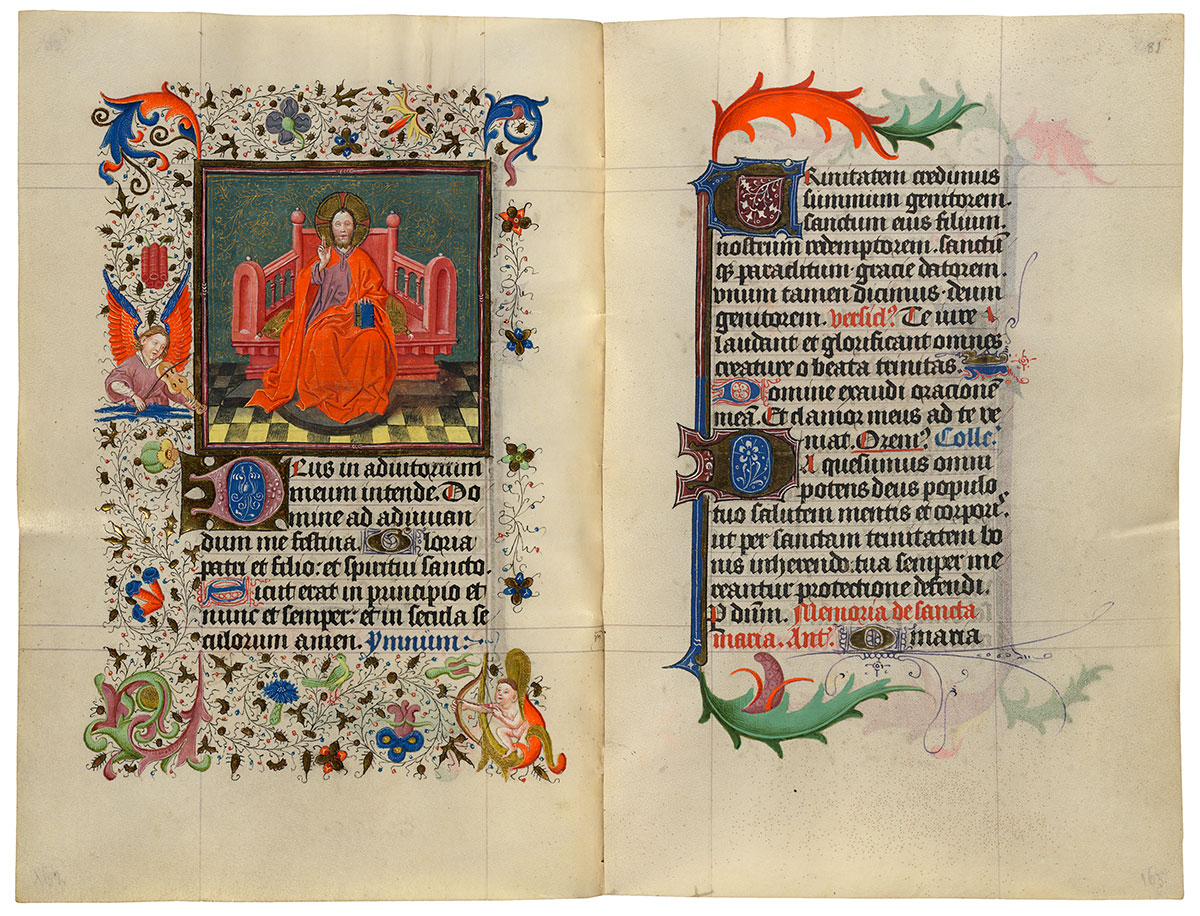
God the Son
Purchased on the Belle da Costa Greene Fund with the assistance of the Fellows and with special assistance of Mrs. Frederick B. Adams, Sr., Mrs. Robert Charles, Mr. Laurens M. Hamilton, The Heineman Foundation, Mrs. Donald F. Hyde, Mrs. Jacob M. Kaplan, Mrs. John Kean, Mr. Paul Mellon, Mr. and Mrs. Charles F. Morgan, Mr. Lessing J. Rosenwald, Mr. and Mrs. August H. Schilling, Mrs. Herbert N. Straus, Mrs. Landon K. Thorne, Mrs. Alan Valentine, Mr. and Mrs. Arnold Whitridge, and Miss Julia P. Wightman, 1970
Hours and Masses for the Seven Days of the Week
The most unusual texts in Catherine's manuscript are the series of Hours and Masses for every day of the week. Medieval Christian tradition associated certain figures or themes with different days. Thus Sunday, the day of the Resurrection, was the Lord's Day; Thursday was connected with the Eucharist since that sacrament was instituted on Holy Thursday; and Monday was the day of the dead, since their torments were suspended on Sunday but recommenced the following day. In Catherine's prayer book, the themes for the Hours and Masses of the seven days of the week are:
| Sunday | the Trinity |
| Monday | the Dead |
| Tuesday | the Holy Spirit |
| Wednesday | All Saints |
| Thursday | the Blessed Sacrament |
| Friday | the Compassion of God |
| Saturday | the Virgin. |
Image courtesy of Faksimile Verlag Luzern
MS M.917/945, ff. 81v–82r
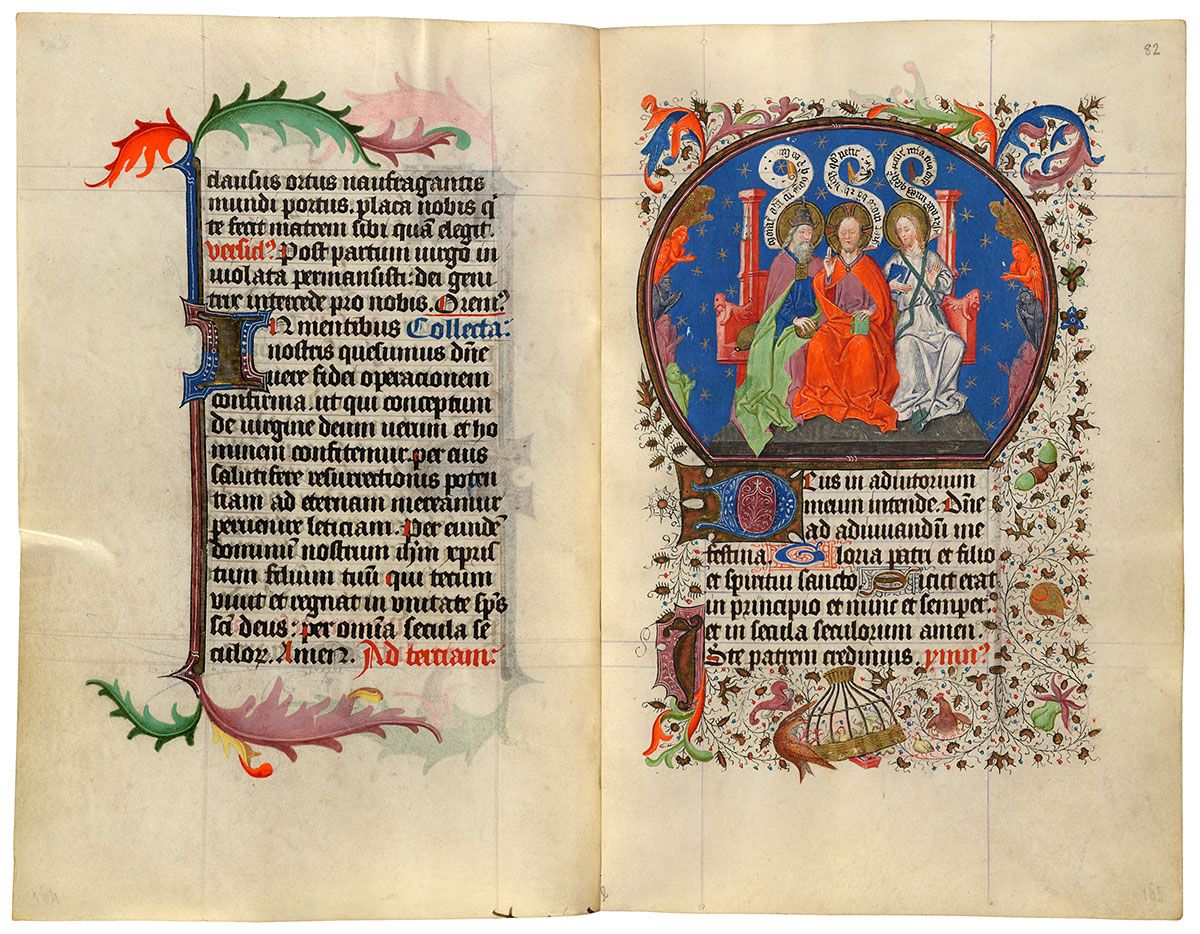
Three Persons of the Trinity
Purchased on the Belle da Costa Greene Fund with the assistance of the Fellows and with special assistance of Mrs. Frederick B. Adams, Sr., Mrs. Robert Charles, Mr. Laurens M. Hamilton, The Heineman Foundation, Mrs. Donald F. Hyde, Mrs. Jacob M. Kaplan, Mrs. John Kean, Mr. Paul Mellon, Mr. and Mrs. Charles F. Morgan, Mr. Lessing J. Rosenwald, Mr. and Mrs. August H. Schilling, Mrs. Herbert N. Straus, Mrs. Landon K. Thorne, Mrs. Alan Valentine, Mr. and Mrs. Arnold Whitridge, and Miss Julia P. Wightman, 1970
The Three Persons of the Trinity sit on a throne floating in a starry sky surrounded by representatives of the nine choirs of angels. Scrolls give words to their debate. God the Father argues that "Adam will die with all those who are from my tribe." The Holy Spirit advocates compassion: "If Adam does not achieve mercy, then your mercy, Lord, will perish." Accepting his sacrificial role, Christ has the last words: "May it be a good death, and may he obtain what he requests."
Hours and Masses for the Seven Days of the Week
The most unusual texts in Catherine's manuscript are the series of Hours and Masses for every day of the week. Medieval Christian tradition associated certain figures or themes with different days. Thus Sunday, the day of the Resurrection, was the Lord's Day; Thursday was connected with the Eucharist since that sacrament was instituted on Holy Thursday; and Monday was the day of the dead, since their torments were suspended on Sunday but recommenced the following day. In Catherine's prayer book, the themes for the Hours and Masses of the seven days of the week are:
| Sunday | the Trinity |
| Monday | the Dead |
| Tuesday | the Holy Spirit |
| Wednesday | All Saints |
| Thursday | the Blessed Sacrament |
| Friday | the Compassion of God |
| Saturday | the Virgin. |
Image courtesy of Faksimile Verlag Luzern
MS M.917/945, ff. 82v–83r
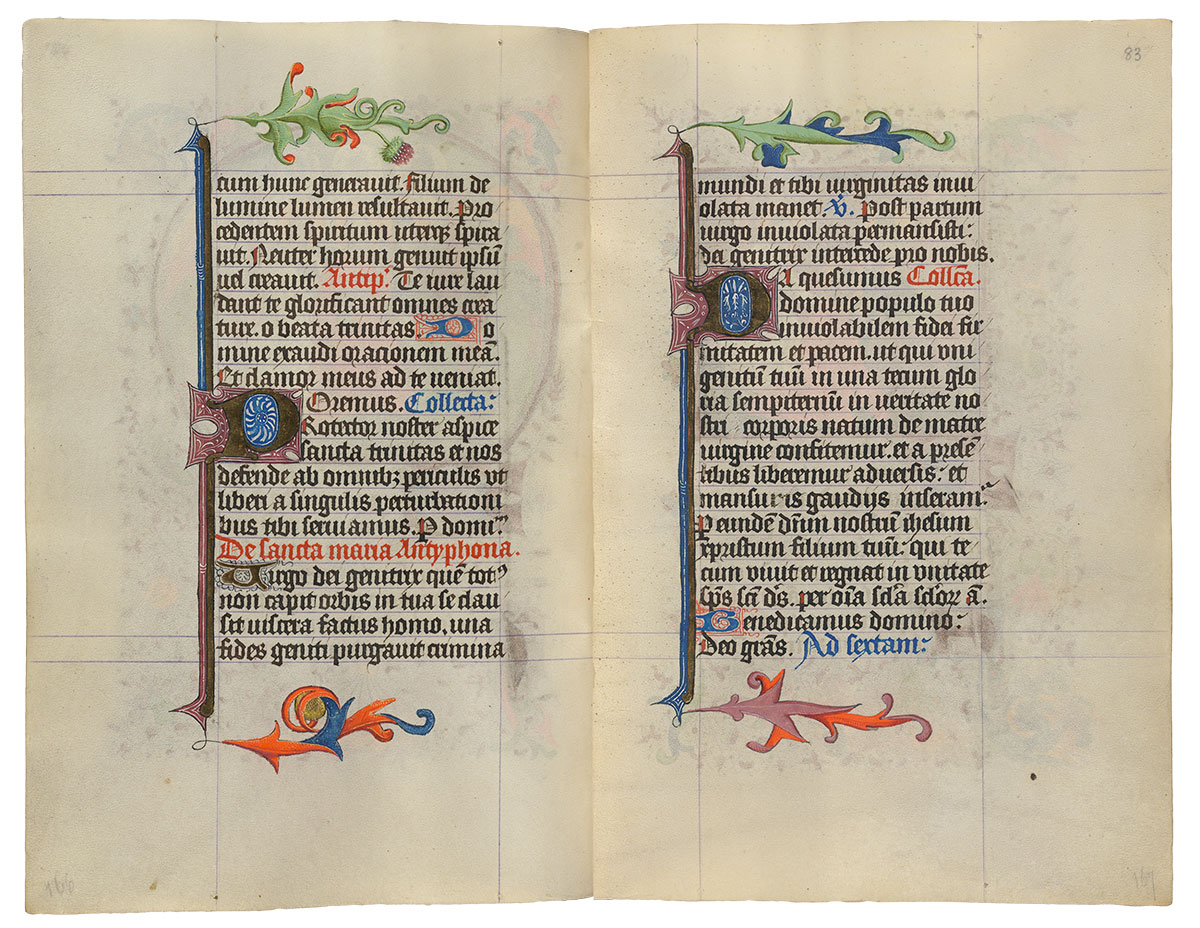
Purchased on the Belle da Costa Greene Fund with the assistance of the Fellows and with special assistance of Mrs. Frederick B. Adams, Sr., Mrs. Robert Charles, Mr. Laurens M. Hamilton, The Heineman Foundation, Mrs. Donald F. Hyde, Mrs. Jacob M. Kaplan, Mrs. John Kean, Mr. Paul Mellon, Mr. and Mrs. Charles F. Morgan, Mr. Lessing J. Rosenwald, Mr. and Mrs. August H. Schilling, Mrs. Herbert N. Straus, Mrs. Landon K. Thorne, Mrs. Alan Valentine, Mr. and Mrs. Arnold Whitridge, and Miss Julia P. Wightman, 1970
Image courtesy of Faksimile Verlag Luzern
MS M.917/945, ff. 83v–84r
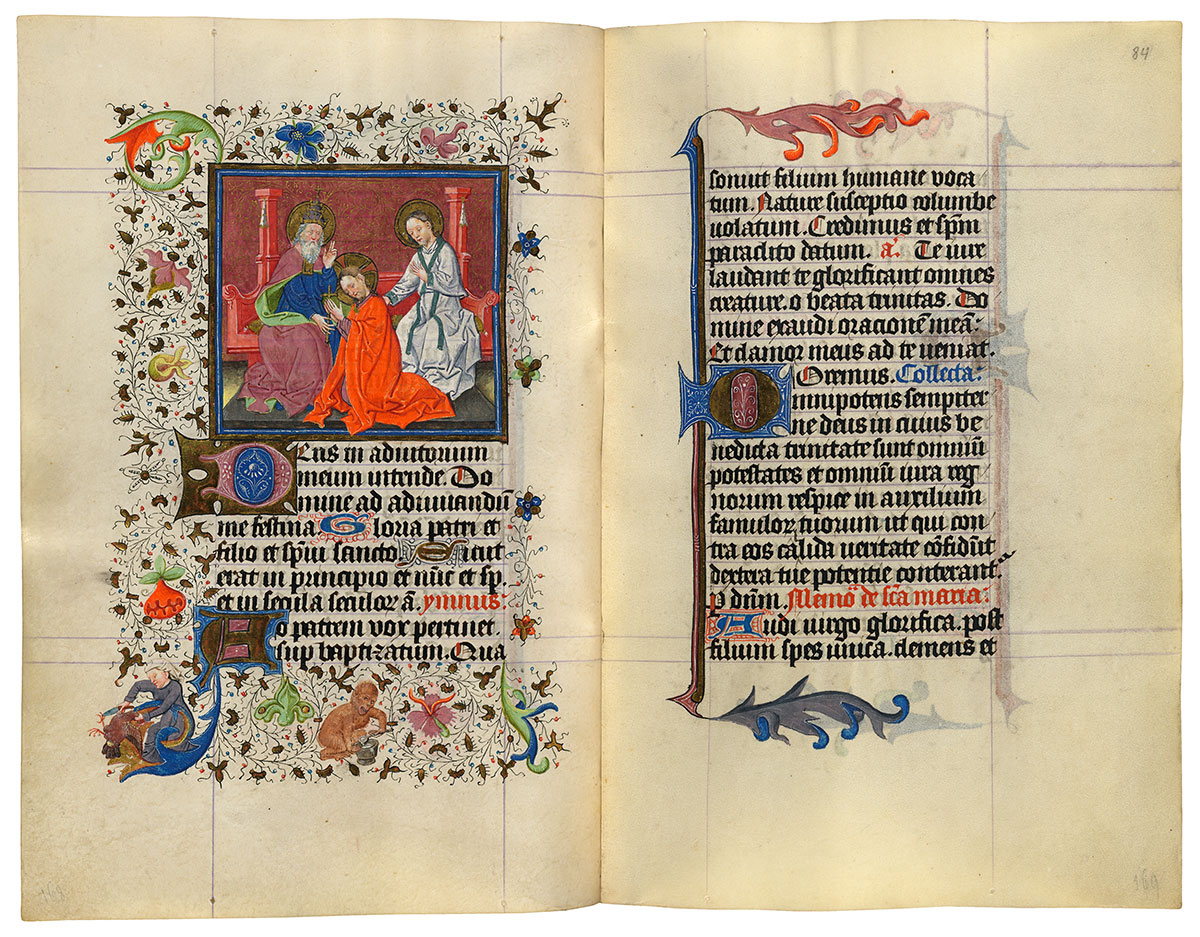
Christ Accepts his Father’s Decree to Save Mankind
Purchased on the Belle da Costa Greene Fund with the assistance of the Fellows and with special assistance of Mrs. Frederick B. Adams, Sr., Mrs. Robert Charles, Mr. Laurens M. Hamilton, The Heineman Foundation, Mrs. Donald F. Hyde, Mrs. Jacob M. Kaplan, Mrs. John Kean, Mr. Paul Mellon, Mr. and Mrs. Charles F. Morgan, Mr. Lessing J. Rosenwald, Mr. and Mrs. August H. Schilling, Mrs. Herbert N. Straus, Mrs. Landon K. Thorne, Mrs. Alan Valentine, Mr. and Mrs. Arnold Whitridge, and Miss Julia P. Wightman, 1970
Hours and Masses for the Seven Days of the Week
The most unusual texts in Catherine's manuscript are the series of Hours and Masses for every day of the week. Medieval Christian tradition associated certain figures or themes with different days. Thus Sunday, the day of the Resurrection, was the Lord's Day; Thursday was connected with the Eucharist since that sacrament was instituted on Holy Thursday; and Monday was the day of the dead, since their torments were suspended on Sunday but recommenced the following day. In Catherine's prayer book, the themes for the Hours and Masses of the seven days of the week are:
| Sunday | the Trinity |
| Monday | the Dead |
| Tuesday | the Holy Spirit |
| Wednesday | All Saints |
| Thursday | the Blessed Sacrament |
| Friday | the Compassion of God |
| Saturday | the Virgin. |
Image courtesy of Faksimile Verlag Luzern
MS M.917/945, ff. 84v–85r

Infant Christ Sent to Earth
Purchased on the Belle da Costa Greene Fund with the assistance of the Fellows and with special assistance of Mrs. Frederick B. Adams, Sr., Mrs. Robert Charles, Mr. Laurens M. Hamilton, The Heineman Foundation, Mrs. Donald F. Hyde, Mrs. Jacob M. Kaplan, Mrs. John Kean, Mr. Paul Mellon, Mr. and Mrs. Charles F. Morgan, Mr. Lessing J. Rosenwald, Mr. and Mrs. August H. Schilling, Mrs. Herbert N. Straus, Mrs. Landon K. Thorne, Mrs. Alan Valentine, Mr. and Mrs. Arnold Whitridge, and Miss Julia P. Wightman, 1970
Salvation has begun. God the Father dispatches his Son to earth, trailed by the Dove of the Holy Spirit. Christ is depicted as a human baby, albeit one shouldering the Cross upon which he will die. The earth is devoid of people; no one welcomes the future Savior. Below, in the border, a man catches fish in traps that symbolize the corporeal imprisonment of the soul.
Hours and Masses for the Seven Days of the Week
The most unusual texts in Catherine's manuscript are the series of Hours and Masses for every day of the week. Medieval Christian tradition associated certain figures or themes with different days. Thus Sunday, the day of the Resurrection, was the Lord's Day; Thursday was connected with the Eucharist since that sacrament was instituted on Holy Thursday; and Monday was the day of the dead, since their torments were suspended on Sunday but recommenced the following day. In Catherine's prayer book, the themes for the Hours and Masses of the seven days of the week are:
| Sunday | the Trinity |
| Monday | the Dead |
| Tuesday | the Holy Spirit |
| Wednesday | All Saints |
| Thursday | the Blessed Sacrament |
| Friday | the Compassion of God |
| Saturday | the Virgin. |
Image courtesy of Faksimile Verlag Luzern
MS M.917/945, ff. 85v–86r
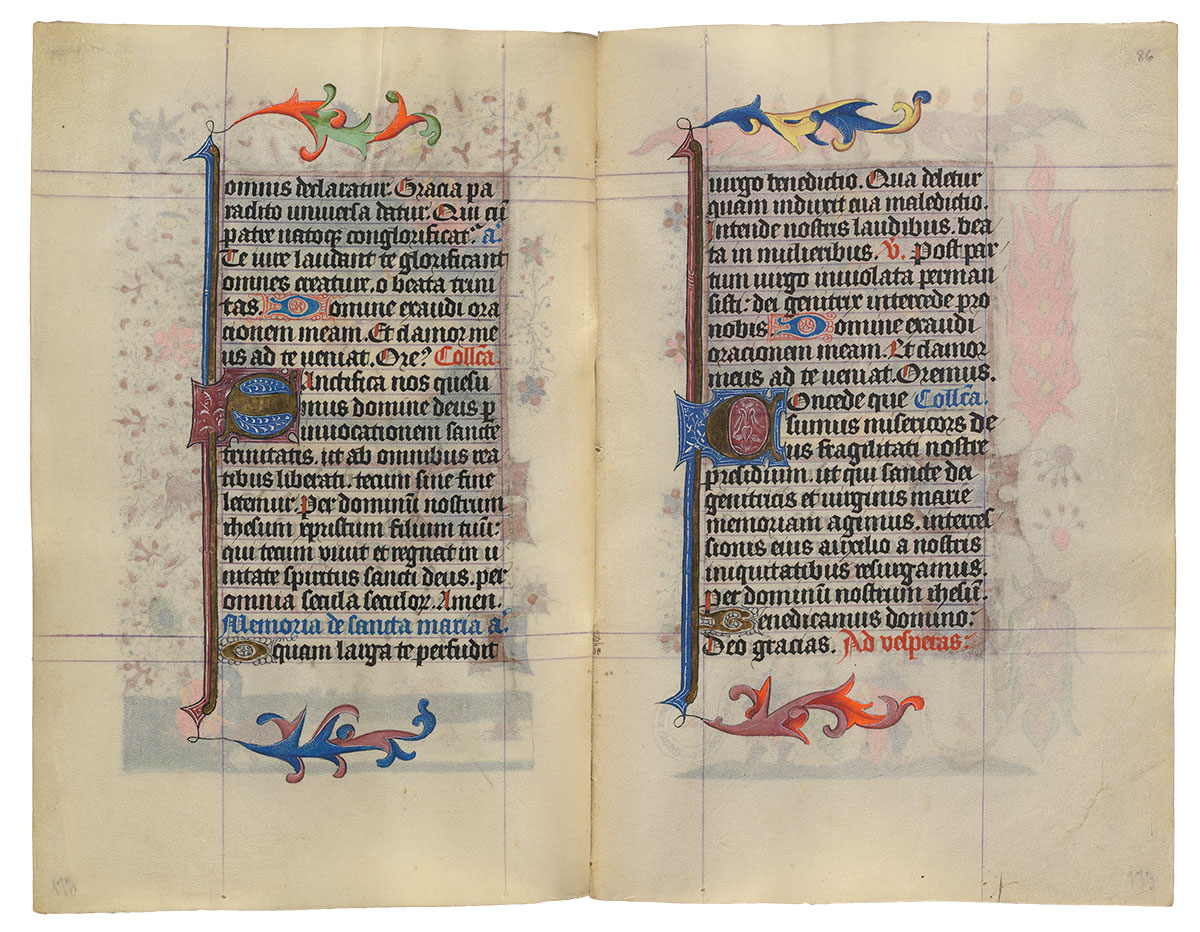
Purchased on the Belle da Costa Greene Fund with the assistance of the Fellows and with special assistance of Mrs. Frederick B. Adams, Sr., Mrs. Robert Charles, Mr. Laurens M. Hamilton, The Heineman Foundation, Mrs. Donald F. Hyde, Mrs. Jacob M. Kaplan, Mrs. John Kean, Mr. Paul Mellon, Mr. and Mrs. Charles F. Morgan, Mr. Lessing J. Rosenwald, Mr. and Mrs. August H. Schilling, Mrs. Herbert N. Straus, Mrs. Landon K. Thorne, Mrs. Alan Valentine, Mr. and Mrs. Arnold Whitridge, and Miss Julia P. Wightman, 1970
Image courtesy of Faksimile Verlag Luzern
MS M.917/945, ff. 86v–87r
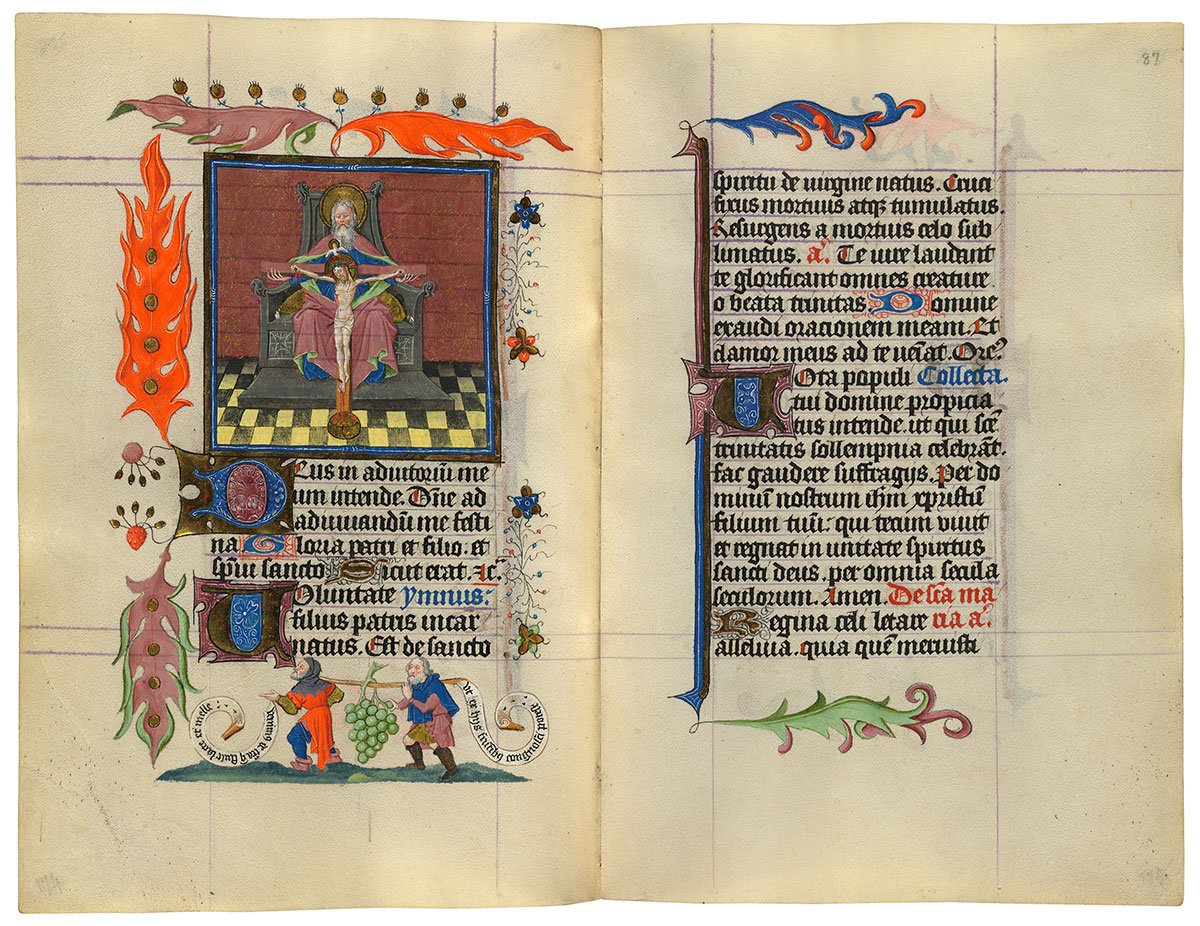
“Throne of Grace” Trinity
Purchased on the Belle da Costa Greene Fund with the assistance of the Fellows and with special assistance of Mrs. Frederick B. Adams, Sr., Mrs. Robert Charles, Mr. Laurens M. Hamilton, The Heineman Foundation, Mrs. Donald F. Hyde, Mrs. Jacob M. Kaplan, Mrs. John Kean, Mr. Paul Mellon, Mr. and Mrs. Charles F. Morgan, Mr. Lessing J. Rosenwald, Mr. and Mrs. August H. Schilling, Mrs. Herbert N. Straus, Mrs. Landon K. Thorne, Mrs. Alan Valentine, Mr. and Mrs. Arnold Whitridge, and Miss Julia P. Wightman, 1970
Hours and Masses for the Seven Days of the Week
The most unusual texts in Catherine's manuscript are the series of Hours and Masses for every day of the week. Medieval Christian tradition associated certain figures or themes with different days. Thus Sunday, the day of the Resurrection, was the Lord's Day; Thursday was connected with the Eucharist since that sacrament was instituted on Holy Thursday; and Monday was the day of the dead, since their torments were suspended on Sunday but recommenced the following day. In Catherine's prayer book, the themes for the Hours and Masses of the seven days of the week are:
| Sunday | the Trinity |
| Monday | the Dead |
| Tuesday | the Holy Spirit |
| Wednesday | All Saints |
| Thursday | the Blessed Sacrament |
| Friday | the Compassion of God |
| Saturday | the Virgin. |
Image courtesy of Faksimile Verlag Luzern
MS M.917/945, ff. 87v–88r
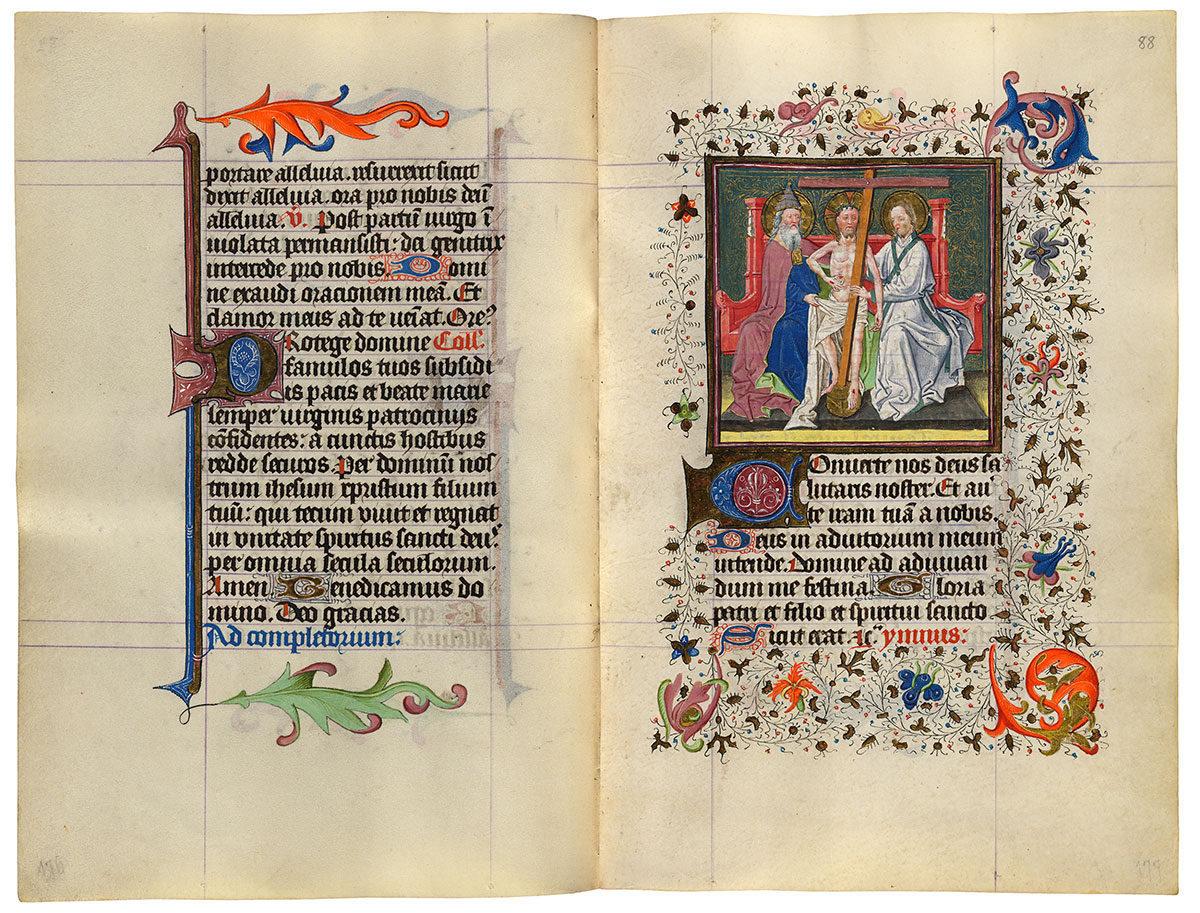
Man of Sorrows Returned to the Trinitarian Throne
Purchased on the Belle da Costa Greene Fund with the assistance of the Fellows and with special assistance of Mrs. Frederick B. Adams, Sr., Mrs. Robert Charles, Mr. Laurens M. Hamilton, The Heineman Foundation, Mrs. Donald F. Hyde, Mrs. Jacob M. Kaplan, Mrs. John Kean, Mr. Paul Mellon, Mr. and Mrs. Charles F. Morgan, Mr. Lessing J. Rosenwald, Mr. and Mrs. August H. Schilling, Mrs. Herbert N. Straus, Mrs. Landon K. Thorne, Mrs. Alan Valentine, Mr. and Mrs. Arnold Whitridge, and Miss Julia P. Wightman, 1970
Hours and Masses for the Seven Days of the Week
The most unusual texts in Catherine's manuscript are the series of Hours and Masses for every day of the week. Medieval Christian tradition associated certain figures or themes with different days. Thus Sunday, the day of the Resurrection, was the Lord's Day; Thursday was connected with the Eucharist since that sacrament was instituted on Holy Thursday; and Monday was the day of the dead, since their torments were suspended on Sunday but recommenced the following day. In Catherine's prayer book, the themes for the Hours and Masses of the seven days of the week are:
| Sunday | the Trinity |
| Monday | the Dead |
| Tuesday | the Holy Spirit |
| Wednesday | All Saints |
| Thursday | the Blessed Sacrament |
| Friday | the Compassion of God |
| Saturday | the Virgin. |
Image courtesy of Faksimile Verlag Luzern
MS M.917/945, ff. 88v–89r
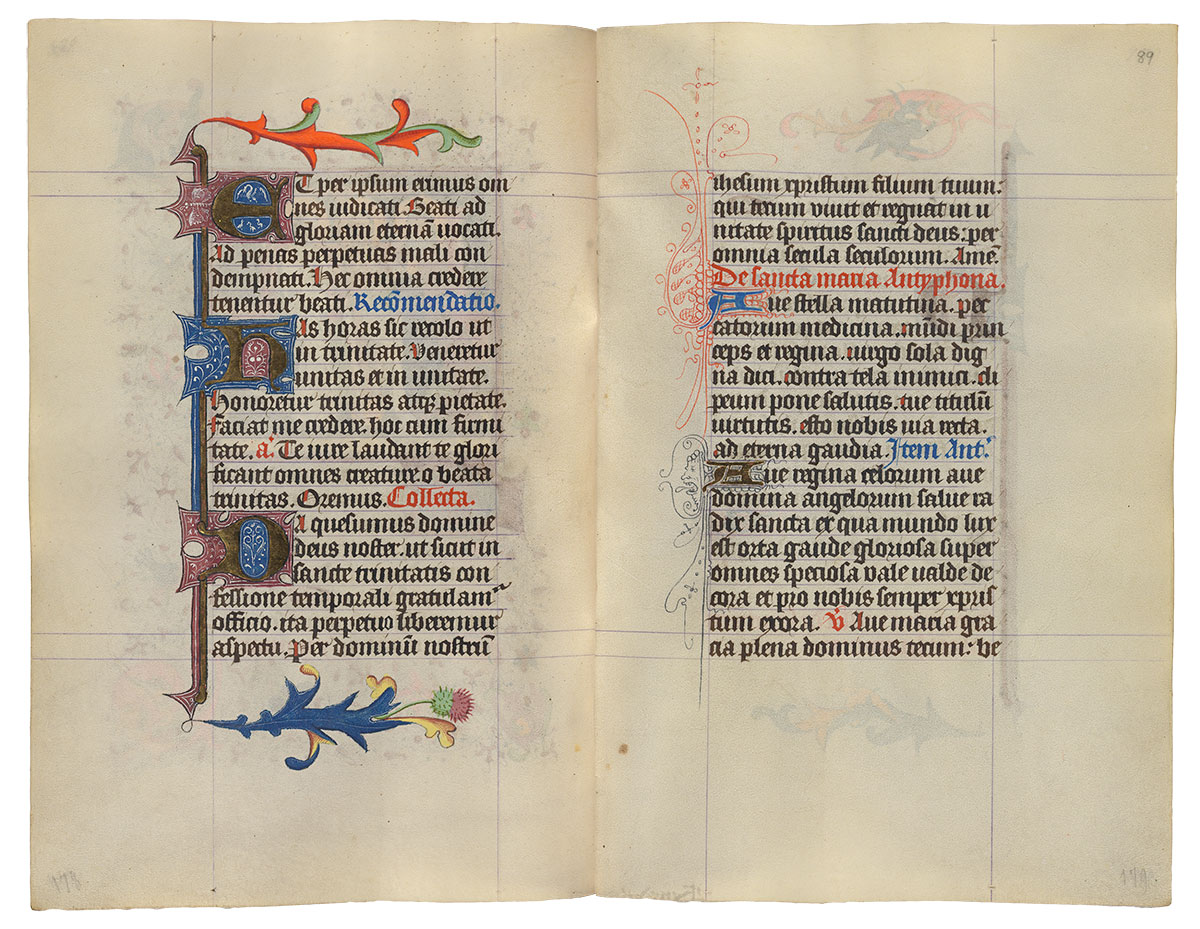
Purchased on the Belle da Costa Greene Fund with the assistance of the Fellows and with special assistance of Mrs. Frederick B. Adams, Sr., Mrs. Robert Charles, Mr. Laurens M. Hamilton, The Heineman Foundation, Mrs. Donald F. Hyde, Mrs. Jacob M. Kaplan, Mrs. John Kean, Mr. Paul Mellon, Mr. and Mrs. Charles F. Morgan, Mr. Lessing J. Rosenwald, Mr. and Mrs. August H. Schilling, Mrs. Herbert N. Straus, Mrs. Landon K. Thorne, Mrs. Alan Valentine, Mr. and Mrs. Arnold Whitridge, and Miss Julia P. Wightman, 1970
Image courtesy of Faksimile Verlag Luzern
MS M.917/945, ff. 89v–90r
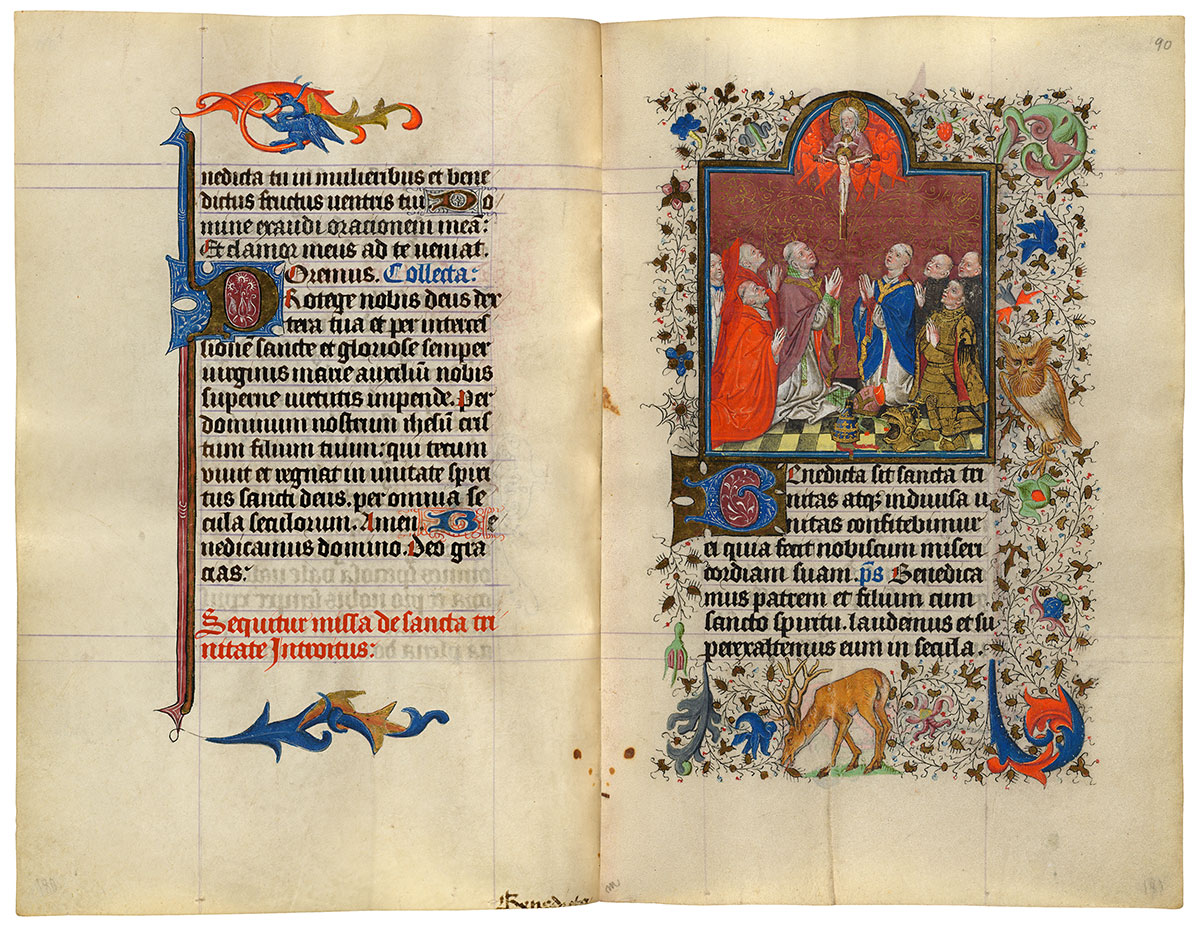
Rulers of the Earth Adore the Trinity
Purchased on the Belle da Costa Greene Fund with the assistance of the Fellows and with special assistance of Mrs. Frederick B. Adams, Sr., Mrs. Robert Charles, Mr. Laurens M. Hamilton, The Heineman Foundation, Mrs. Donald F. Hyde, Mrs. Jacob M. Kaplan, Mrs. John Kean, Mr. Paul Mellon, Mr. and Mrs. Charles F. Morgan, Mr. Lessing J. Rosenwald, Mr. and Mrs. August H. Schilling, Mrs. Herbert N. Straus, Mrs. Landon K. Thorne, Mrs. Alan Valentine, Mr. and Mrs. Arnold Whitridge, and Miss Julia P. Wightman, 1970
Hours and Masses for the Seven Days of the Week
The most unusual texts in Catherine's manuscript are the series of Hours and Masses for every day of the week. Medieval Christian tradition associated certain figures or themes with different days. Thus Sunday, the day of the Resurrection, was the Lord's Day; Thursday was connected with the Eucharist since that sacrament was instituted on Holy Thursday; and Monday was the day of the dead, since their torments were suspended on Sunday but recommenced the following day. In Catherine's prayer book, the themes for the Hours and Masses of the seven days of the week are:
| Sunday | the Trinity |
| Monday | the Dead |
| Tuesday | the Holy Spirit |
| Wednesday | All Saints |
| Thursday | the Blessed Sacrament |
| Friday | the Compassion of God |
| Saturday | the Virgin. |
Image courtesy of Faksimile Verlag Luzern
MS M.917/945, ff. 90v–91r
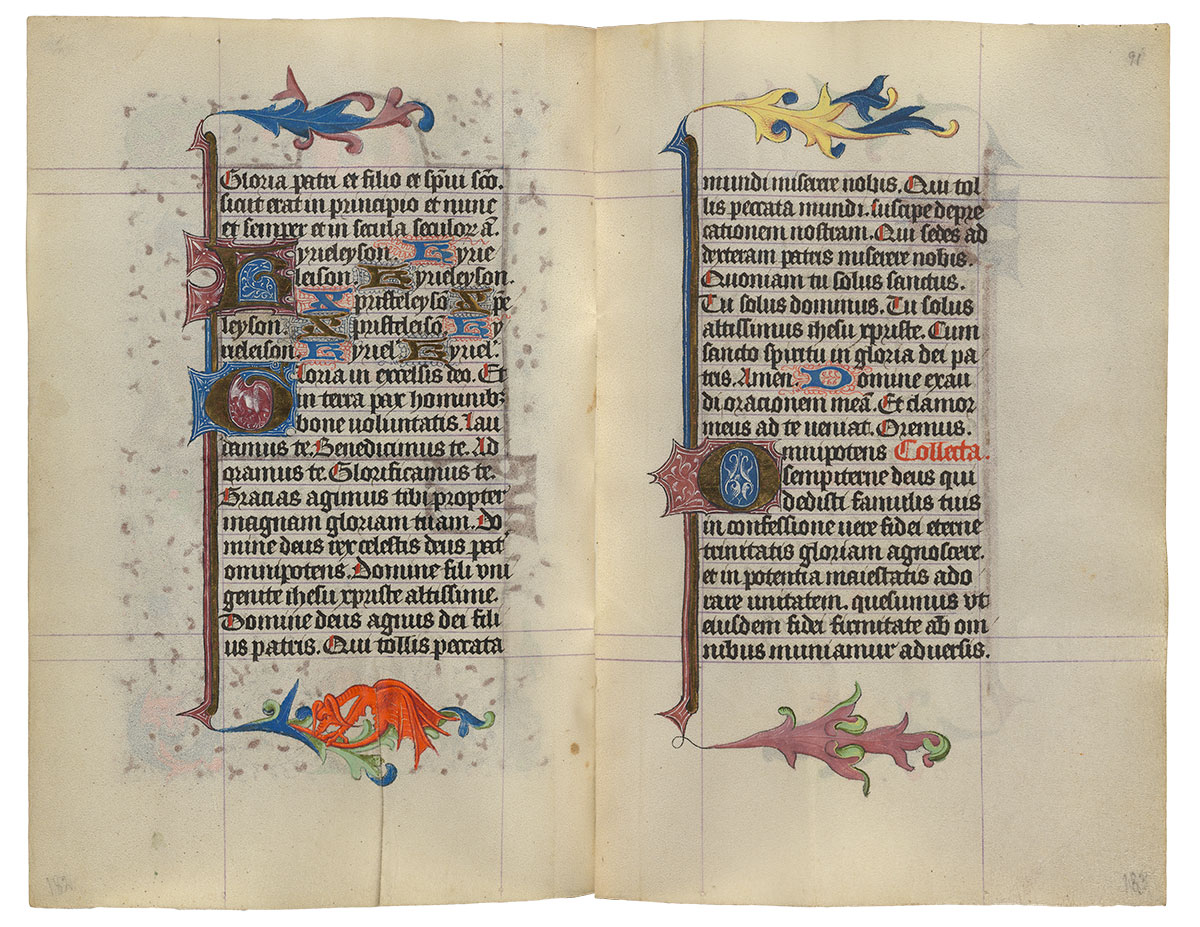
Purchased on the Belle da Costa Greene Fund with the assistance of the Fellows and with special assistance of Mrs. Frederick B. Adams, Sr., Mrs. Robert Charles, Mr. Laurens M. Hamilton, The Heineman Foundation, Mrs. Donald F. Hyde, Mrs. Jacob M. Kaplan, Mrs. John Kean, Mr. Paul Mellon, Mr. and Mrs. Charles F. Morgan, Mr. Lessing J. Rosenwald, Mr. and Mrs. August H. Schilling, Mrs. Herbert N. Straus, Mrs. Landon K. Thorne, Mrs. Alan Valentine, Mr. and Mrs. Arnold Whitridge, and Miss Julia P. Wightman, 1970
Image courtesy of Faksimile Verlag Luzern
MS M.917/945, ff. 91v–92r
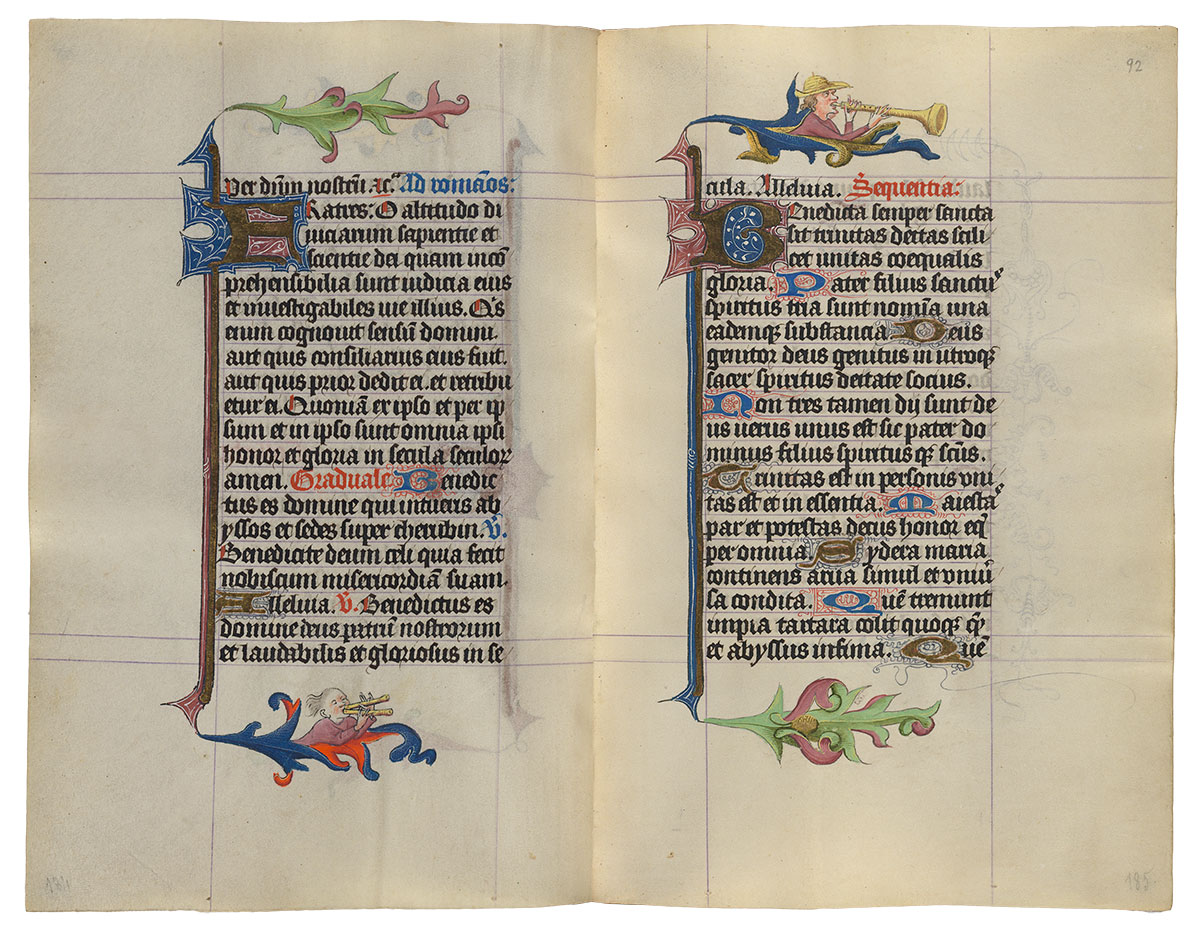
Purchased on the Belle da Costa Greene Fund with the assistance of the Fellows and with special assistance of Mrs. Frederick B. Adams, Sr., Mrs. Robert Charles, Mr. Laurens M. Hamilton, The Heineman Foundation, Mrs. Donald F. Hyde, Mrs. Jacob M. Kaplan, Mrs. John Kean, Mr. Paul Mellon, Mr. and Mrs. Charles F. Morgan, Mr. Lessing J. Rosenwald, Mr. and Mrs. August H. Schilling, Mrs. Herbert N. Straus, Mrs. Landon K. Thorne, Mrs. Alan Valentine, Mr. and Mrs. Arnold Whitridge, and Miss Julia P. Wightman, 1970
Image courtesy of Faksimile Verlag Luzern
MS M.917/945, ff. 92v–93r
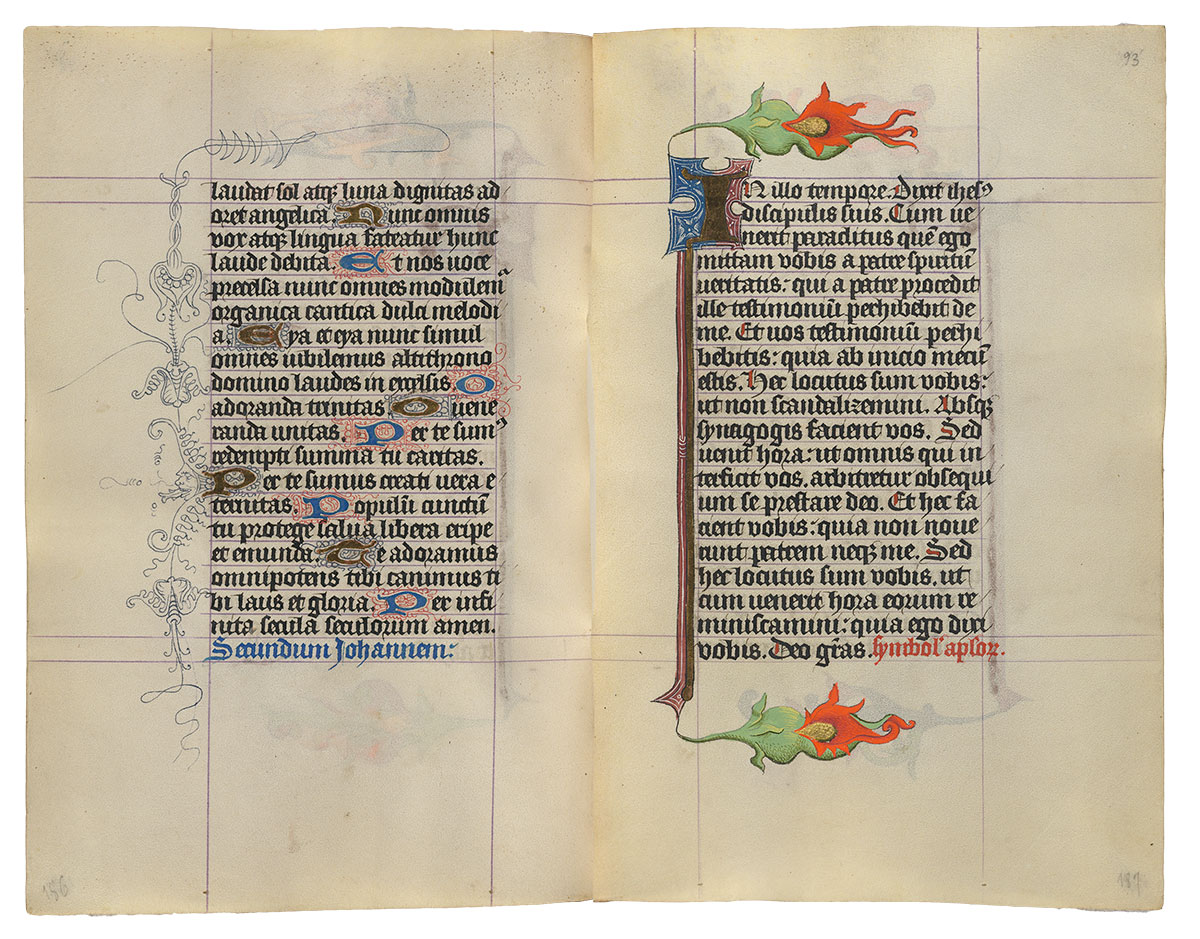
Purchased on the Belle da Costa Greene Fund with the assistance of the Fellows and with special assistance of Mrs. Frederick B. Adams, Sr., Mrs. Robert Charles, Mr. Laurens M. Hamilton, The Heineman Foundation, Mrs. Donald F. Hyde, Mrs. Jacob M. Kaplan, Mrs. John Kean, Mr. Paul Mellon, Mr. and Mrs. Charles F. Morgan, Mr. Lessing J. Rosenwald, Mr. and Mrs. August H. Schilling, Mrs. Herbert N. Straus, Mrs. Landon K. Thorne, Mrs. Alan Valentine, Mr. and Mrs. Arnold Whitridge, and Miss Julia P. Wightman, 1970
Image courtesy of Faksimile Verlag Luzern
MS M.917/945, ff. 93v–94r
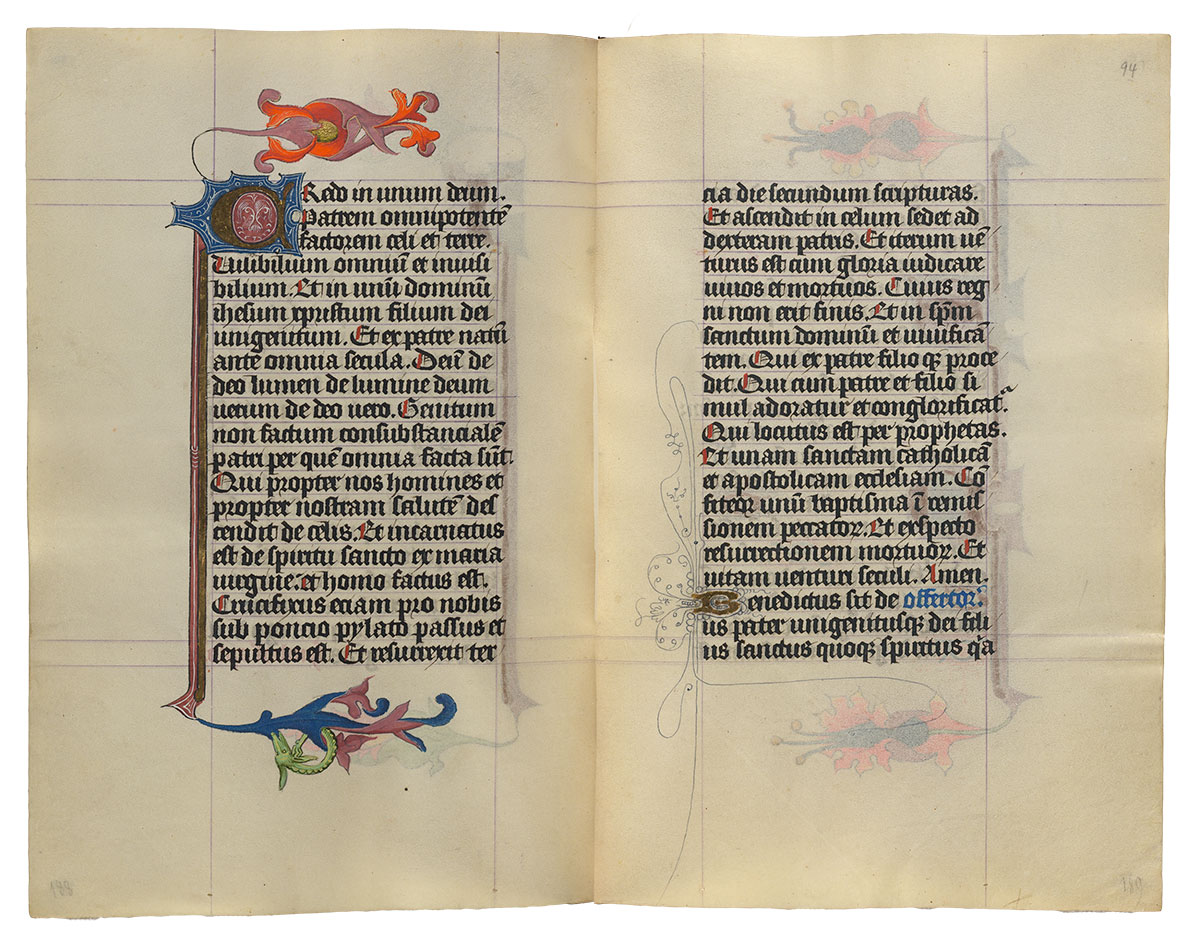
Purchased on the Belle da Costa Greene Fund with the assistance of the Fellows and with special assistance of Mrs. Frederick B. Adams, Sr., Mrs. Robert Charles, Mr. Laurens M. Hamilton, The Heineman Foundation, Mrs. Donald F. Hyde, Mrs. Jacob M. Kaplan, Mrs. John Kean, Mr. Paul Mellon, Mr. and Mrs. Charles F. Morgan, Mr. Lessing J. Rosenwald, Mr. and Mrs. August H. Schilling, Mrs. Herbert N. Straus, Mrs. Landon K. Thorne, Mrs. Alan Valentine, Mr. and Mrs. Arnold Whitridge, and Miss Julia P. Wightman, 1970
Image courtesy of Faksimile Verlag Luzern
MS M.917/945, ff. 94v–95r
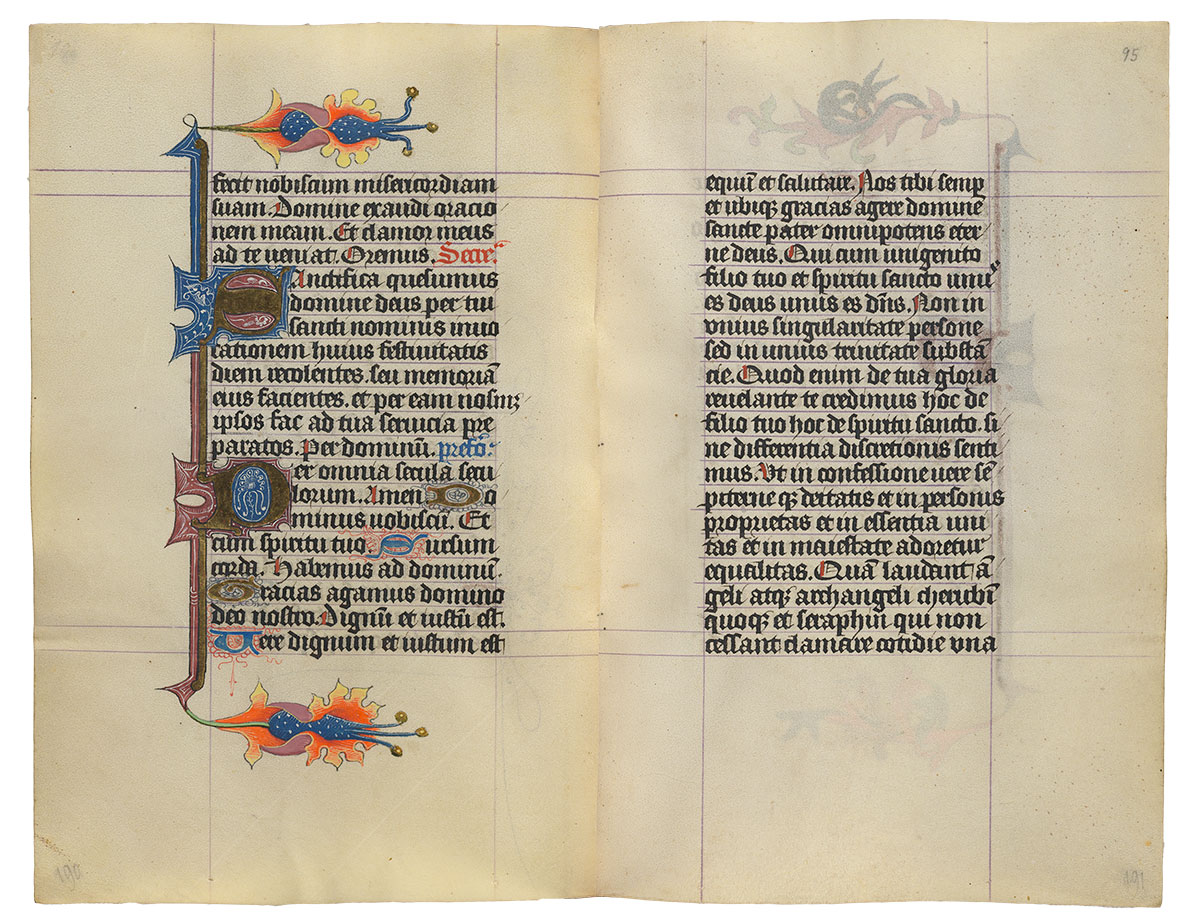
Purchased on the Belle da Costa Greene Fund with the assistance of the Fellows and with special assistance of Mrs. Frederick B. Adams, Sr., Mrs. Robert Charles, Mr. Laurens M. Hamilton, The Heineman Foundation, Mrs. Donald F. Hyde, Mrs. Jacob M. Kaplan, Mrs. John Kean, Mr. Paul Mellon, Mr. and Mrs. Charles F. Morgan, Mr. Lessing J. Rosenwald, Mr. and Mrs. August H. Schilling, Mrs. Herbert N. Straus, Mrs. Landon K. Thorne, Mrs. Alan Valentine, Mr. and Mrs. Arnold Whitridge, and Miss Julia P. Wightman, 1970
Image courtesy of Faksimile Verlag Luzern
MS M.917/945, ff. 95v–96r

Purchased on the Belle da Costa Greene Fund with the assistance of the Fellows and with special assistance of Mrs. Frederick B. Adams, Sr., Mrs. Robert Charles, Mr. Laurens M. Hamilton, The Heineman Foundation, Mrs. Donald F. Hyde, Mrs. Jacob M. Kaplan, Mrs. John Kean, Mr. Paul Mellon, Mr. and Mrs. Charles F. Morgan, Mr. Lessing J. Rosenwald, Mr. and Mrs. August H. Schilling, Mrs. Herbert N. Straus, Mrs. Landon K. Thorne, Mrs. Alan Valentine, Mr. and Mrs. Arnold Whitridge, and Miss Julia P. Wightman, 1970
Image courtesy of Faksimile Verlag Luzern
MS M.917/945, f. 96v–p. 179
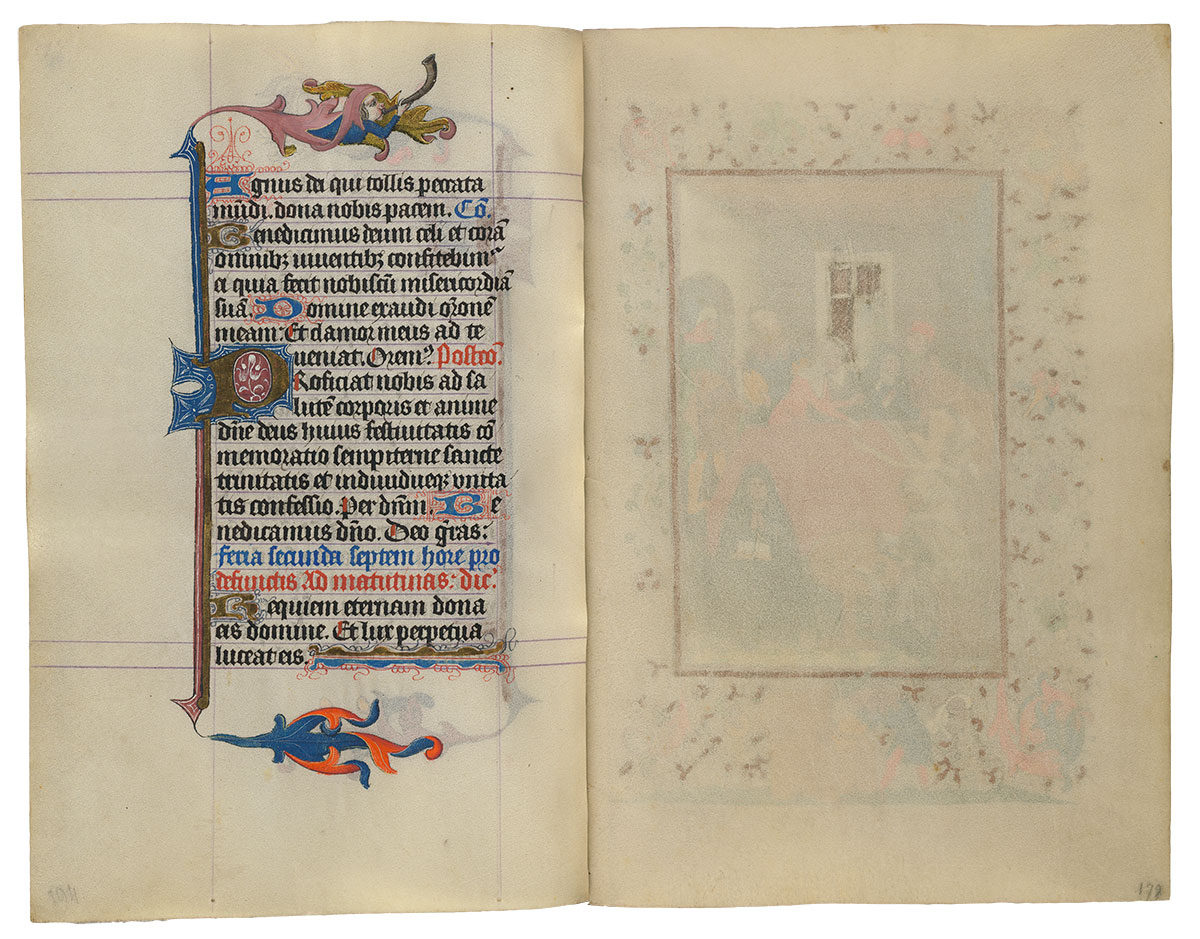
Purchased on the Belle da Costa Greene Fund with the assistance of the Fellows and with special assistance of Mrs. Frederick B. Adams, Sr., Mrs. Robert Charles, Mr. Laurens M. Hamilton, The Heineman Foundation, Mrs. Donald F. Hyde, Mrs. Jacob M. Kaplan, Mrs. John Kean, Mr. Paul Mellon, Mr. and Mrs. Charles F. Morgan, Mr. Lessing J. Rosenwald, Mr. and Mrs. August H. Schilling, Mrs. Herbert N. Straus, Mrs. Landon K. Thorne, Mrs. Alan Valentine, Mr. and Mrs. Arnold Whitridge, and Miss Julia P. Wightman, 1970
Image courtesy of Faksimile Verlag Luzern
MS M.917/945, p. 180–f. 97r
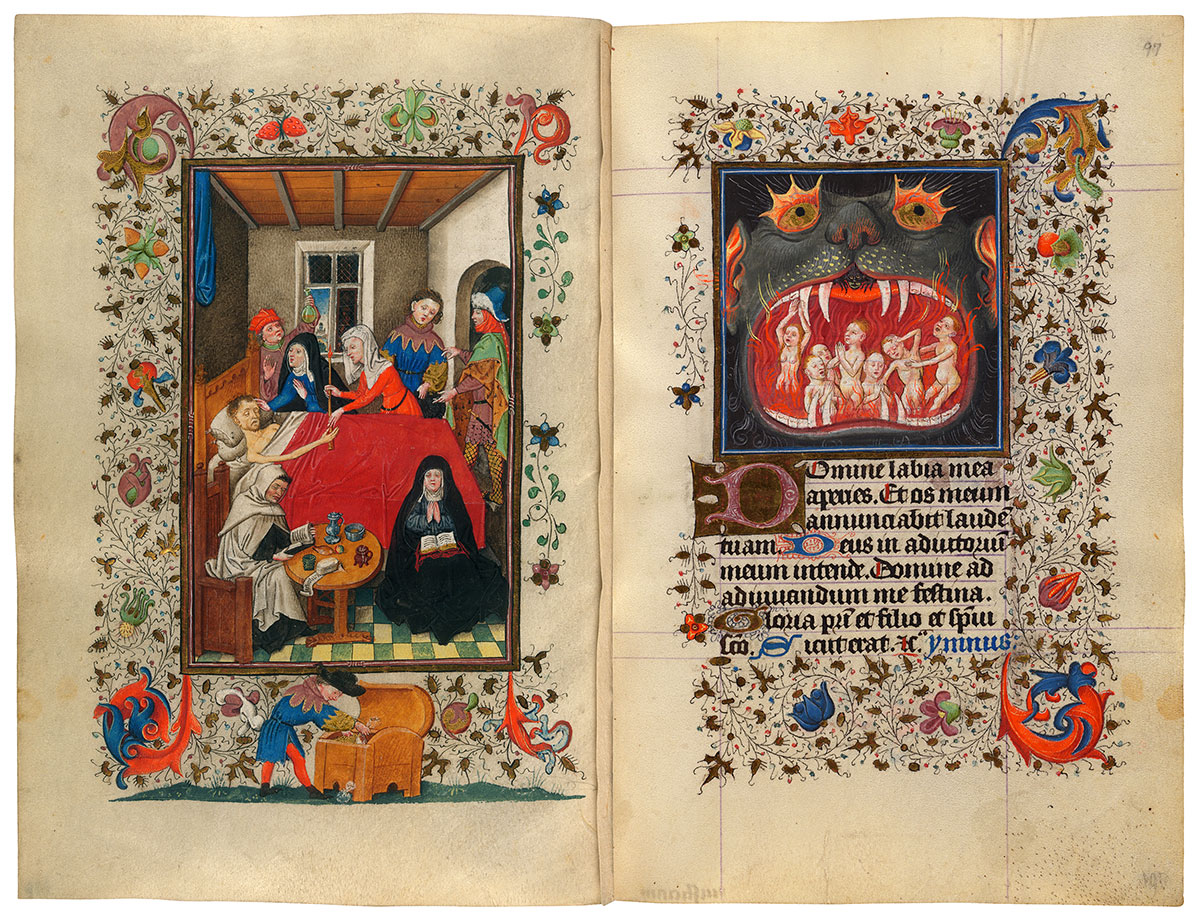
Deathbed
Souls Tormented in Purgatory
Purchased on the Belle da Costa Greene Fund with the assistance of the Fellows, 1963; purchased on the Belle da Costa Greene Fund with the assistance of the Fellows and with special assistance of Mrs. Frederick B. Adams, Sr., Mrs. Robert Charles, Mr. Laurens M. Hamilton, The Heineman Foundation, Mrs. Donald F. Hyde, Mrs. Jacob M. Kaplan, Mrs. John Kean, Mr. Paul Mellon, Mr. and Mrs. Charles F. Morgan, Mr. Lessing J. Rosenwald, Mr. and Mrs. August H. Schilling, Mrs. Herbert N. Straus, Mrs. Landon K. Thorne, Mrs. Alan Valentine, Mr. and Mrs. Arnold Whitridge, and Miss Julia P. Wightman, 1970
The Monday Hours of the Dead open with one of the most famous images from Catherine's manuscript. The deathbed scene is as packed with as much lively action as Puccini's opera Gianni Schicchi. As a man dies, his wife offers him a candle, a doctor examines his urine, and his son conspires against him. This mercenary heir is shown again, raiding his father's coffers in the bottom border. On the right is purgatory, the place to which the dying man hopes to go. There his soul, like those depicted, will be cleansed of sin in expiating, if painful, fire.
Hours and Masses for the Seven Days of the Week
The most unusual texts in Catherine's manuscript are the series of Hours and Masses for every day of the week. Medieval Christian tradition associated certain figures or themes with different days. Thus Sunday, the day of the Resurrection, was the Lord's Day; Thursday was connected with the Eucharist since that sacrament was instituted on Holy Thursday; and Monday was the day of the dead, since their torments were suspended on Sunday but recommenced the following day. In Catherine's prayer book, the themes for the Hours and Masses of the seven days of the week are:
| Sunday | the Trinity |
| Monday | the Dead |
| Tuesday | the Holy Spirit |
| Wednesday | All Saints |
| Thursday | the Blessed Sacrament |
| Friday | the Compassion of God |
| Saturday | the Virgin. |
Image courtesy of Faksimile Verlag Luzern
MS M.917/945, ff. 97v–98r
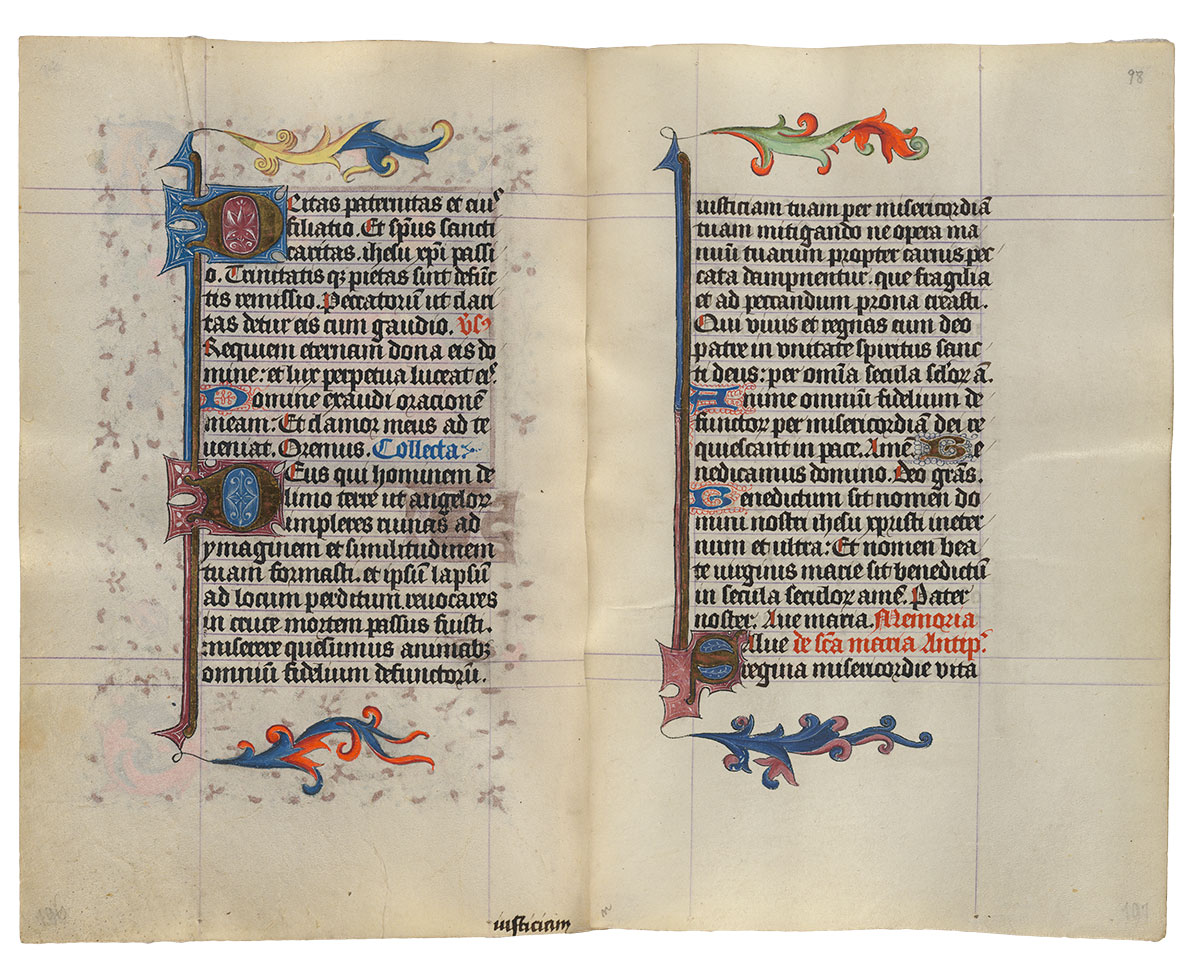
Purchased on the Belle da Costa Greene Fund with the assistance of the Fellows and with special assistance of Mrs. Frederick B. Adams, Sr., Mrs. Robert Charles, Mr. Laurens M. Hamilton, The Heineman Foundation, Mrs. Donald F. Hyde, Mrs. Jacob M. Kaplan, Mrs. John Kean, Mr. Paul Mellon, Mr. and Mrs. Charles F. Morgan, Mr. Lessing J. Rosenwald, Mr. and Mrs. August H. Schilling, Mrs. Herbert N. Straus, Mrs. Landon K. Thorne, Mrs. Alan Valentine, Mr. and Mrs. Arnold Whitridge, and Miss Julia P. Wightman, 1970
Image courtesy of Faksimile Verlag Luzern
MS M.917/945, ff. 102v–103r
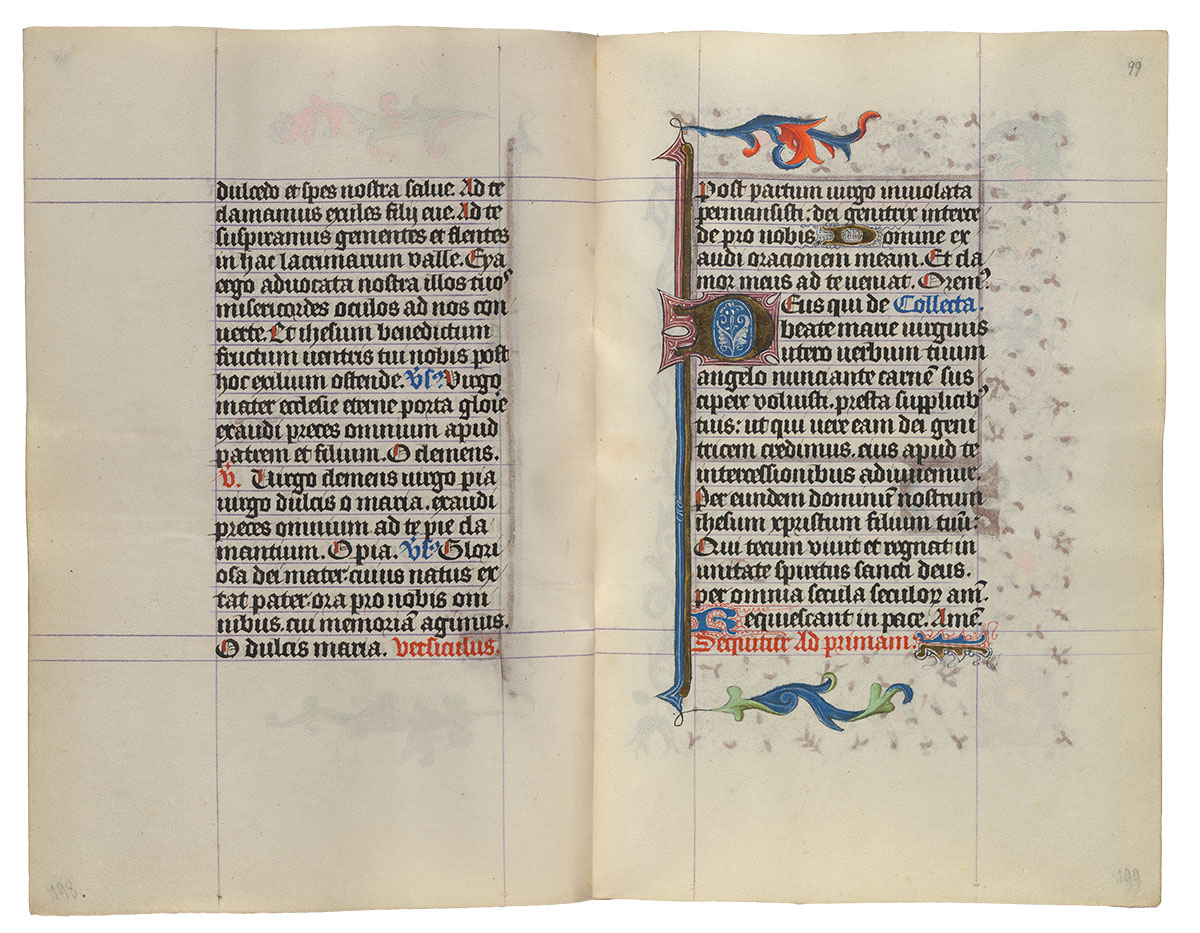
Purchased on the Belle da Costa Greene Fund with the assistance of the Fellows and with special assistance of Mrs. Frederick B. Adams, Sr., Mrs. Robert Charles, Mr. Laurens M. Hamilton, The Heineman Foundation, Mrs. Donald F. Hyde, Mrs. Jacob M. Kaplan, Mrs. John Kean, Mr. Paul Mellon, Mr. and Mrs. Charles F. Morgan, Mr. Lessing J. Rosenwald, Mr. and Mrs. August H. Schilling, Mrs. Herbert N. Straus, Mrs. Landon K. Thorne, Mrs. Alan Valentine, Mr. and Mrs. Arnold Whitridge, and Miss Julia P. Wightman, 1970
Image courtesy of Faksimile Verlag Luzern
MS M.917/945, ff. 99v–100r
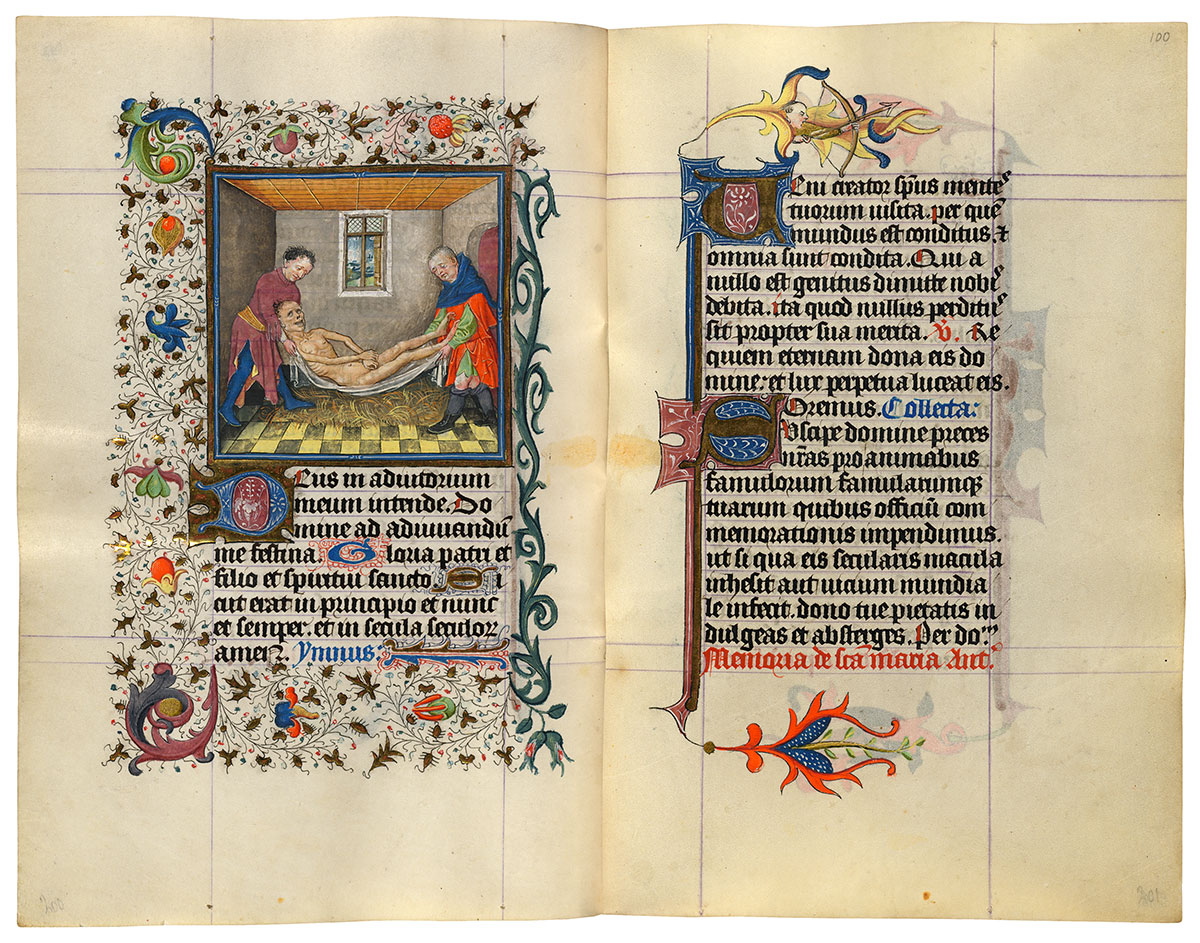
Preparation of the Corpse
Purchased on the Belle da Costa Greene Fund with the assistance of the Fellows and with special assistance of Mrs. Frederick B. Adams, Sr., Mrs. Robert Charles, Mr. Laurens M. Hamilton, The Heineman Foundation, Mrs. Donald F. Hyde, Mrs. Jacob M. Kaplan, Mrs. John Kean, Mr. Paul Mellon, Mr. and Mrs. Charles F. Morgan, Mr. Lessing J. Rosenwald, Mr. and Mrs. August H. Schilling, Mrs. Herbert N. Straus, Mrs. Landon K. Thorne, Mrs. Alan Valentine, Mr. and Mrs. Arnold Whitridge, and Miss Julia P. Wightman, 1970
The man in the previous miniature has died. His corpse is lowered to the floor upon which straw has been spread to absorb any bodily fluids. The dead body will be washed and sewn into a shroud.
Hours and Masses for the Seven Days of the Week
The most unusual texts in Catherine's manuscript are the series of Hours and Masses for every day of the week. Medieval Christian tradition associated certain figures or themes with different days. Thus Sunday, the day of the Resurrection, was the Lord's Day; Thursday was connected with the Eucharist since that sacrament was instituted on Holy Thursday; and Monday was the day of the dead, since their torments were suspended on Sunday but recommenced the following day. In Catherine's prayer book, the themes for the Hours and Masses of the seven days of the week are:
| Sunday | the Trinity |
| Monday | the Dead |
| Tuesday | the Holy Spirit |
| Wednesday | All Saints |
| Thursday | the Blessed Sacrament |
| Friday | the Compassion of God |
| Saturday | the Virgin. |
Image courtesy of Faksimile Verlag Luzern
MS M.917/945, ff. 100v–101r
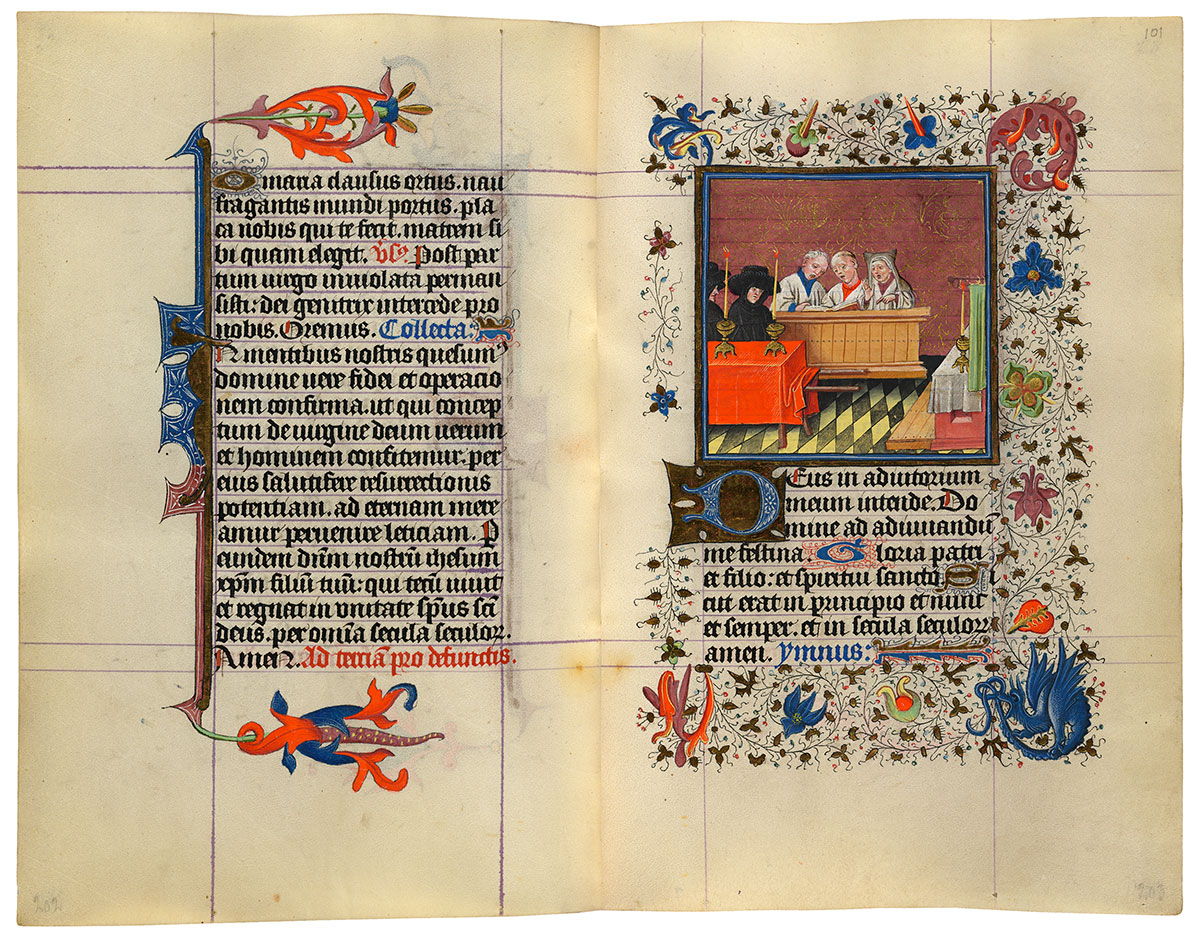
Chanting the Office of the Dead
Purchased on the Belle da Costa Greene Fund with the assistance of the Fellows and with special assistance of Mrs. Frederick B. Adams, Sr., Mrs. Robert Charles, Mr. Laurens M. Hamilton, The Heineman Foundation, Mrs. Donald F. Hyde, Mrs. Jacob M. Kaplan, Mrs. John Kean, Mr. Paul Mellon, Mr. and Mrs. Charles F. Morgan, Mr. Lessing J. Rosenwald, Mr. and Mrs. August H. Schilling, Mrs. Herbert N. Straus, Mrs. Landon K. Thorne, Mrs. Alan Valentine, Mr. and Mrs. Arnold Whitridge, and Miss Julia P. Wightman, 1970
Hours and Masses for the Seven Days of the Week
The most unusual texts in Catherine's manuscript are the series of Hours and Masses for every day of the week. Medieval Christian tradition associated certain figures or themes with different days. Thus Sunday, the day of the Resurrection, was the Lord's Day; Thursday was connected with the Eucharist since that sacrament was instituted on Holy Thursday; and Monday was the day of the dead, since their torments were suspended on Sunday but recommenced the following day. In Catherine's prayer book, the themes for the Hours and Masses of the seven days of the week are:
| Sunday | the Trinity |
| Monday | the Dead |
| Tuesday | the Holy Spirit |
| Wednesday | All Saints |
| Thursday | the Blessed Sacrament |
| Friday | the Compassion of God |
| Saturday | the Virgin. |
Image courtesy of Faksimile Verlag Luzern
MS M.917/945, ff. 101v–102r
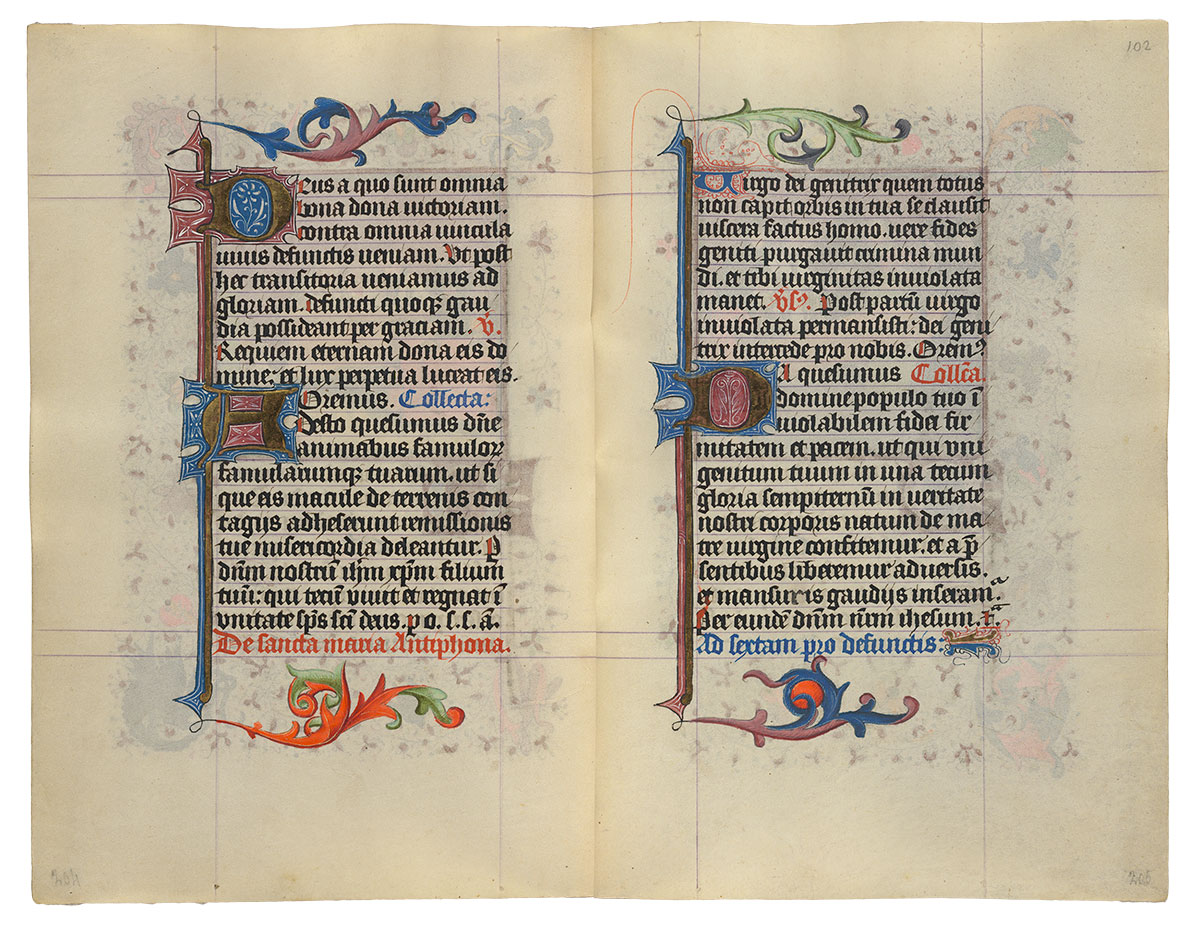
Purchased on the Belle da Costa Greene Fund with the assistance of the Fellows and with special assistance of Mrs. Frederick B. Adams, Sr., Mrs. Robert Charles, Mr. Laurens M. Hamilton, The Heineman Foundation, Mrs. Donald F. Hyde, Mrs. Jacob M. Kaplan, Mrs. John Kean, Mr. Paul Mellon, Mr. and Mrs. Charles F. Morgan, Mr. Lessing J. Rosenwald, Mr. and Mrs. August H. Schilling, Mrs. Herbert N. Straus, Mrs. Landon K. Thorne, Mrs. Alan Valentine, Mr. and Mrs. Arnold Whitridge, and Miss Julia P. Wightman, 1970
Image courtesy of Faksimile Verlag Luzern
MS M.917/945, ff. 102v–103r
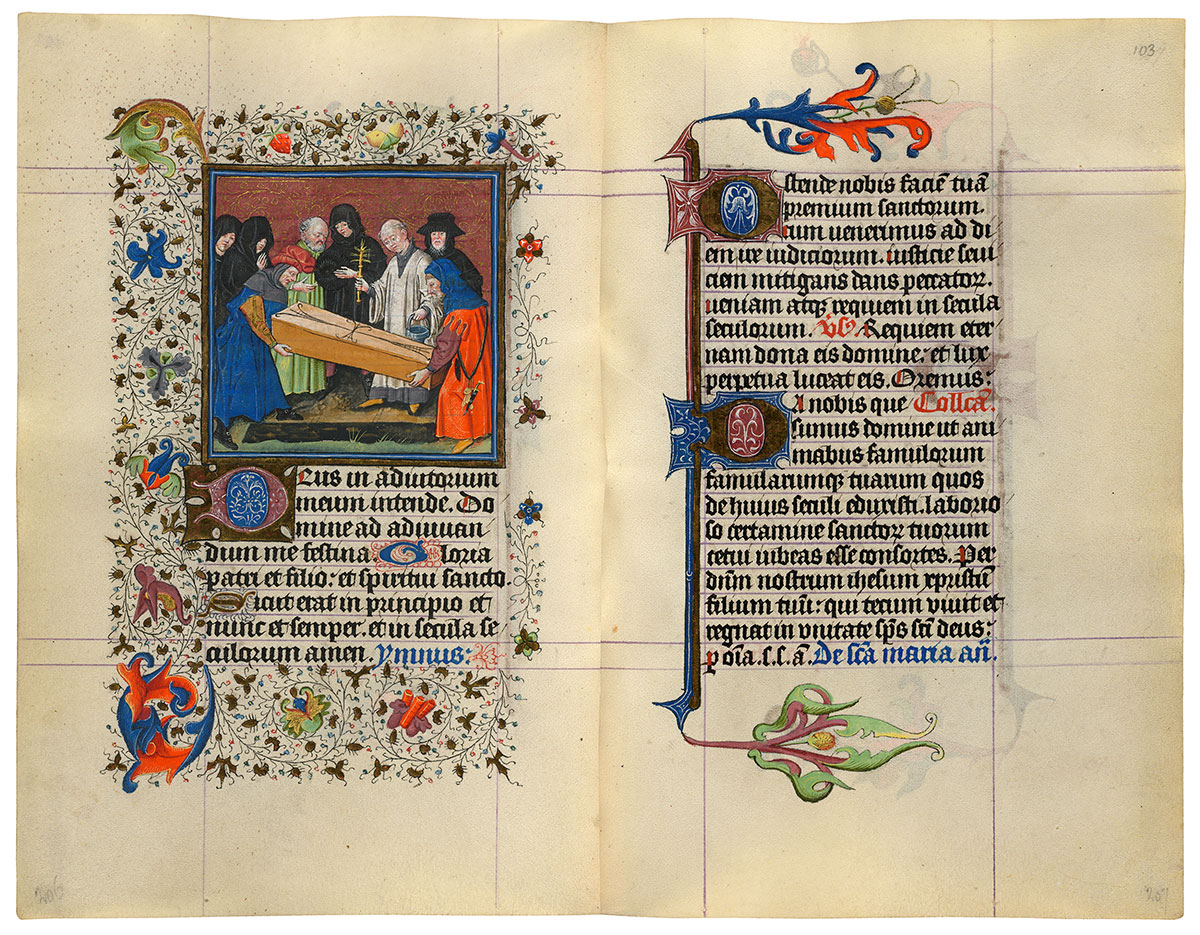
Burial
Purchased on the Belle da Costa Greene Fund with the assistance of the Fellows and with special assistance of Mrs. Frederick B. Adams, Sr., Mrs. Robert Charles, Mr. Laurens M. Hamilton, The Heineman Foundation, Mrs. Donald F. Hyde, Mrs. Jacob M. Kaplan, Mrs. John Kean, Mr. Paul Mellon, Mr. and Mrs. Charles F. Morgan, Mr. Lessing J. Rosenwald, Mr. and Mrs. August H. Schilling, Mrs. Herbert N. Straus, Mrs. Landon K. Thorne, Mrs. Alan Valentine, Mr. and Mrs. Arnold Whitridge, and Miss Julia P. Wightman, 1970
While the priest offers a final blessing of holy water, the man's body, in a wood coffin decorated with a black cross, is lowered into the grave. During the Middle Ages, however, most people were not buried in coffins; they were put in the ground protected only by a shroud. (Most graves were not permanent but a temporary place of rest until one's bones were cleansed of their rotten flesh.) The depiction of a coffin burial in this miniature might have been in keeping with Catherine's own funerary expectations.
Hours and Masses for the Seven Days of the Week
The most unusual texts in Catherine's manuscript are the series of Hours and Masses for every day of the week. Medieval Christian tradition associated certain figures or themes with different days. Thus Sunday, the day of the Resurrection, was the Lord's Day; Thursday was connected with the Eucharist since that sacrament was instituted on Holy Thursday; and Monday was the day of the dead, since their torments were suspended on Sunday but recommenced the following day. In Catherine's prayer book, the themes for the Hours and Masses of the seven days of the week are:
| Sunday | the Trinity |
| Monday | the Dead |
| Tuesday | the Holy Spirit |
| Wednesday | All Saints |
| Thursday | the Blessed Sacrament |
| Friday | the Compassion of God |
| Saturday | the Virgin. |
Image courtesy of Faksimile Verlag Luzern
MS M.917/945, ff. 103v–104r
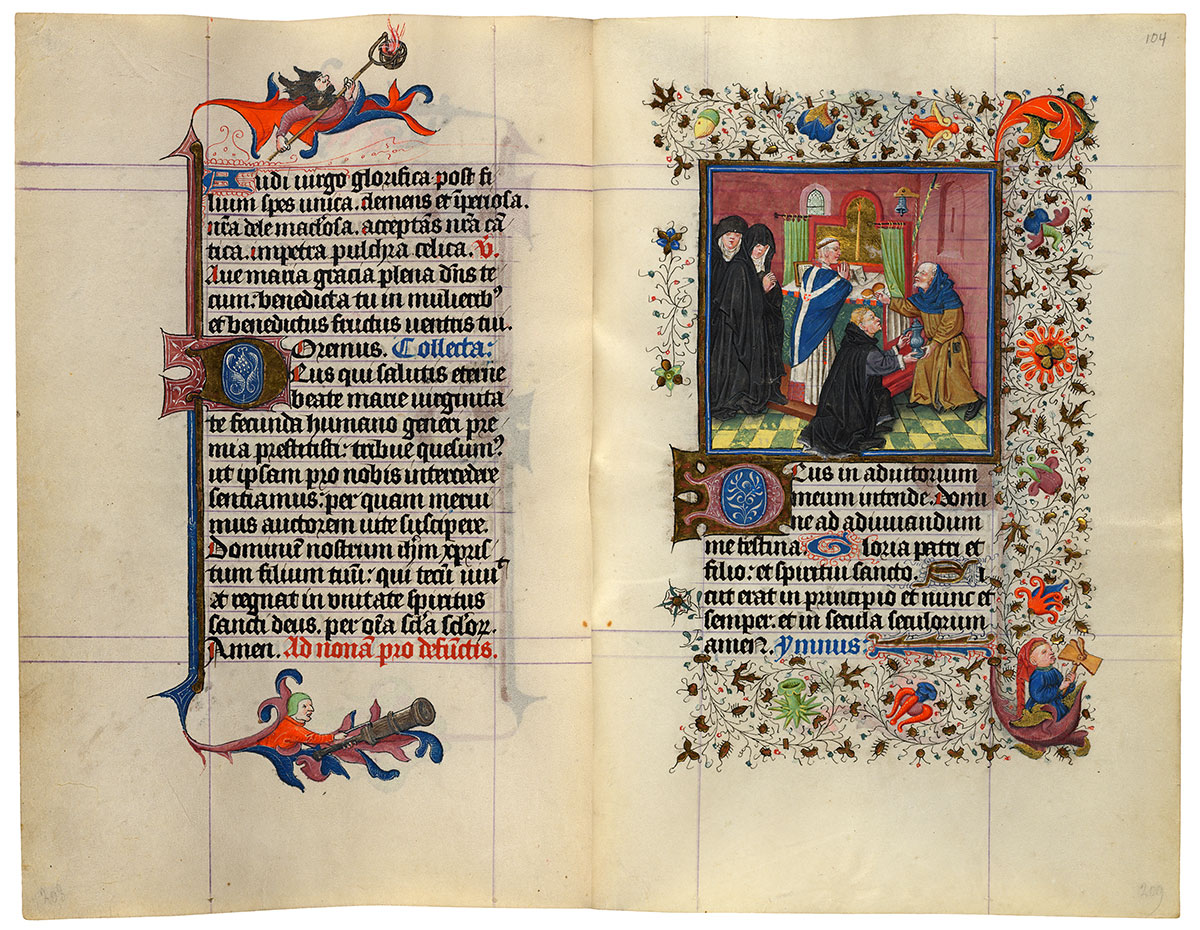
Offering at a Requiem Mass
Purchased on the Belle da Costa Greene Fund with the assistance of the Fellows and with special assistance of Mrs. Frederick B. Adams, Sr., Mrs. Robert Charles, Mr. Laurens M. Hamilton, The Heineman Foundation, Mrs. Donald F. Hyde, Mrs. Jacob M. Kaplan, Mrs. John Kean, Mr. Paul Mellon, Mr. and Mrs. Charles F. Morgan, Mr. Lessing J. Rosenwald, Mr. and Mrs. August H. Schilling, Mrs. Herbert N. Straus, Mrs. Landon K. Thorne, Mrs. Alan Valentine, Mr. and Mrs. Arnold Whitridge, and Miss Julia P. Wightman, 1970
Hours and Masses for the Seven Days of the Week
The most unusual texts in Catherine's manuscript are the series of Hours and Masses for every day of the week. Medieval Christian tradition associated certain figures or themes with different days. Thus Sunday, the day of the Resurrection, was the Lord's Day; Thursday was connected with the Eucharist since that sacrament was instituted on Holy Thursday; and Monday was the day of the dead, since their torments were suspended on Sunday but recommenced the following day. In Catherine's prayer book, the themes for the Hours and Masses of the seven days of the week are:
| Sunday | the Trinity |
| Monday | the Dead |
| Tuesday | the Holy Spirit |
| Wednesday | All Saints |
| Thursday | the Blessed Sacrament |
| Friday | the Compassion of God |
| Saturday | the Virgin. |
Image courtesy of Faksimile Verlag Luzern
MS M.917/945, ff. 104v–105r
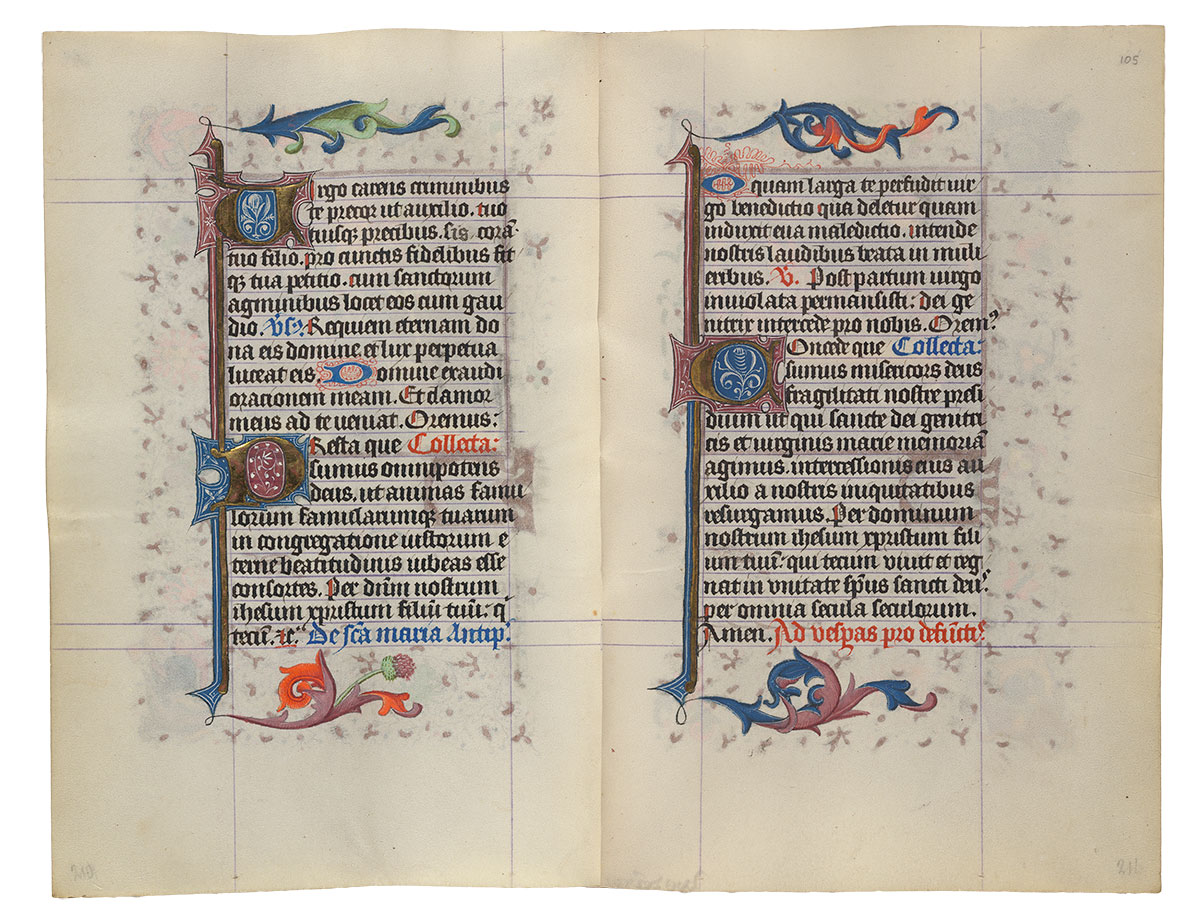
Purchased on the Belle da Costa Greene Fund with the assistance of the Fellows and with special assistance of Mrs. Frederick B. Adams, Sr., Mrs. Robert Charles, Mr. Laurens M. Hamilton, The Heineman Foundation, Mrs. Donald F. Hyde, Mrs. Jacob M. Kaplan, Mrs. John Kean, Mr. Paul Mellon, Mr. and Mrs. Charles F. Morgan, Mr. Lessing J. Rosenwald, Mr. and Mrs. August H. Schilling, Mrs. Herbert N. Straus, Mrs. Landon K. Thorne, Mrs. Alan Valentine, Mr. and Mrs. Arnold Whitridge, and Miss Julia P. Wightman, 1970
Image courtesy of Faksimile Verlag Luzern
MS M.917/945, ff. 105v–106r
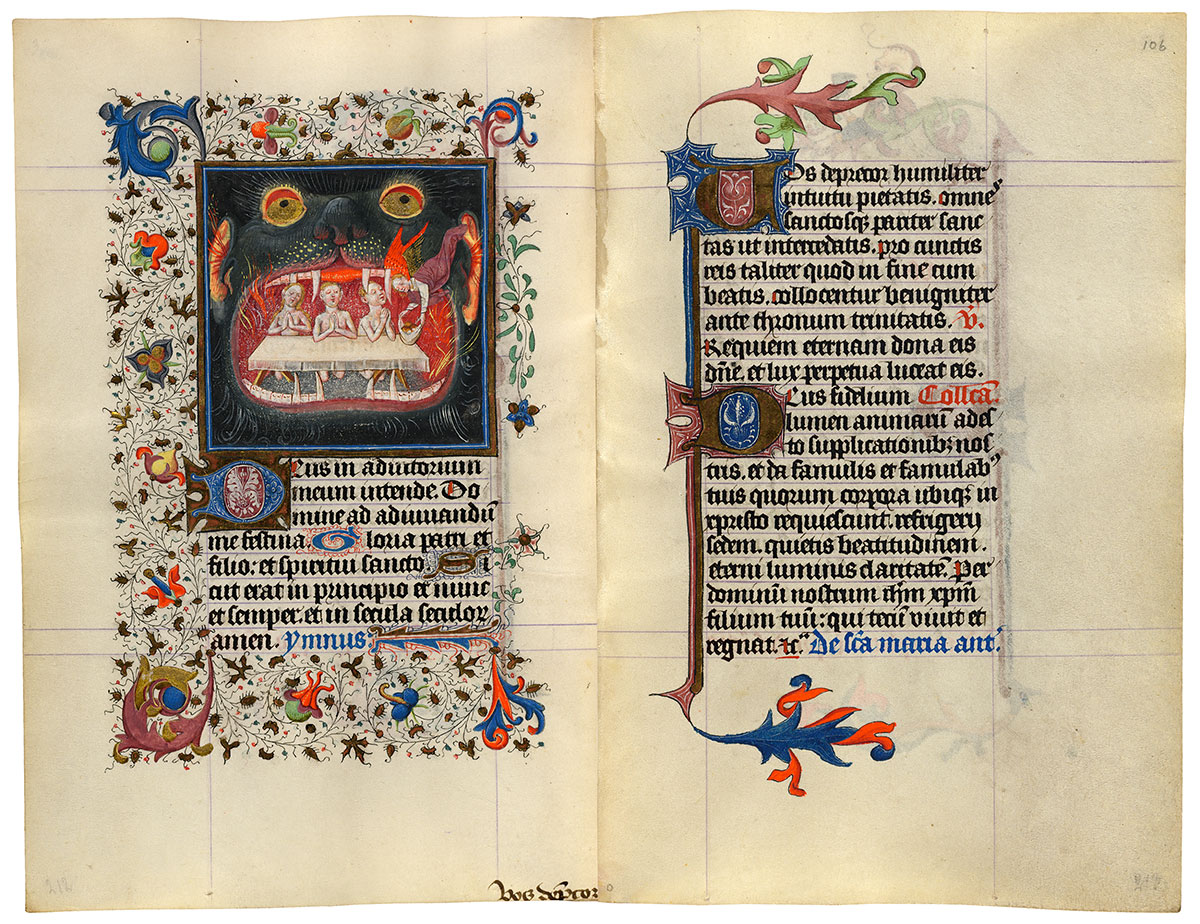
Souls in Purgatory Consoled with the Offering
Purchased on the Belle da Costa Greene Fund with the assistance of the Fellows and with special assistance of Mrs. Frederick B. Adams, Sr., Mrs. Robert Charles, Mr. Laurens M. Hamilton, The Heineman Foundation, Mrs. Donald F. Hyde, Mrs. Jacob M. Kaplan, Mrs. John Kean, Mr. Paul Mellon, Mr. and Mrs. Charles F. Morgan, Mr. Lessing J. Rosenwald, Mr. and Mrs. August H. Schilling, Mrs. Herbert N. Straus, Mrs. Landon K. Thorne, Mrs. Alan Valentine, Mr. and Mrs. Arnold Whitridge, and Miss Julia P. Wightman, 1970
Hours and Masses for the Seven Days of the Week
The most unusual texts in Catherine's manuscript are the series of Hours and Masses for every day of the week. Medieval Christian tradition associated certain figures or themes with different days. Thus Sunday, the day of the Resurrection, was the Lord's Day; Thursday was connected with the Eucharist since that sacrament was instituted on Holy Thursday; and Monday was the day of the dead, since their torments were suspended on Sunday but recommenced the following day. In Catherine's prayer book, the themes for the Hours and Masses of the seven days of the week are:
| Sunday | the Trinity |
| Monday | the Dead |
| Tuesday | the Holy Spirit |
| Wednesday | All Saints |
| Thursday | the Blessed Sacrament |
| Friday | the Compassion of God |
| Saturday | the Virgin. |
Image courtesy of Faksimile Verlag Luzern
MS M.917/945, ff. 106v–107r
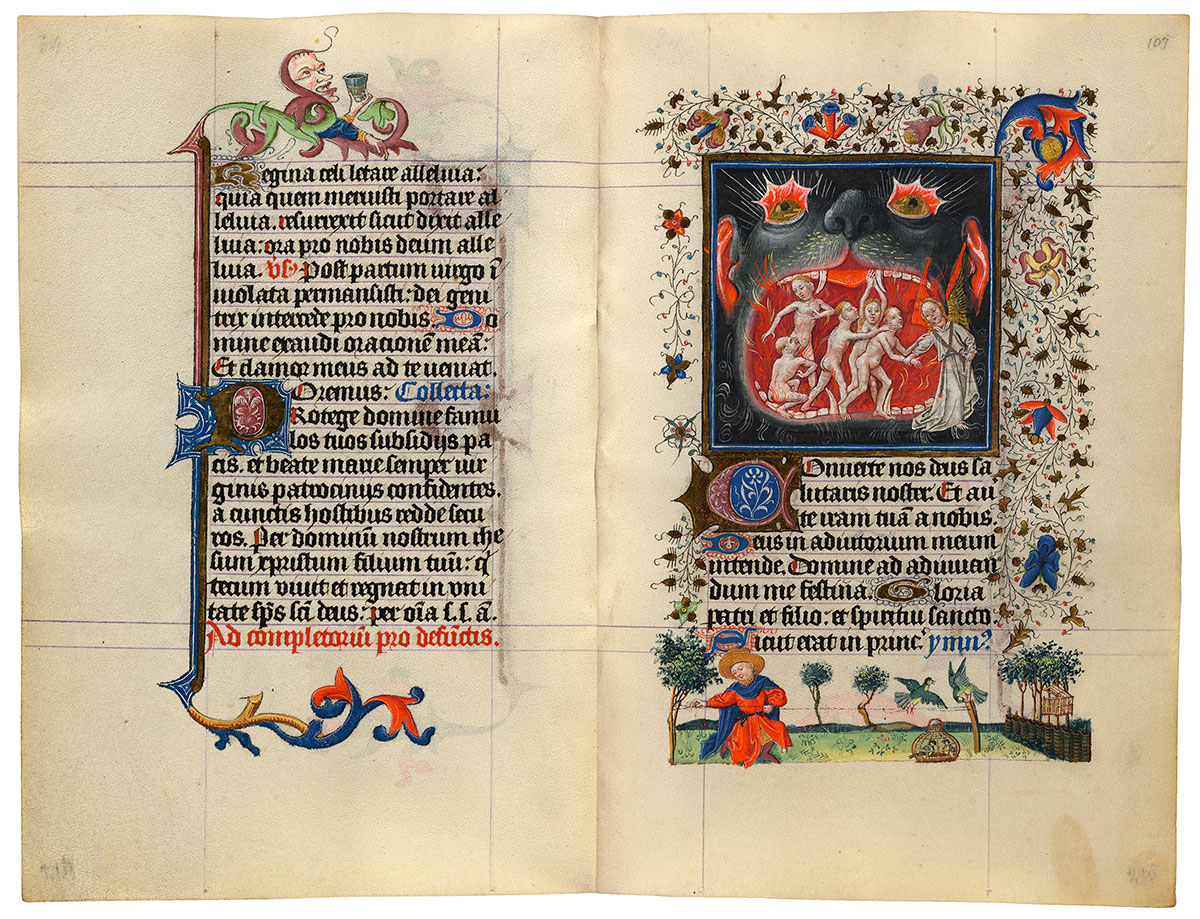
Souls Released from Purgatory
Purchased on the Belle da Costa Greene Fund with the assistance of the Fellows and with special assistance of Mrs. Frederick B. Adams, Sr., Mrs. Robert Charles, Mr. Laurens M. Hamilton, The Heineman Foundation, Mrs. Donald F. Hyde, Mrs. Jacob M. Kaplan, Mrs. John Kean, Mr. Paul Mellon, Mr. and Mrs. Charles F. Morgan, Mr. Lessing J. Rosenwald, Mr. and Mrs. August H. Schilling, Mrs. Herbert N. Straus, Mrs. Landon K. Thorne, Mrs. Alan Valentine, Mr. and Mrs. Arnold Whitridge, and Miss Julia P. Wightman, 1970
The Monday Hours of the Dead end on this happy note. Indeed, this miniature for the final Hour of Compline depicts the whole point of praying the Hours of the Dead: shortening the time spent by one's friends and relatives in the fires of purgatory. An angel leads an overjoyed group of naked souls from their fiery torment. In the bottom border, the vignette of a man caging birds is a secular counterpoint to the miniature's religious theme.
Hours and Masses for the Seven Days of the Week
The most unusual texts in Catherine's manuscript are the series of Hours and Masses for every day of the week. Medieval Christian tradition associated certain figures or themes with different days. Thus Sunday, the day of the Resurrection, was the Lord's Day; Thursday was connected with the Eucharist since that sacrament was instituted on Holy Thursday; and Monday was the day of the dead, since their torments were suspended on Sunday but recommenced the following day. In Catherine's prayer book, the themes for the Hours and Masses of the seven days of the week are:
| Sunday | the Trinity |
| Monday | the Dead |
| Tuesday | the Holy Spirit |
| Wednesday | All Saints |
| Thursday | the Blessed Sacrament |
| Friday | the Compassion of God |
| Saturday | the Virgin. |
Image courtesy of Faksimile Verlag Luzern
MS M.917/945, ff. 107v–108r
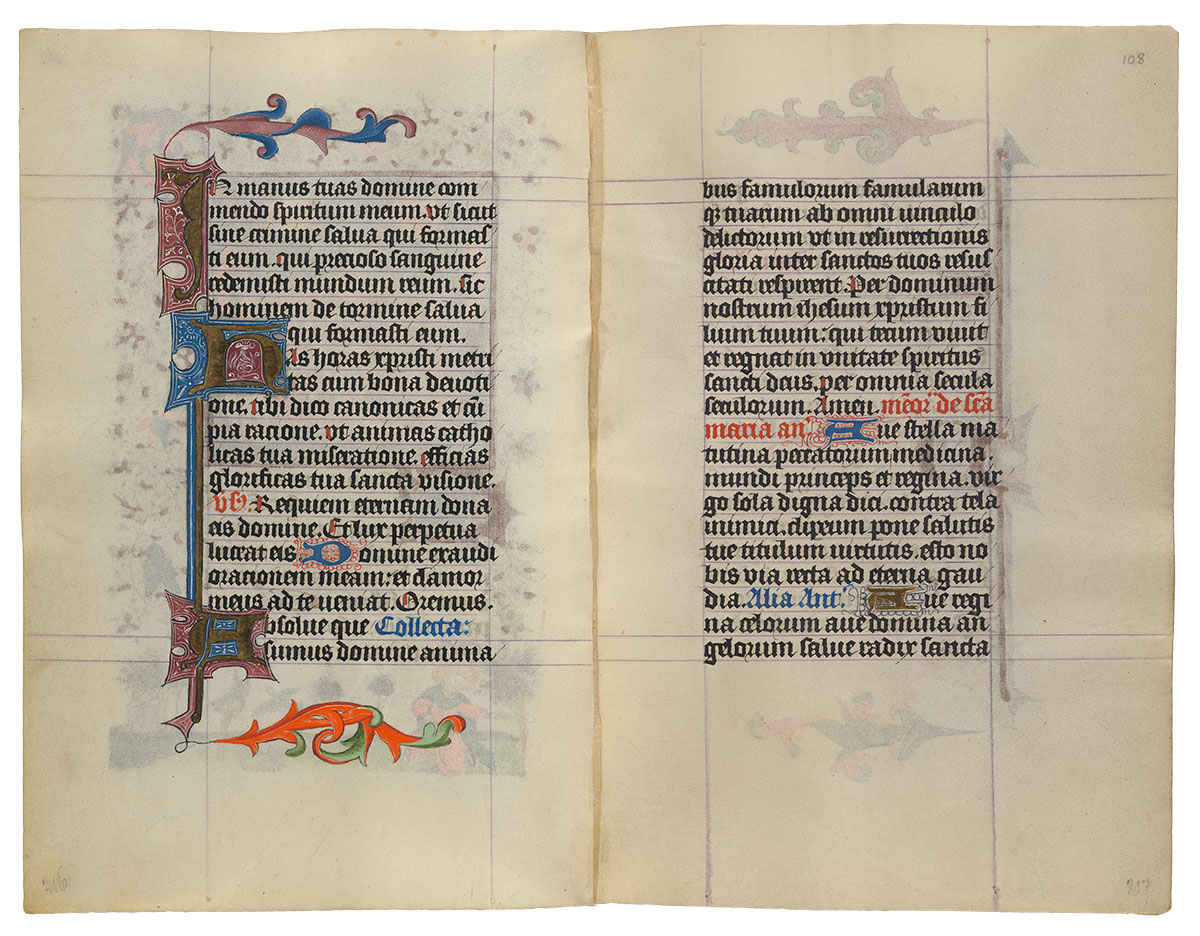
Purchased on the Belle da Costa Greene Fund with the assistance of the Fellows and with special assistance of Mrs. Frederick B. Adams, Sr., Mrs. Robert Charles, Mr. Laurens M. Hamilton, The Heineman Foundation, Mrs. Donald F. Hyde, Mrs. Jacob M. Kaplan, Mrs. John Kean, Mr. Paul Mellon, Mr. and Mrs. Charles F. Morgan, Mr. Lessing J. Rosenwald, Mr. and Mrs. August H. Schilling, Mrs. Herbert N. Straus, Mrs. Landon K. Thorne, Mrs. Alan Valentine, Mr. and Mrs. Arnold Whitridge, and Miss Julia P. Wightman, 1970
Image courtesy of Faksimile Verlag Luzern
MSS M.917/945, f. 108v–p. 29
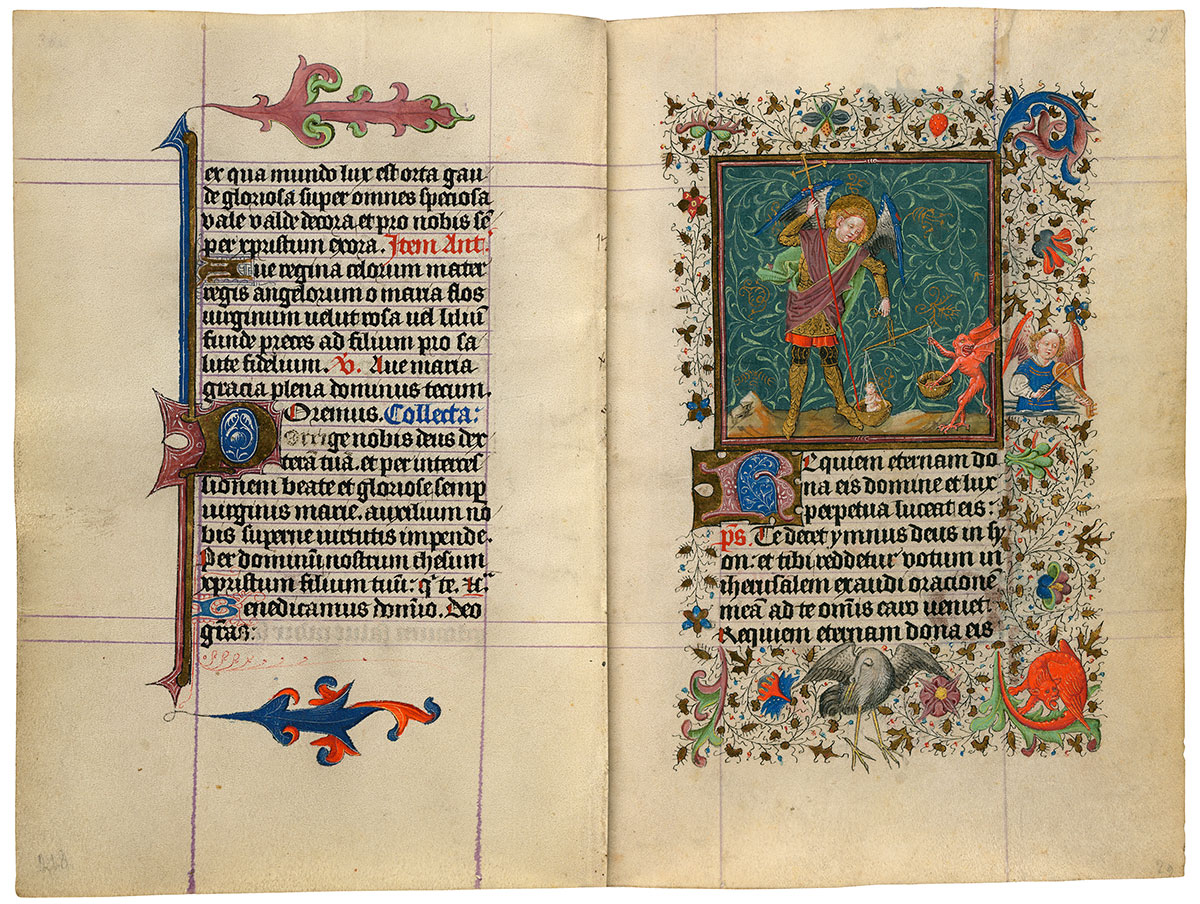
St. Michael Weighing Souls
Purchased on the Belle da Costa Greene Fund with the assistance of the Fellows and with special assistance of Mrs. Frederick B. Adams, Sr., Mrs. Robert Charles, Mr. Laurens M. Hamilton, The Heineman Foundation, Mrs. Donald F. Hyde, Mrs. Jacob M. Kaplan, Mrs. John Kean, Mr. Paul Mellon, Mr. and Mrs. Charles F. Morgan, Mr. Lessing J. Rosenwald, Mr. and Mrs. August H. Schilling, Mrs. Herbert N. Straus, Mrs. Landon K. Thorne, Mrs. Alan Valentine, Mr. and Mrs. Arnold Whitridge, and Miss Julia P. Wightman, 1970; purchased on the Belle da Costa Greene Fund with the assistance of the Fellows, 1963
The large miniature that introduced the Mass of the Dead is lost. Its smaller miniature survives and is shown here. The Archangel Michael is the weigher of souls at the Last Judgment. A naked soul sits in the sinking left cup of the scales, heavy with his goodness. An orange demon attempts to alter the outcome by pulling down on the other cup. Michael's judicious observations ensure the pious man's heavenly reward, which is alluded to by the music-making angel in the right border (to the dismay of the hissing monster at the lower right).
Hours and Masses for the Seven Days of the Week
The most unusual texts in Catherine's manuscript are the series of Hours and Masses for every day of the week. Medieval Christian tradition associated certain figures or themes with different days. Thus Sunday, the day of the Resurrection, was the Lord's Day; Thursday was connected with the Eucharist since that sacrament was instituted on Holy Thursday; and Monday was the day of the dead, since their torments were suspended on Sunday but recommenced the following day. In Catherine's prayer book, the themes for the Hours and Masses of the seven days of the week are:
| Sunday | the Trinity |
| Monday | the Dead |
| Tuesday | the Holy Spirit |
| Wednesday | All Saints |
| Thursday | the Blessed Sacrament |
| Friday | the Compassion of God |
| Saturday | the Virgin. |
Image courtesy of Faksimile Verlag Luzern
MS M.917/945, pp. 30–31
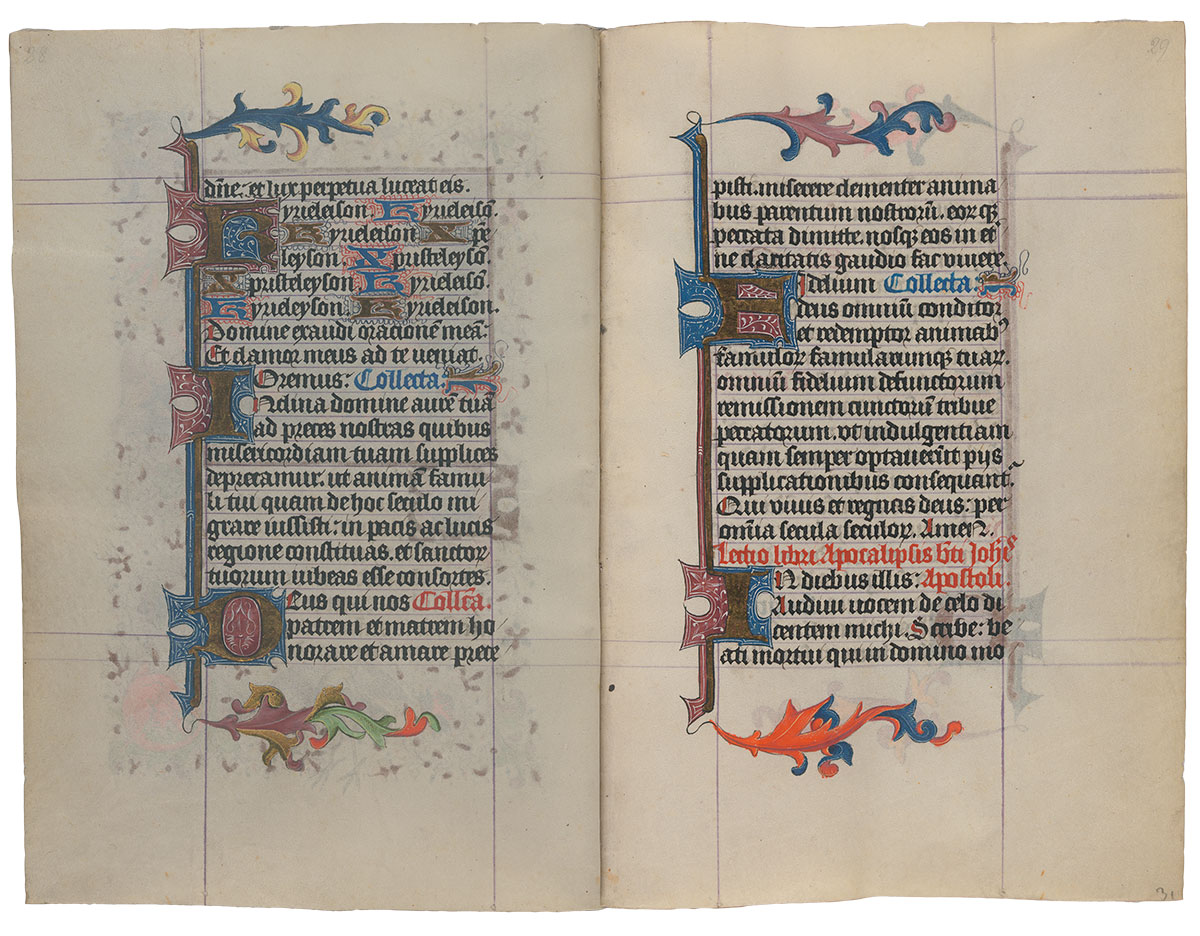
Purchased on the Belle da Costa Greene Fund with the assistance of the Fellows, 1963
Image courtesy of Faksimile Verlag Luzern
MS M.917/945, pp. 32–33
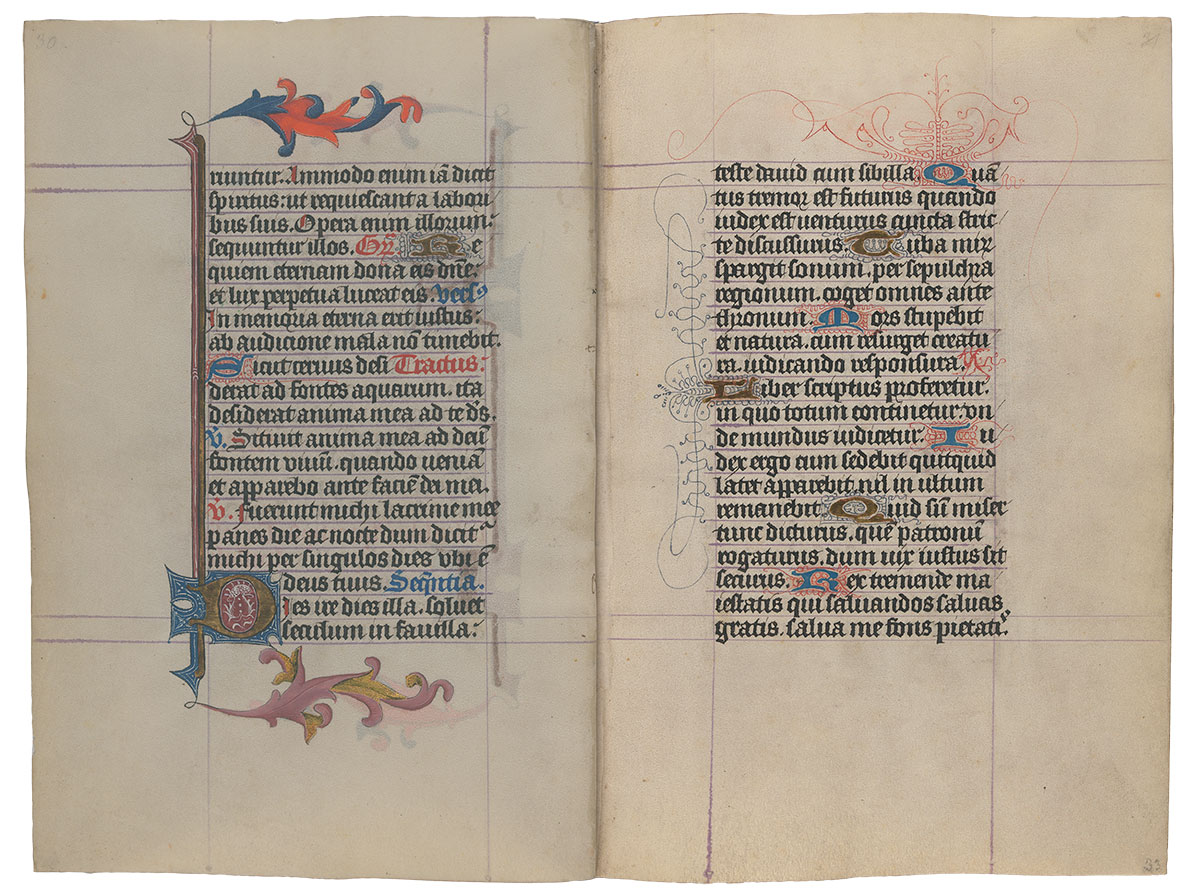
Purchased on the Belle da Costa Greene Fund with the assistance of the Fellows, 1963
Image courtesy of Faksimile Verlag Luzern
MS M.917/945, pp. 34–45
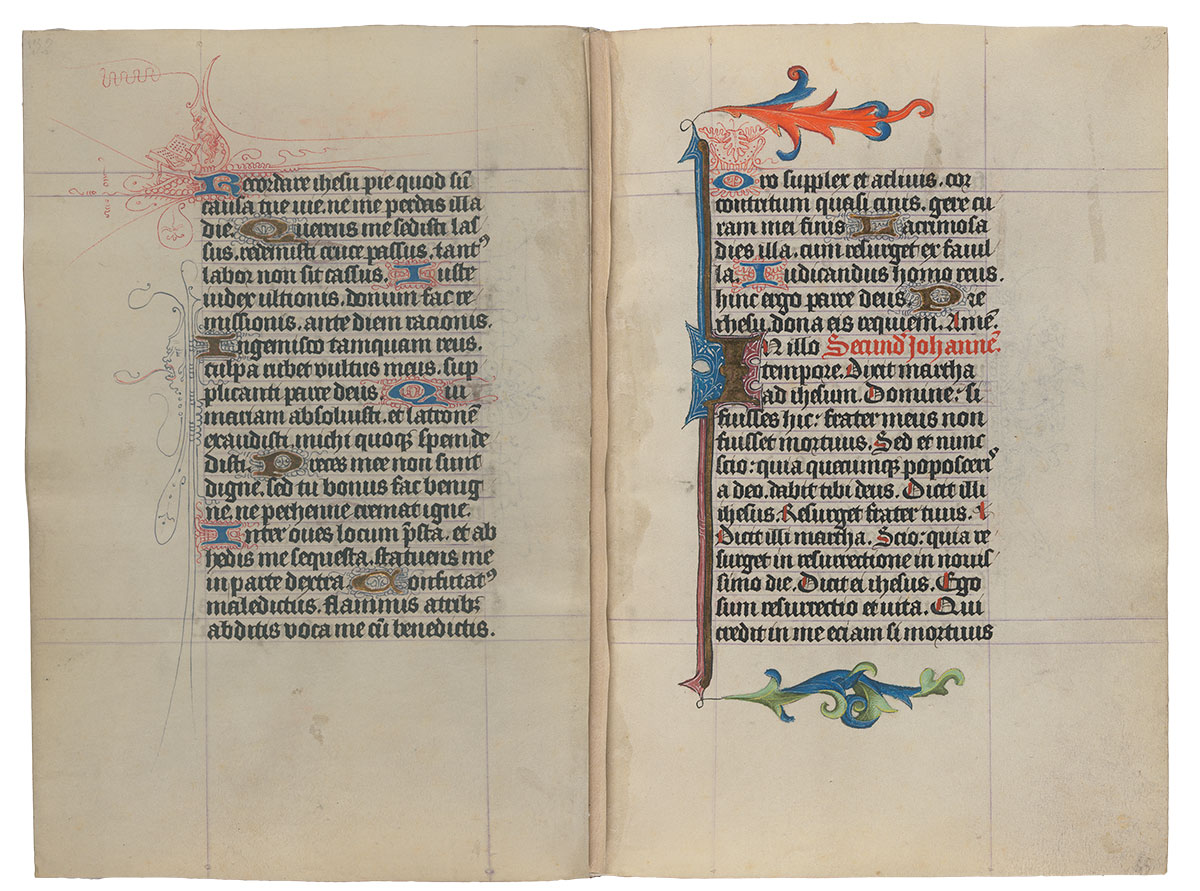
Purchased on the Belle da Costa Greene Fund with the assistance of the Fellows, 1963
Image courtesy of Faksimile Verlag Luzern
MS M.917/945, pp. 46–47
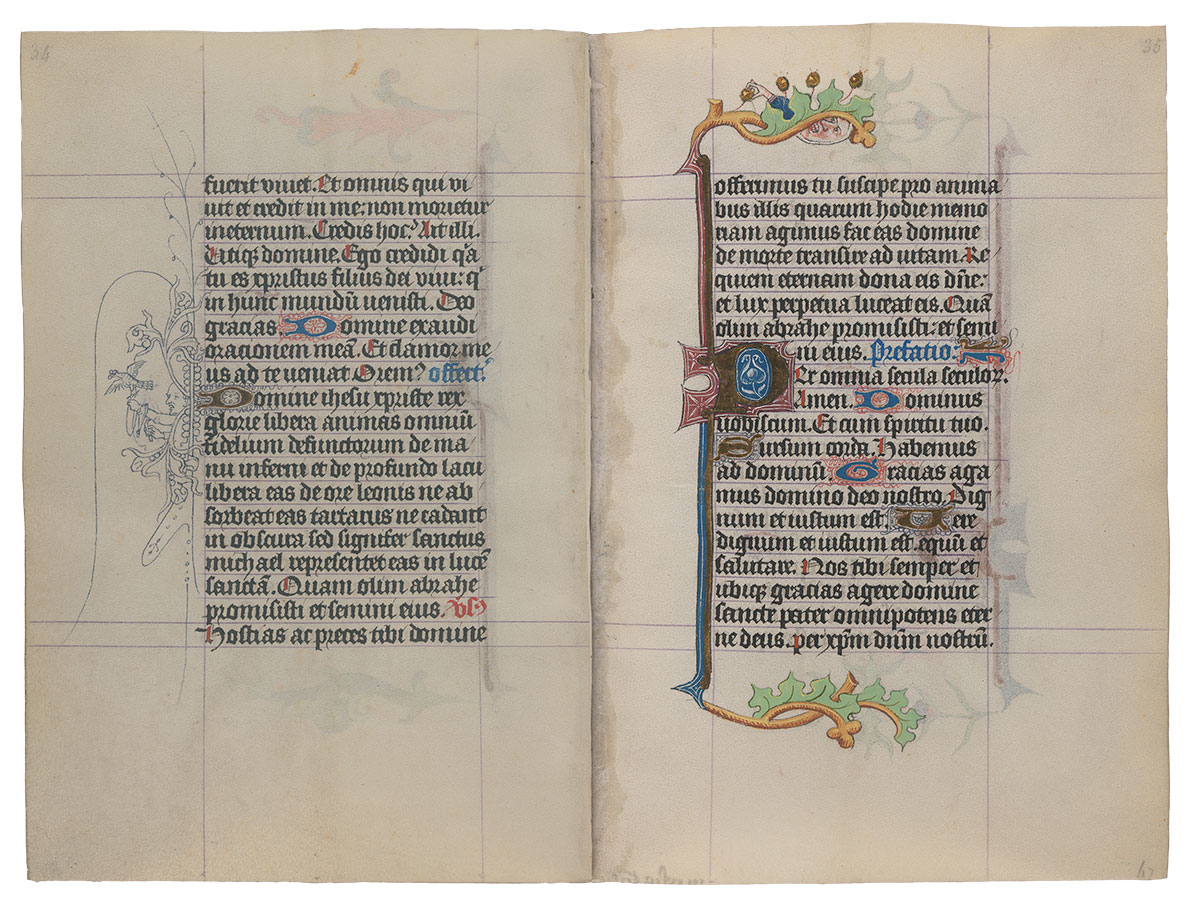
Purchased on the Belle da Costa Greene Fund with the assistance of the Fellows, 1963
Image courtesy of Faksimile Verlag Luzern
MS M.917/945, pp. 48–49
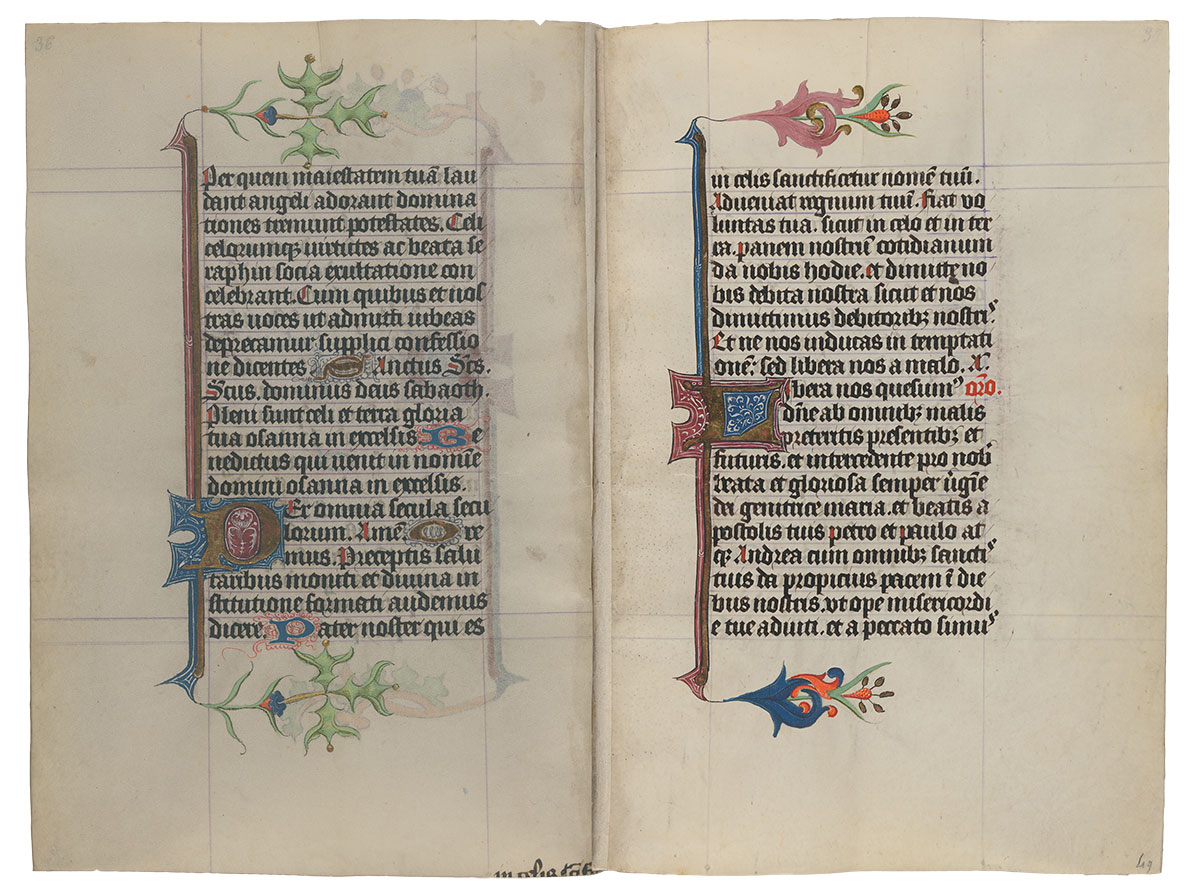
Purchased on the Belle da Costa Greene Fund with the assistance of the Fellows, 1963
Image courtesy of Faksimile Verlag Luzern
MS M.917/945, pp. 50–51
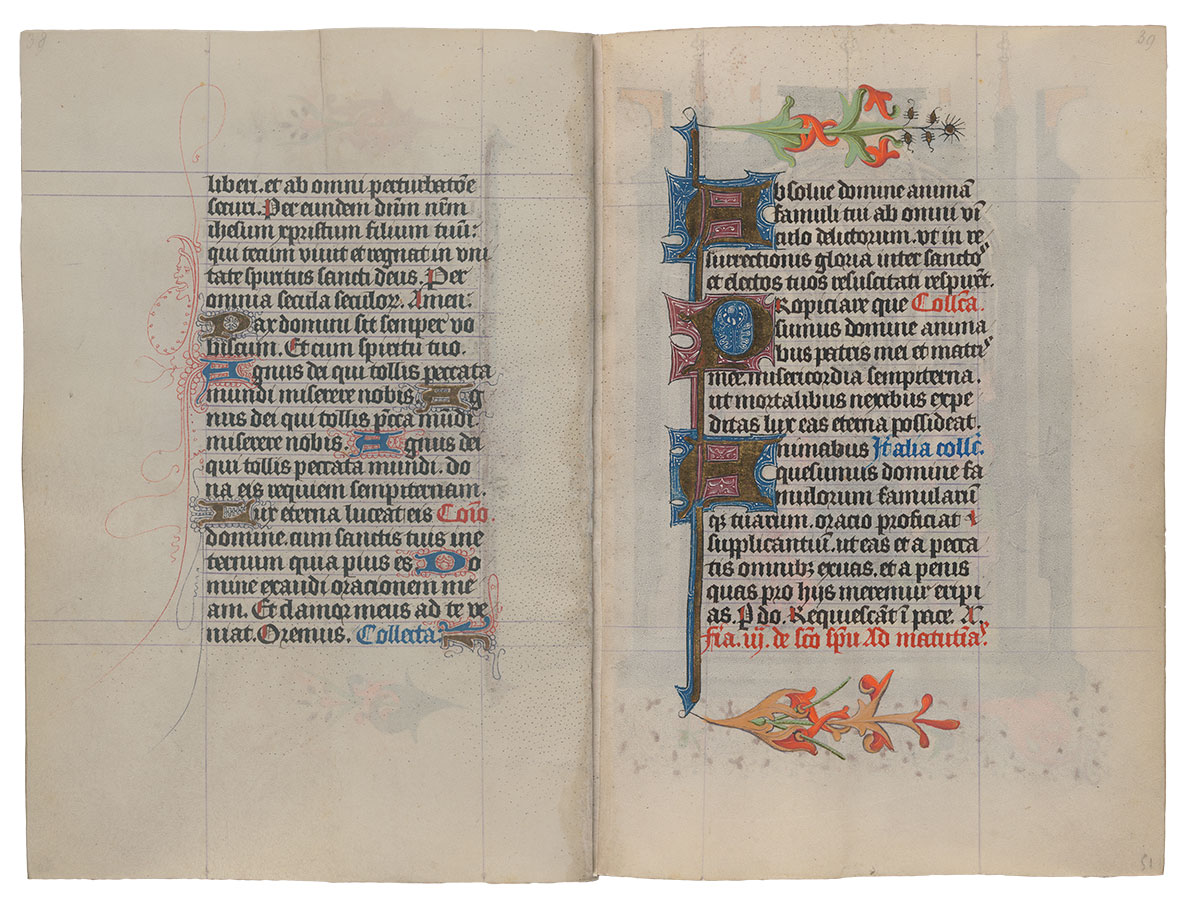
Purchased on the Belle da Costa Greene Fund with the assistance of the Fellows, 1963
Image courtesy of Faksimile Verlag Luzern
MS M.917/945, pp. 52–53
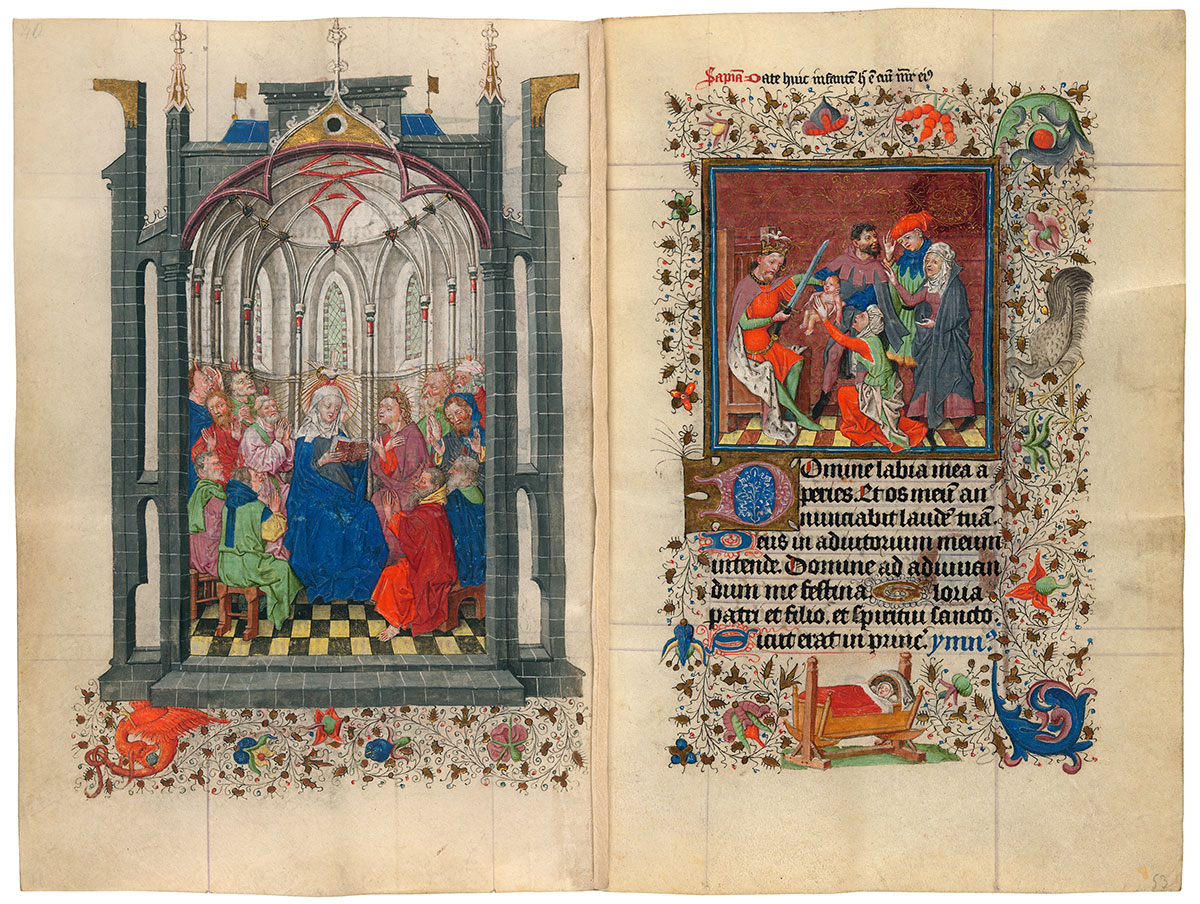
Pentecost
Judgment of Solomon
Purchased on the Belle da Costa Greene Fund with the assistance of the Fellows, 1963
The Tuesday Hours of the Holy Spirit begin with these juxtaposed images. On the left is Pentecost, the descent of the Holy Spirit upon the apostles, who were then inspired to convert the world. The smaller miniature illustrates the first of the Seven Gifts of the Holy Spirit. Wisdom, the first gift, is illustrated by Solomon's sagacity in determining the true mother of a disputed child by threatening to cut the baby in two. (The baby's real mother renounces her claim, raising her hand to prevent the strike of the sword.) The happy resolution of the dispute is illustrated
in the bottom border.
Hours and Masses for the Seven Days of the Week
The most unusual texts in Catherine's manuscript are the series of Hours and Masses for every day of the week. Medieval Christian tradition associated certain figures or themes with different days. Thus Sunday, the day of the Resurrection, was the Lord's Day; Thursday was connected with the Eucharist since that sacrament was instituted on Holy Thursday; and Monday was the day of the dead, since their torments were suspended on Sunday but recommenced the following day. In Catherine's prayer book, the themes for the Hours and Masses of the seven days of the week are:
| Sunday | the Trinity |
| Monday | the Dead |
| Tuesday | the Holy Spirit |
| Wednesday | All Saints |
| Thursday | the Blessed Sacrament |
| Friday | the Compassion of God |
| Saturday | the Virgin. |
Image courtesy of Faksimile Verlag Luzern
MS M.917/945, pp. 54–55
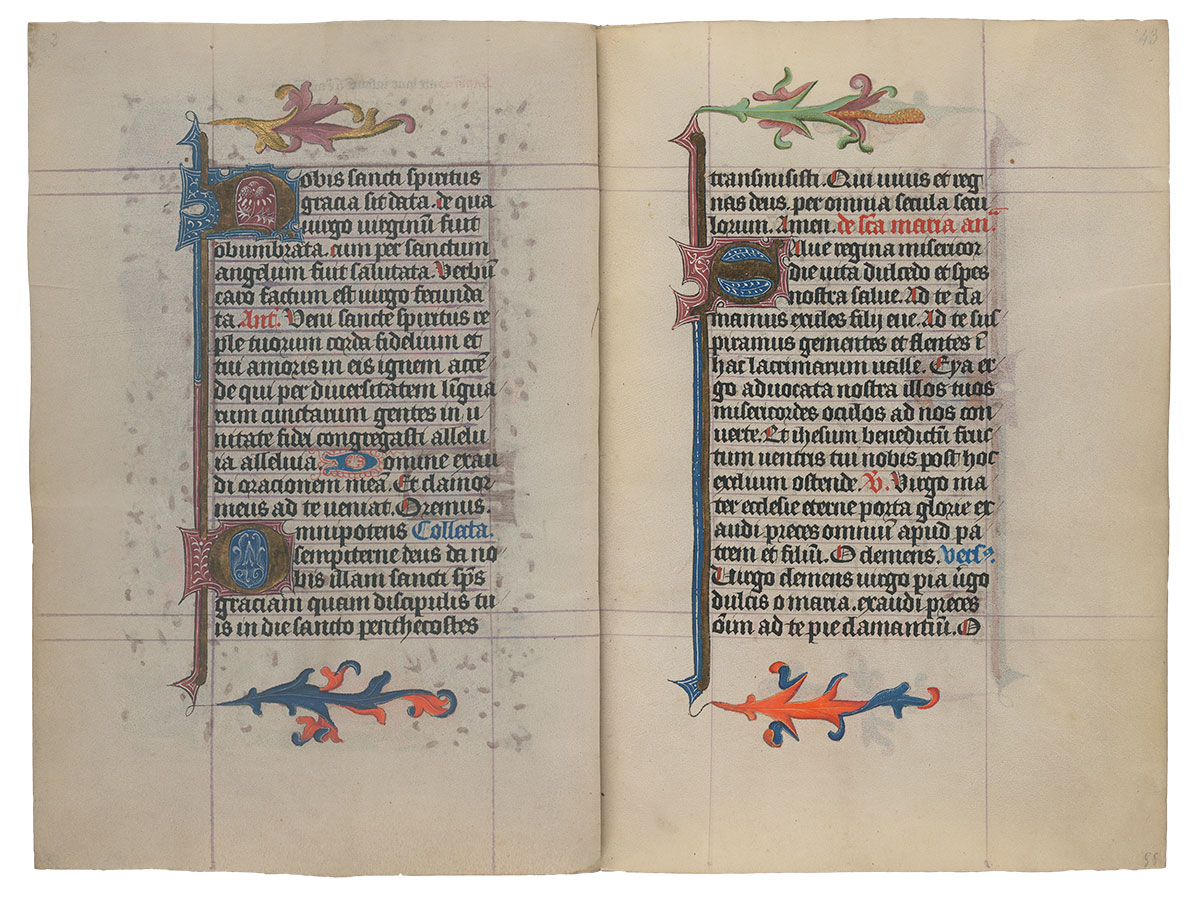
Purchased on the Belle da Costa Greene Fund with the assistance of the Fellows, 1963
Image courtesy of Faksimile Verlag Luzern
MS M.917/945, pp. 56–57
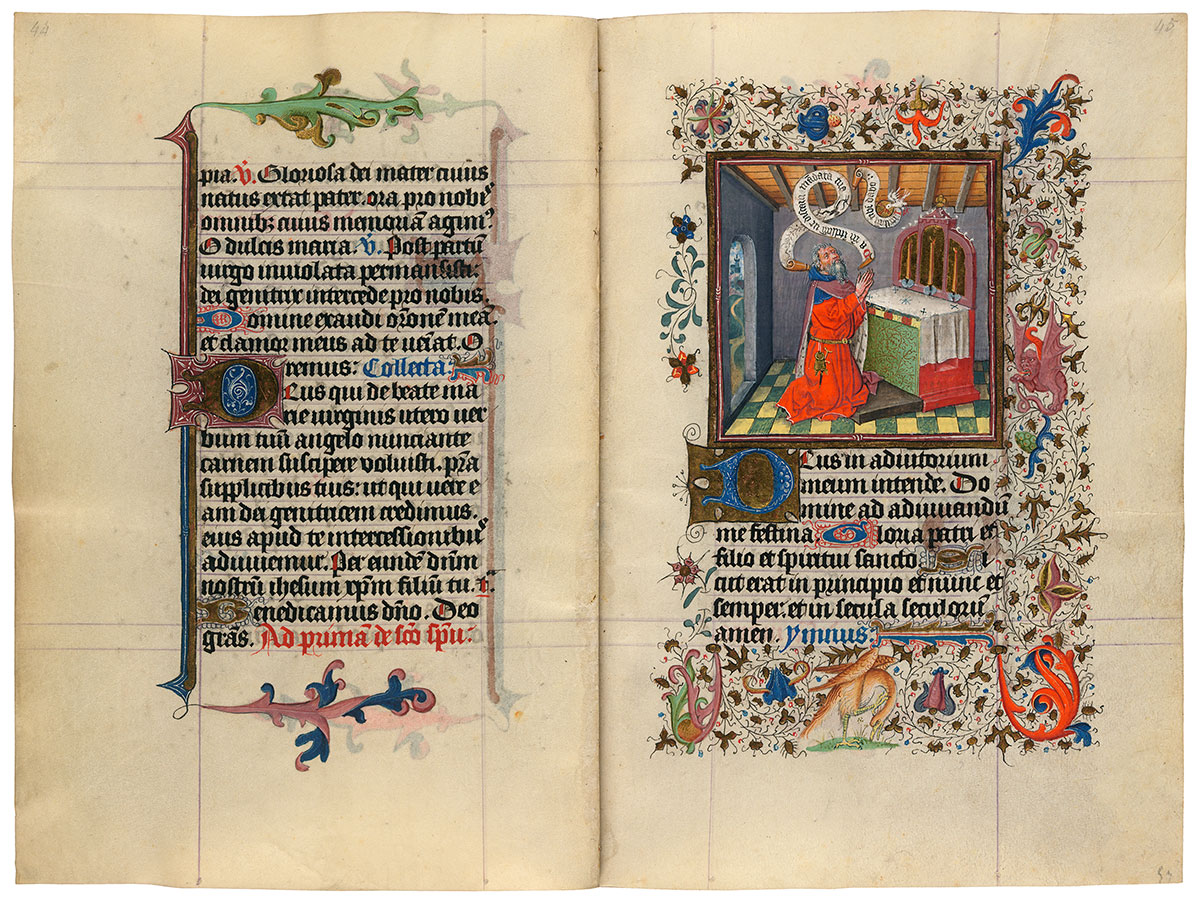
David (?) Praying Before an Altar
Purchased on the Belle da Costa Greene Fund with the assistance of the Fellows, 1963
Understanding, the second gift of the Holy Spirit, is illustrated by a man, most probably meant to be King David, who kneels before a significantly empty altar. His scroll paraphrases Psalm 118, verse 34: "Give me understanding that I may learn your commandments." The Dove of the Holy Spirit answers his petition positively, "I shall give you understanding."
Hours and Masses for the Seven Days of the Week
The most unusual texts in Catherine's manuscript are the series of Hours and Masses for every day of the week. Medieval Christian tradition associated certain figures or themes with different days. Thus Sunday, the day of the Resurrection, was the Lord's Day; Thursday was connected with the Eucharist since that sacrament was instituted on Holy Thursday; and Monday was the day of the dead, since their torments were suspended on Sunday but recommenced the following day. In Catherine's prayer book, the themes for the Hours and Masses of the seven days of the week are:
| Sunday | the Trinity |
| Monday | the Dead |
| Tuesday | the Holy Spirit |
| Wednesday | All Saints |
| Thursday | the Blessed Sacrament |
| Friday | the Compassion of God |
| Saturday | the Virgin. |
Image courtesy of Faksimile Verlag Luzern
MS M.917/945, pp. 58–59
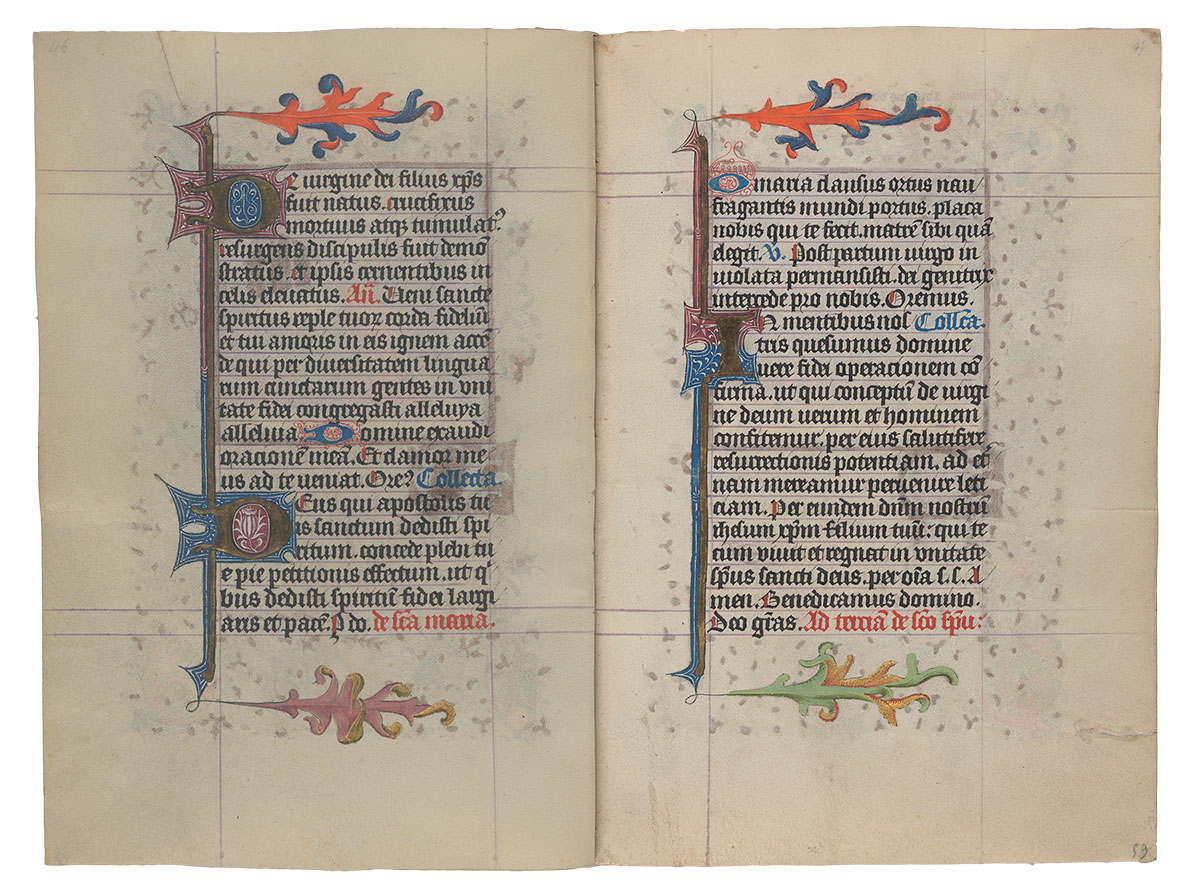
Purchased on the Belle da Costa Greene Fund with the assistance of the Fellows, 1963
Image courtesy of Faksimile Verlag Luzern
MS M.917/945, pp. 60–35
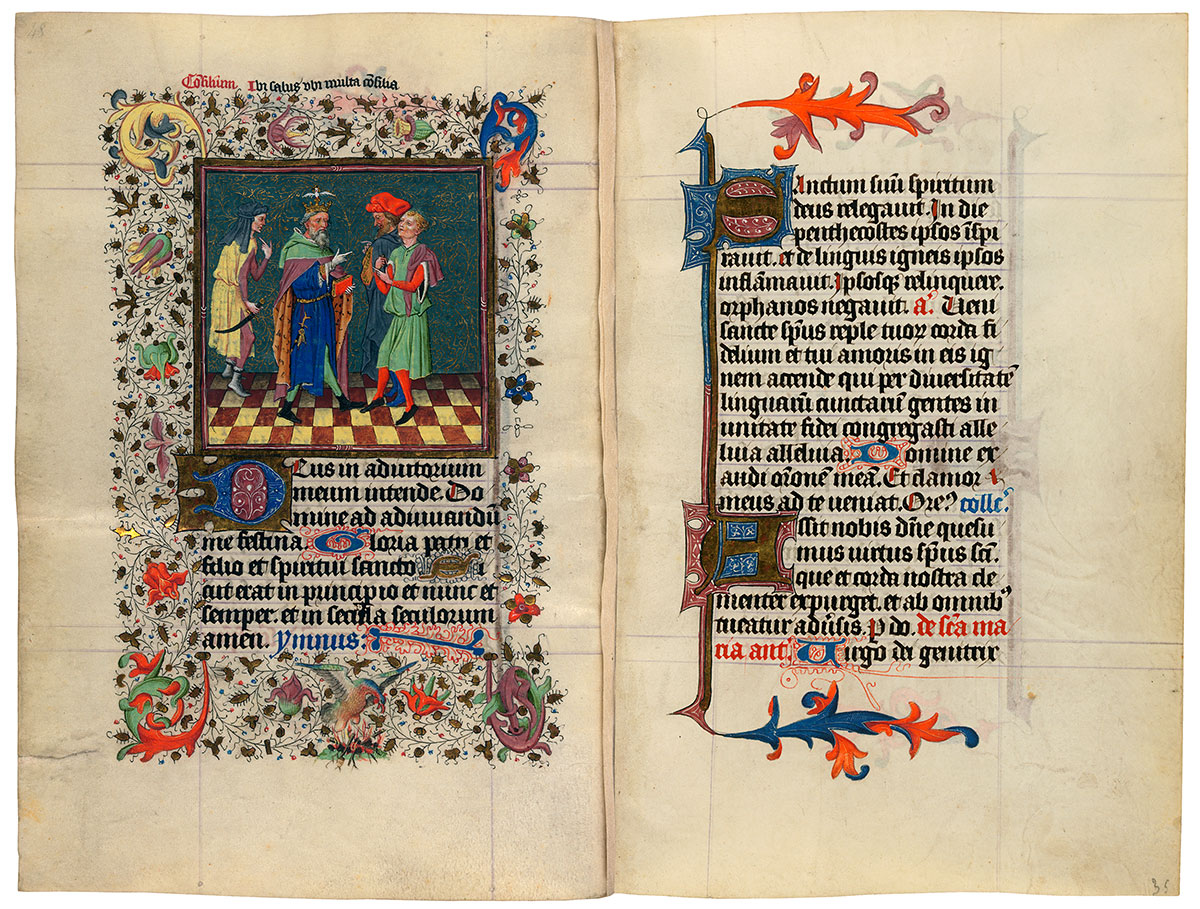
King and Advisers Taking Counsel
Purchased on the Belle da Costa Greene Fund with the assistance of the Fellows, 1963
Hours and Masses for the Seven Days of the Week
The most unusual texts in Catherine's manuscript are the series of Hours and Masses for every day of the week. Medieval Christian tradition associated certain figures or themes with different days. Thus Sunday, the day of the Resurrection, was the Lord's Day; Thursday was connected with the Eucharist since that sacrament was instituted on Holy Thursday; and Monday was the day of the dead, since their torments were suspended on Sunday but recommenced the following day. In Catherine's prayer book, the themes for the Hours and Masses of the seven days of the week are:
| Sunday | the Trinity |
| Monday | the Dead |
| Tuesday | the Holy Spirit |
| Wednesday | All Saints |
| Thursday | the Blessed Sacrament |
| Friday | the Compassion of God |
| Saturday | the Virgin. |
Image courtesy of Faksimile Verlag Luzern
MS M.917/945, pp. 36–73

Jacob Struggling with the Angel
Purchased on the Belle da Costa Greene Fund with the assistance of the Fellows, 1963
Fortitude, the fourth gift of the Holy Spirit, is represented by Jacob's conquest of the angel. Catherine of Cleves would have been assisted in this obscure reference by the textual key provided in the top margin: "The strong Jacob says 'I will not let you go.' The angel begs, 'Let me go; dawn has arrived.'" The inspiring Dove of the Holy Spirit flies above the patriarch's head. The angel's sacerdotal garb, similar to that worn in previous miniatures, makes him analogous with the Holy Spirit.
Hours and Masses for the Seven Days of the Week
The most unusual texts in Catherine's manuscript are the series of Hours and Masses for every day of the week. Medieval Christian tradition associated certain figures or themes with different days. Thus Sunday, the day of the Resurrection, was the Lord's Day; Thursday was connected with the Eucharist since that sacrament was instituted on Holy Thursday; and Monday was the day of the dead, since their torments were suspended on Sunday but recommenced the following day. In Catherine's prayer book, the themes for the Hours and Masses of the seven days of the week are:
| Sunday | the Trinity |
| Monday | the Dead |
| Tuesday | the Holy Spirit |
| Wednesday | All Saints |
| Thursday | the Blessed Sacrament |
| Friday | the Compassion of God |
| Saturday | the Virgin. |
Image courtesy of Faksimile Verlag Luzern
MS M.917/945, pp. 74–61
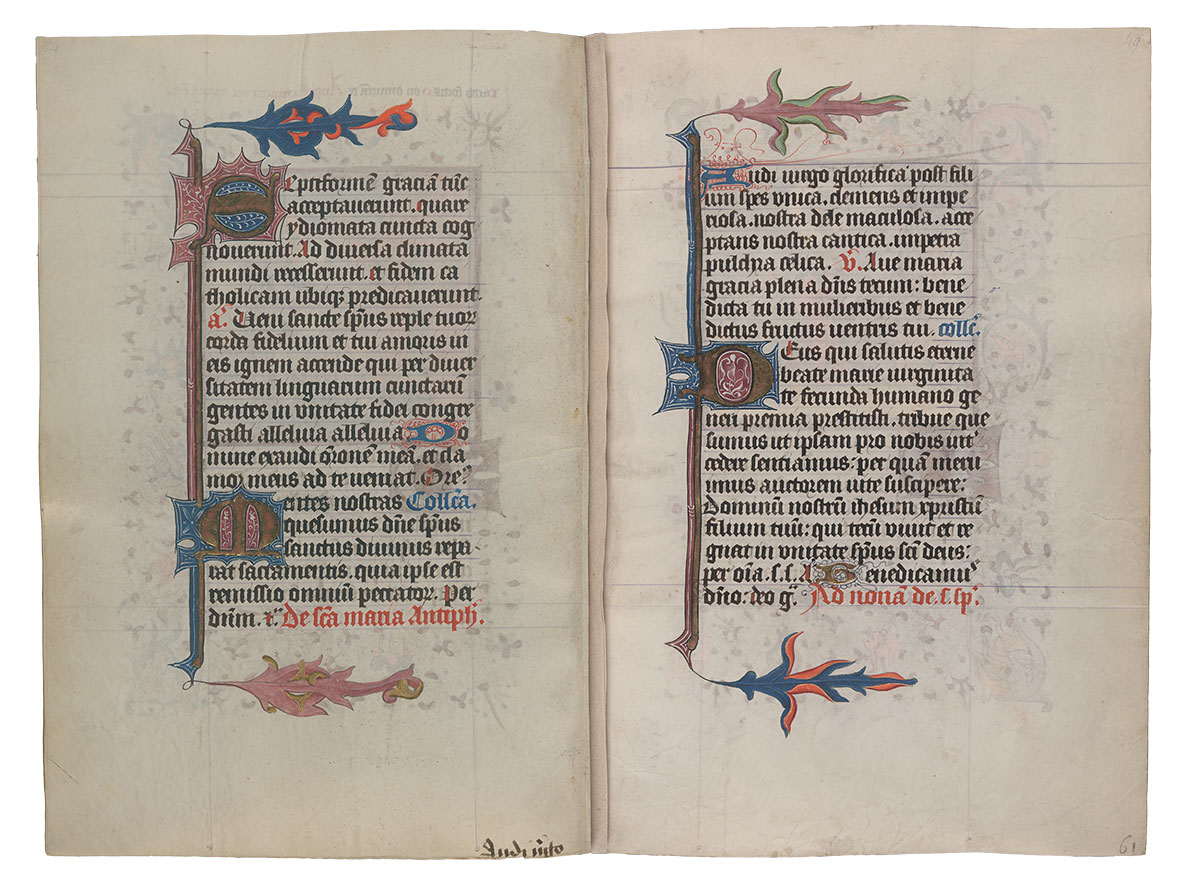
Purchased on the Belle da Costa Greene Fund with the assistance of the Fellows, 1963
Image courtesy of Faksimile Verlag Luzern
MS M.917/945, pp. 62–63

Teacher Instructing Pupils
Purchased on the Belle da Costa Greene Fund with the assistance of the Fellows, 1963
Knowledge, the fifth gift of the Holy Spirit, is represented by this delightful schoolroom scene. Inspired by the Dove, the older kneeling student reads from a book proffered by his teacher. The young man's scroll reveals his inspiration, quoting from Psalm 2, verse 12, that the key to knowledge is the learning of discipline. The seated teacher holds a bundle of switches, the instrument of reprimand and attribute for instructors in the Middle Ages.
Hours and Masses for the Seven Days of the Week
The most unusual texts in Catherine's manuscript are the series of Hours and Masses for every day of the week. Medieval Christian tradition associated certain figures or themes with different days. Thus Sunday, the day of the Resurrection, was the Lord's Day; Thursday was connected with the Eucharist since that sacrament was instituted on Holy Thursday; and Monday was the day of the dead, since their torments were suspended on Sunday but recommenced the following day. In Catherine's prayer book, the themes for the Hours and Masses of the seven days of the week are:
| Sunday | the Trinity |
| Monday | the Dead |
| Tuesday | the Holy Spirit |
| Wednesday | All Saints |
| Thursday | the Blessed Sacrament |
| Friday | the Compassion of God |
| Saturday | the Virgin. |
Image courtesy of Faksimile Verlag Luzern
MS M.917/945, pp. 64–65
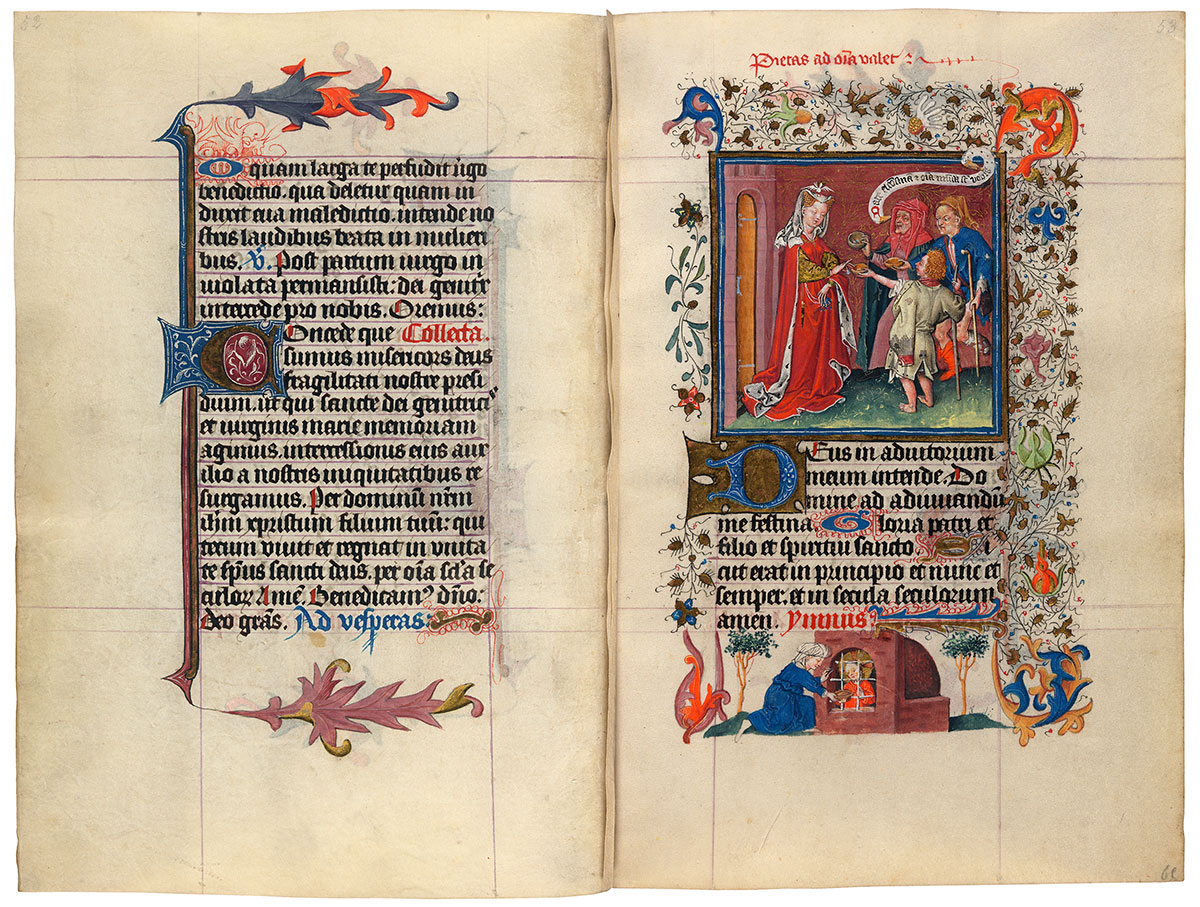
Catherine of Cleves Distributing Alms
Purchased on the Belle da Costa Greene Fund with the assistance of the Fellows, 1963
Piety is the sixth gift of the Holy Spirit. Illustrating pious charity afforded the opportunity to include a flattering portrait of Catherine as the generous giver of alms. In the miniature, the inspiring Dove of the Holy Spirit hovers directly above her head. The scroll above the beggars quotes Luke (11:41), "Give alms, and all things are clean unto you." In the bottom border, a woman tends to a prisoner. During the Middle Ages, this Corporal Act of Mercy was interpreted as charity toward Christ himself; thus the prisoner is given the Savior's cruciform halo.
Hours and Masses for the Seven Days of the Week
The most unusual texts in Catherine's manuscript are the series of Hours and Masses for every day of the week. Medieval Christian tradition associated certain figures or themes with different days. Thus Sunday, the day of the Resurrection, was the Lord's Day; Thursday was connected with the Eucharist since that sacrament was instituted on Holy Thursday; and Monday was the day of the dead, since their torments were suspended on Sunday but recommenced the following day. In Catherine's prayer book, the themes for the Hours and Masses of the seven days of the week are:
| Sunday | the Trinity |
| Monday | the Dead |
| Tuesday | the Holy Spirit |
| Wednesday | All Saints |
| Thursday | the Blessed Sacrament |
| Friday | the Compassion of God |
| Saturday | the Virgin. |
Image courtesy of Faksimile Verlag Luzern
MS M.917/945, pp. 66–67

Purchased on the Belle da Costa Greene Fund with the assistance of the Fellows, 1963
Image courtesy of Faksimile Verlag Luzern
MS M.917/945, pp. 68–69
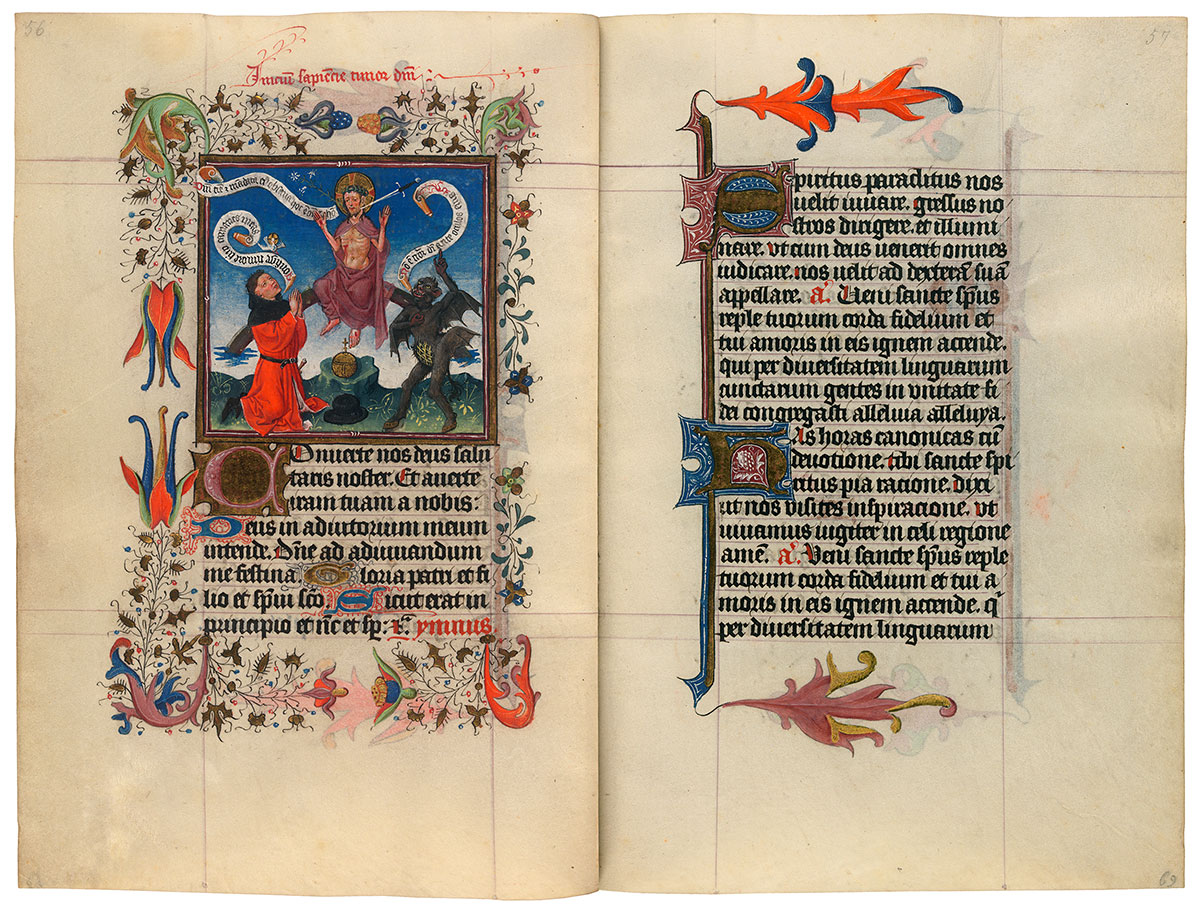
Arnold of Egmond, Catherine of Cleves’ Husband, Praying to Christ
Purchased on the Belle da Costa Greene Fund with the assistance of the Fellows, 1963
The seventh and last gift of the Holy Spirit is fear of the Lord. It is illustrated with a portrait of Catherine's husband, Arnold, praying to Christ of the Last Judgment (the sword of justice and lily of mercy spring from the Savior's mouth). Arnold invokes Psalm 118, verse 120: "Make my flesh tremble from fear of the Lord." The devil, however, countermands from Psalm 35, verse 2, arguing that "There is no fear of the Lord before God's eyes." Christ's rather neutral reply is from Ecclesiastes (12:13): "Fear God and follow his commandments; this is true for all men." These sequential portraits of Catherine and Arnold place the duchess, who commissioned the manuscript, and her husband, the duke, in starkly contrasting contexts.
Hours and Masses for the Seven Days of the Week
The most unusual texts in Catherine's manuscript are the series of Hours and Masses for every day of the week. Medieval Christian tradition associated certain figures or themes with different days. Thus Sunday, the day of the Resurrection, was the Lord's Day; Thursday was connected with the Eucharist since that sacrament was instituted on Holy Thursday; and Monday was the day of the dead, since their torments were suspended on Sunday but recommenced the following day. In Catherine's prayer book, the themes for the Hours and Masses of the seven days of the week are:
| Sunday | the Trinity |
| Monday | the Dead |
| Tuesday | the Holy Spirit |
| Wednesday | All Saints |
| Thursday | the Blessed Sacrament |
| Friday | the Compassion of God |
| Saturday | the Virgin. |
Image courtesy of Faksimile Verlag Luzern
MS M.917/945, pp. 70–71
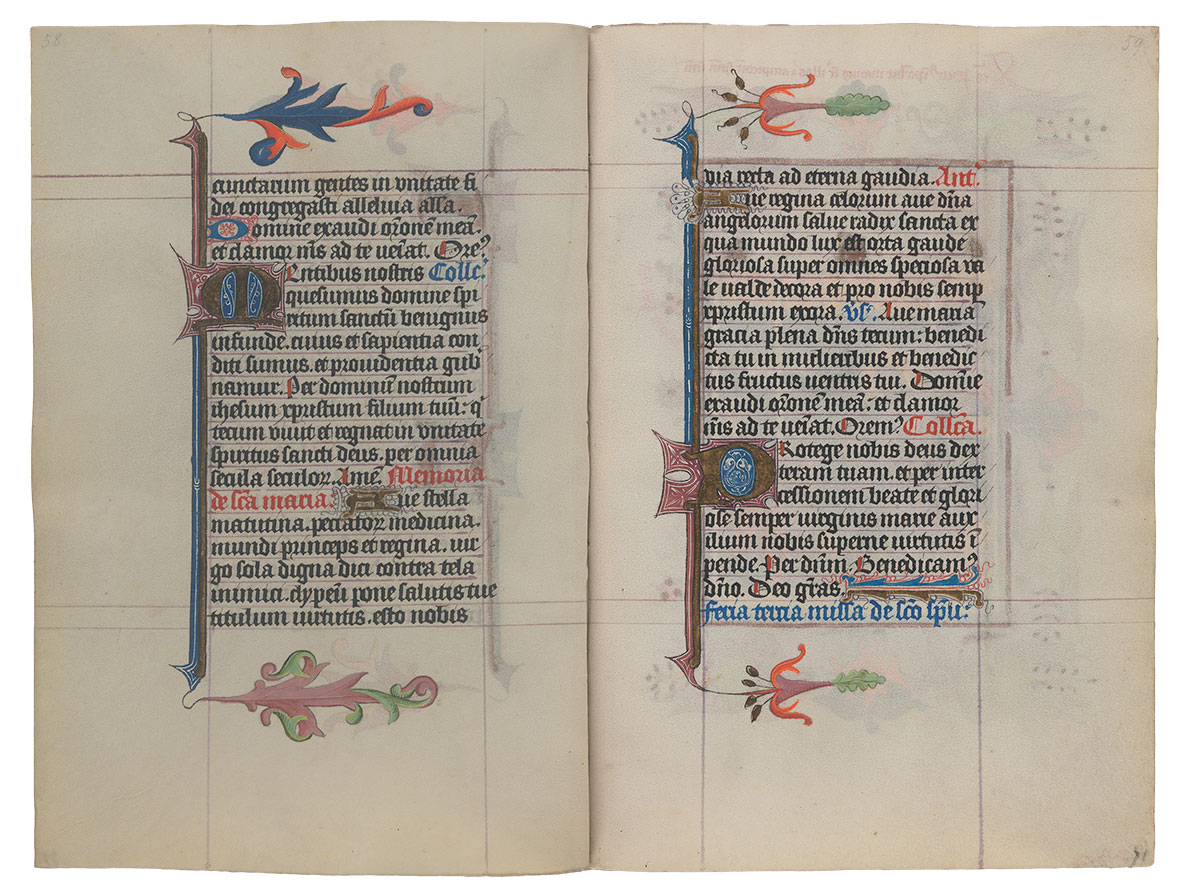
Purchased on the Belle da Costa Greene Fund with the assistance of the Fellows, 1963
Image courtesy of Faksimile Verlag Luzern
MS M.917/945, p. 72–f. 109r
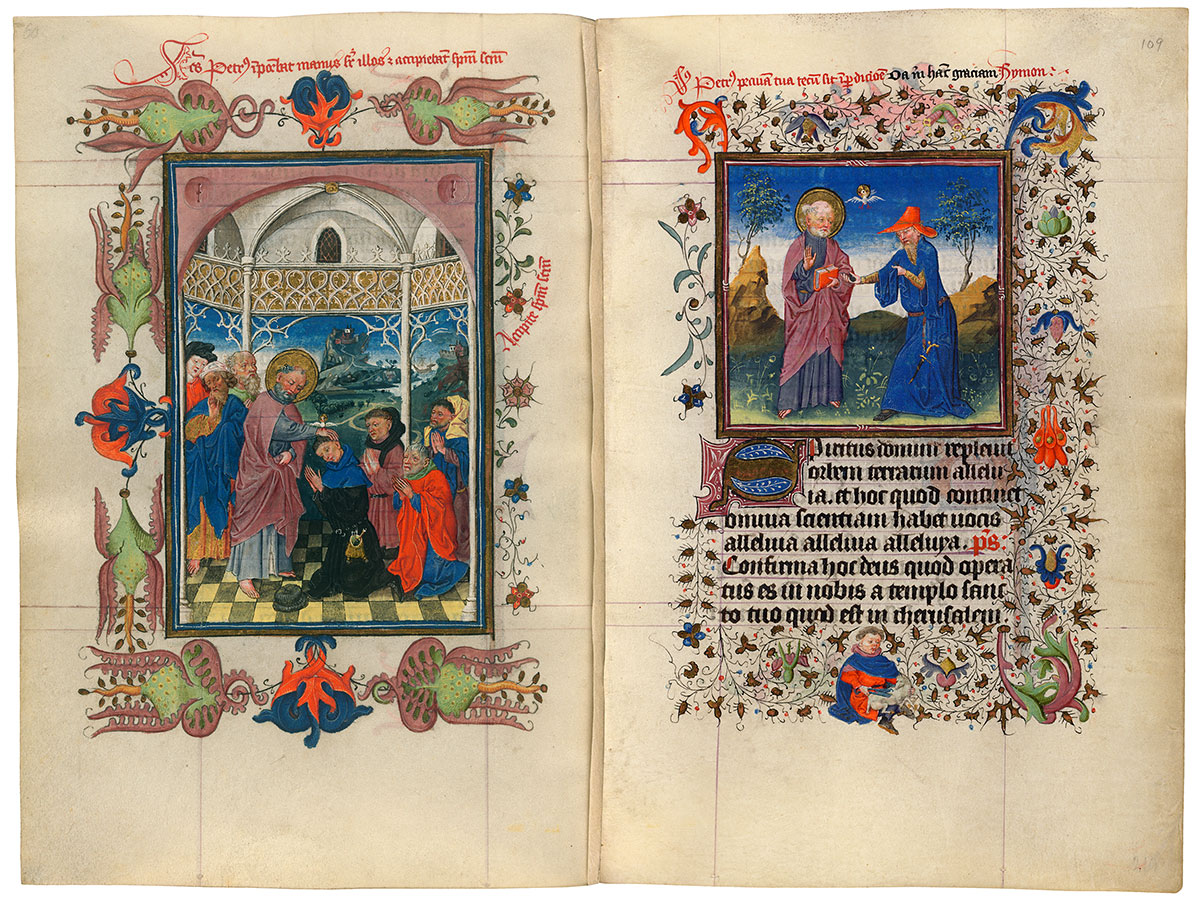
St. Peter Bestowing the Holy Spirit
Simon Magus Seeks to Buy Peter's Power
Purchased on the Belle da Costa Greene Fund with the assistance of the Fellows, 1963; purchased on the Belle da Costa Greene Fund with the assistance of the Fellows and with special assistance of Mrs. Frederick B. Adams, Sr., Mrs. Robert Charles, Mr. Laurens M. Hamilton, The Heineman Foundation, Mrs. Donald F. Hyde, Mrs. Jacob M. Kaplan, Mrs. John Kean, Mr. Paul Mellon, Mr. and Mrs. Charles F. Morgan, Mr. Lessing J. Rosenwald, Mr. and Mrs. August H. Schilling, Mrs. Herbert N. Straus, Mrs. Landon K. Thorne, Mrs. Alan Valentine, Mr. and Mrs. Arnold Whitridge, and Miss Julia P. Wightman, 1970
This small miniature illustrating the Mass of the Holy Spirit depicts the magician Simon's attempt to buy from St. Peter his power (he had seen the apostle bestowing the Holy Spirit upon people). The rare scene is explicated by texts (derived from Acts 8:19–20) in the top margin. Simon, shoving a moneybag toward the saint, demands, "Give me this grace," to which Peter calmly responds, "You and your money will perish." How the boy shearing a sheep in the bottom border might relate to this scene is a mystery.
Hours and Masses for the Seven Days of the Week
The most unusual texts in Catherine's manuscript are the series of Hours and Masses for every day of the week. Medieval Christian tradition associated certain figures or themes with different days. Thus Sunday, the day of the Resurrection, was the Lord's Day; Thursday was connected with the Eucharist since that sacrament was instituted on Holy Thursday; and Monday was the day of the dead, since their torments were suspended on Sunday but recommenced the following day. In Catherine's prayer book, the themes for the Hours and Masses of the seven days of the week are:
| Sunday | the Trinity |
| Monday | the Dead |
| Tuesday | the Holy Spirit |
| Wednesday | All Saints |
| Thursday | the Blessed Sacrament |
| Friday | the Compassion of God |
| Saturday | the Virgin. |
Image courtesy of Faksimile Verlag Luzern
MS M.917/945, ff. 109v–110r
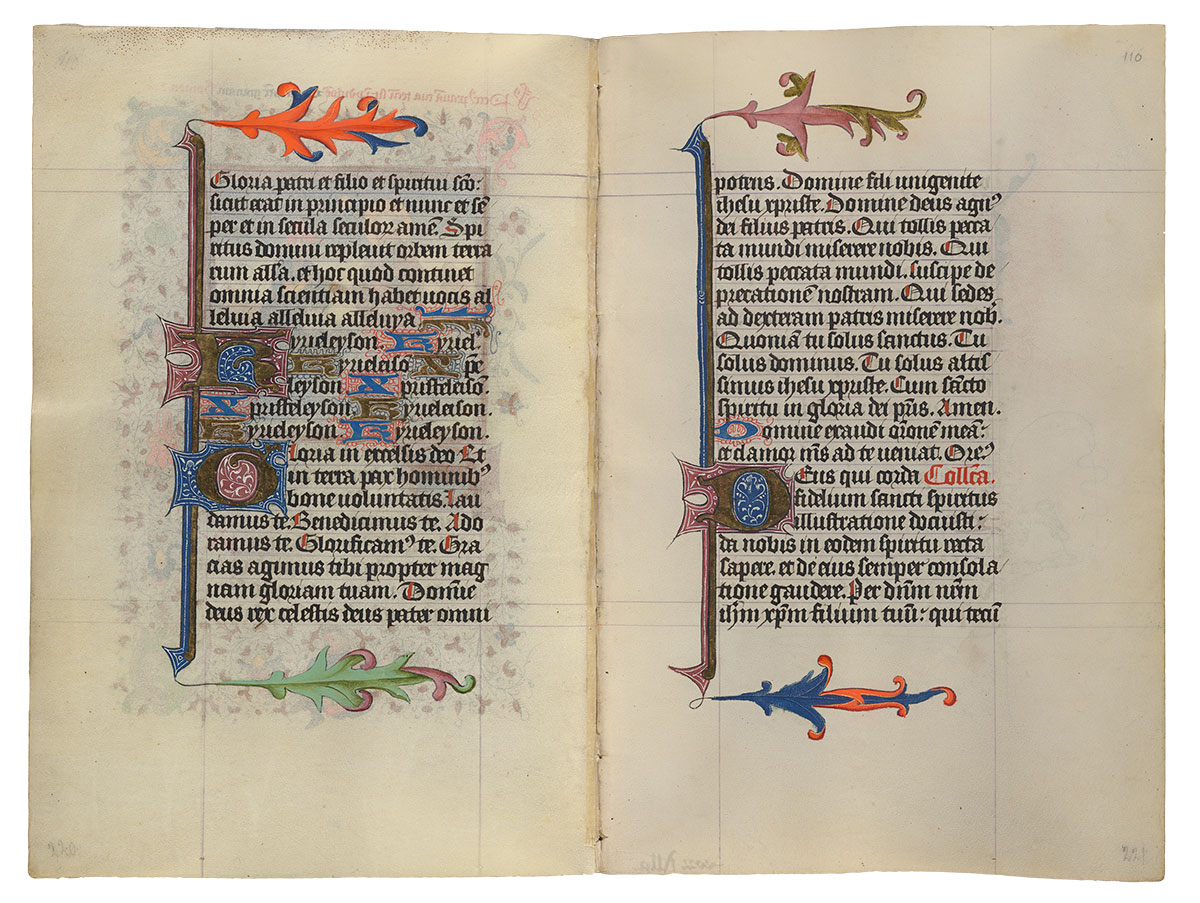
Purchased on the Belle da Costa Greene Fund with the assistance of the Fellows, 1963; purchased on the Belle da Costa Greene Fund with the assistance of the Fellows and with special assistance of Mrs. Frederick B. Adams, Sr., Mrs. Robert Charles, Mr. Laurens M. Hamilton, The Heineman Foundation, Mrs. Donald F. Hyde, Mrs. Jacob M. Kaplan, Mrs. John Kean, Mr. Paul Mellon, Mr. and Mrs. Charles F. Morgan, Mr. Lessing J. Rosenwald, Mr. and Mrs. August H. Schilling, Mrs. Herbert N. Straus, Mrs. Landon K. Thorne, Mrs. Alan Valentine, Mr. and Mrs. Arnold Whitridge, and Miss Julia P. Wightman, 1970
Image courtesy of Faksimile Verlag Luzern
MS M.917/945, ff. 110v–111r
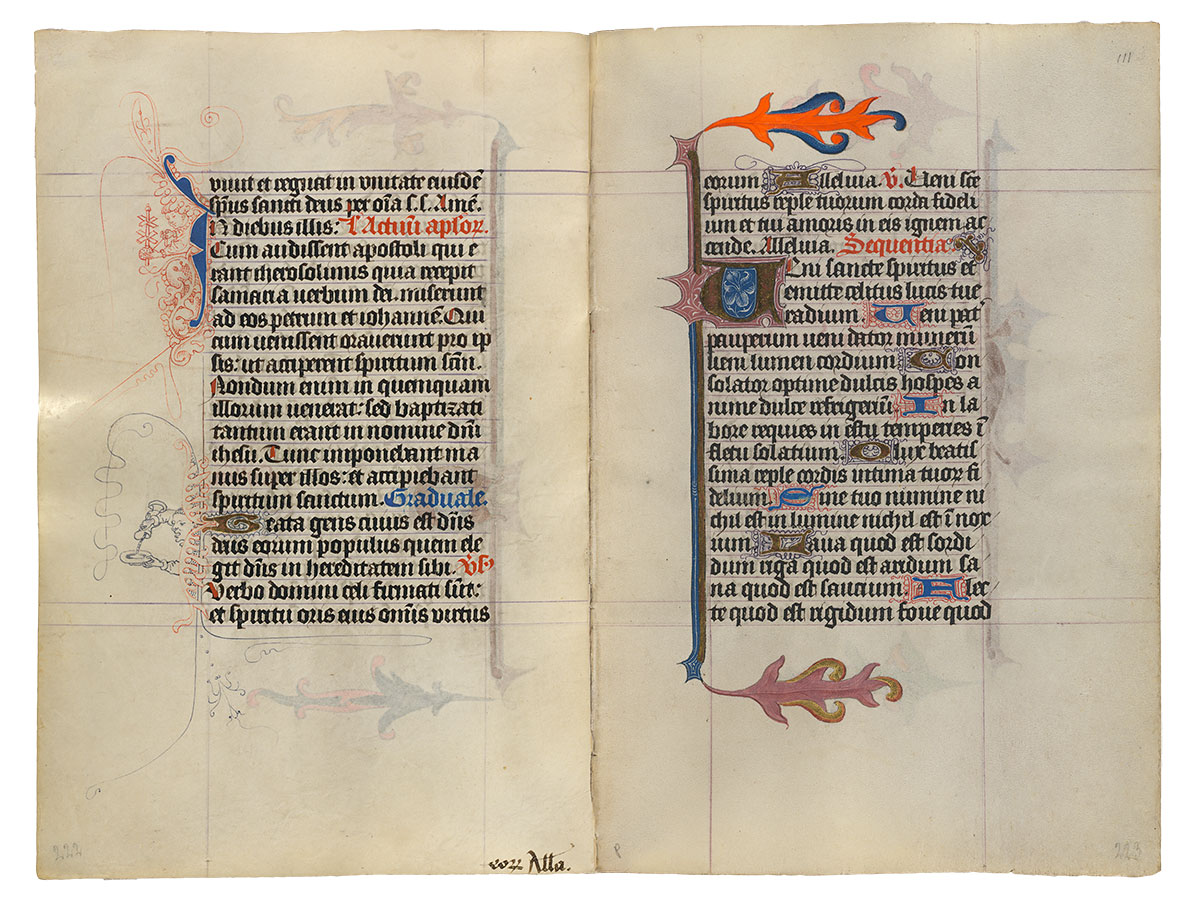
Purchased on the Belle da Costa Greene Fund with the assistance of the Fellows, 1963; purchased on the Belle da Costa Greene Fund with the assistance of the Fellows and with special assistance of Mrs. Frederick B. Adams, Sr., Mrs. Robert Charles, Mr. Laurens M. Hamilton, The Heineman Foundation, Mrs. Donald F. Hyde, Mrs. Jacob M. Kaplan, Mrs. John Kean, Mr. Paul Mellon, Mr. and Mrs. Charles F. Morgan, Mr. Lessing J. Rosenwald, Mr. and Mrs. August H. Schilling, Mrs. Herbert N. Straus, Mrs. Landon K. Thorne, Mrs. Alan Valentine, Mr. and Mrs. Arnold Whitridge, and Miss Julia P. Wightman, 1970
Image courtesy of Faksimile Verlag Luzern
MS M.917/945, ff. 111v–112r

Purchased on the Belle da Costa Greene Fund with the assistance of the Fellows, 1963; purchased on the Belle da Costa Greene Fund with the assistance of the Fellows and with special assistance of Mrs. Frederick B. Adams, Sr., Mrs. Robert Charles, Mr. Laurens M. Hamilton, The Heineman Foundation, Mrs. Donald F. Hyde, Mrs. Jacob M. Kaplan, Mrs. John Kean, Mr. Paul Mellon, Mr. and Mrs. Charles F. Morgan, Mr. Lessing J. Rosenwald, Mr. and Mrs. August H. Schilling, Mrs. Herbert N. Straus, Mrs. Landon K. Thorne, Mrs. Alan Valentine, Mr. and Mrs. Arnold Whitridge, and Miss Julia P. Wightman, 1970
Image courtesy of Faksimile Verlag Luzern
MS M.917/945, ff. 112v–113r
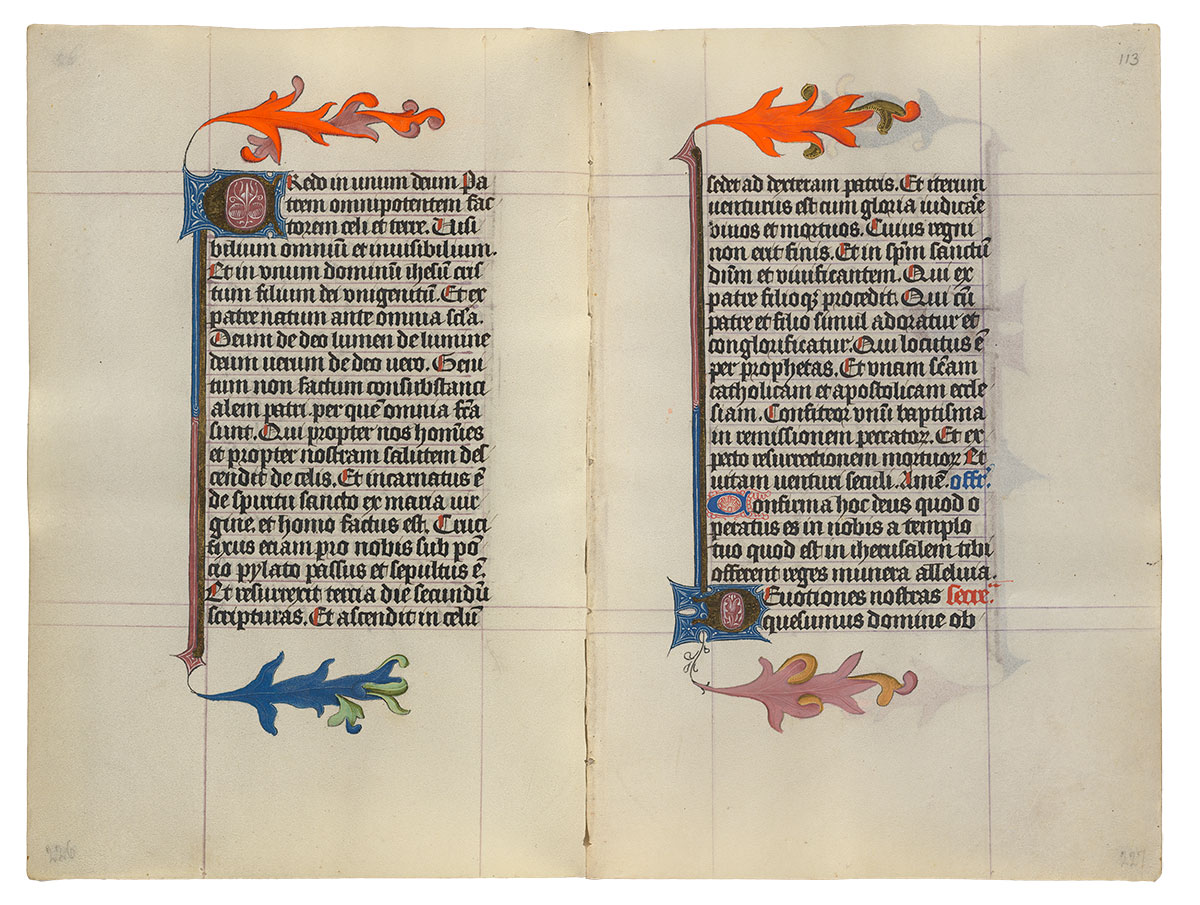
Purchased on the Belle da Costa Greene Fund with the assistance of the Fellows, 1963; purchased on the Belle da Costa Greene Fund with the assistance of the Fellows and with special assistance of Mrs. Frederick B. Adams, Sr., Mrs. Robert Charles, Mr. Laurens M. Hamilton, The Heineman Foundation, Mrs. Donald F. Hyde, Mrs. Jacob M. Kaplan, Mrs. John Kean, Mr. Paul Mellon, Mr. and Mrs. Charles F. Morgan, Mr. Lessing J. Rosenwald, Mr. and Mrs. August H. Schilling, Mrs. Herbert N. Straus, Mrs. Landon K. Thorne, Mrs. Alan Valentine, Mr. and Mrs. Arnold Whitridge, and Miss Julia P. Wightman, 1970
Image courtesy of Faksimile Verlag Luzern
MS M.917/945, ff. 113v–114r
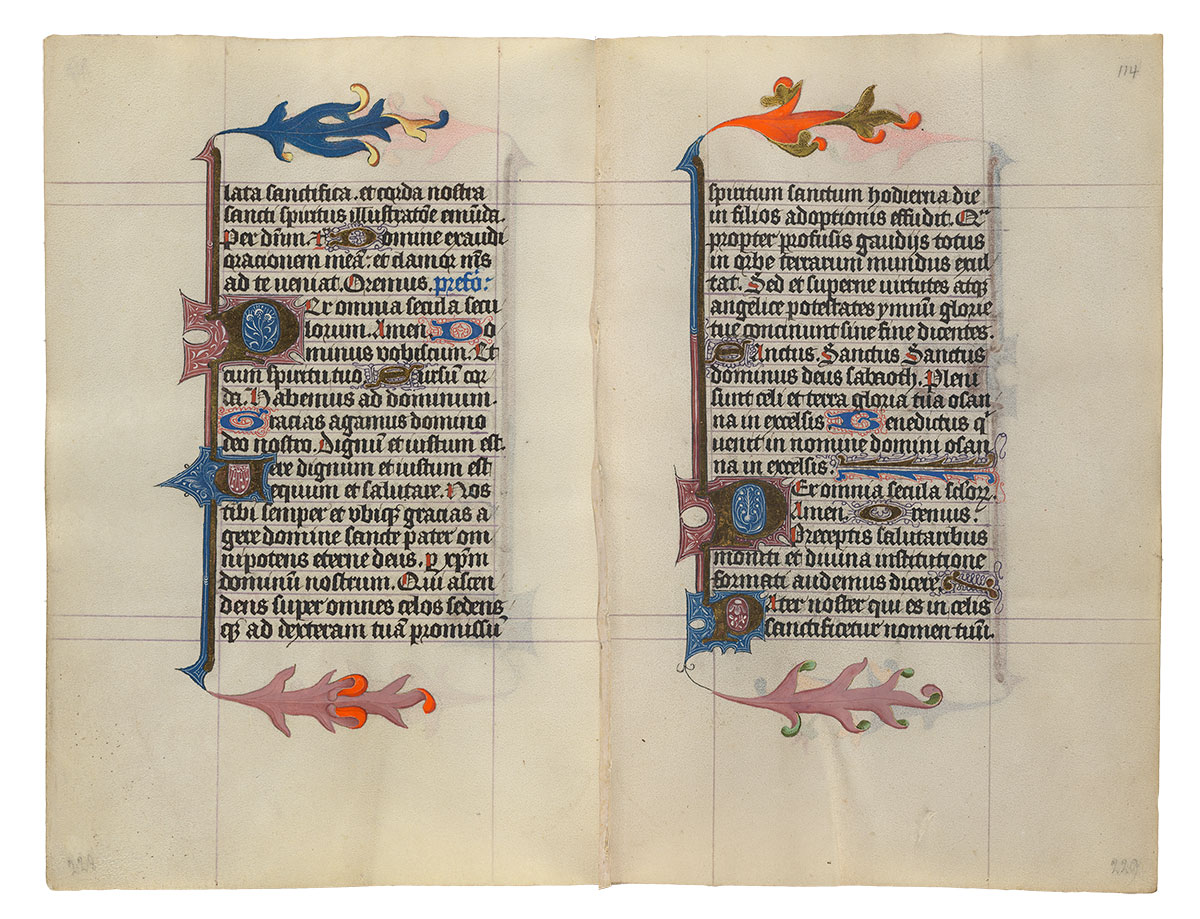
Purchased on the Belle da Costa Greene Fund with the assistance of the Fellows, 1963; purchased on the Belle da Costa Greene Fund with the assistance of the Fellows and with special assistance of Mrs. Frederick B. Adams, Sr., Mrs. Robert Charles, Mr. Laurens M. Hamilton, The Heineman Foundation, Mrs. Donald F. Hyde, Mrs. Jacob M. Kaplan, Mrs. John Kean, Mr. Paul Mellon, Mr. and Mrs. Charles F. Morgan, Mr. Lessing J. Rosenwald, Mr. and Mrs. August H. Schilling, Mrs. Herbert N. Straus, Mrs. Landon K. Thorne, Mrs. Alan Valentine, Mr. and Mrs. Arnold Whitridge, and Miss Julia P. Wightman, 1970
Image courtesy of Faksimile Verlag Luzern
MS M.917/945, ff. 114v–115r
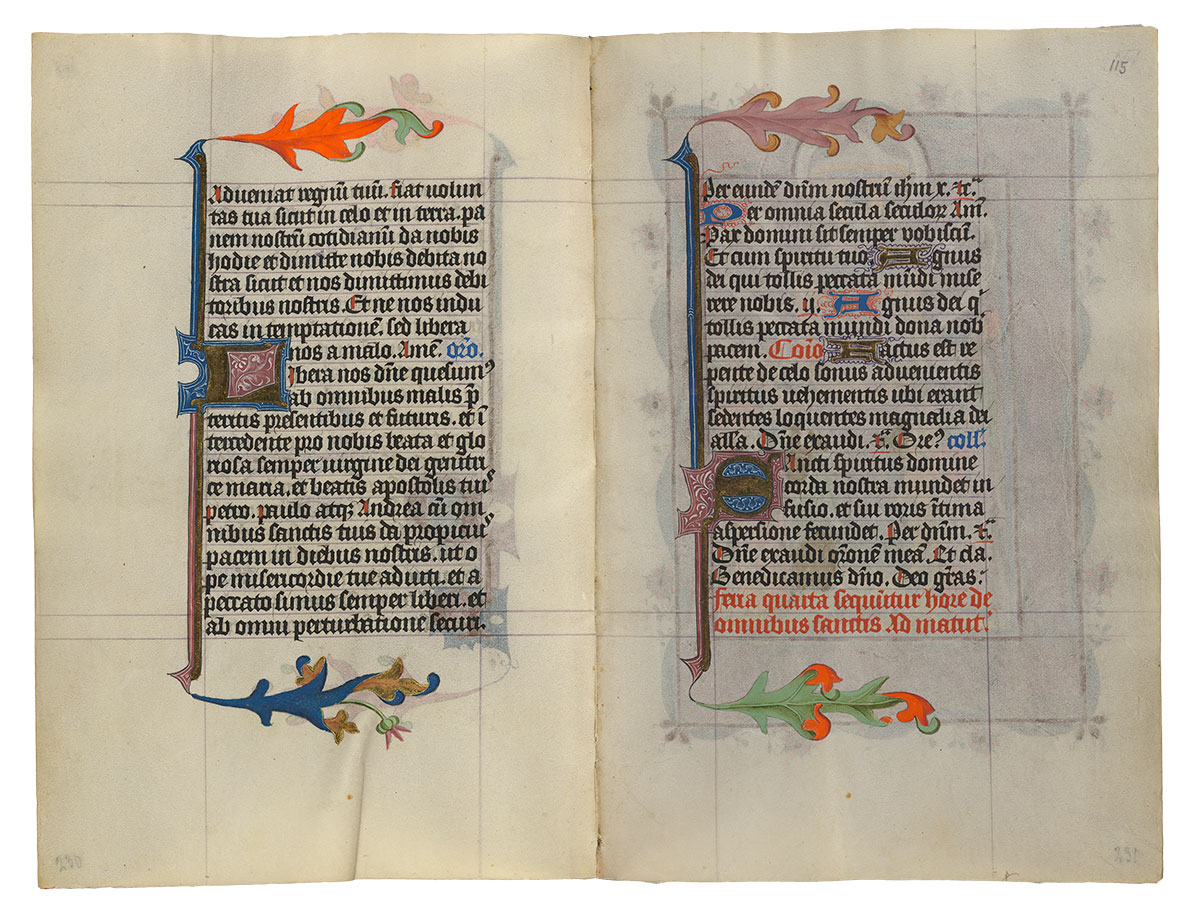
Purchased on the Belle da Costa Greene Fund with the assistance of the Fellows, 1963; purchased on the Belle da Costa Greene Fund with the assistance of the Fellows and with special assistance of Mrs. Frederick B. Adams, Sr., Mrs. Robert Charles, Mr. Laurens M. Hamilton, The Heineman Foundation, Mrs. Donald F. Hyde, Mrs. Jacob M. Kaplan, Mrs. John Kean, Mr. Paul Mellon, Mr. and Mrs. Charles F. Morgan, Mr. Lessing J. Rosenwald, Mr. and Mrs. August H. Schilling, Mrs. Herbert N. Straus, Mrs. Landon K. Thorne, Mrs. Alan Valentine, Mr. and Mrs. Arnold Whitridge, and Miss Julia P. Wightman, 1970
Image courtesy of Faksimile Verlag Luzern
MS M.917/945, f. 115v–p.39
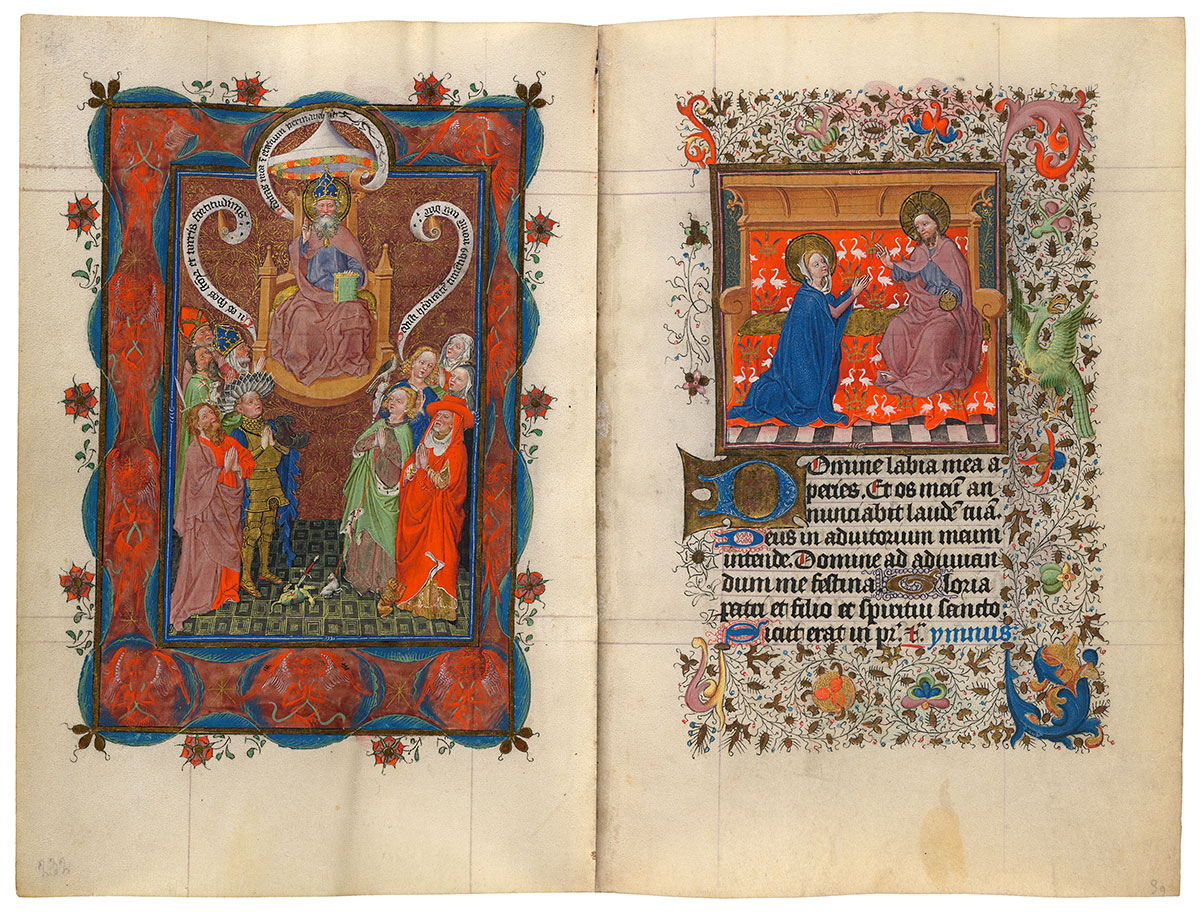
All Saints before the Throne of God
Christ Receiving the Virgin into Heaven
Purchased on the Belle da Costa Greene Fund with the assistance of the Fellows and with special assistance of Mrs. Frederick B. Adams, Sr., Mrs. Robert Charles, Mr. Laurens M. Hamilton, The Heineman Foundation, Mrs. Donald F. Hyde, Mrs. Jacob M. Kaplan, Mrs. John Kean, Mr. Paul Mellon, Mr. and Mrs. Charles F. Morgan, Mr. Lessing J. Rosenwald, Mr. and Mrs. August H. Schilling, Mrs. Herbert N. Straus, Mrs. Landon K. Thorne, Mrs. Alan Valentine, Mr. and Mrs. Arnold Whitridge, and Miss Julia P. Wightman, 1970; purchased on the Belle da Costa Greene Fund with the assistance of the Fellows, 1963
The Wednesday Hours of All Saints commences with this impressive miniature. An enthroned God floats above two groups of saints. On the left, they are headed by George, with a tiny dead dragon at his feet, and the apostle Thomas, holding a spear. On the right are Agnes, with a small lamb at her feet, and Jerome, dressed as a cardinal and with his attribute, a lion. The scene is framed by nine fiery angels. The scrolls speak of God's legacy to and support of his saints.
Hours and Masses for the Seven Days of the Week
The most unusual texts in Catherine's manuscript are the series of Hours and Masses for every day of the week. Medieval Christian tradition associated certain figures or themes with different days. Thus Sunday, the day of the Resurrection, was the Lord's Day; Thursday was connected with the Eucharist since that sacrament was instituted on Holy Thursday; and Monday was the day of the dead, since their torments were suspended on Sunday but recommenced the following day. In Catherine's prayer book, the themes for the Hours and Masses of the seven days of the week are:
| Sunday | the Trinity |
| Monday | the Dead |
| Tuesday | the Holy Spirit |
| Wednesday | All Saints |
| Thursday | the Blessed Sacrament |
| Friday | the Compassion of God |
| Saturday | the Virgin. |
Image courtesy of Faksimile Verlag Luzern
MS M.917/945, pp. 40–41
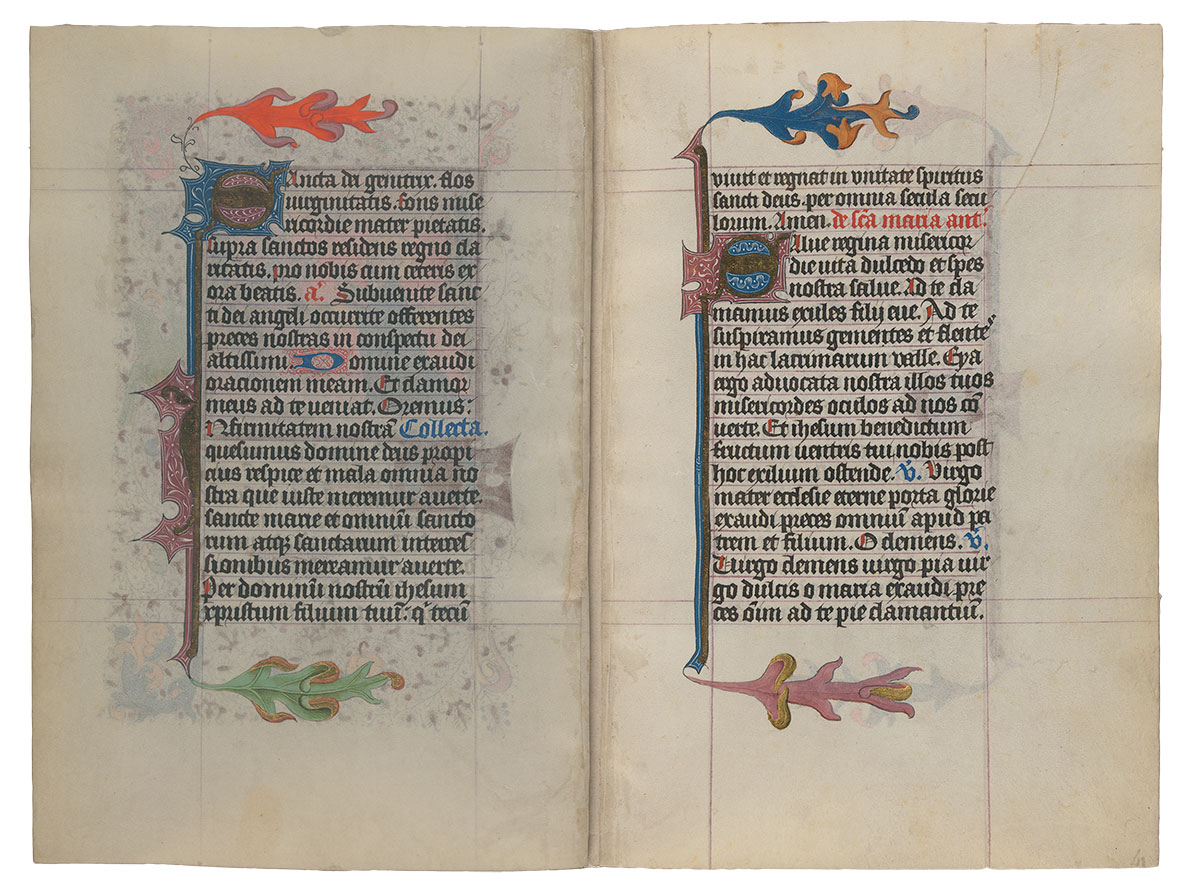
Purchased on the Belle da Costa Greene Fund with the assistance of the Fellows, 1963
Image courtesy of Faksimile Verlag Luzern
MS M.917/945, p. 42–f. 116r

Angels before the Throne of God
Purchased on the Belle da Costa Greene Fund with the assistance of the Fellows, 1963; purchased on the Belle da Costa Greene Fund with the assistance of the Fellows and with special assistance of Mrs. Frederick B. Adams, Sr., Mrs. Robert Charles, Mr. Laurens M. Hamilton, The Heineman Foundation, Mrs. Donald F. Hyde, Mrs. Jacob M. Kaplan, Mrs. John Kean, Mr. Paul Mellon, Mr. and Mrs. Charles F. Morgan, Mr. Lessing J. Rosenwald, Mr. and Mrs. August H. Schilling, Mrs. Herbert N. Straus, Mrs. Landon K. Thorne, Mrs. Alan Valentine, Mr. and Mrs. Arnold Whitridge, and Miss Julia P. Wightman, 1970
Hours and Masses for the Seven Days of the Week
The most unusual texts in Catherine's manuscript are the series of Hours and Masses for every day of the week. Medieval Christian tradition associated certain figures or themes with different days. Thus Sunday, the day of the Resurrection, was the Lord's Day; Thursday was connected with the Eucharist since that sacrament was instituted on Holy Thursday; and Monday was the day of the dead, since their torments were suspended on Sunday but recommenced the following day. In Catherine's prayer book, the themes for the Hours and Masses of the seven days of the week are:
| Sunday | the Trinity |
| Monday | the Dead |
| Tuesday | the Holy Spirit |
| Wednesday | All Saints |
| Thursday | the Blessed Sacrament |
| Friday | the Compassion of God |
| Saturday | the Virgin. |
Image courtesy of Faksimile Verlag Luzern
MS M.917/945, ff. 116v–117r
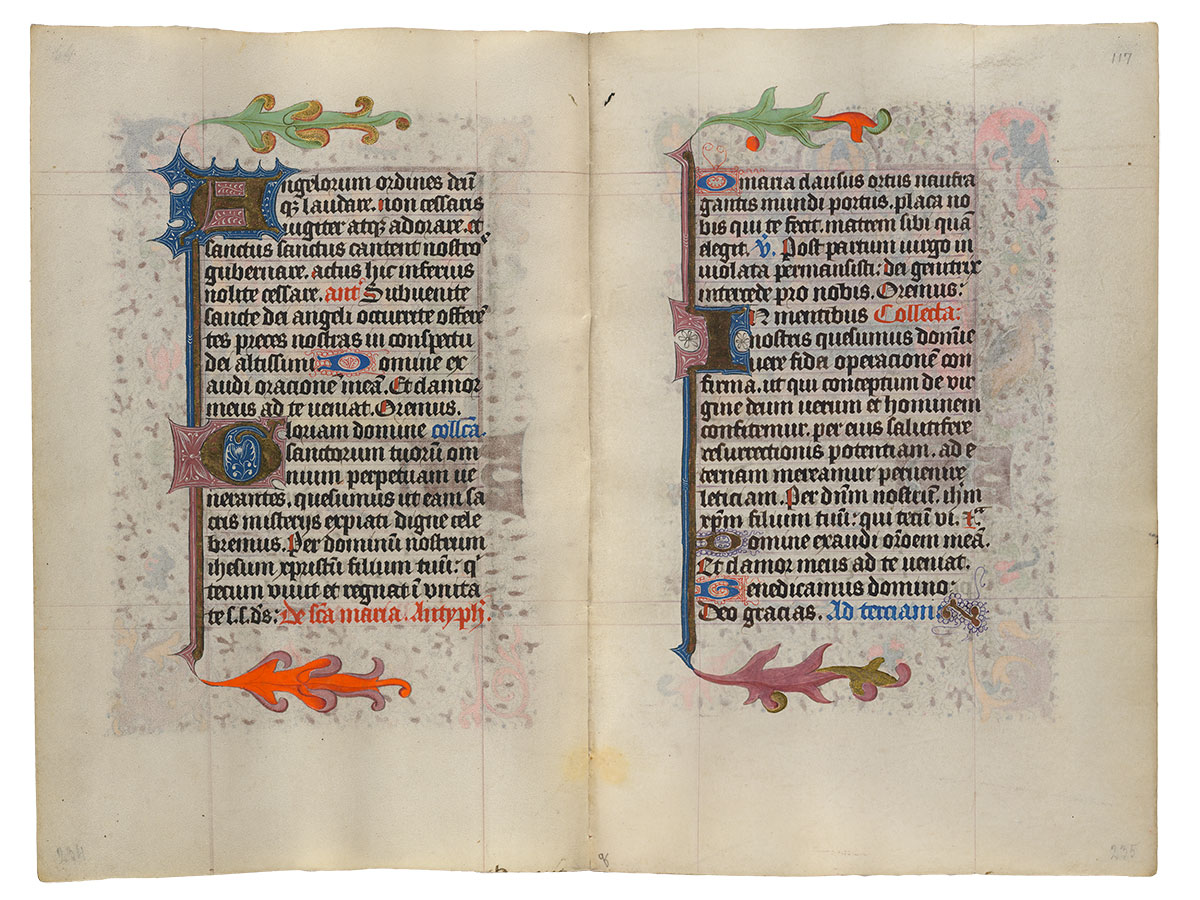
Purchased on the Belle da Costa Greene Fund with the assistance of the Fellows, 1963; purchased on the Belle da Costa Greene Fund with the assistance of the Fellows and with special assistance of Mrs. Frederick B. Adams, Sr., Mrs. Robert Charles, Mr. Laurens M. Hamilton, The Heineman Foundation, Mrs. Donald F. Hyde, Mrs. Jacob M. Kaplan, Mrs. John Kean, Mr. Paul Mellon, Mr. and Mrs. Charles F. Morgan, Mr. Lessing J. Rosenwald, Mr. and Mrs. August H. Schilling, Mrs. Herbert N. Straus, Mrs. Landon K. Thorne, Mrs. Alan Valentine, Mr. and Mrs. Arnold Whitridge, and Miss Julia P. Wightman, 1970
Image courtesy of Faksimile Verlag Luzern
MS M.917/945, ff. 117v–118r

Apostles and Prophets before the Throne of God
Purchased on the Belle da Costa Greene Fund with the assistance of the Fellows and with special assistance of Mrs. Frederick B. Adams, Sr., Mrs. Robert Charles, Mr. Laurens M. Hamilton, The Heineman Foundation, Mrs. Donald F. Hyde, Mrs. Jacob M. Kaplan, Mrs. John Kean, Mr. Paul Mellon, Mr. and Mrs. Charles F. Morgan, Mr. Lessing J. Rosenwald, Mr. and Mrs. August H. Schilling, Mrs. Herbert N. Straus, Mrs. Landon K. Thorne, Mrs. Alan Valentine, Mr. and Mrs. Arnold Whitridge, and Miss Julia P. Wightman, 1970
The small miniatures for the Hours of All Saints group the elect according to Church hierarchy. This image for Terce includes the apostles on the left—barefooted, bareheaded, and simply dressed. On the right are the prophets—shod and somewhat exotically garbed. Identifying each group are scrolls with texts from the Te Deum, the hymn of praise that the angels sing in the Lauds miniature from the Hours of the Virgin. God's scroll proclaims, "I am the alpha and omega, God and man."
Hours and Masses for the Seven Days of the Week
The most unusual texts in Catherine's manuscript are the series of Hours and Masses for every day of the week. Medieval Christian tradition associated certain figures or themes with different days. Thus Sunday, the day of the Resurrection, was the Lord's Day; Thursday was connected with the Eucharist since that sacrament was instituted on Holy Thursday; and Monday was the day of the dead, since their torments were suspended on Sunday but recommenced the following day. In Catherine's prayer book, the themes for the Hours and Masses of the seven days of the week are:
| Sunday | the Trinity |
| Monday | the Dead |
| Tuesday | the Holy Spirit |
| Wednesday | All Saints |
| Thursday | the Blessed Sacrament |
| Friday | the Compassion of God |
| Saturday | the Virgin. |
Image courtesy of Faksimile Verlag Luzern
MS M.917/945, ff. 118v–119r
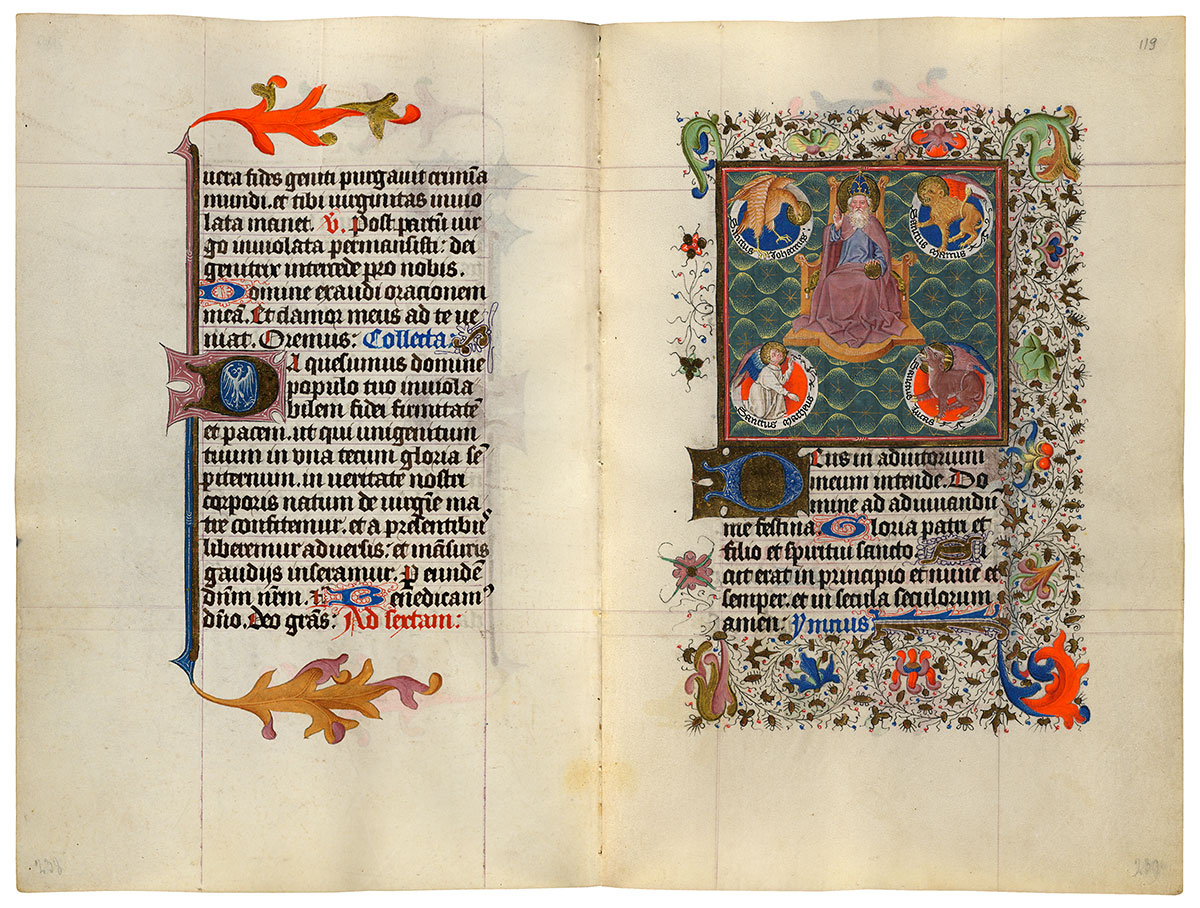
God Surrounded by the Symbols of the Evangelists
Purchased on the Belle da Costa Greene Fund with the assistance of the Fellows and with special assistance of Mrs. Frederick B. Adams, Sr., Mrs. Robert Charles, Mr. Laurens M. Hamilton, The Heineman Foundation, Mrs. Donald F. Hyde, Mrs. Jacob M. Kaplan, Mrs. John Kean, Mr. Paul Mellon, Mr. and Mrs. Charles F. Morgan, Mr. Lessing J. Rosenwald, Mr. and Mrs. August H. Schilling, Mrs. Herbert N. Straus, Mrs. Landon K. Thorne, Mrs. Alan Valentine, Mr. and Mrs. Arnold Whitridge, and Miss Julia P. Wightman, 1970
The hymn in Sext of the Hours of All Saints quotes the evangelists, who mystically recognized God. Hence the miniature shows an enthroned God surrounded by the symbols of the four evangelists—their mystical representation. Clockwise from the upper left are the eagle of John, the lion of Mark, the ox of Luke, and the angel of Matthew. The scrolls give the saints' names.
Hours and Masses for the Seven Days of the Week
The most unusual texts in Catherine's manuscript are the series of Hours and Masses for every day of the week. Medieval Christian tradition associated certain figures or themes with different days. Thus Sunday, the day of the Resurrection, was the Lord's Day; Thursday was connected with the Eucharist since that sacrament was instituted on Holy Thursday; and Monday was the day of the dead, since their torments were suspended on Sunday but recommenced the following day. In Catherine's prayer book, the themes for the Hours and Masses of the seven days of the week are:
| Sunday | the Trinity |
| Monday | the Dead |
| Tuesday | the Holy Spirit |
| Wednesday | All Saints |
| Thursday | the Blessed Sacrament |
| Friday | the Compassion of God |
| Saturday | the Virgin. |
Image courtesy of Faksimile Verlag Luzern
MS M.917/945, ff. 119v–120r
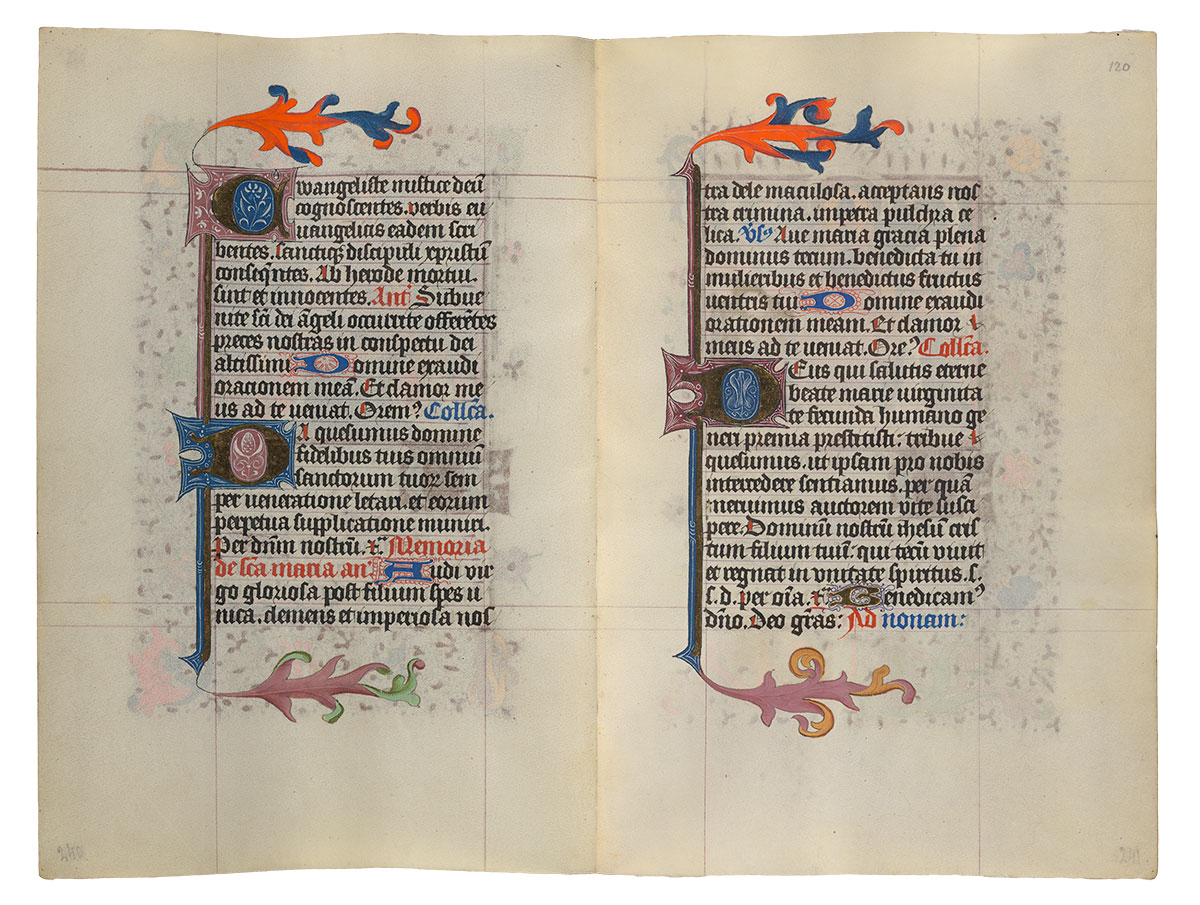
Purchased on the Belle da Costa Greene Fund with the assistance of the Fellows, 1963; purchased on the Belle da Costa Greene Fund with the assistance of the Fellows and with special assistance of Mrs. Frederick B. Adams, Sr., Mrs. Robert Charles, Mr. Laurens M. Hamilton, The Heineman Foundation, Mrs. Donald F. Hyde, Mrs. Jacob M. Kaplan, Mrs. John Kean, Mr. Paul Mellon, Mr. and Mrs. Charles F. Morgan, Mr. Lessing J. Rosenwald, Mr. and Mrs. August H. Schilling, Mrs. Herbert N. Straus, Mrs. Landon K. Thorne, Mrs. Alan Valentine, Mr. and Mrs. Arnold Whitridge, and Miss Julia P. Wightman, 1970
Image courtesy of Faksimile Verlag Luzern
MS M.917/945, ff. 120v–121r
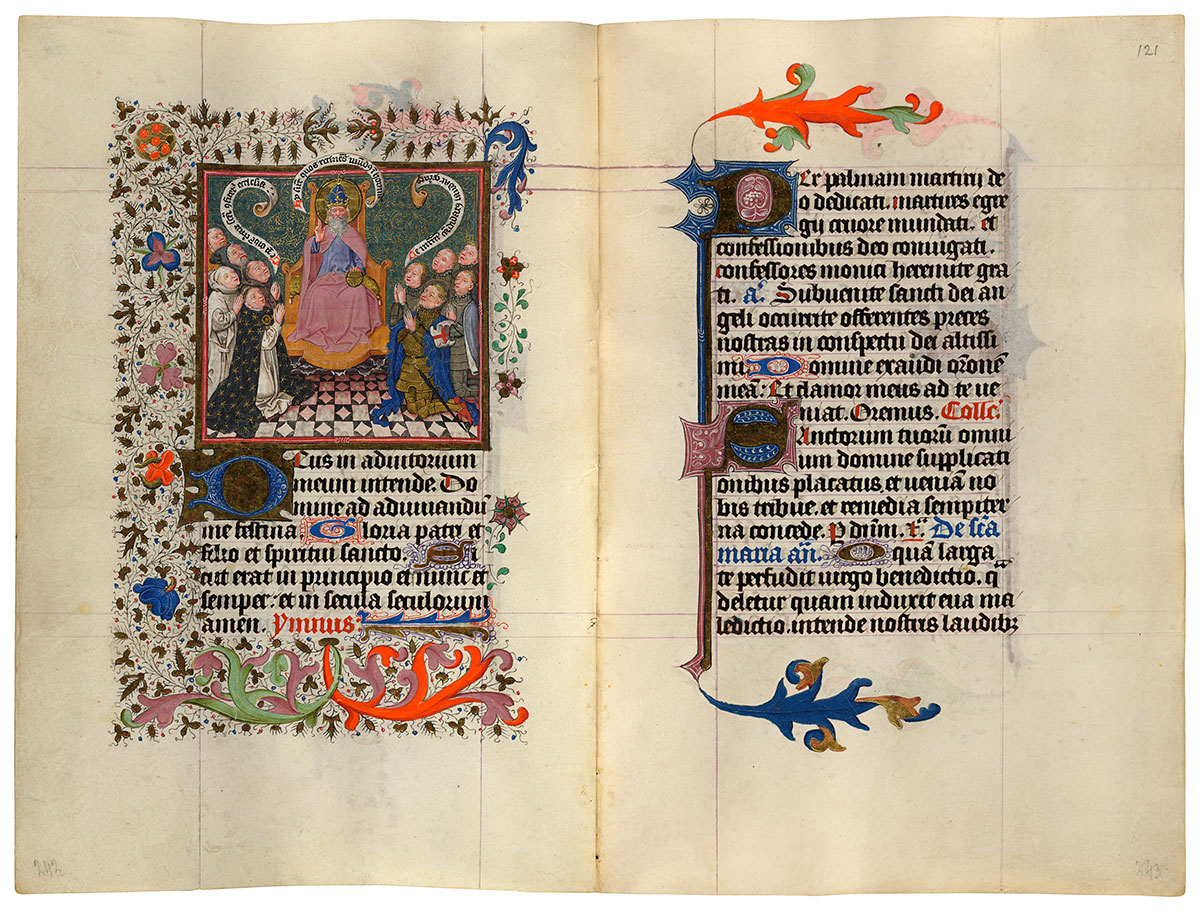
Ecclesiastic and Military Saints before the Throne of God
Purchased on the Belle da Costa Greene Fund with the assistance of the Fellows and with special assistance of Mrs. Frederick B. Adams, Sr., Mrs. Robert Charles, Mr. Laurens M. Hamilton, The Heineman Foundation, Mrs. Donald F. Hyde, Mrs. Jacob M. Kaplan, Mrs. John Kean, Mr. Paul Mellon, Mr. and Mrs. Charles F. Morgan, Mr. Lessing J. Rosenwald, Mr. and Mrs. August H. Schilling, Mrs. Herbert N. Straus, Mrs. Landon K. Thorne, Mrs. Alan Valentine, Mr. and Mrs. Arnold Whitridge, and Miss Julia P. Wightman, 1970
Hours and Masses for the Seven Days of the Week
The most unusual texts in Catherine's manuscript are the series of Hours and Masses for every day of the week. Medieval Christian tradition associated certain figures or themes with different days. Thus Sunday, the day of the Resurrection, was the Lord's Day; Thursday was connected with the Eucharist since that sacrament was instituted on Holy Thursday; and Monday was the day of the dead, since their torments were suspended on Sunday but recommenced the following day. In Catherine's prayer book, the themes for the Hours and Masses of the seven days of the week are:
| Sunday | the Trinity |
| Monday | the Dead |
| Tuesday | the Holy Spirit |
| Wednesday | All Saints |
| Thursday | the Blessed Sacrament |
| Friday | the Compassion of God |
| Saturday | the Virgin. |
Image courtesy of Faksimile Verlag Luzern
MS M.917/945, ff. 121v–122r
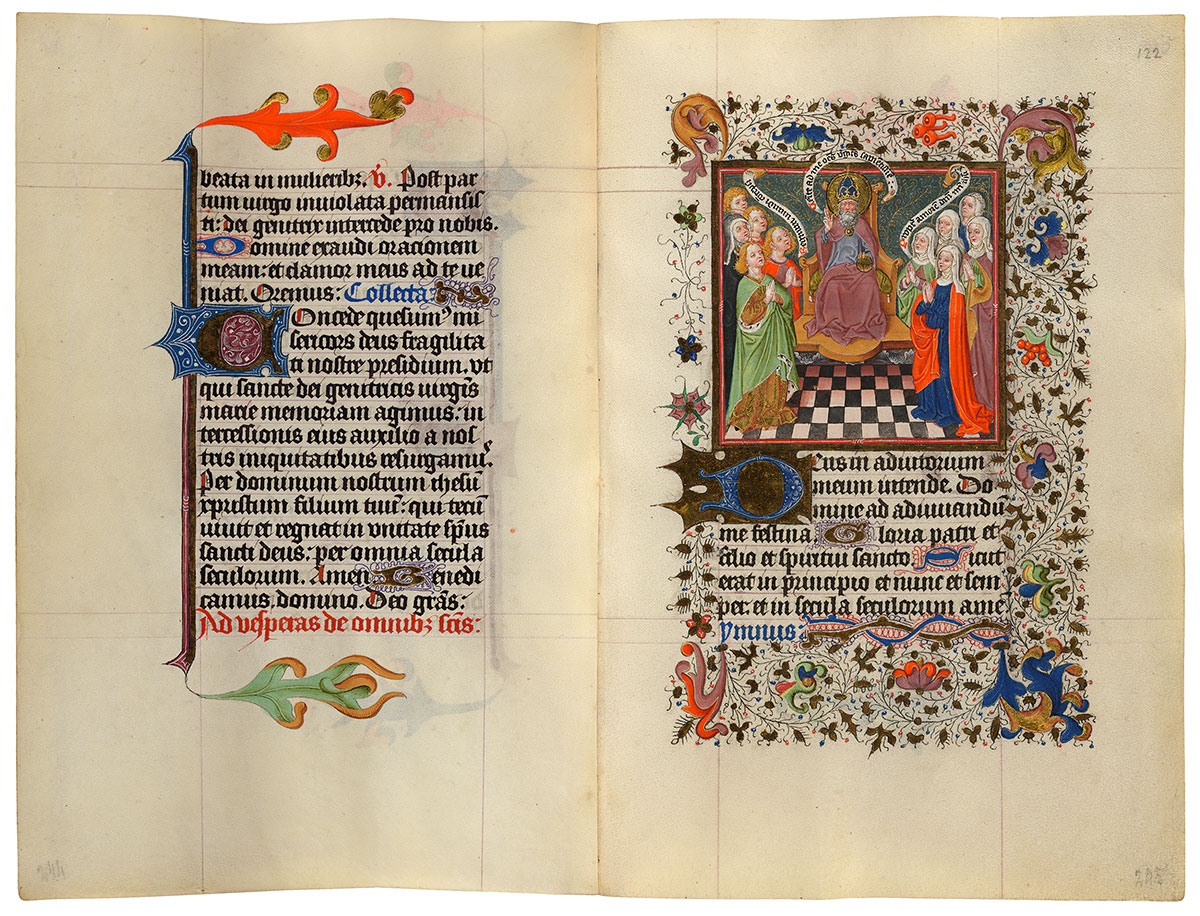
Virgins before the Throne of God
Purchased on the Belle da Costa Greene Fund with the assistance of the Fellows and with special assistance of Mrs. Frederick B. Adams, Sr., Mrs. Robert Charles, Mr. Laurens M. Hamilton, The Heineman Foundation, Mrs. Donald F. Hyde, Mrs. Jacob M. Kaplan, Mrs. John Kean, Mr. Paul Mellon, Mr. and Mrs. Charles F. Morgan, Mr. Lessing J. Rosenwald, Mr. and Mrs. August H. Schilling, Mrs. Herbert N. Straus, Mrs. Landon K. Thorne, Mrs. Alan Valentine, Mr. and Mrs. Arnold Whitridge, and Miss Julia P. Wightman, 1970
Hours and Masses for the Seven Days of the Week
The most unusual texts in Catherine's manuscript are the series of Hours and Masses for every day of the week. Medieval Christian tradition associated certain figures or themes with different days. Thus Sunday, the day of the Resurrection, was the Lord's Day; Thursday was connected with the Eucharist since that sacrament was instituted on Holy Thursday; and Monday was the day of the dead, since their torments were suspended on Sunday but recommenced the following day. In Catherine's prayer book, the themes for the Hours and Masses of the seven days of the week are:
| Sunday | the Trinity |
| Monday | the Dead |
| Tuesday | the Holy Spirit |
| Wednesday | All Saints |
| Thursday | the Blessed Sacrament |
| Friday | the Compassion of God |
| Saturday | the Virgin. |
Image courtesy of Faksimile Verlag Luzern
MS M.917/945, f. 122v–p.43
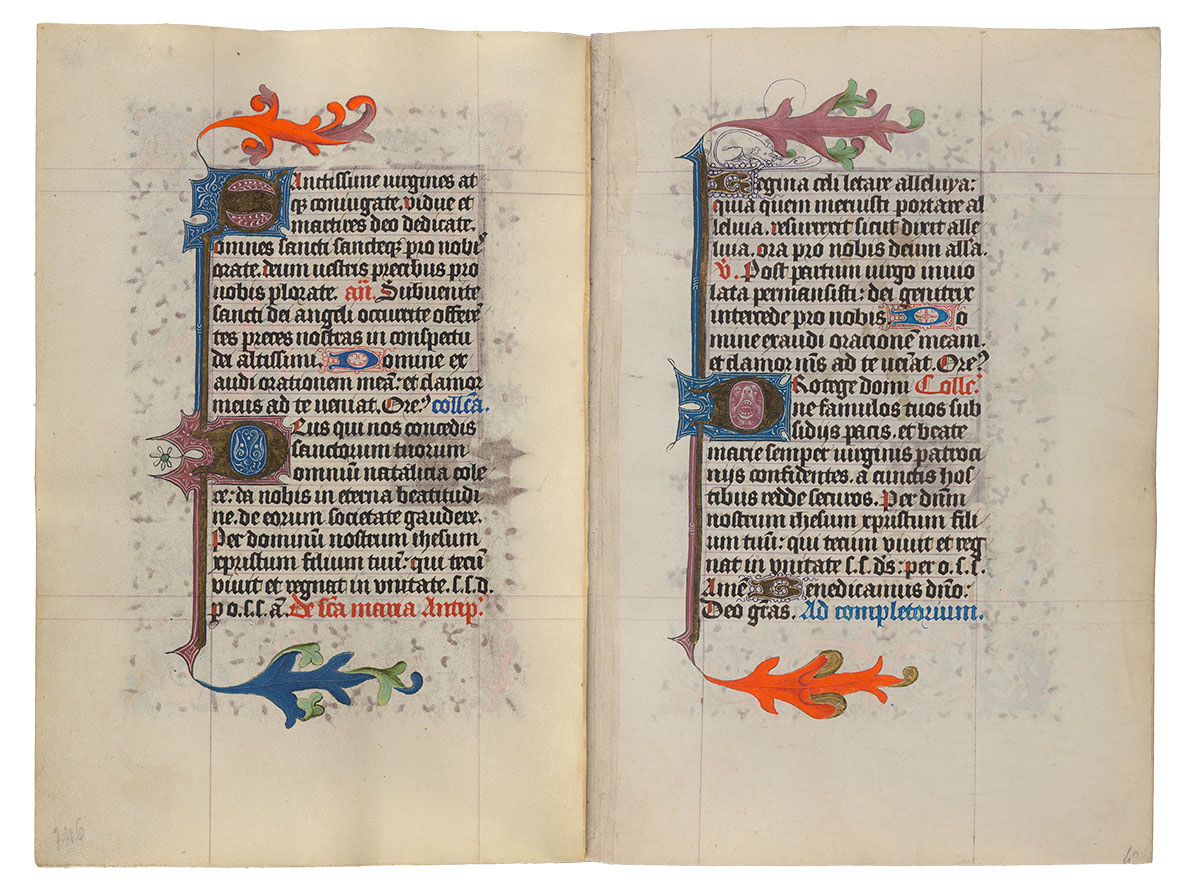
Purchased on the Belle da Costa Greene Fund with the assistance of the Fellows, 1963; purchased on the Belle da Costa Greene Fund with the assistance of the Fellows and with special assistance of Mrs. Frederick B. Adams, Sr., Mrs. Robert Charles, Mr. Laurens M. Hamilton, The Heineman Foundation, Mrs. Donald F. Hyde, Mrs. Jacob M. Kaplan, Mrs. John Kean, Mr. Paul Mellon, Mr. and Mrs. Charles F. Morgan, Mr. Lessing J. Rosenwald, Mr. and Mrs. August H. Schilling, Mrs. Herbert N. Straus, Mrs. Landon K. Thorne, Mrs. Alan Valentine, Mr. and Mrs. Arnold Whitridge, and Miss Julia P. Wightman, 1970
Image courtesy of Faksimile Verlag Luzern
MS M.917/945, p. 44–f. 123r

St. Michael Battling a Demon
Purchased on the Belle da Costa Greene Fund with the assistance of the Fellows, 1963; purchased on the Belle da Costa Greene Fund with the assistance of the Fellows and with special assistance of Mrs. Frederick B. Adams, Sr., Mrs. Robert Charles, Mr. Laurens M. Hamilton, The Heineman Foundation, Mrs. Donald F. Hyde, Mrs. Jacob M. Kaplan, Mrs. John Kean, Mr. Paul Mellon, Mr. and Mrs. Charles F. Morgan, Mr. Lessing J. Rosenwald, Mr. and Mrs. August H. Schilling, Mrs. Herbert N. Straus, Mrs. Landon K. Thorne, Mrs. Alan Valentine, Mr. and Mrs. Arnold Whitridge, and Miss Julia P. Wightman, 1970
The last of the miniatures for the Hours of All Saints is this unusual—but striking—image of Michael engaged in a fierce fight with a demon. (All the other miniatures in the series depict quiet adoration of the Godhead.) Michael's face might remain calm, but his windblown clothing reflects the heat of his battle against an especially nasty-looking demon. The white tendrils of the background, while decorative, contribute to the sense of agitation.
Hours and Masses for the Seven Days of the Week
The most unusual texts in Catherine's manuscript are the series of Hours and Masses for every day of the week. Medieval Christian tradition associated certain figures or themes with different days. Thus Sunday, the day of the Resurrection, was the Lord's Day; Thursday was connected with the Eucharist since that sacrament was instituted on Holy Thursday; and Monday was the day of the dead, since their torments were suspended on Sunday but recommenced the following day. In Catherine's prayer book, the themes for the Hours and Masses of the seven days of the week are:
| Sunday | the Trinity |
| Monday | the Dead |
| Tuesday | the Holy Spirit |
| Wednesday | All Saints |
| Thursday | the Blessed Sacrament |
| Friday | the Compassion of God |
| Saturday | the Virgin. |
Image courtesy of Faksimile Verlag Luzern
MS M.917/945, ff. 123v–124r

SS. Peter, John the Baptist, and Martin
Purchased on the Belle da Costa Greene Fund with the assistance of the Fellows and with special assistance of Mrs. Frederick B. Adams, Sr., Mrs. Robert Charles, Mr. Laurens M. Hamilton, The Heineman Foundation, Mrs. Donald F. Hyde, Mrs. Jacob M. Kaplan, Mrs. John Kean, Mr. Paul Mellon, Mr. and Mrs. Charles F. Morgan, Mr. Lessing J. Rosenwald, Mr. and Mrs. August H. Schilling, Mrs. Herbert N. Straus, Mrs. Landon K. Thorne, Mrs. Alan Valentine, Mr. and Mrs. Arnold Whitridge, and Miss Julia P. Wightman, 1970
This small miniature for the Mass of All Saints includes three popular saints, each identifiable by his attributes. Peter, wearing a papal tiara, holds the keys to heaven. Beneath his cloak, John the Baptist wears a camel skin and holds the Lamb of God on his book. Martin, dressed as a bishop, shares his cloak with a beggar. This small image was originally juxtaposed with a full-page miniature that is lost. Its disappearance makes any attempt to reconstruct the original context of the remaining depiction challenging.
Hours and Masses for the Seven Days of the Week
The most unusual texts in Catherine's manuscript are the series of Hours and Masses for every day of the week. Medieval Christian tradition associated certain figures or themes with different days. Thus Sunday, the day of the Resurrection, was the Lord's Day; Thursday was connected with the Eucharist since that sacrament was instituted on Holy Thursday; and Monday was the day of the dead, since their torments were suspended on Sunday but recommenced the following day. In Catherine's prayer book, the themes for the Hours and Masses of the seven days of the week are:
| Sunday | the Trinity |
| Monday | the Dead |
| Tuesday | the Holy Spirit |
| Wednesday | All Saints |
| Thursday | the Blessed Sacrament |
| Friday | the Compassion of God |
| Saturday | the Virgin. |
Image courtesy of Faksimile Verlag Luzern
MS M.917/945, ff. 124v–125r

Purchased on the Belle da Costa Greene Fund with the assistance of the Fellows and with special assistance of Mrs. Frederick B. Adams, Sr., Mrs. Robert Charles, Mr. Laurens M. Hamilton, The Heineman Foundation, Mrs. Donald F. Hyde, Mrs. Jacob M. Kaplan, Mrs. John Kean, Mr. Paul Mellon, Mr. and Mrs. Charles F. Morgan, Mr. Lessing J. Rosenwald, Mr. and Mrs. August H. Schilling, Mrs. Herbert N. Straus, Mrs. Landon K. Thorne, Mrs. Alan Valentine, Mr. and Mrs. Arnold Whitridge, and Miss Julia P. Wightman, 1970
Image courtesy of Faksimile Verlag Luzern
MS M.917/945, ff. 125v–126r
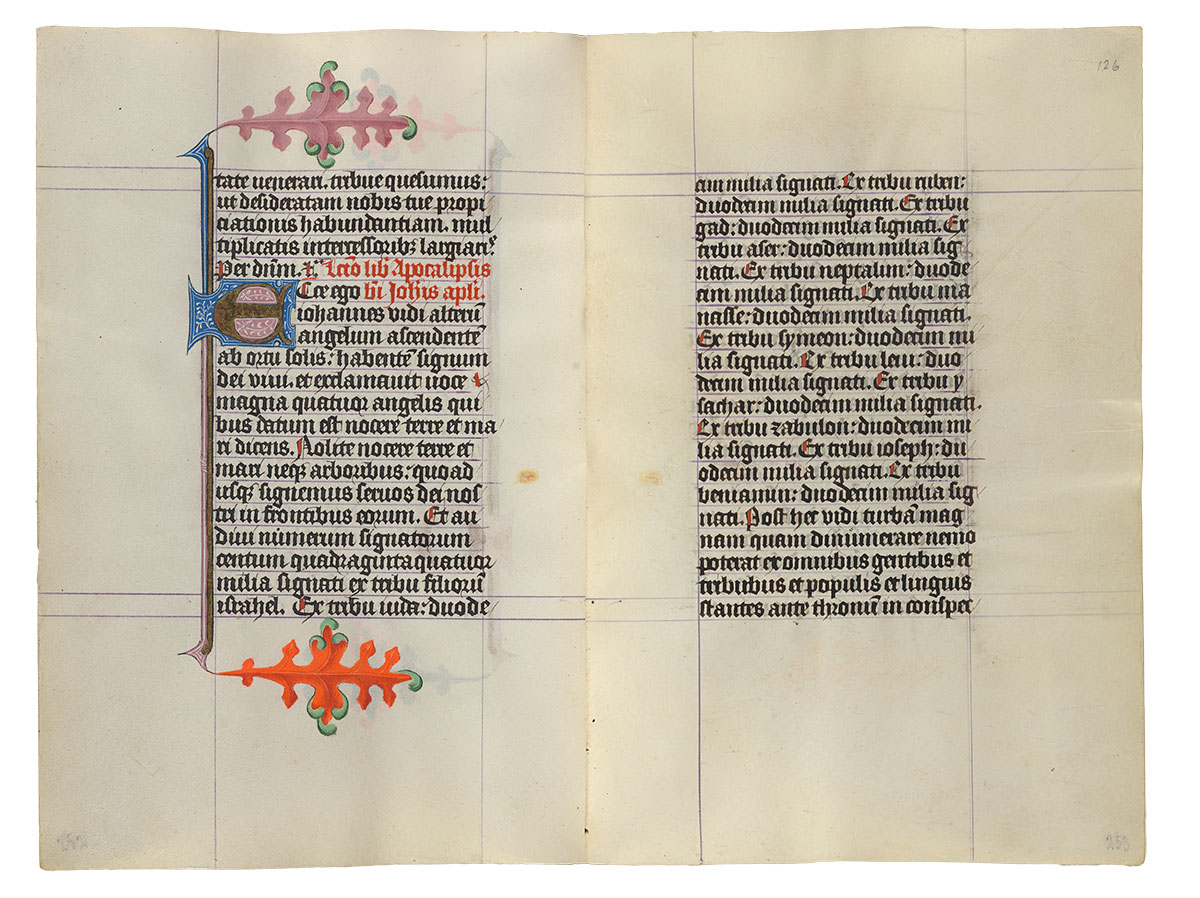
Purchased on the Belle da Costa Greene Fund with the assistance of the Fellows and with special assistance of Mrs. Frederick B. Adams, Sr., Mrs. Robert Charles, Mr. Laurens M. Hamilton, The Heineman Foundation, Mrs. Donald F. Hyde, Mrs. Jacob M. Kaplan, Mrs. John Kean, Mr. Paul Mellon, Mr. and Mrs. Charles F. Morgan, Mr. Lessing J. Rosenwald, Mr. and Mrs. August H. Schilling, Mrs. Herbert N. Straus, Mrs. Landon K. Thorne, Mrs. Alan Valentine, Mr. and Mrs. Arnold Whitridge, and Miss Julia P. Wightman, 1970
Image courtesy of Faksimile Verlag Luzern
MS M.917/945, ff. 126v–127r
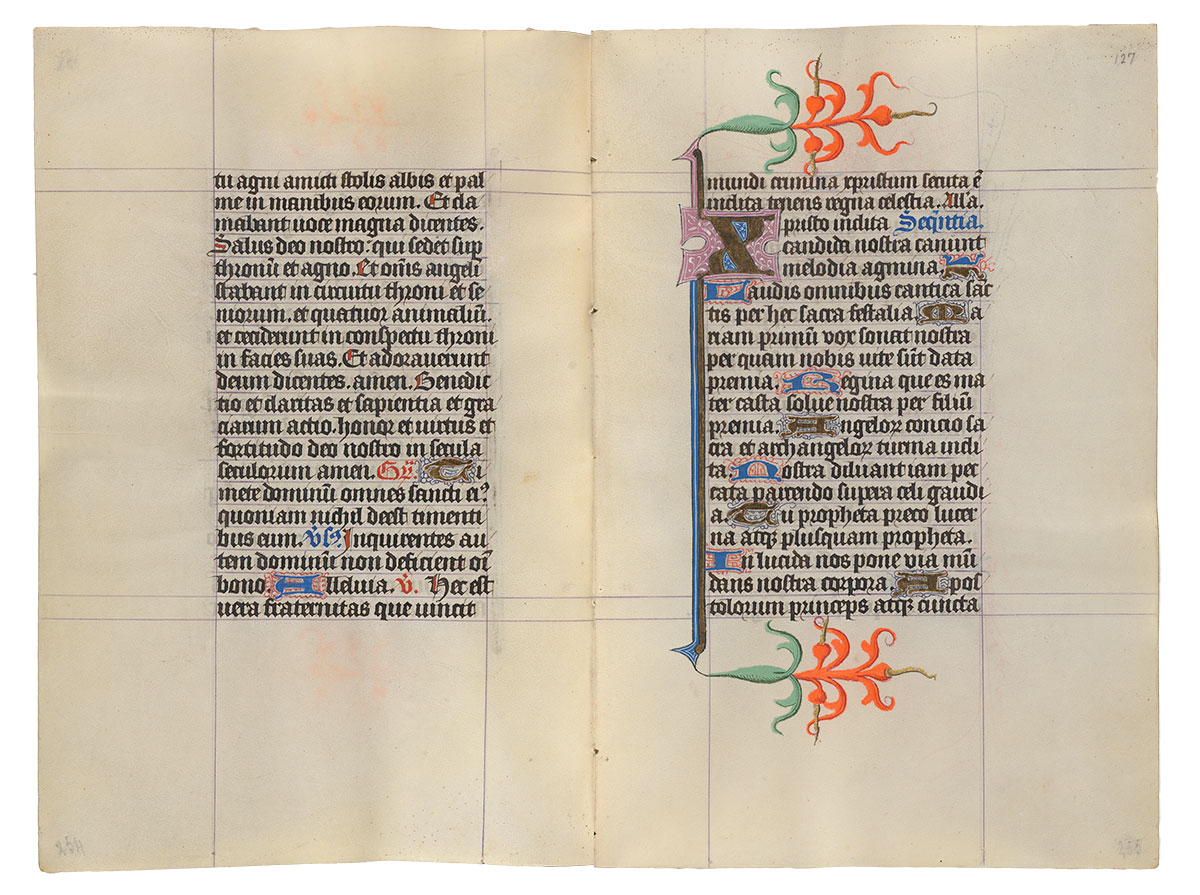
Purchased on the Belle da Costa Greene Fund with the assistance of the Fellows and with special assistance of Mrs. Frederick B. Adams, Sr., Mrs. Robert Charles, Mr. Laurens M. Hamilton, The Heineman Foundation, Mrs. Donald F. Hyde, Mrs. Jacob M. Kaplan, Mrs. John Kean, Mr. Paul Mellon, Mr. and Mrs. Charles F. Morgan, Mr. Lessing J. Rosenwald, Mr. and Mrs. August H. Schilling, Mrs. Herbert N. Straus, Mrs. Landon K. Thorne, Mrs. Alan Valentine, Mr. and Mrs. Arnold Whitridge, and Miss Julia P. Wightman, 1970
Image courtesy of Faksimile Verlag Luzern
MS M.917/945, ff. 127v–128r
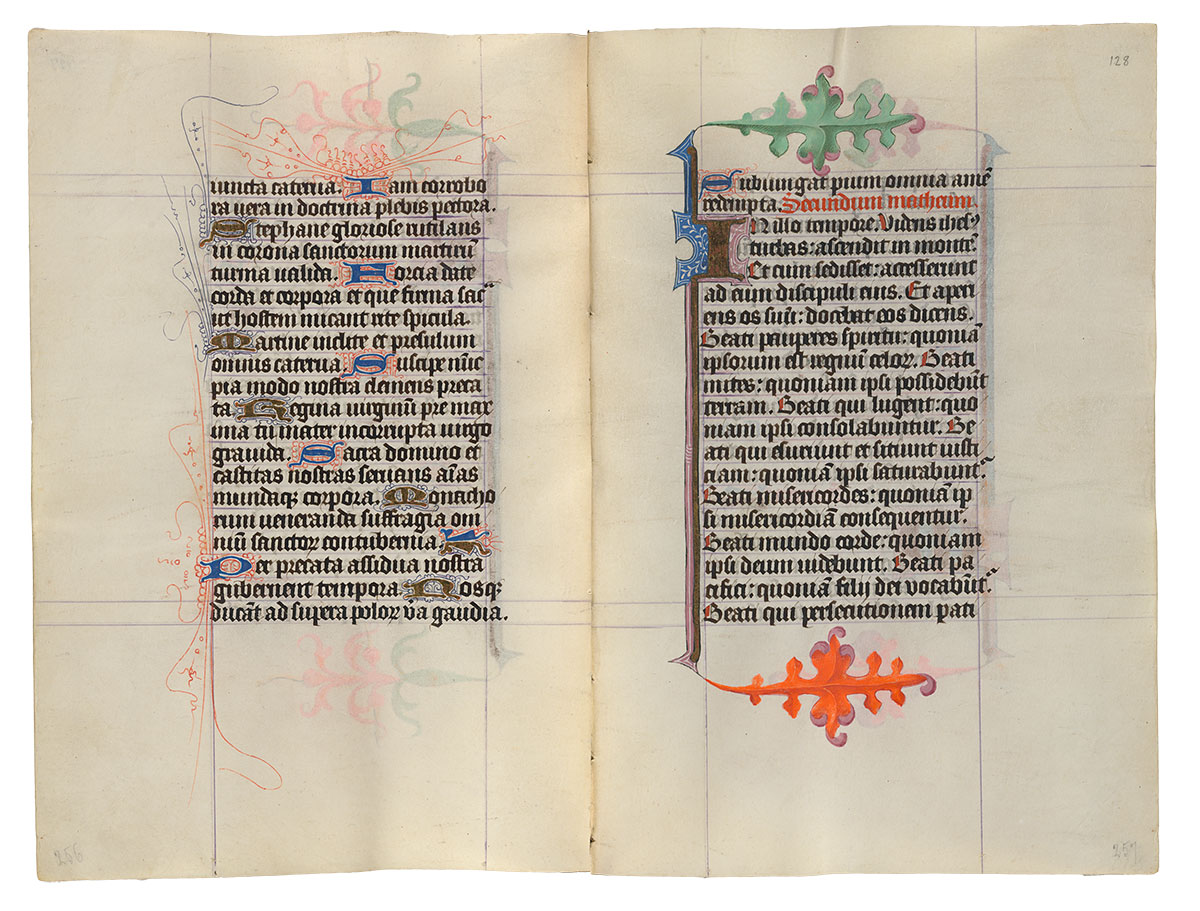
Purchased on the Belle da Costa Greene Fund with the assistance of the Fellows and with special assistance of Mrs. Frederick B. Adams, Sr., Mrs. Robert Charles, Mr. Laurens M. Hamilton, The Heineman Foundation, Mrs. Donald F. Hyde, Mrs. Jacob M. Kaplan, Mrs. John Kean, Mr. Paul Mellon, Mr. and Mrs. Charles F. Morgan, Mr. Lessing J. Rosenwald, Mr. and Mrs. August H. Schilling, Mrs. Herbert N. Straus, Mrs. Landon K. Thorne, Mrs. Alan Valentine, Mr. and Mrs. Arnold Whitridge, and Miss Julia P. Wightman, 1970
Image courtesy of Faksimile Verlag Luzern
MS M.917/945, ff. 128v–129r
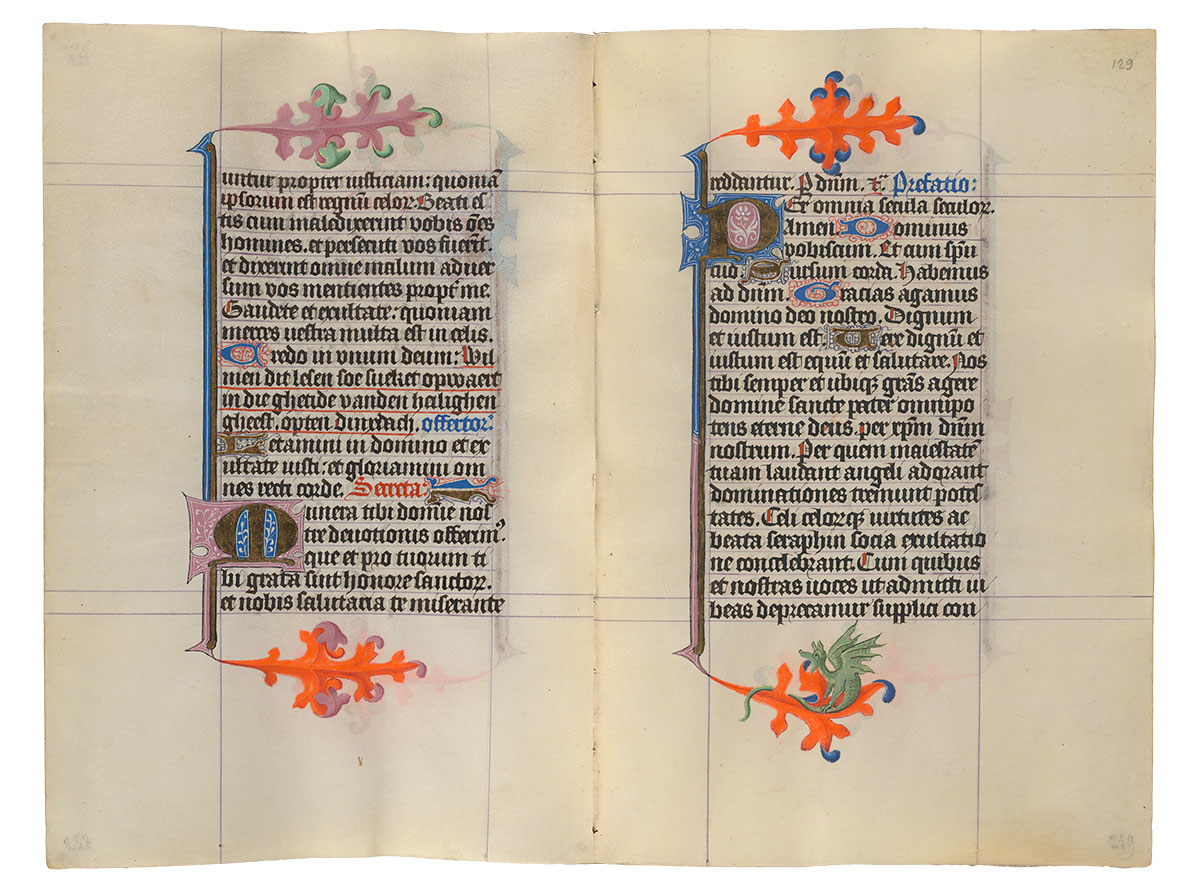
Purchased on the Belle da Costa Greene Fund with the assistance of the Fellows and with special assistance of Mrs. Frederick B. Adams, Sr., Mrs. Robert Charles, Mr. Laurens M. Hamilton, The Heineman Foundation, Mrs. Donald F. Hyde, Mrs. Jacob M. Kaplan, Mrs. John Kean, Mr. Paul Mellon, Mr. and Mrs. Charles F. Morgan, Mr. Lessing J. Rosenwald, Mr. and Mrs. August H. Schilling, Mrs. Herbert N. Straus, Mrs. Landon K. Thorne, Mrs. Alan Valentine, Mr. and Mrs. Arnold Whitridge, and Miss Julia P. Wightman, 1970
Image courtesy of Faksimile Verlag Luzern
MS M.917/945, ff. 129v–130r
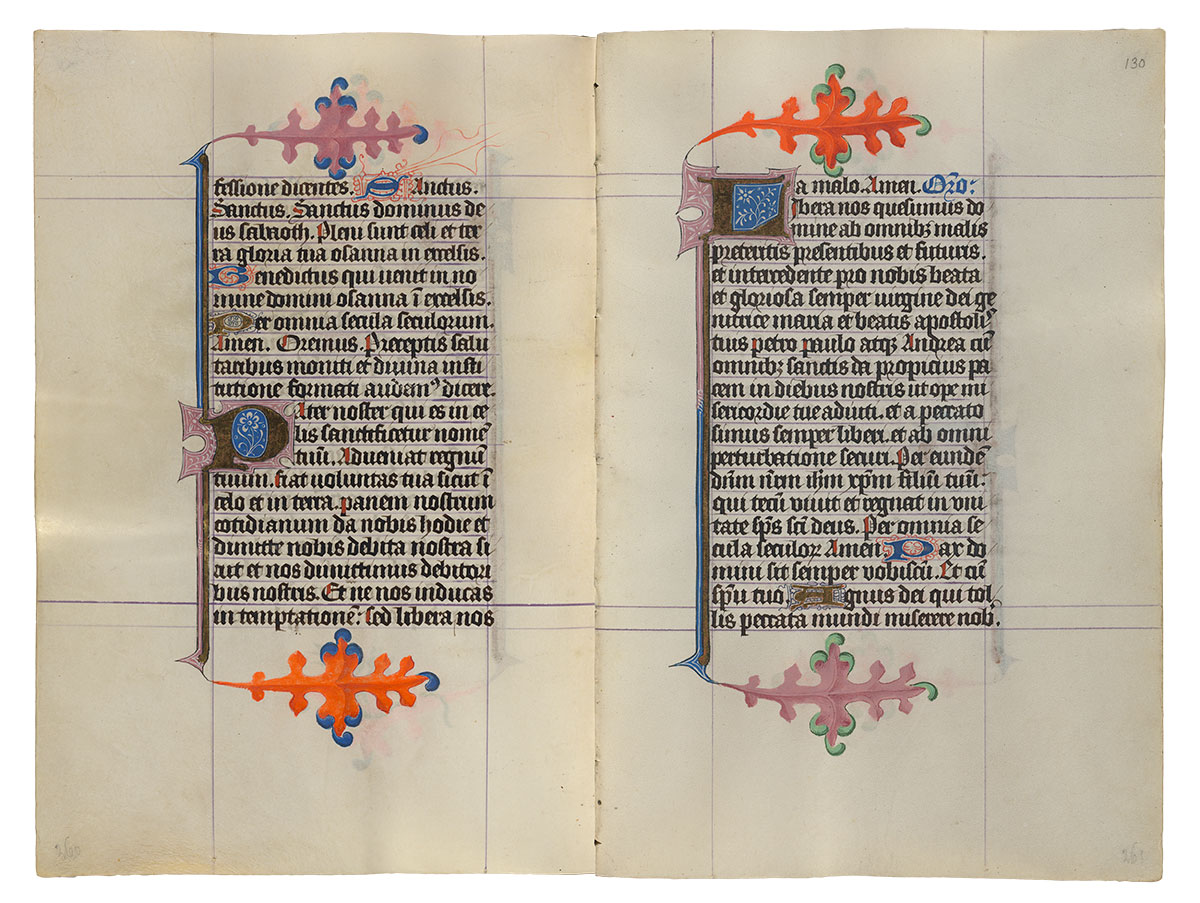
Purchased on the Belle da Costa Greene Fund with the assistance of the Fellows and with special assistance of Mrs. Frederick B. Adams, Sr., Mrs. Robert Charles, Mr. Laurens M. Hamilton, The Heineman Foundation, Mrs. Donald F. Hyde, Mrs. Jacob M. Kaplan, Mrs. John Kean, Mr. Paul Mellon, Mr. and Mrs. Charles F. Morgan, Mr. Lessing J. Rosenwald, Mr. and Mrs. August H. Schilling, Mrs. Herbert N. Straus, Mrs. Landon K. Thorne, Mrs. Alan Valentine, Mr. and Mrs. Arnold Whitridge, and Miss Julia P. Wightman, 1970
Image courtesy of Faksimile Verlag Luzern
MS M.917/945, ff. 130v–131r
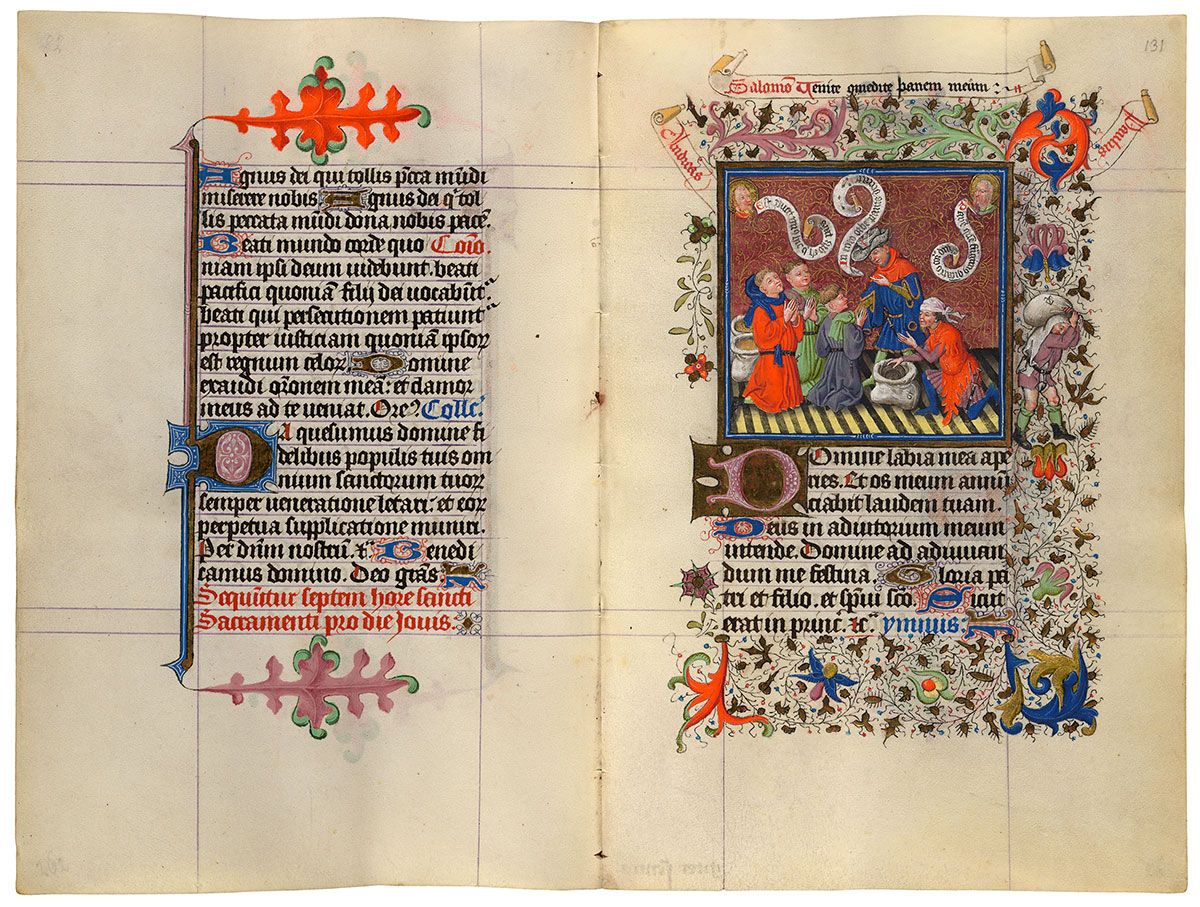
Joseph Reveals Himself to his Brothers
Purchased on the Belle da Costa Greene Fund with the assistance of the Fellows and with special assistance of Mrs. Frederick B. Adams, Sr., Mrs. Robert Charles, Mr. Laurens M. Hamilton, The Heineman Foundation, Mrs. Donald F. Hyde, Mrs. Jacob M. Kaplan, Mrs. John Kean, Mr. Paul Mellon, Mr. and Mrs. Charles F. Morgan, Mr. Lessing J. Rosenwald, Mr. and Mrs. August H. Schilling, Mrs. Herbert N. Straus, Mrs. Landon K. Thorne, Mrs. Alan Valentine, Mr. and Mrs. Arnold Whitridge, and Miss Julia P. Wightman, 1970
Hours and Masses for the Seven Days of the Week
The most unusual texts in Catherine's manuscript are the series of Hours and Masses for every day of the week. Medieval Christian tradition associated certain figures or themes with different days. Thus Sunday, the day of the Resurrection, was the Lord's Day; Thursday was connected with the Eucharist since that sacrament was instituted on Holy Thursday; and Monday was the day of the dead, since their torments were suspended on Sunday but recommenced the following day. In Catherine's prayer book, the themes for the Hours and Masses of the seven days of the week are:
| Sunday | the Trinity |
| Monday | the Dead |
| Tuesday | the Holy Spirit |
| Wednesday | All Saints |
| Thursday | the Blessed Sacrament |
| Friday | the Compassion of God |
| Saturday | the Virgin. |
Image courtesy of Faksimile Verlag Luzern
MS M.917/945, ff. 131v–132r
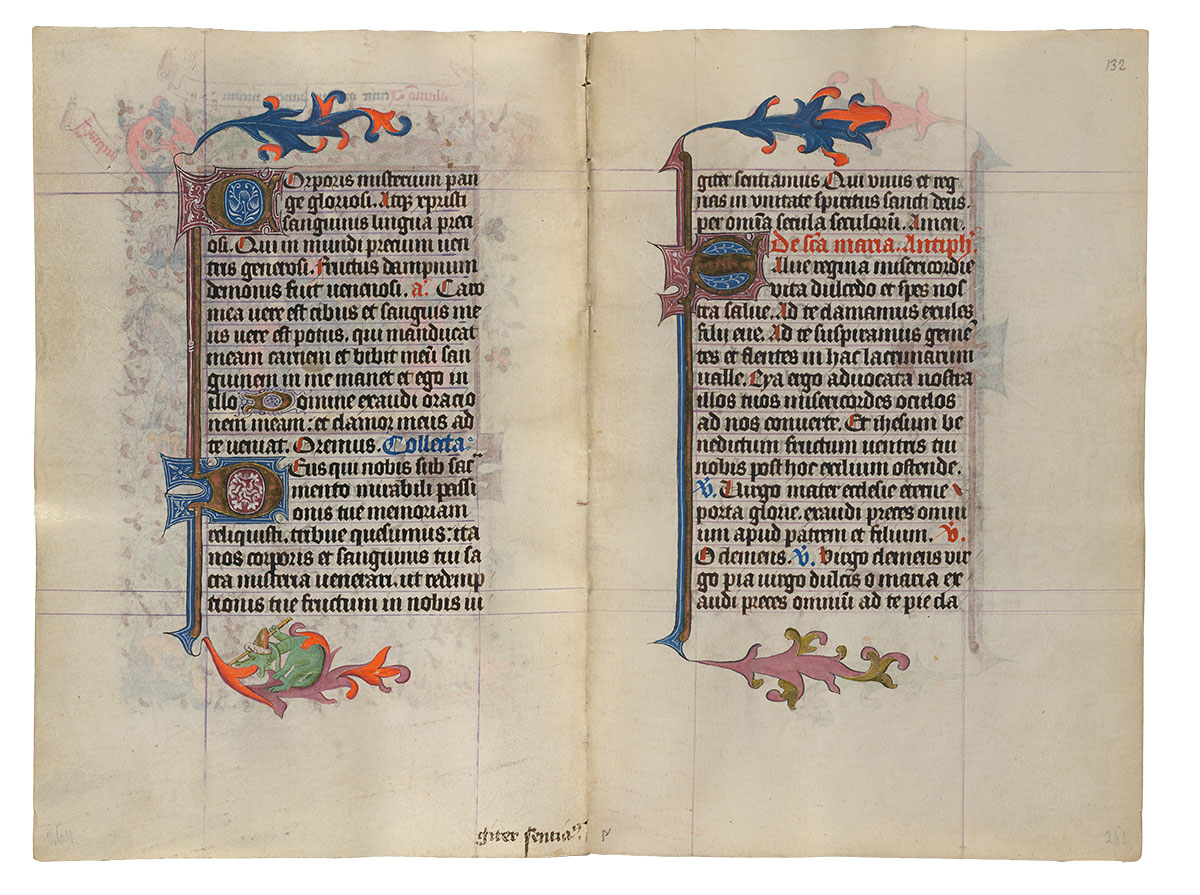
Purchased on the Belle da Costa Greene Fund with the assistance of the Fellows and with special assistance of Mrs. Frederick B. Adams, Sr., Mrs. Robert Charles, Mr. Laurens M. Hamilton, The Heineman Foundation, Mrs. Donald F. Hyde, Mrs. Jacob M. Kaplan, Mrs. John Kean, Mr. Paul Mellon, Mr. and Mrs. Charles F. Morgan, Mr. Lessing J. Rosenwald, Mr. and Mrs. August H. Schilling, Mrs. Herbert N. Straus, Mrs. Landon K. Thorne, Mrs. Alan Valentine, Mr. and Mrs. Arnold Whitridge, and Miss Julia P. Wightman, 1970
Image courtesy of Faksimile Verlag Luzern
MS M.917/945, ff. 132v–133r
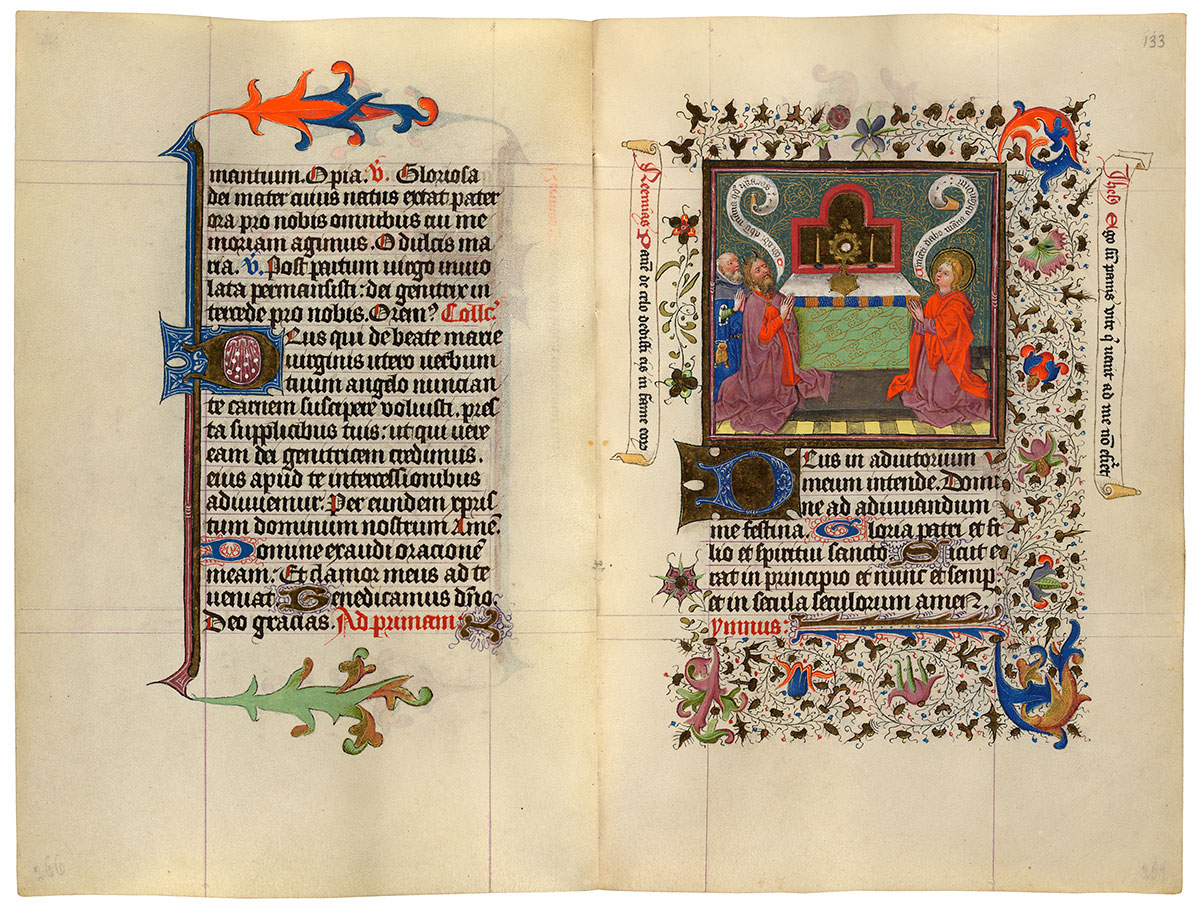
The Eucharist Adored by Moses and St. John the Evangelist
Purchased on the Belle da Costa Greene Fund with the assistance of the Fellows and with special assistance of Mrs. Frederick B. Adams, Sr., Mrs. Robert Charles, Mr. Laurens M. Hamilton, The Heineman Foundation, Mrs. Donald F. Hyde, Mrs. Jacob M. Kaplan, Mrs. John Kean, Mr. Paul Mellon, Mr. and Mrs. Charles F. Morgan, Mr. Lessing J. Rosenwald, Mr. and Mrs. August H. Schilling, Mrs. Herbert N. Straus, Mrs. Landon K. Thorne, Mrs. Alan Valentine, Mr. and Mrs. Arnold Whitridge, and Miss Julia P. Wightman, 1970
Hours and Masses for the Seven Days of the Week
The most unusual texts in Catherine's manuscript are the series of Hours and Masses for every day of the week. Medieval Christian tradition associated certain figures or themes with different days. Thus Sunday, the day of the Resurrection, was the Lord's Day; Thursday was connected with the Eucharist since that sacrament was instituted on Holy Thursday; and Monday was the day of the dead, since their torments were suspended on Sunday but recommenced the following day. In Catherine's prayer book, the themes for the Hours and Masses of the seven days of the week are:
| Sunday | the Trinity |
| Monday | the Dead |
| Tuesday | the Holy Spirit |
| Wednesday | All Saints |
| Thursday | the Blessed Sacrament |
| Friday | the Compassion of God |
| Saturday | the Virgin. |
Image courtesy of Faksimile Verlag Luzern
MS M.917/945, ff. 133v–134r
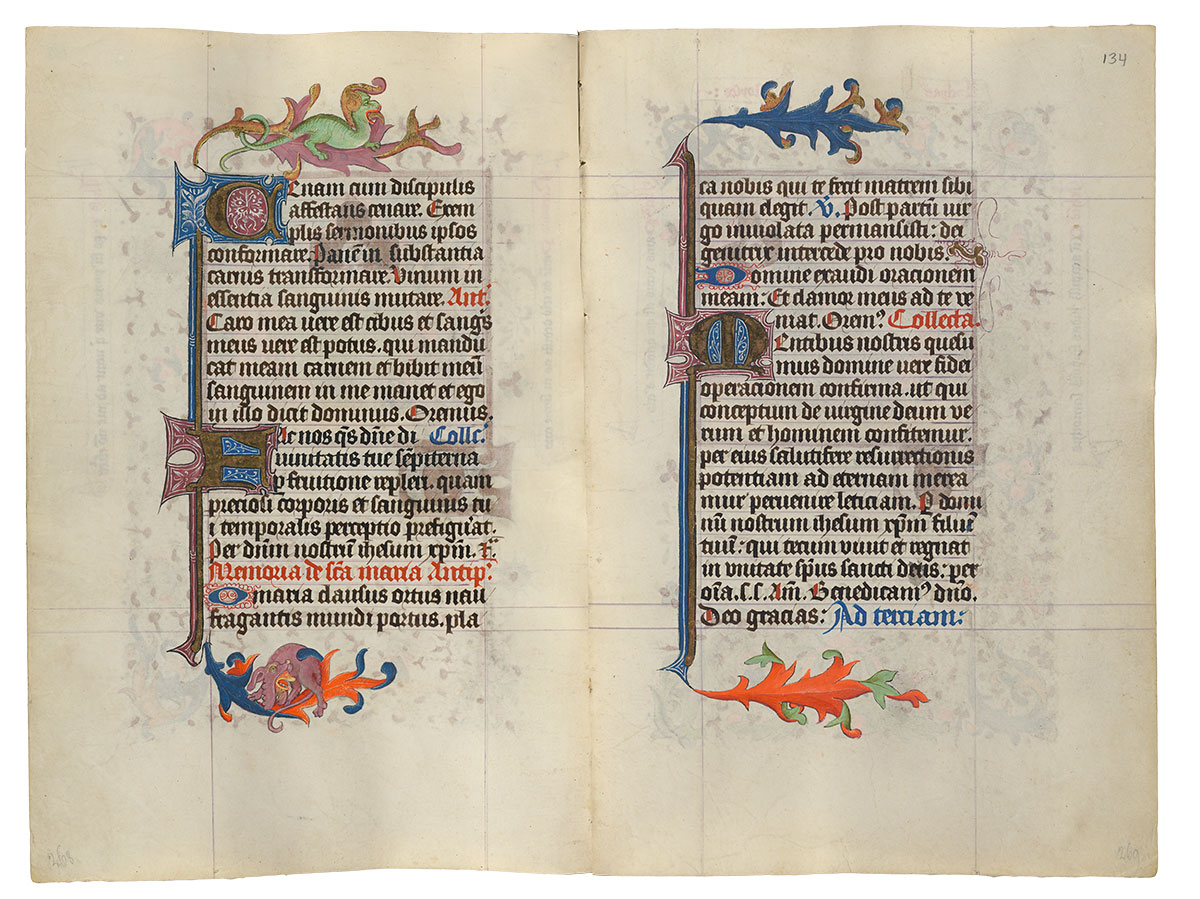
Purchased on the Belle da Costa Greene Fund with the assistance of the Fellows and with special assistance of Mrs. Frederick B. Adams, Sr., Mrs. Robert Charles, Mr. Laurens M. Hamilton, The Heineman Foundation, Mrs. Donald F. Hyde, Mrs. Jacob M. Kaplan, Mrs. John Kean, Mr. Paul Mellon, Mr. and Mrs. Charles F. Morgan, Mr. Lessing J. Rosenwald, Mr. and Mrs. August H. Schilling, Mrs. Herbert N. Straus, Mrs. Landon K. Thorne, Mrs. Alan Valentine, Mr. and Mrs. Arnold Whitridge, and Miss Julia P. Wightman, 1970
Image courtesy of Faksimile Verlag Luzern
MS M.917/945, ff. 134v–135r
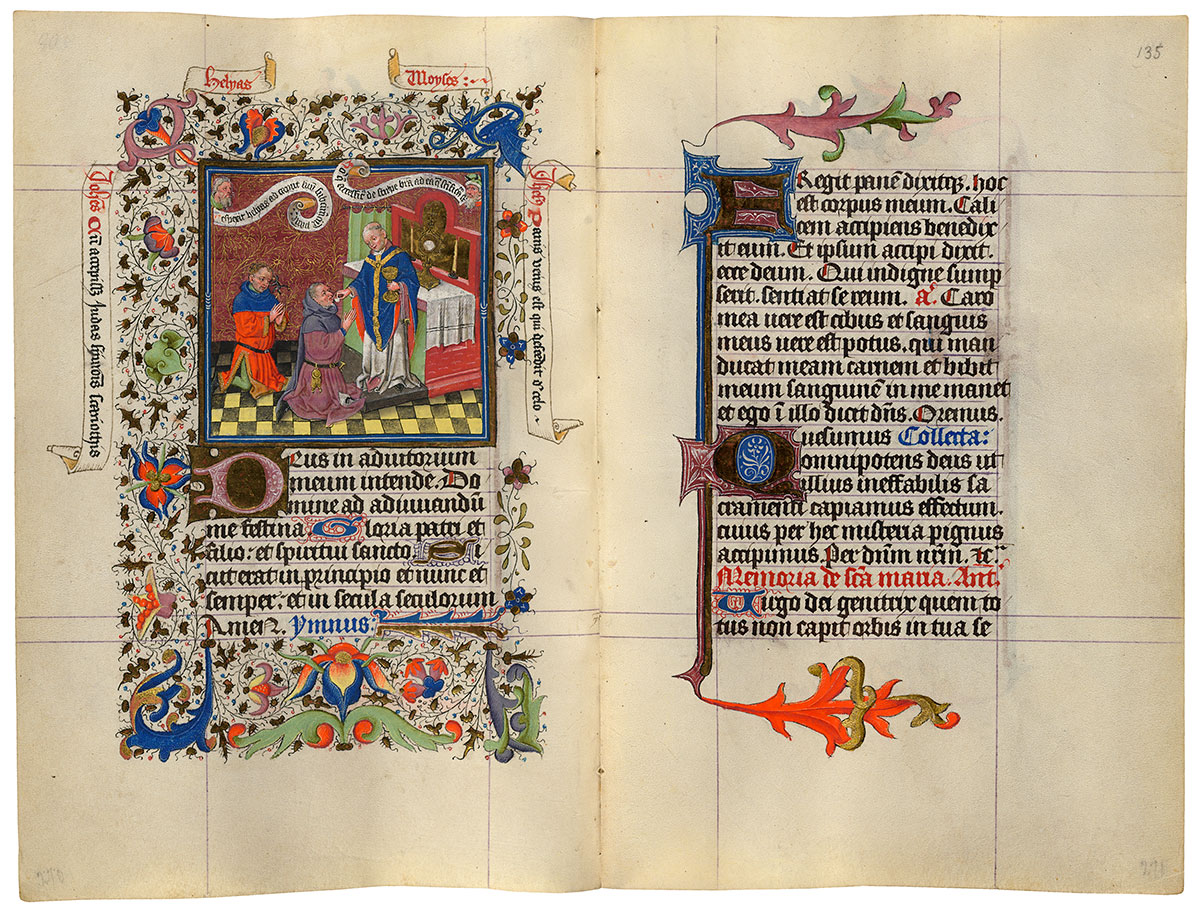
Worthy and Unworthy Communion
Purchased on the Belle da Costa Greene Fund with the assistance of the Fellows and with special assistance of Mrs. Frederick B. Adams, Sr., Mrs. Robert Charles, Mr. Laurens M. Hamilton, The Heineman Foundation, Mrs. Donald F. Hyde, Mrs. Jacob M. Kaplan, Mrs. John Kean, Mr. Paul Mellon, Mr. and Mrs. Charles F. Morgan, Mr. Lessing J. Rosenwald, Mr. and Mrs. August H. Schilling, Mrs. Herbert N. Straus, Mrs. Landon K. Thorne, Mrs. Alan Valentine, Mr. and Mrs. Arnold Whitridge, and Miss Julia P. Wightman, 1970
Hours and Masses for the Seven Days of the Week
The most unusual texts in Catherine's manuscript are the series of Hours and Masses for every day of the week. Medieval Christian tradition associated certain figures or themes with different days. Thus Sunday, the day of the Resurrection, was the Lord's Day; Thursday was connected with the Eucharist since that sacrament was instituted on Holy Thursday; and Monday was the day of the dead, since their torments were suspended on Sunday but recommenced the following day. In Catherine's prayer book, the themes for the Hours and Masses of the seven days of the week are:
| Sunday | the Trinity |
| Monday | the Dead |
| Tuesday | the Holy Spirit |
| Wednesday | All Saints |
| Thursday | the Blessed Sacrament |
| Friday | the Compassion of God |
| Saturday | the Virgin. |
Image courtesy of Faksimile Verlag Luzern
MS M.917/945, ff. 135v–136r
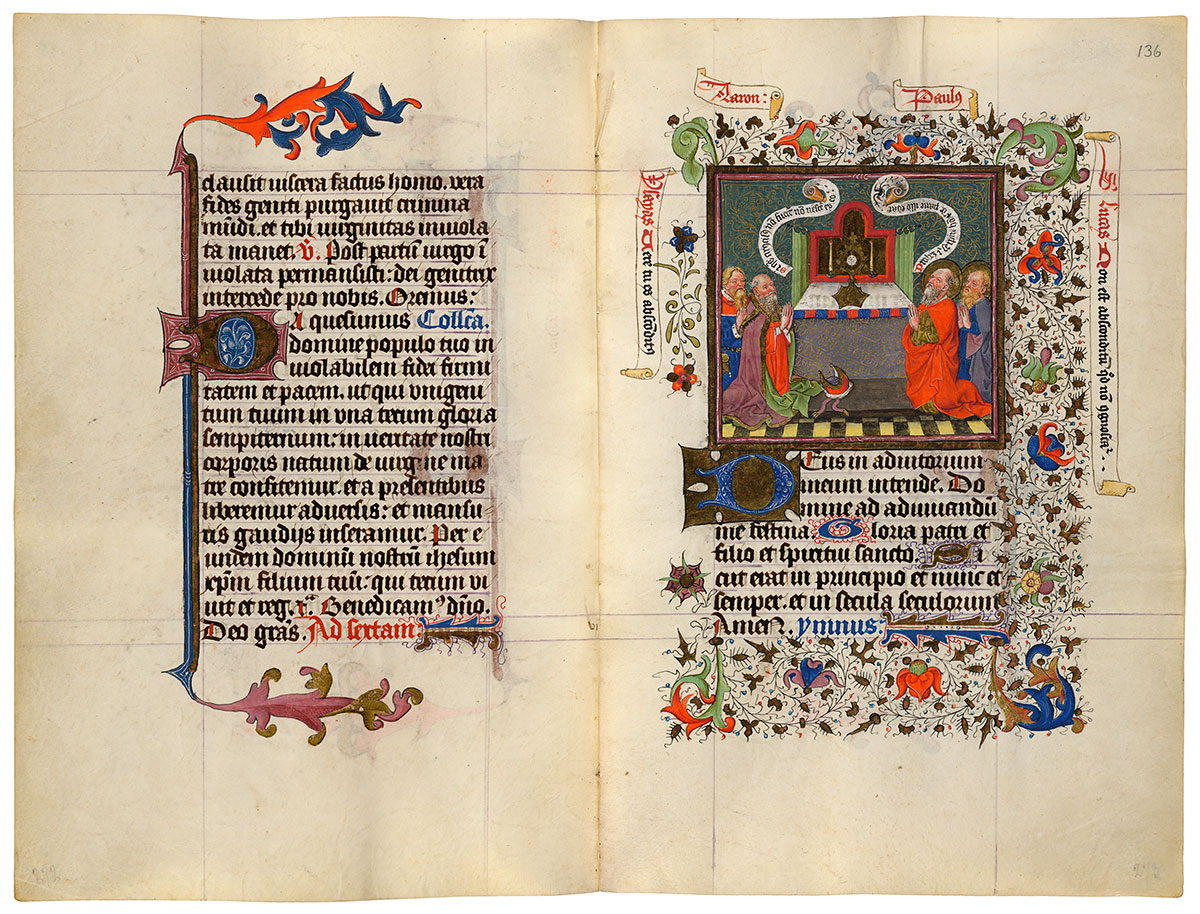
The Eucharist Adored by Prophets Aaron and Isaiah and SS. Paul and Luke
Purchased on the Belle da Costa Greene Fund with the assistance of the Fellows and with special assistance of Mrs. Frederick B. Adams, Sr., Mrs. Robert Charles, Mr. Laurens M. Hamilton, The Heineman Foundation, Mrs. Donald F. Hyde, Mrs. Jacob M. Kaplan, Mrs. John Kean, Mr. Paul Mellon, Mr. and Mrs. Charles F. Morgan, Mr. Lessing J. Rosenwald, Mr. and Mrs. August H. Schilling, Mrs. Herbert N. Straus, Mrs. Landon K. Thorne, Mrs. Alan Valentine, Mr. and Mrs. Arnold Whitridge, and Miss Julia P. Wightman, 1970
The miniatures marking the Thursday Hours of the Blessed Sacrament contain some unusually complex iconography. Text tags helped Catherine (as they help us today) identify the scenes. Here the Eucharistic wafer, mounted in a monstrance, is being worshipped by four men. The prophets Aaron and Isaiah are on the left; their scroll, quoting Exodus (12:48), tells us that no uncircumcised person shall eat of the Passover. On the right are saints Paul and Luke; their scroll, quoting the First Epistle to the Corinthians (11:28), demands that a man be worthy before partaking of the Eucharist.
Hours and Masses for the Seven Days of the Week
The most unusual texts in Catherine's manuscript are the series of Hours and Masses for every day of the week. Medieval Christian tradition associated certain figures or themes with different days. Thus Sunday, the day of the Resurrection, was the Lord's Day; Thursday was connected with the Eucharist since that sacrament was instituted on Holy Thursday; and Monday was the day of the dead, since their torments were suspended on Sunday but recommenced the following day. In Catherine's prayer book, the themes for the Hours and Masses of the seven days of the week are:
| Sunday | the Trinity |
| Monday | the Dead |
| Tuesday | the Holy Spirit |
| Wednesday | All Saints |
| Thursday | the Blessed Sacrament |
| Friday | the Compassion of God |
| Saturday | the Virgin. |
Image courtesy of Faksimile Verlag Luzern
MS M.917/945, ff. 136v–137r
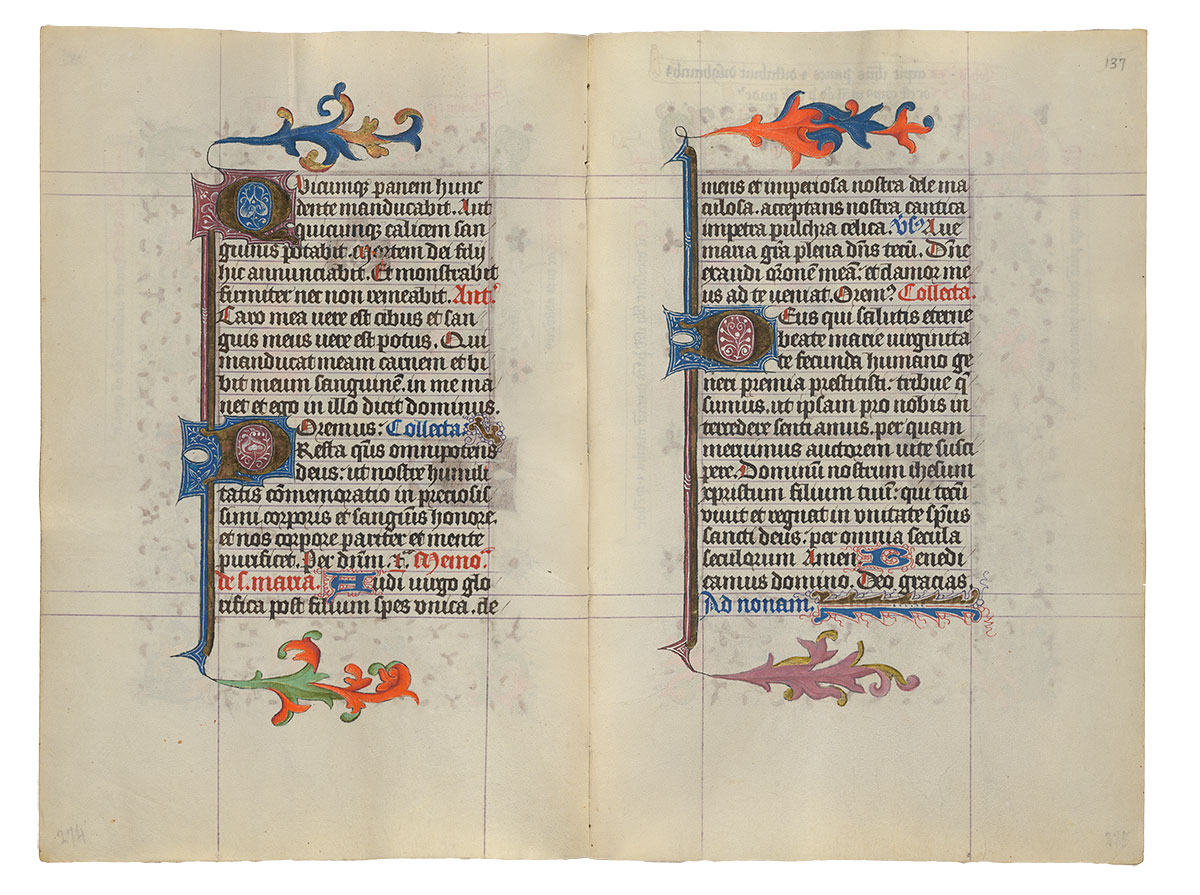
Purchased on the Belle da Costa Greene Fund with the assistance of the Fellows and with special assistance of Mrs. Frederick B. Adams, Sr., Mrs. Robert Charles, Mr. Laurens M. Hamilton, The Heineman Foundation, Mrs. Donald F. Hyde, Mrs. Jacob M. Kaplan, Mrs. John Kean, Mr. Paul Mellon, Mr. and Mrs. Charles F. Morgan, Mr. Lessing J. Rosenwald, Mr. and Mrs. August H. Schilling, Mrs. Herbert N. Straus, Mrs. Landon K. Thorne, Mrs. Alan Valentine, Mr. and Mrs. Arnold Whitridge, and Miss Julia P. Wightman, 1970
Image courtesy of Faksimile Verlag Luzern
MS M.917/945, ff. 137v–138r
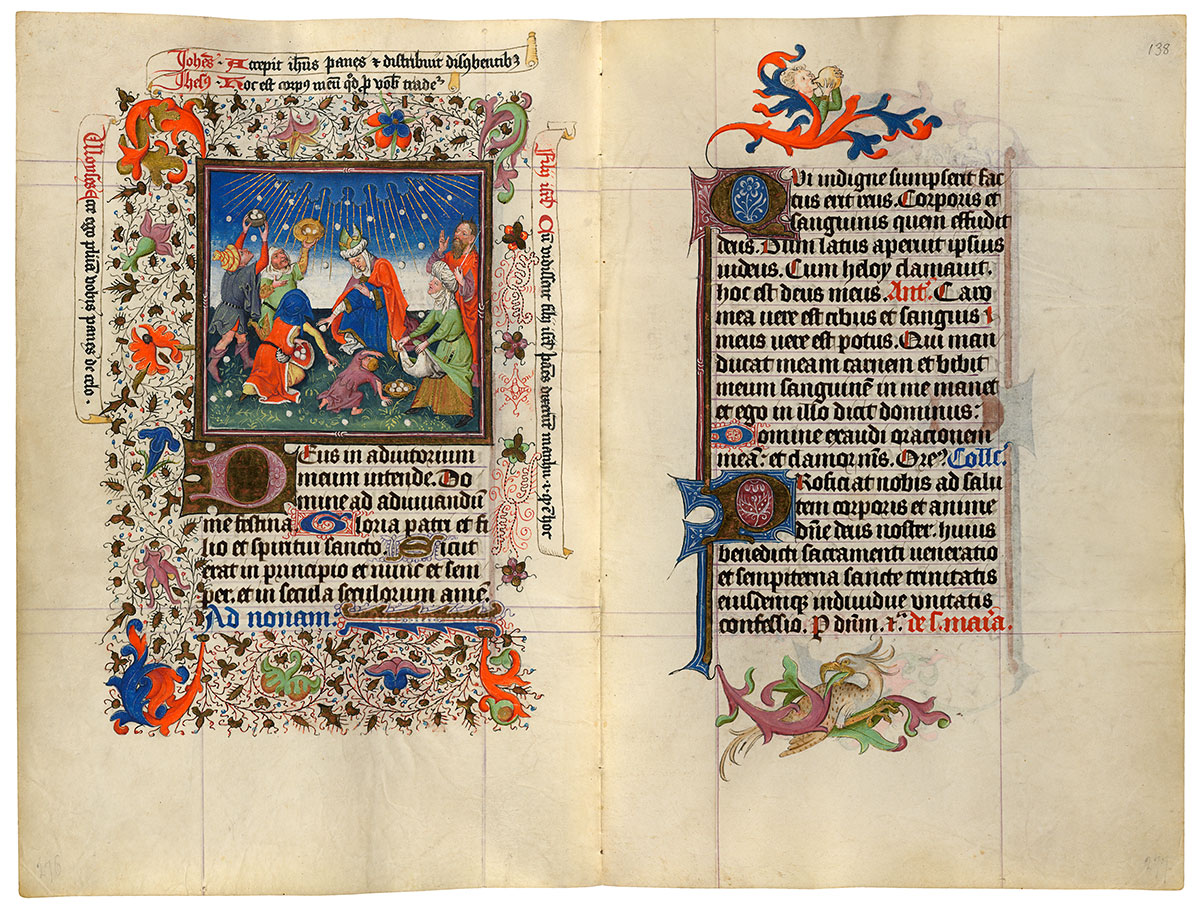
Gathering of Manna
Purchased on the Belle da Costa Greene Fund with the assistance of the Fellows and with special assistance of Mrs. Frederick B. Adams, Sr., Mrs. Robert Charles, Mr. Laurens M. Hamilton, The Heineman Foundation, Mrs. Donald F. Hyde, Mrs. Jacob M. Kaplan, Mrs. John Kean, Mr. Paul Mellon, Mr. and Mrs. Charles F. Morgan, Mr. Lessing J. Rosenwald, Mr. and Mrs. August H. Schilling, Mrs. Herbert N. Straus, Mrs. Landon K. Thorne, Mrs. Alan Valentine, Mr. and Mrs. Arnold Whitridge, and Miss Julia P. Wightman, 1970
Manna rains from heaven and is gathered by Aaron (at the center) and five Israelites—men, women, and a child. Moses, holding a staff, observes from the right. In the side margins, two quotations from Exodus (16:4 and 15) describe the event. The text at right quotes the "sons of Israel" asking themselves what the manna might mean. At the top, New Testament texts (from John 6:11 and 1 Corinthians 11:24) relate the manna to Christ's distribution of loaves to the five thousand and of the bread of his body—the Eucharist—to the apostles at the Last Supper. The latter quotation, "This is my body, which is broken for you," is similar to the words of transubstantiation recited at Mass.
Hours and Masses for the Seven Days of the Week
The most unusual texts in Catherine's manuscript are the series of Hours and Masses for every day of the week. Medieval Christian tradition associated certain figures or themes with different days. Thus Sunday, the day of the Resurrection, was the Lord's Day; Thursday was connected with the Eucharist since that sacrament was instituted on Holy Thursday; and Monday was the day of the dead, since their torments were suspended on Sunday but recommenced the following day. In Catherine's prayer book, the themes for the Hours and Masses of the seven days of the week are:
| Sunday | the Trinity |
| Monday | the Dead |
| Tuesday | the Holy Spirit |
| Wednesday | All Saints |
| Thursday | the Blessed Sacrament |
| Friday | the Compassion of God |
| Saturday | the Virgin. |
Image courtesy of Faksimile Verlag Luzern
MS M.917/945, ff. 138v–139r
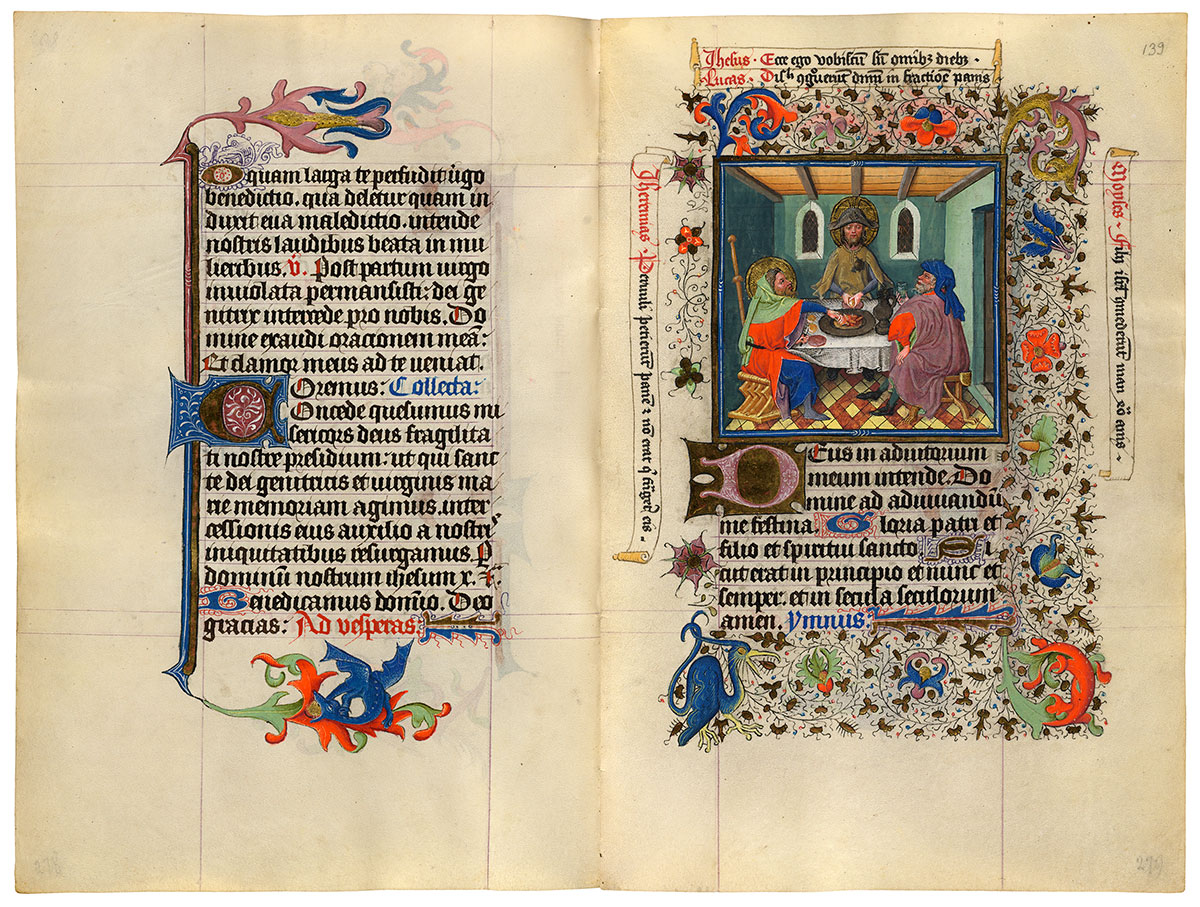
Supper at Emmaus
Purchased on the Belle da Costa Greene Fund with the assistance of the Fellows and with special assistance of Mrs. Frederick B. Adams, Sr., Mrs. Robert Charles, Mr. Laurens M. Hamilton, The Heineman Foundation, Mrs. Donald F. Hyde, Mrs. Jacob M. Kaplan, Mrs. John Kean, Mr. Paul Mellon, Mr. and Mrs. Charles F. Morgan, Mr. Lessing J. Rosenwald, Mr. and Mrs. August H. Schilling, Mrs. Herbert N. Straus, Mrs. Landon K. Thorne, Mrs. Alan Valentine, Mr. and Mrs. Arnold Whitridge, and Miss Julia P. Wightman, 1970
Hours and Masses for the Seven Days of the Week
The most unusual texts in Catherine's manuscript are the series of Hours and Masses for every day of the week. Medieval Christian tradition associated certain figures or themes with different days. Thus Sunday, the day of the Resurrection, was the Lord's Day; Thursday was connected with the Eucharist since that sacrament was instituted on Holy Thursday; and Monday was the day of the dead, since their torments were suspended on Sunday but recommenced the following day. In Catherine's prayer book, the themes for the Hours and Masses of the seven days of the week are:
| Sunday | the Trinity |
| Monday | the Dead |
| Tuesday | the Holy Spirit |
| Wednesday | All Saints |
| Thursday | the Blessed Sacrament |
| Friday | the Compassion of God |
| Saturday | the Virgin. |
Image courtesy of Faksimile Verlag Luzern
MS M.917/945, ff. 139v–140r
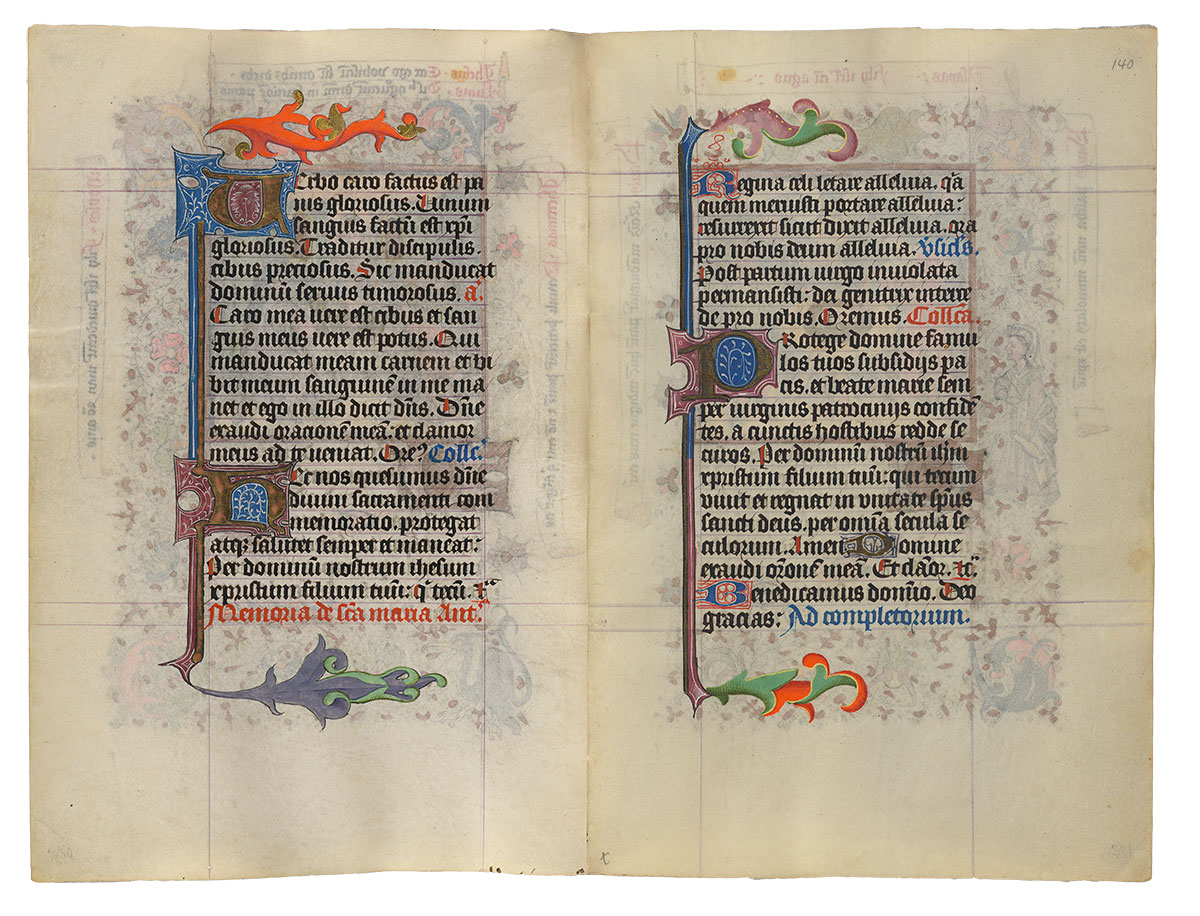
Purchased on the Belle da Costa Greene Fund with the assistance of the Fellows and with special assistance of Mrs. Frederick B. Adams, Sr., Mrs. Robert Charles, Mr. Laurens M. Hamilton, The Heineman Foundation, Mrs. Donald F. Hyde, Mrs. Jacob M. Kaplan, Mrs. John Kean, Mr. Paul Mellon, Mr. and Mrs. Charles F. Morgan, Mr. Lessing J. Rosenwald, Mr. and Mrs. August H. Schilling, Mrs. Herbert N. Straus, Mrs. Landon K. Thorne, Mrs. Alan Valentine, Mr. and Mrs. Arnold Whitridge, and Miss Julia P. Wightman, 1970
Image courtesy of Faksimile Verlag Luzern
MS M.917/945, ff. 140v–141r
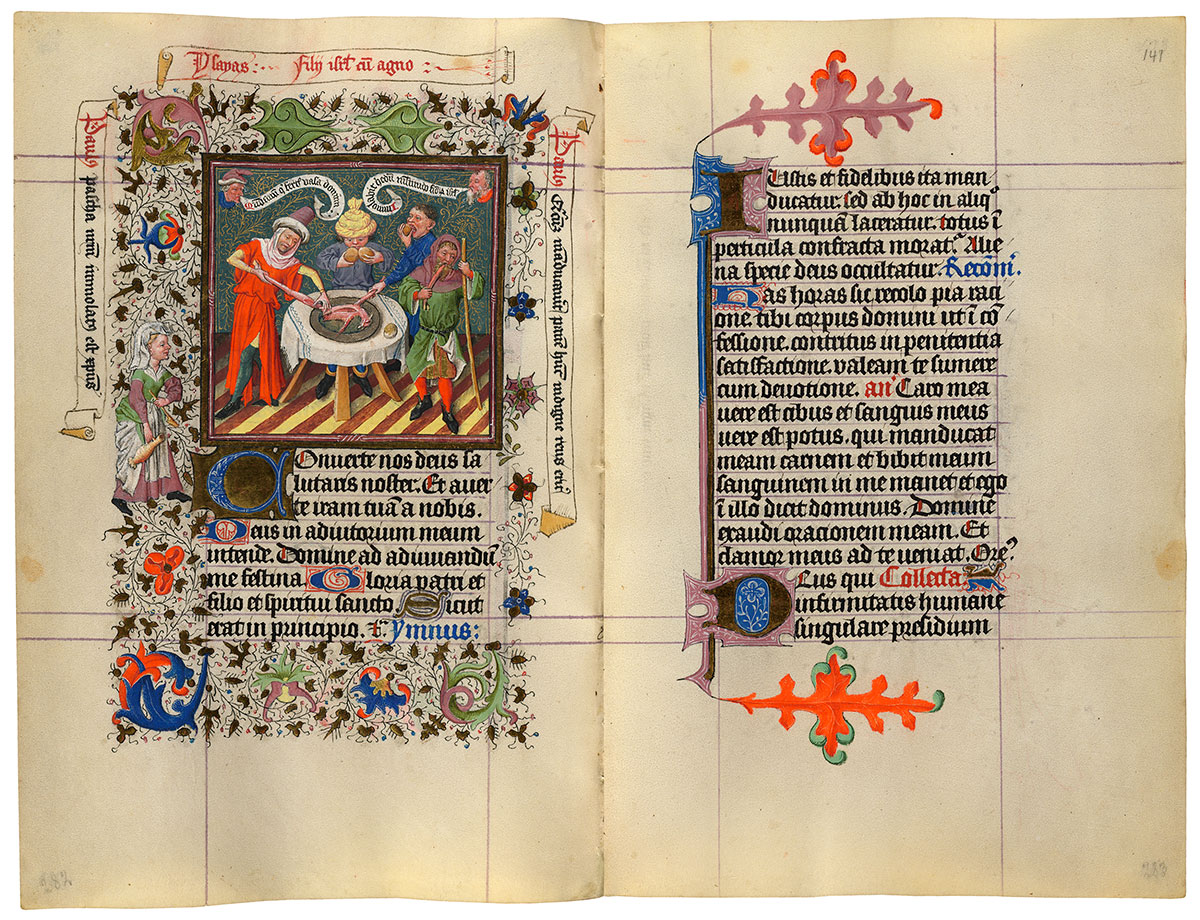
Israelites Eating the Passover Meal
Purchased on the Belle da Costa Greene Fund with the assistance of the Fellows and with special assistance of Mrs. Frederick B. Adams, Sr., Mrs. Robert Charles, Mr. Laurens M. Hamilton, The Heineman Foundation, Mrs. Donald F. Hyde, Mrs. Jacob M. Kaplan, Mrs. John Kean, Mr. Paul Mellon, Mr. and Mrs. Charles F. Morgan, Mr. Lessing J. Rosenwald, Mr. and Mrs. August H. Schilling, Mrs. Herbert N. Straus, Mrs. Landon K. Thorne, Mrs. Alan Valentine, Mr. and Mrs. Arnold Whitridge, and Miss Julia P. Wightman, 1970
The rubric in the top margin, attributed to Isaiah, gives the title to the scene: "The Children of Israel with the Passover Lamb." Four Israelites stand around a table eating lamb and unleavened bread. At the upper left is the head of Isaiah, exhorting (in a quotation from his book, 52:11) cleanliness on the part of those bearing the vessels of the Lord. (His words might explain the woman with the pitcher in the left border.) The head on the right paraphrases Exodus (12:6) that "a young goat should be sacrificed to an assembly of the children of Israel." Two quotations in the side margins from 1 Corinthians (5:7 and 11:27) interpret the Passover lamb as Christ and warn against unworthy Communion.
Hours and Masses for the Seven Days of the Week
The most unusual texts in Catherine's manuscript are the series of Hours and Masses for every day of the week. Medieval Christian tradition associated certain figures or themes with different days. Thus Sunday, the day of the Resurrection, was the Lord's Day; Thursday was connected with the Eucharist since that sacrament was instituted on Holy Thursday; and Monday was the day of the dead, since their torments were suspended on Sunday but recommenced the following day. In Catherine's prayer book, the themes for the Hours and Masses of the seven days of the week are:
| Sunday | the Trinity |
| Monday | the Dead |
| Tuesday | the Holy Spirit |
| Wednesday | All Saints |
| Thursday | the Blessed Sacrament |
| Friday | the Compassion of God |
| Saturday | the Virgin. |
Image courtesy of Faksimile Verlag Luzern
MS M.917/945, ff. 141v–144r
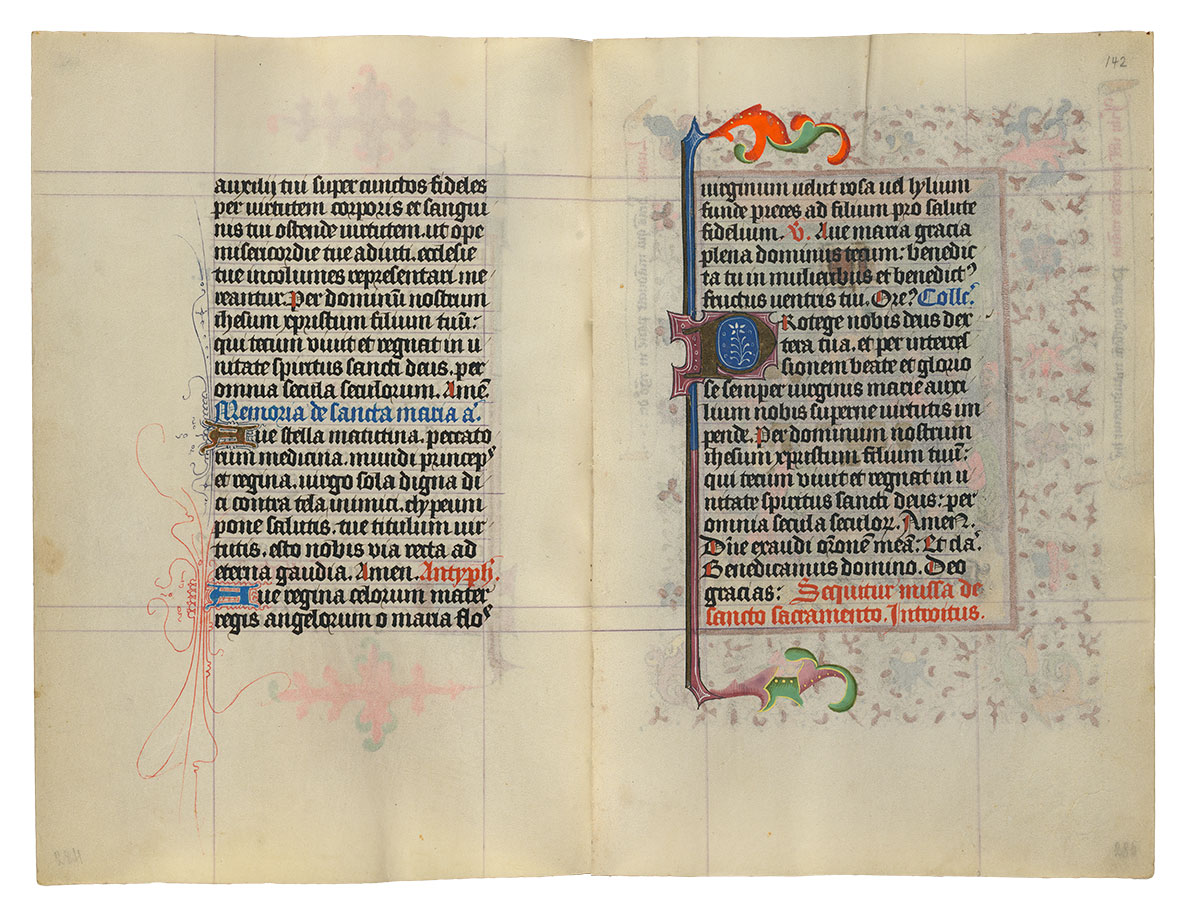
Purchased on the Belle da Costa Greene Fund with the assistance of the Fellows and with special assistance of Mrs. Frederick B. Adams, Sr., Mrs. Robert Charles, Mr. Laurens M. Hamilton, The Heineman Foundation, Mrs. Donald F. Hyde, Mrs. Jacob M. Kaplan, Mrs. John Kean, Mr. Paul Mellon, Mr. and Mrs. Charles F. Morgan, Mr. Lessing J. Rosenwald, Mr. and Mrs. August H. Schilling, Mrs. Herbert N. Straus, Mrs. Landon K. Thorne, Mrs. Alan Valentine, Mr. and Mrs. Arnold Whitridge, and Miss Julia P. Wightman, 1970
Image courtesy of Faksimile Verlag Luzern
MS M.917/945, ff. 142v–143r
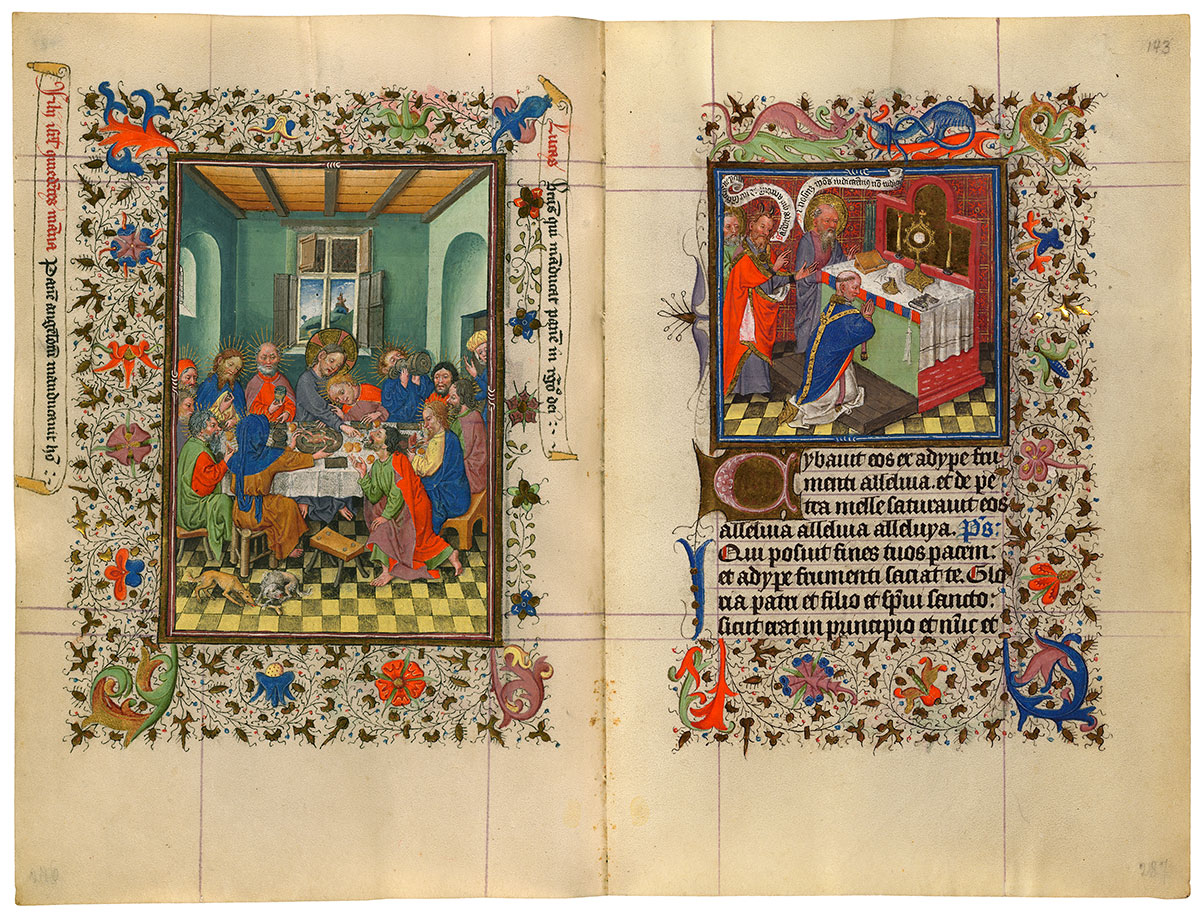
Last Supper
The Celebration of Mass Observed by Moses and St. Paul
Purchased on the Belle da Costa Greene Fund with the assistance of the Fellows and with special assistance of Mrs. Frederick B. Adams, Sr., Mrs. Robert Charles, Mr. Laurens M. Hamilton, The Heineman Foundation, Mrs. Donald F. Hyde, Mrs. Jacob M. Kaplan, Mrs. John Kean, Mr. Paul Mellon, Mr. and Mrs. Charles F. Morgan, Mr. Lessing J. Rosenwald, Mr. and Mrs. August H. Schilling, Mrs. Herbert N. Straus, Mrs. Landon K. Thorne, Mrs. Alan Valentine, Mr. and Mrs. Arnold Whitridge, and Miss Julia P. Wightman, 1970
This large miniature marking the Mass of the Blessed Sacrament illustrates the Last Supper. Christ gives Judas the sop by which he identifies his betrayer; as Judas accepts this, a tiny demon enters his mouth. (John, leaning on the Savior's chest, sleeps through the critical moment, while Peter, to the left of Christ, appears aghast.) Biblical quotations interpret the event. The left one, from Psalms (77:25), refers to the "bread of angels," a phrase applied to the Eucharist. The right quotation, from Luke (14:15), praises those who have eaten bread in the kingdom of God. In the smaller miniature, representing the mystical union of the Old and New Testaments, Moses and St. Paul observe the celebration of Mass.
Hours and Masses for the Seven Days of the Week
The most unusual texts in Catherine's manuscript are the series of Hours and Masses for every day of the week. Medieval Christian tradition associated certain figures or themes with different days. Thus Sunday, the day of the Resurrection, was the Lord's Day; Thursday was connected with the Eucharist since that sacrament was instituted on Holy Thursday; and Monday was the day of the dead, since their torments were suspended on Sunday but recommenced the following day. In Catherine's prayer book, the themes for the Hours and Masses of the seven days of the week are:
| Sunday | the Trinity |
| Monday | the Dead |
| Tuesday | the Holy Spirit |
| Wednesday | All Saints |
| Thursday | the Blessed Sacrament |
| Friday | the Compassion of God |
| Saturday | the Virgin. |
Image courtesy of Faksimile Verlag Luzern
MS M.917/945, ff. 143v–144r
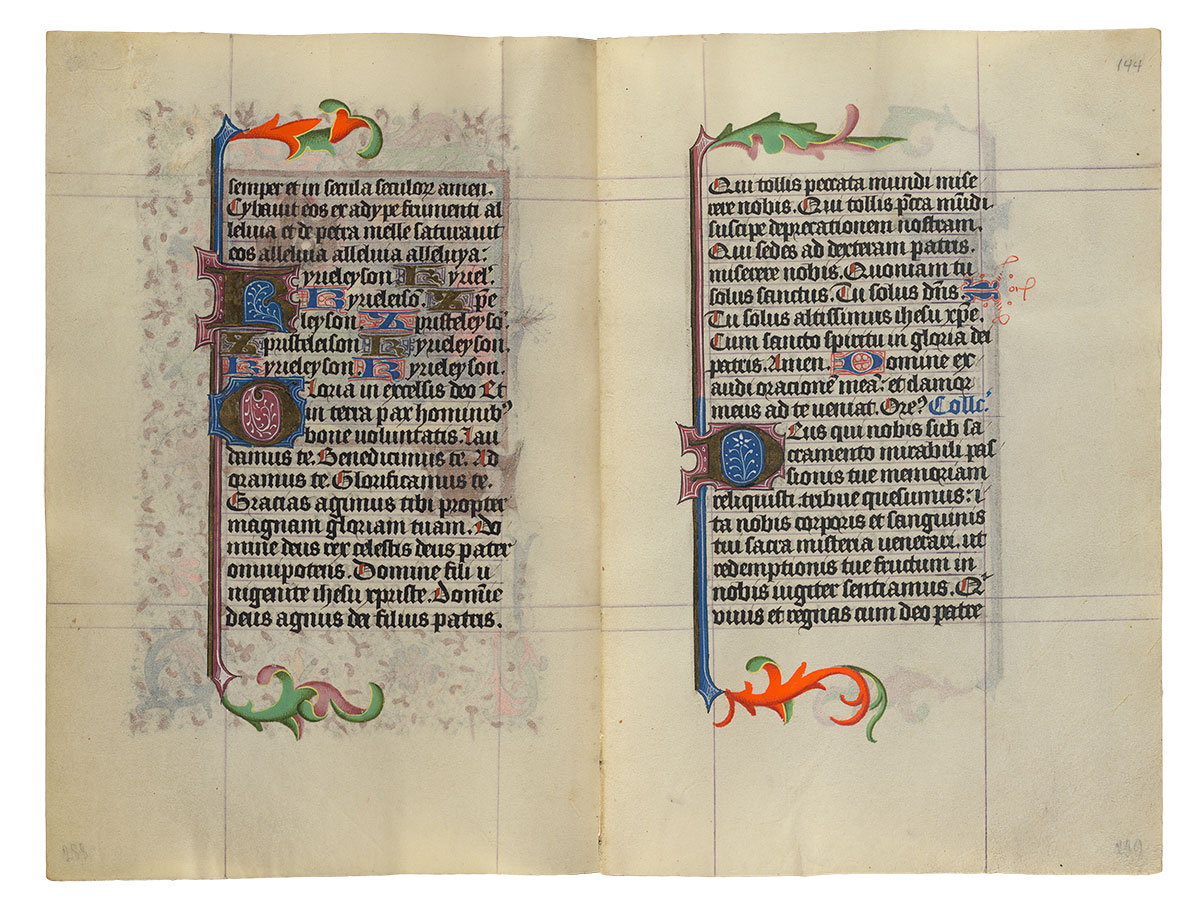
Purchased on the Belle da Costa Greene Fund with the assistance of the Fellows and with special assistance of Mrs. Frederick B. Adams, Sr., Mrs. Robert Charles, Mr. Laurens M. Hamilton, The Heineman Foundation, Mrs. Donald F. Hyde, Mrs. Jacob M. Kaplan, Mrs. John Kean, Mr. Paul Mellon, Mr. and Mrs. Charles F. Morgan, Mr. Lessing J. Rosenwald, Mr. and Mrs. August H. Schilling, Mrs. Herbert N. Straus, Mrs. Landon K. Thorne, Mrs. Alan Valentine, Mr. and Mrs. Arnold Whitridge, and Miss Julia P. Wightman, 1970
Image courtesy of Faksimile Verlag Luzern
MS M.917/945, ff. 144v–145r
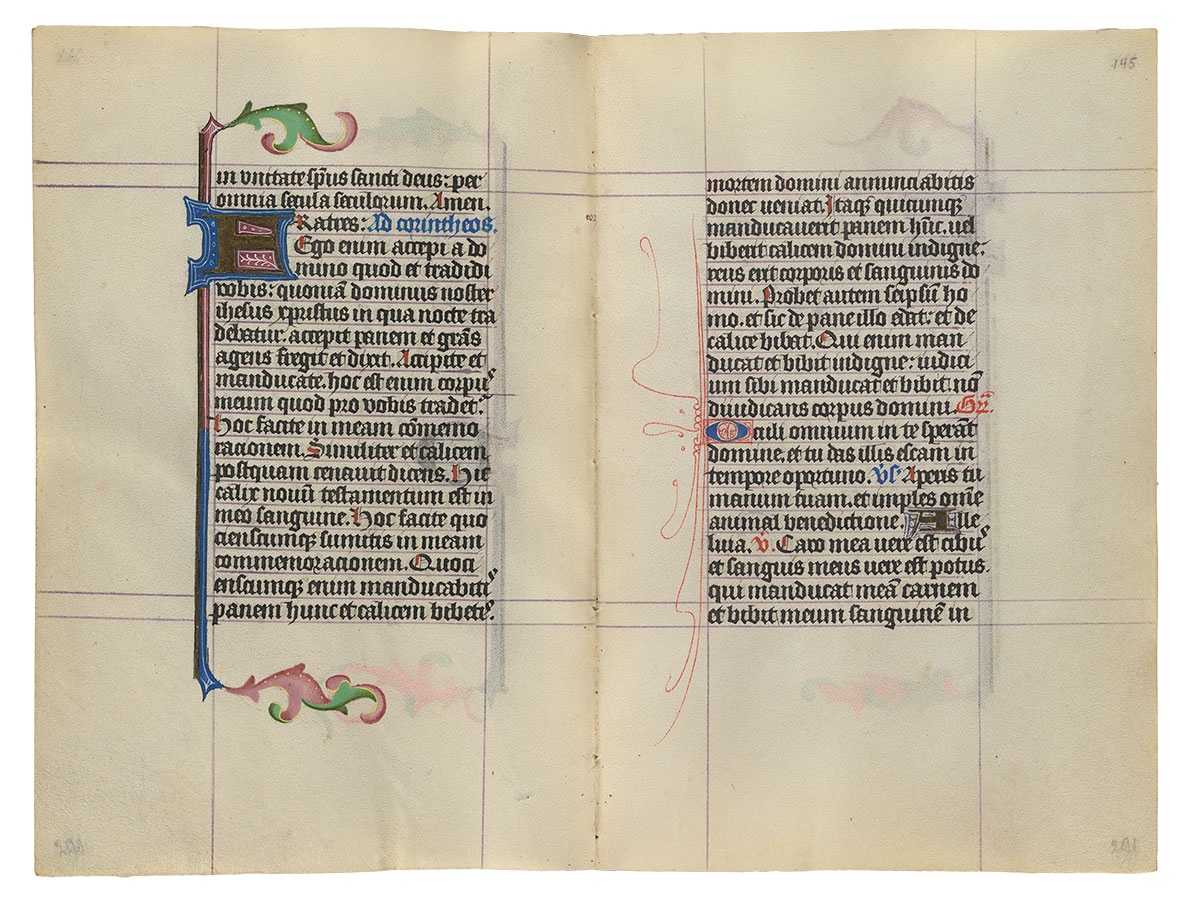
Purchased on the Belle da Costa Greene Fund with the assistance of the Fellows and with special assistance of Mrs. Frederick B. Adams, Sr., Mrs. Robert Charles, Mr. Laurens M. Hamilton, The Heineman Foundation, Mrs. Donald F. Hyde, Mrs. Jacob M. Kaplan, Mrs. John Kean, Mr. Paul Mellon, Mr. and Mrs. Charles F. Morgan, Mr. Lessing J. Rosenwald, Mr. and Mrs. August H. Schilling, Mrs. Herbert N. Straus, Mrs. Landon K. Thorne, Mrs. Alan Valentine, Mr. and Mrs. Arnold Whitridge, and Miss Julia P. Wightman, 1970
Image courtesy of Faksimile Verlag Luzern
MS M.917/945, ff. 145v–146r
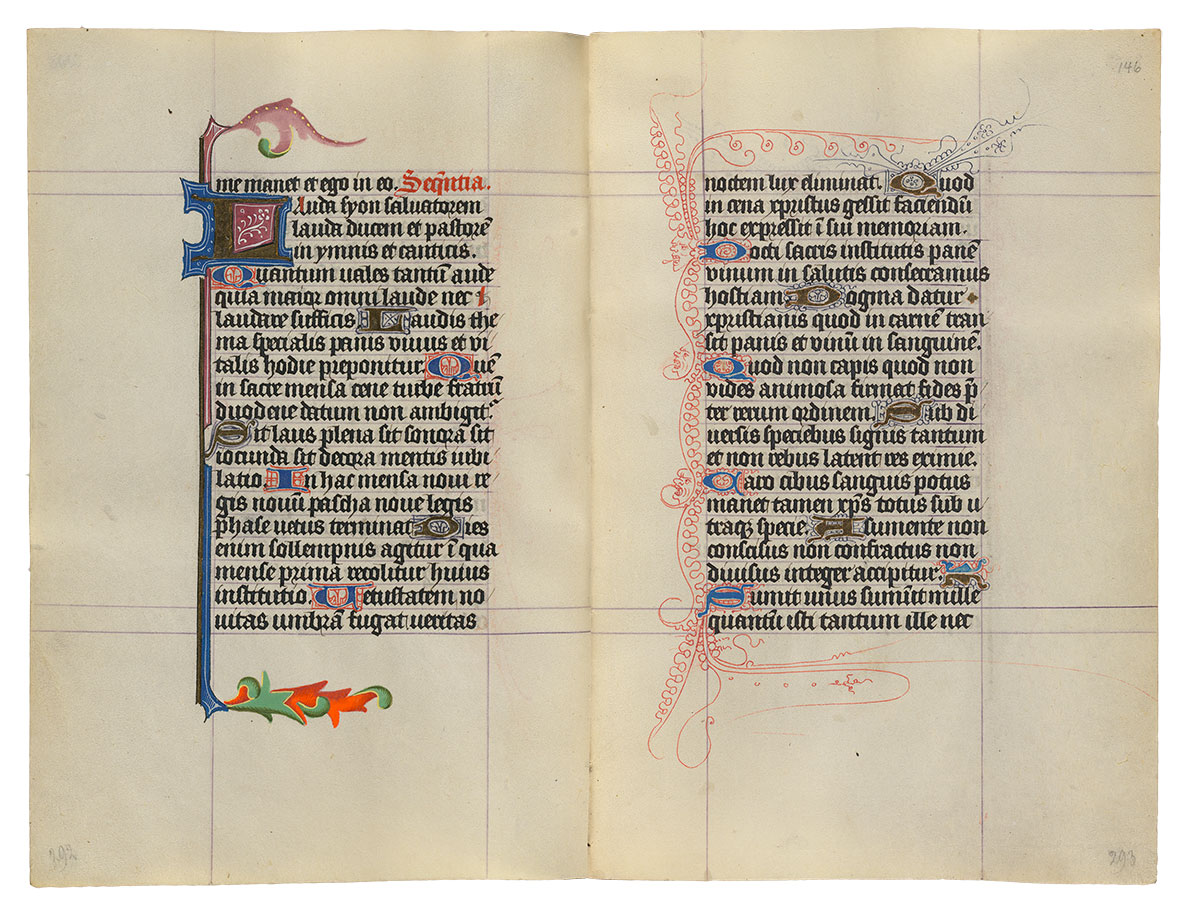
Purchased on the Belle da Costa Greene Fund with the assistance of the Fellows and with special assistance of Mrs. Frederick B. Adams, Sr., Mrs. Robert Charles, Mr. Laurens M. Hamilton, The Heineman Foundation, Mrs. Donald F. Hyde, Mrs. Jacob M. Kaplan, Mrs. John Kean, Mr. Paul Mellon, Mr. and Mrs. Charles F. Morgan, Mr. Lessing J. Rosenwald, Mr. and Mrs. August H. Schilling, Mrs. Herbert N. Straus, Mrs. Landon K. Thorne, Mrs. Alan Valentine, Mr. and Mrs. Arnold Whitridge, and Miss Julia P. Wightman, 1970
Image courtesy of Faksimile Verlag Luzern
MS M.917/945, ff. 146v–147r
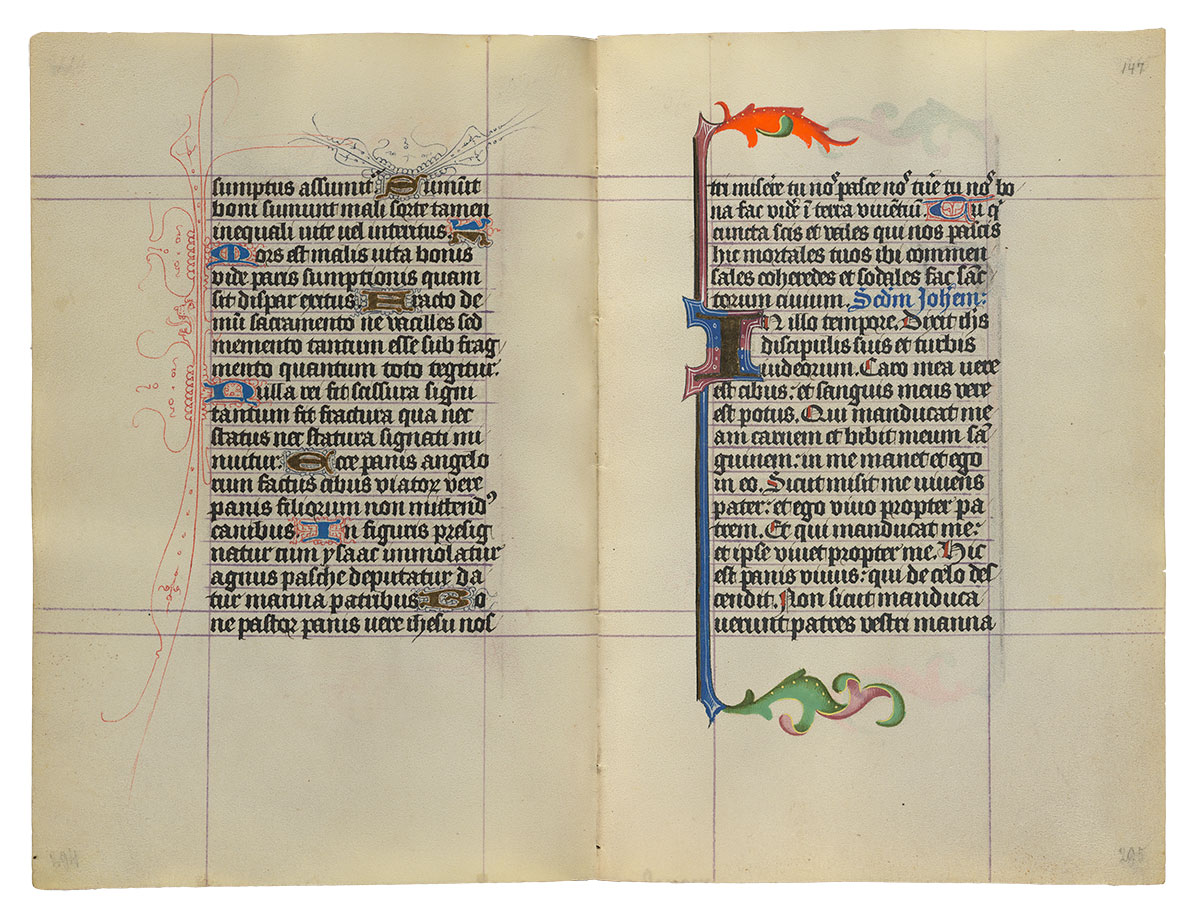
Purchased on the Belle da Costa Greene Fund with the assistance of the Fellows and with special assistance of Mrs. Frederick B. Adams, Sr., Mrs. Robert Charles, Mr. Laurens M. Hamilton, The Heineman Foundation, Mrs. Donald F. Hyde, Mrs. Jacob M. Kaplan, Mrs. John Kean, Mr. Paul Mellon, Mr. and Mrs. Charles F. Morgan, Mr. Lessing J. Rosenwald, Mr. and Mrs. August H. Schilling, Mrs. Herbert N. Straus, Mrs. Landon K. Thorne, Mrs. Alan Valentine, Mr. and Mrs. Arnold Whitridge, and Miss Julia P. Wightman, 1970
Image courtesy of Faksimile Verlag Luzern
MS M.917/945, ff. 147v–148r
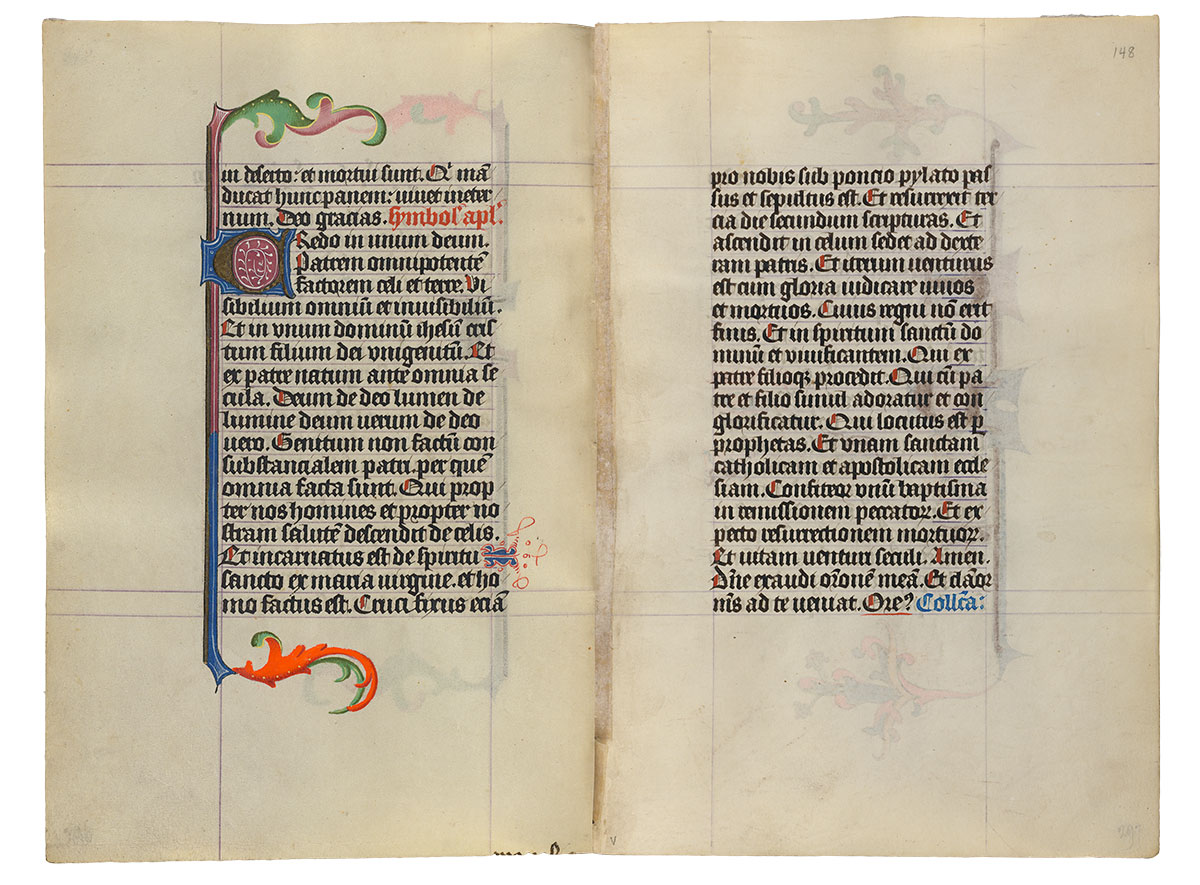
Purchased on the Belle da Costa Greene Fund with the assistance of the Fellows and with special assistance of Mrs. Frederick B. Adams, Sr., Mrs. Robert Charles, Mr. Laurens M. Hamilton, The Heineman Foundation, Mrs. Donald F. Hyde, Mrs. Jacob M. Kaplan, Mrs. John Kean, Mr. Paul Mellon, Mr. and Mrs. Charles F. Morgan, Mr. Lessing J. Rosenwald, Mr. and Mrs. August H. Schilling, Mrs. Herbert N. Straus, Mrs. Landon K. Thorne, Mrs. Alan Valentine, Mr. and Mrs. Arnold Whitridge, and Miss Julia P. Wightman, 1970
Image courtesy of Faksimile Verlag Luzern
MS M.917/945, ff. 148v–149r
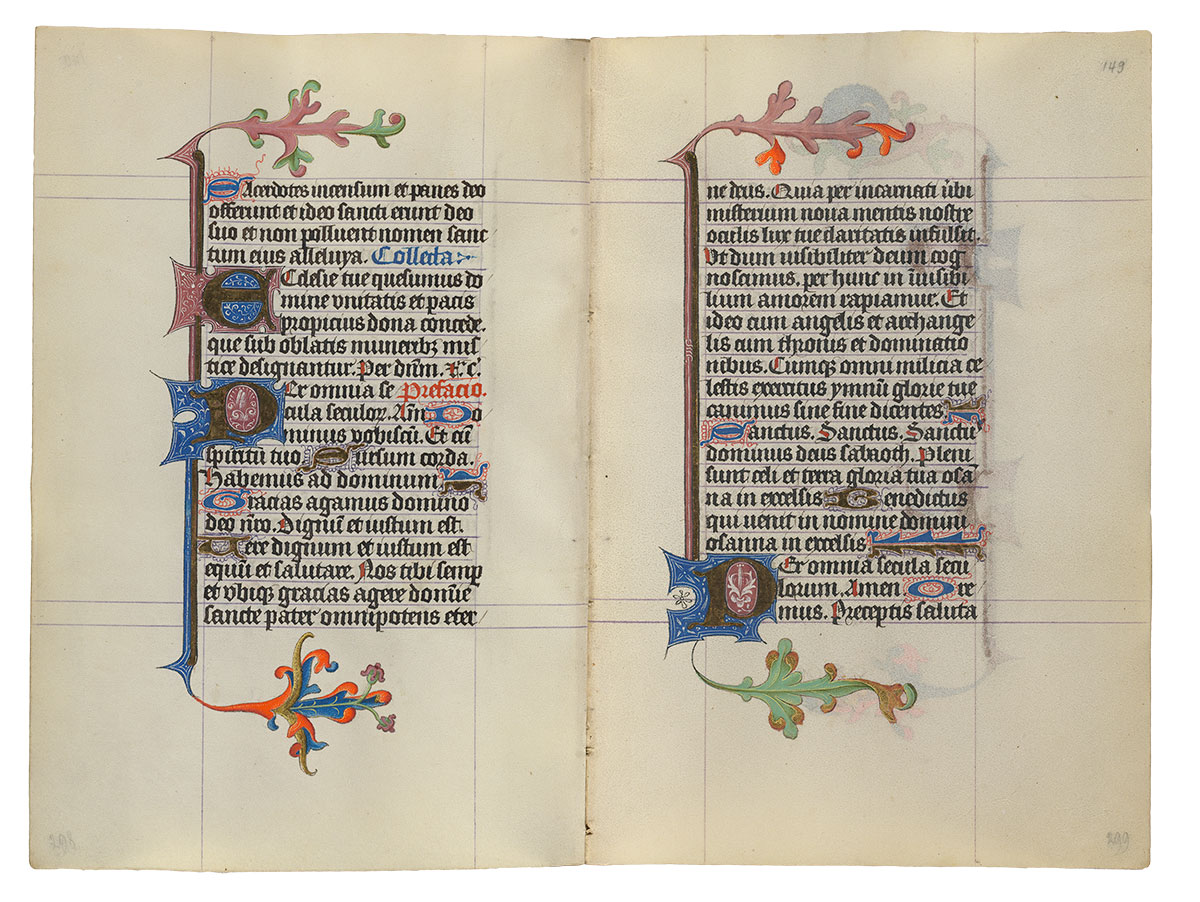
Purchased on the Belle da Costa Greene Fund with the assistance of the Fellows and with special assistance of Mrs. Frederick B. Adams, Sr., Mrs. Robert Charles, Mr. Laurens M. Hamilton, The Heineman Foundation, Mrs. Donald F. Hyde, Mrs. Jacob M. Kaplan, Mrs. John Kean, Mr. Paul Mellon, Mr. and Mrs. Charles F. Morgan, Mr. Lessing J. Rosenwald, Mr. and Mrs. August H. Schilling, Mrs. Herbert N. Straus, Mrs. Landon K. Thorne, Mrs. Alan Valentine, Mr. and Mrs. Arnold Whitridge, and Miss Julia P. Wightman, 1970
Image courtesy of Faksimile Verlag Luzern
MS M.917/945, ff. 149v–150r
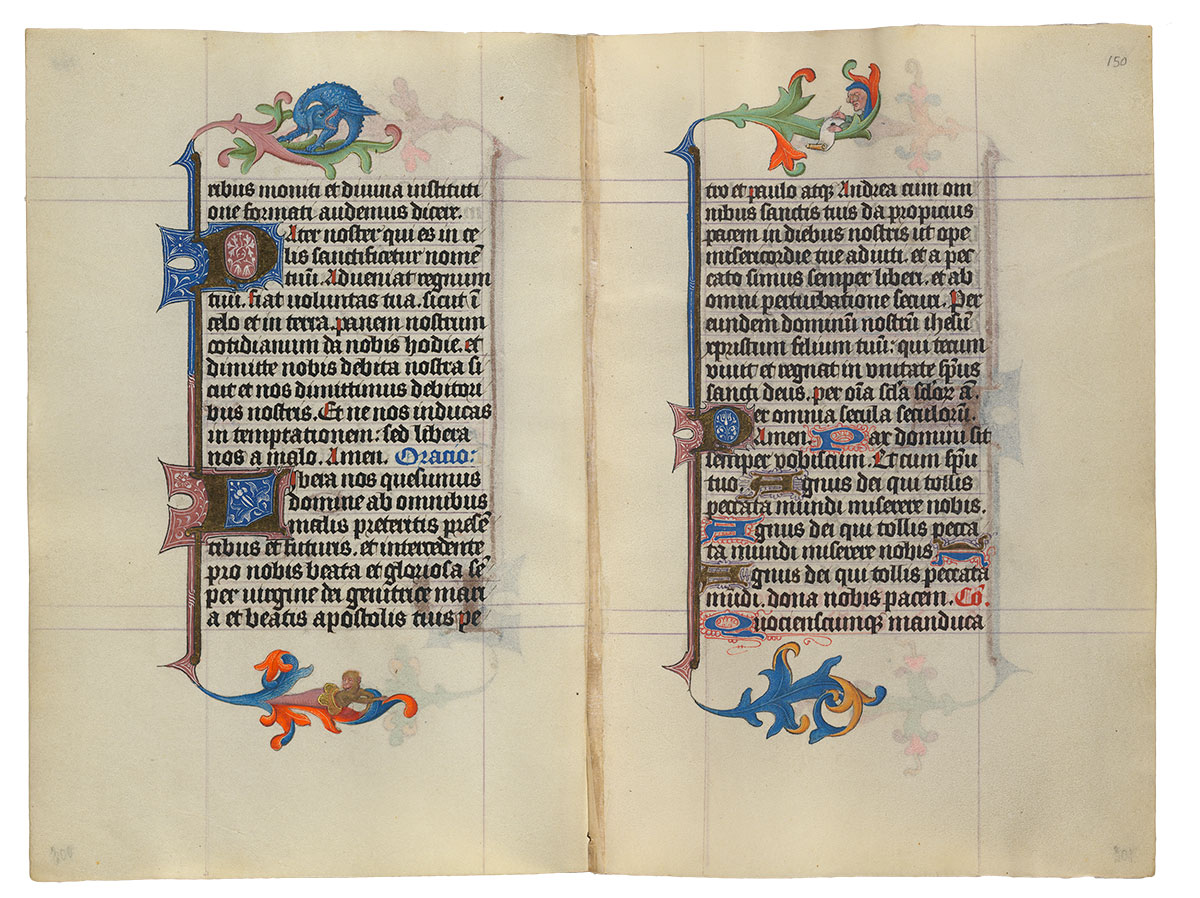
Purchased on the Belle da Costa Greene Fund with the assistance of the Fellows and with special assistance of Mrs. Frederick B. Adams, Sr., Mrs. Robert Charles, Mr. Laurens M. Hamilton, The Heineman Foundation, Mrs. Donald F. Hyde, Mrs. Jacob M. Kaplan, Mrs. John Kean, Mr. Paul Mellon, Mr. and Mrs. Charles F. Morgan, Mr. Lessing J. Rosenwald, Mr. and Mrs. August H. Schilling, Mrs. Herbert N. Straus, Mrs. Landon K. Thorne, Mrs. Alan Valentine, Mr. and Mrs. Arnold Whitridge, and Miss Julia P. Wightman, 1970
Image courtesy of Faksimile Verlag Luzern
MS M.917/945, f. 150v–p. 75
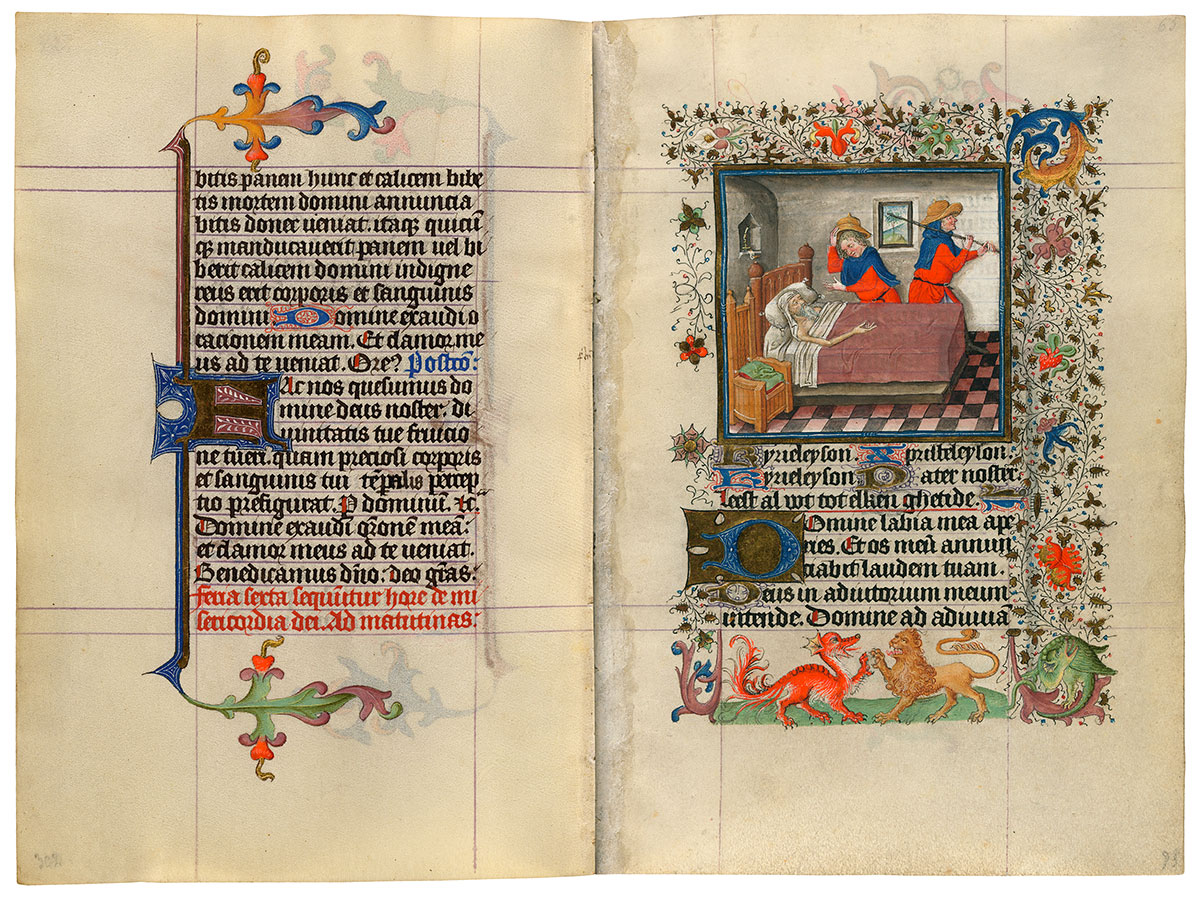
The Dying Adam Dispatching Seth to Paradise
Purchased on the Belle da Costa Greene Fund with the assistance of the Fellows and with special assistance of Mrs. Frederick B. Adams, Sr., Mrs. Robert Charles, Mr. Laurens M. Hamilton, The Heineman Foundation, Mrs. Donald F. Hyde, Mrs. Jacob M. Kaplan, Mrs. John Kean, Mr. Paul Mellon, Mr. and Mrs. Charles F. Morgan, Mr. Lessing J. Rosenwald, Mr. and Mrs. August H. Schilling, Mrs. Herbert N. Straus, Mrs. Landon K. Thorne, Mrs. Alan Valentine, Mr. and Mrs. Arnold Whitridge, and Miss Julia P. Wightman, 1970; purchased on the Belle da Costa Greene Fund with the assistance of the Fellows, 1963
The rare Friday Hours of the Compassion of God plus the Mass of the Holy Cross are illustrated with a series of nine images, all of which are exhibited here. (Two introductory large miniatures for the Hours and the Mass are missing.) The iconography of the medieval legend of the True Cross offers an imaginative link—physical and metaphysical—between Adam and Christ and between terrestrial and celestial Paradise. The cycle begins with a remorseful Adam, on his deathbed, sending his third son, Seth, to the Garden of Eden to fetch a branch of the Tree of Mercy.
Hours and Masses for the Seven Days of the Week
The most unusual texts in Catherine's manuscript are the series of Hours and Masses for every day of the week. Medieval Christian tradition associated certain figures or themes with different days. Thus Sunday, the day of the Resurrection, was the Lord's Day; Thursday was connected with the Eucharist since that sacrament was instituted on Holy Thursday; and Monday was the day of the dead, since their torments were suspended on Sunday but recommenced the following day. In Catherine's prayer book, the themes for the Hours and Masses of the seven days of the week are:
| Sunday | the Trinity |
| Monday | the Dead |
| Tuesday | the Holy Spirit |
| Wednesday | All Saints |
| Thursday | the Blessed Sacrament |
| Friday | the Compassion of God |
| Saturday | the Virgin. |
Image courtesy of Faksimile Verlag Luzern
MS M.917/945, pp. 76–77
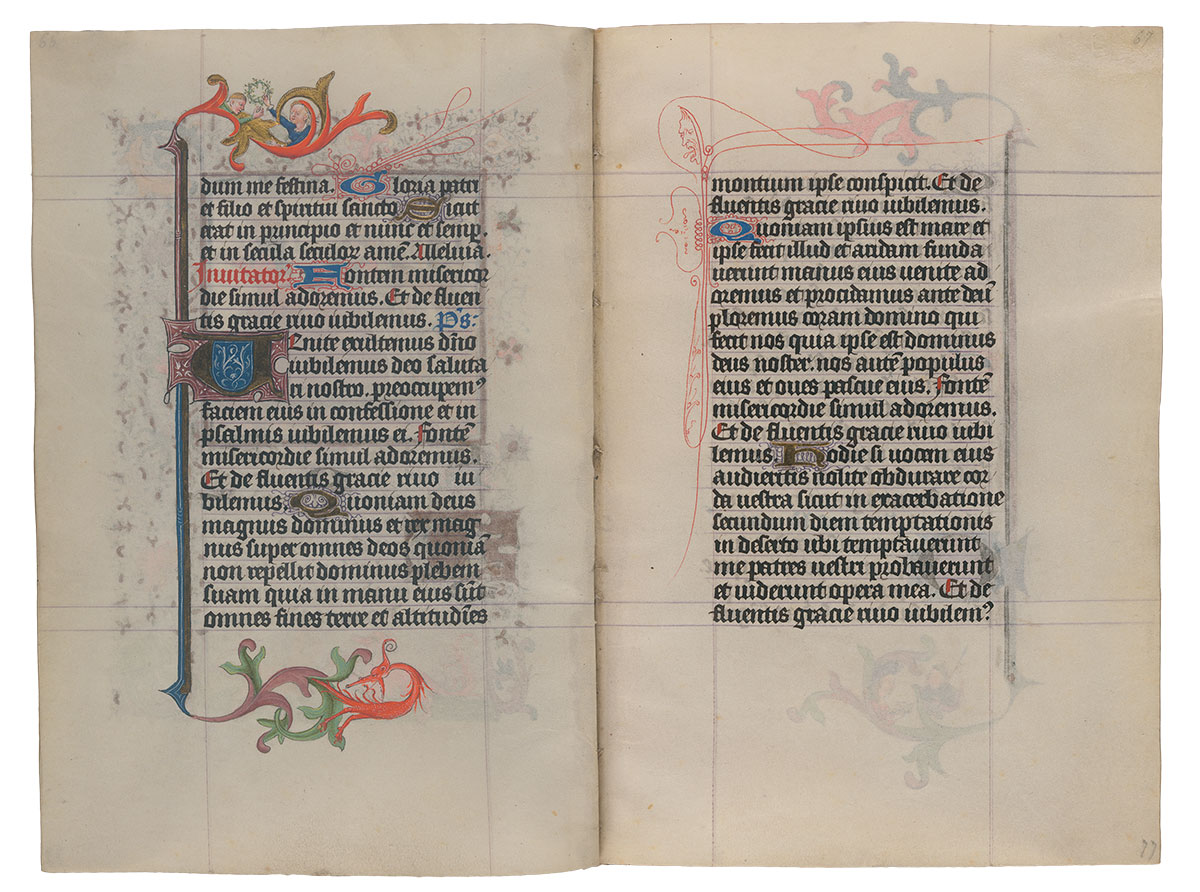
Purchased on the Belle da Costa Greene Fund with the assistance of the Fellows, 1963
Image courtesy of Faksimile Verlag Luzern
MS M.917/945, pp. 78–79
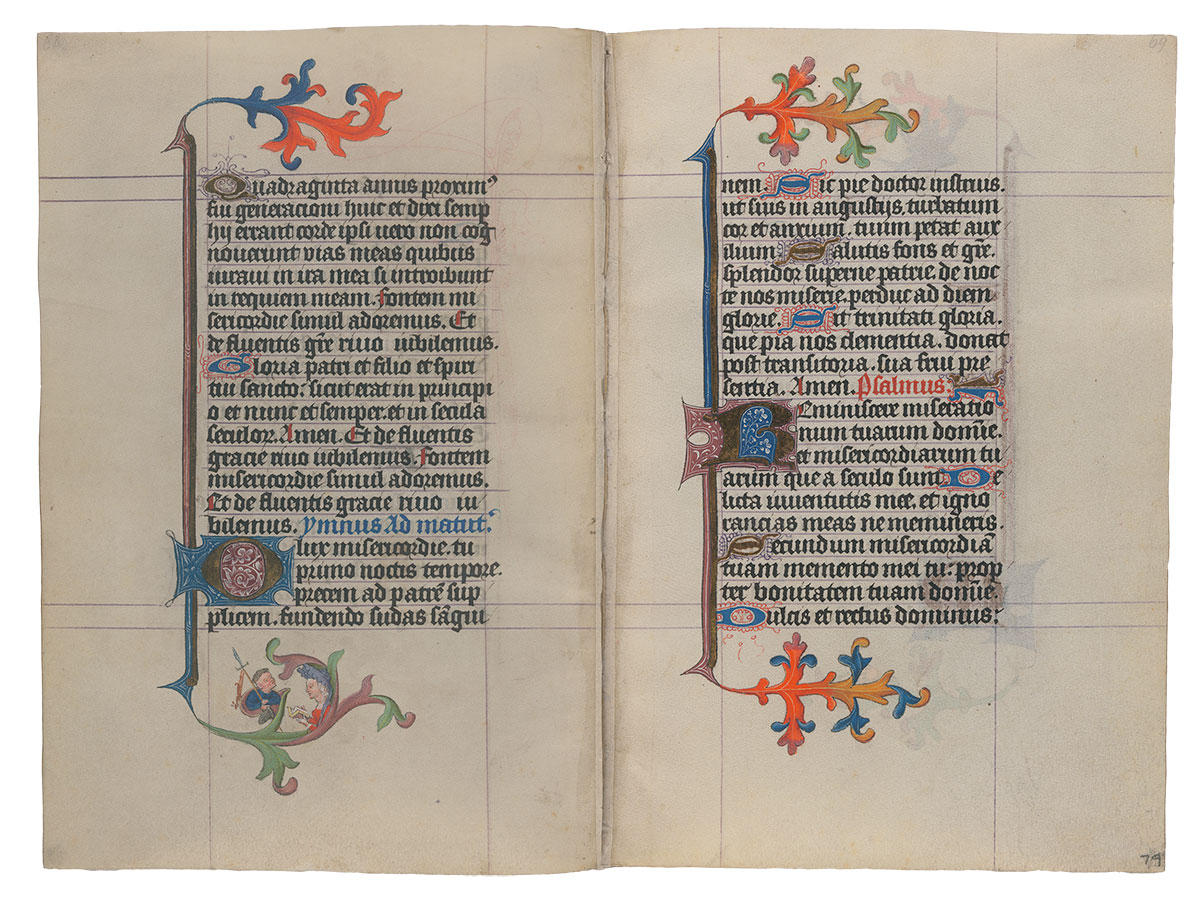
Purchased on the Belle da Costa Greene Fund with the assistance of the Fellows, 1963
Image courtesy of Faksimile Verlag Luzern
MS M.917/945, pp. 80–81
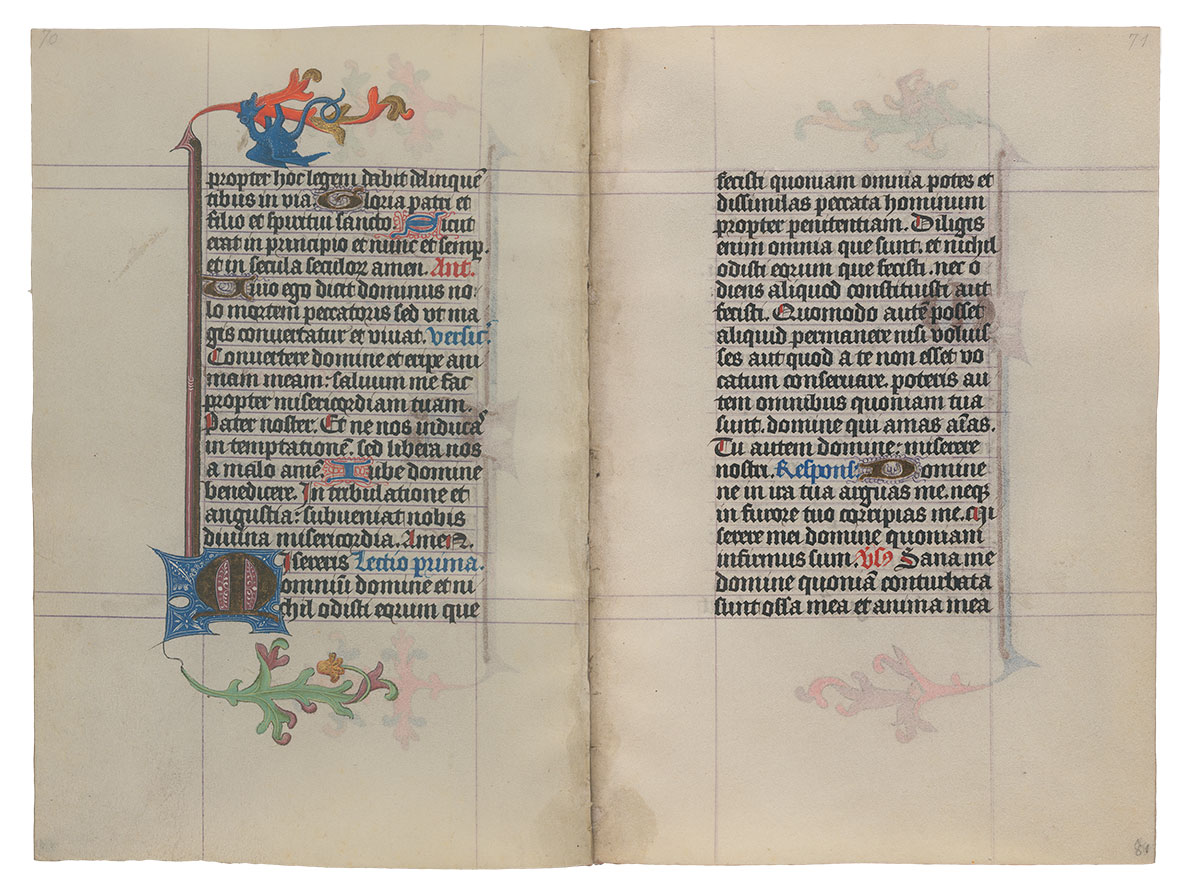
Purchased on the Belle da Costa Greene Fund with the assistance of the Fellows, 1963
Image courtesy of Faksimile Verlag Luzern
MS M.917/945, pp. 82–83

Purchased on the Belle da Costa Greene Fund with the assistance of the Fellows, 1963
Image courtesy of Faksimile Verlag Luzern
MS M.917/945, pp. 84–85

Archangel Michael Giving Seth a Branch from the Tree of Mercy
Purchased on the Belle da Costa Greene Fund with the assistance of the Fellows, 1963
Michael will not allow Seth even a glimpse beyond the golden door into the Garden of Eden, whose verdancy is suggested by towering trees. The archangel does, however, offer Seth the sought-after branch from the Tree of Mercy. The tiny white animal atop the sluice at left could be a tiger, namesake for the River Tigris, from which the four rivers of paradise spring. In the bottom border, Seth's older brothers, Abel and Cain, offer sacrifices to God, whose hand blesses only Abel's lamb.
Hours and Masses for the Seven Days of the Week
The most unusual texts in Catherine's manuscript are the series of Hours and Masses for every day of the week. Medieval Christian tradition associated certain figures or themes with different days. Thus Sunday, the day of the Resurrection, was the Lord's Day; Thursday was connected with the Eucharist since that sacrament was instituted on Holy Thursday; and Monday was the day of the dead, since their torments were suspended on Sunday but recommenced the following day. In Catherine's prayer book, the themes for the Hours and Masses of the seven days of the week are:
| Sunday | the Trinity |
| Monday | the Dead |
| Tuesday | the Holy Spirit |
| Wednesday | All Saints |
| Thursday | the Blessed Sacrament |
| Friday | the Compassion of God |
| Saturday | the Virgin. |
Image courtesy of Faksimile Verlag Luzern
MS M.917/945, pp. 86–87
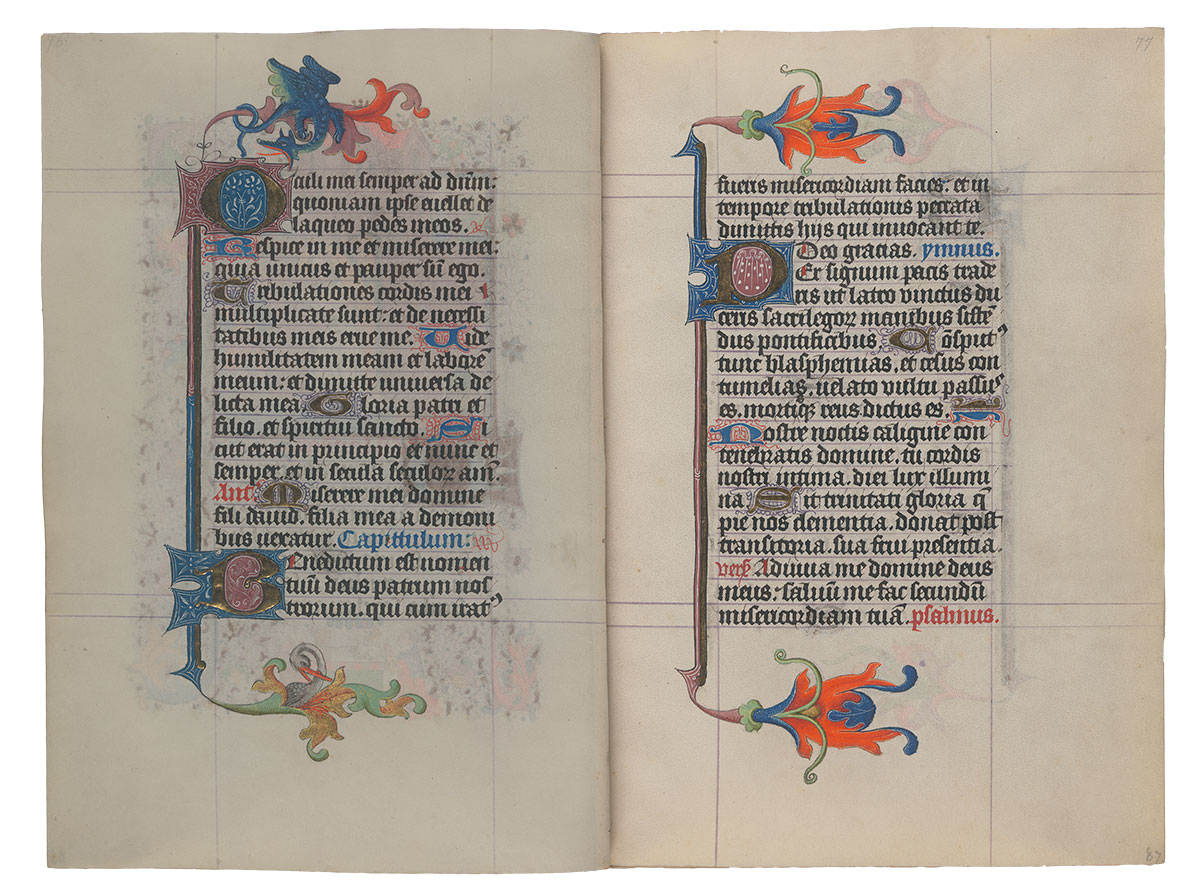
Purchased on the Belle da Costa Greene Fund with the assistance of the Fellows, 1963
Image courtesy of Faksimile Verlag Luzern
MS M.917/945, pp. 88–89
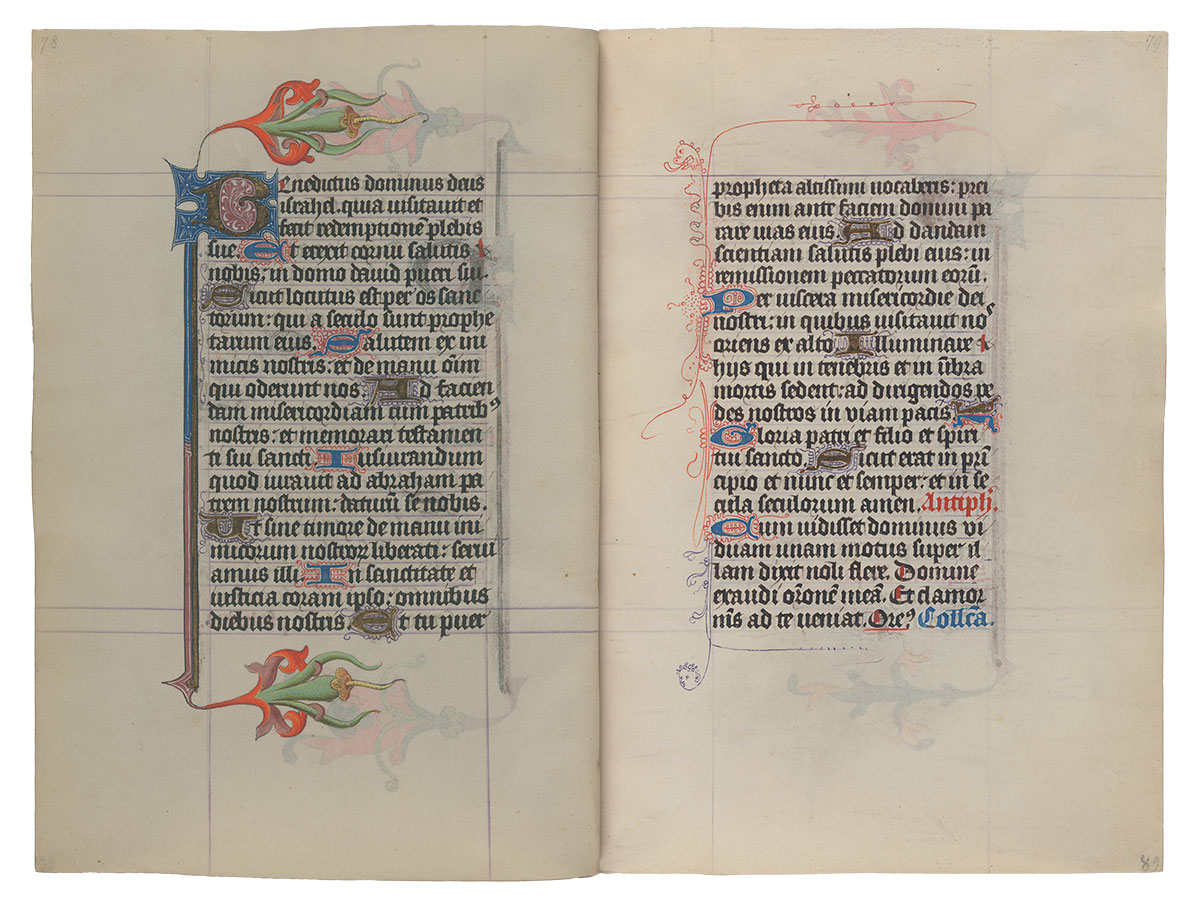
Purchased on the Belle da Costa Greene Fund with the assistance of the Fellows, 1963
Image courtesy of Faksimile Verlag Luzern
MS M.917/945, pp. 90–91
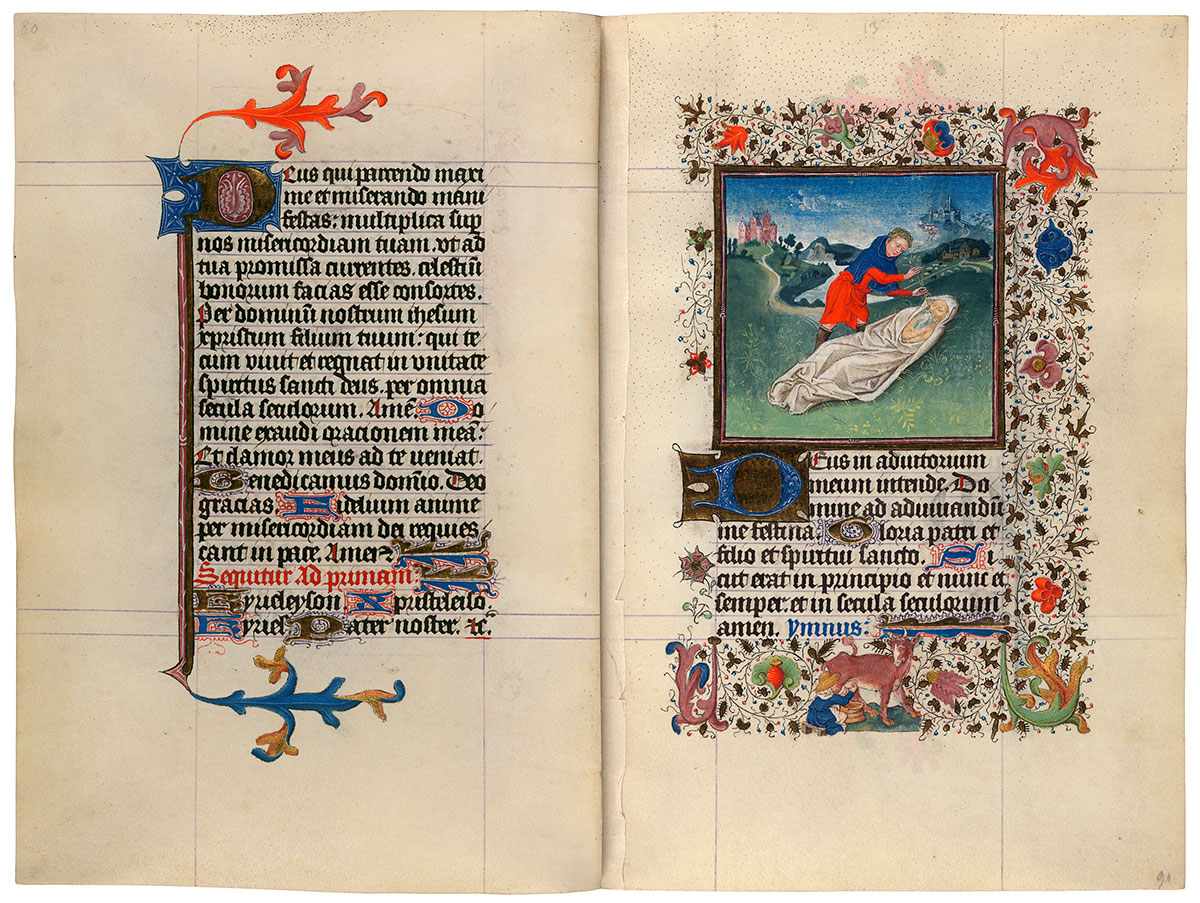
Seth Planting the Branch in the Mouth of the Dead Adam
Purchased on the Belle da Costa Greene Fund with the assistance of the Fellows, 1963
Seth arrives home too late to give his father the consolation he so desired. Adam died in his son's absence (the deep landscape suggests a long return journey). Seth plants the branch from the Tree of Mercy in his father's mouth.
Hours and Masses for the Seven Days of the Week
The most unusual texts in Catherine's manuscript are the series of Hours and Masses for every day of the week. Medieval Christian tradition associated certain figures or themes with different days. Thus Sunday, the day of the Resurrection, was the Lord's Day; Thursday was connected with the Eucharist since that sacrament was instituted on Holy Thursday; and Monday was the day of the dead, since their torments were suspended on Sunday but recommenced the following day. In Catherine's prayer book, the themes for the Hours and Masses of the seven days of the week are:
| Sunday | the Trinity |
| Monday | the Dead |
| Tuesday | the Holy Spirit |
| Wednesday | All Saints |
| Thursday | the Blessed Sacrament |
| Friday | the Compassion of God |
| Saturday | the Virgin. |
Image courtesy of Faksimile Verlag Luzern
MS M.917/945, pp. 92–93
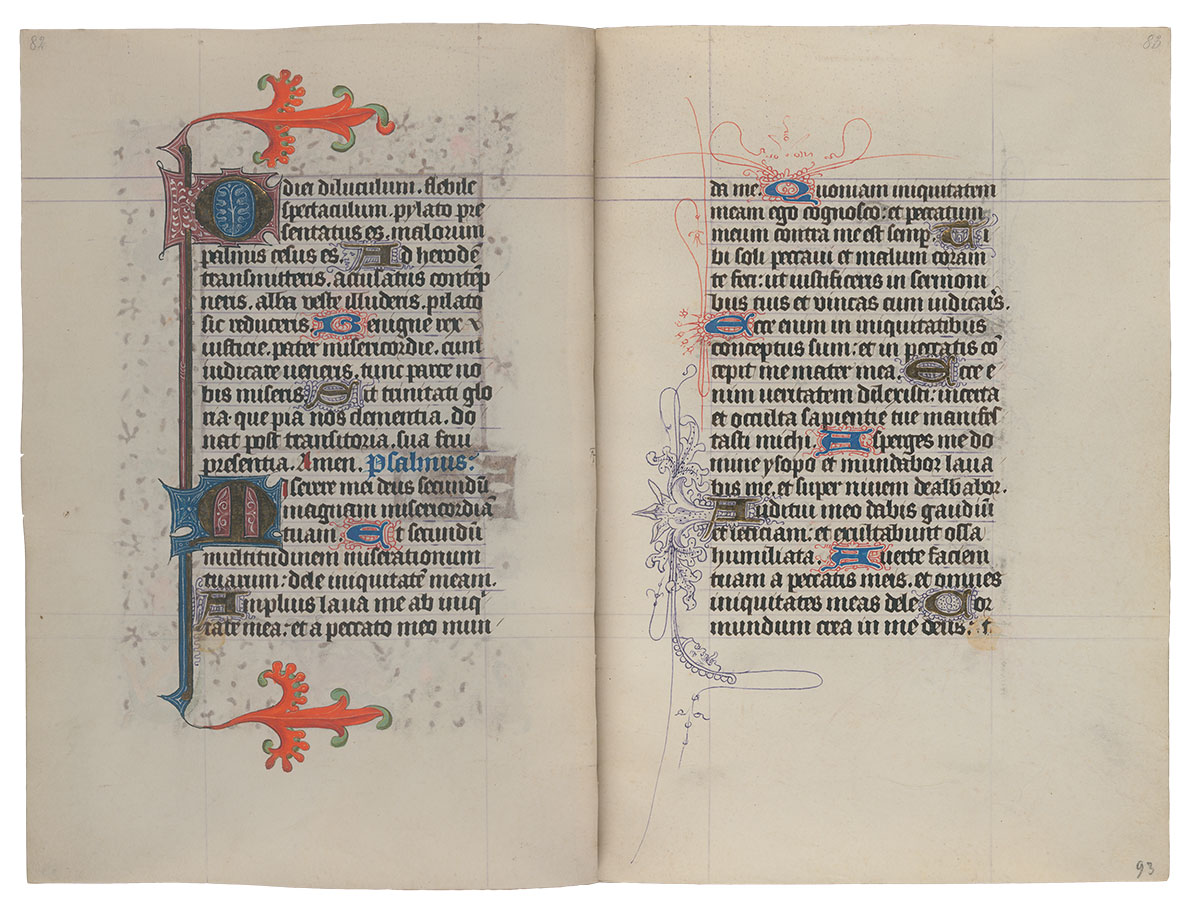
Purchased on the Belle da Costa Greene Fund with the assistance of the Fellows, 1963
Image courtesy of Faksimile Verlag Luzern
MS M.917/945, pp. 94–95
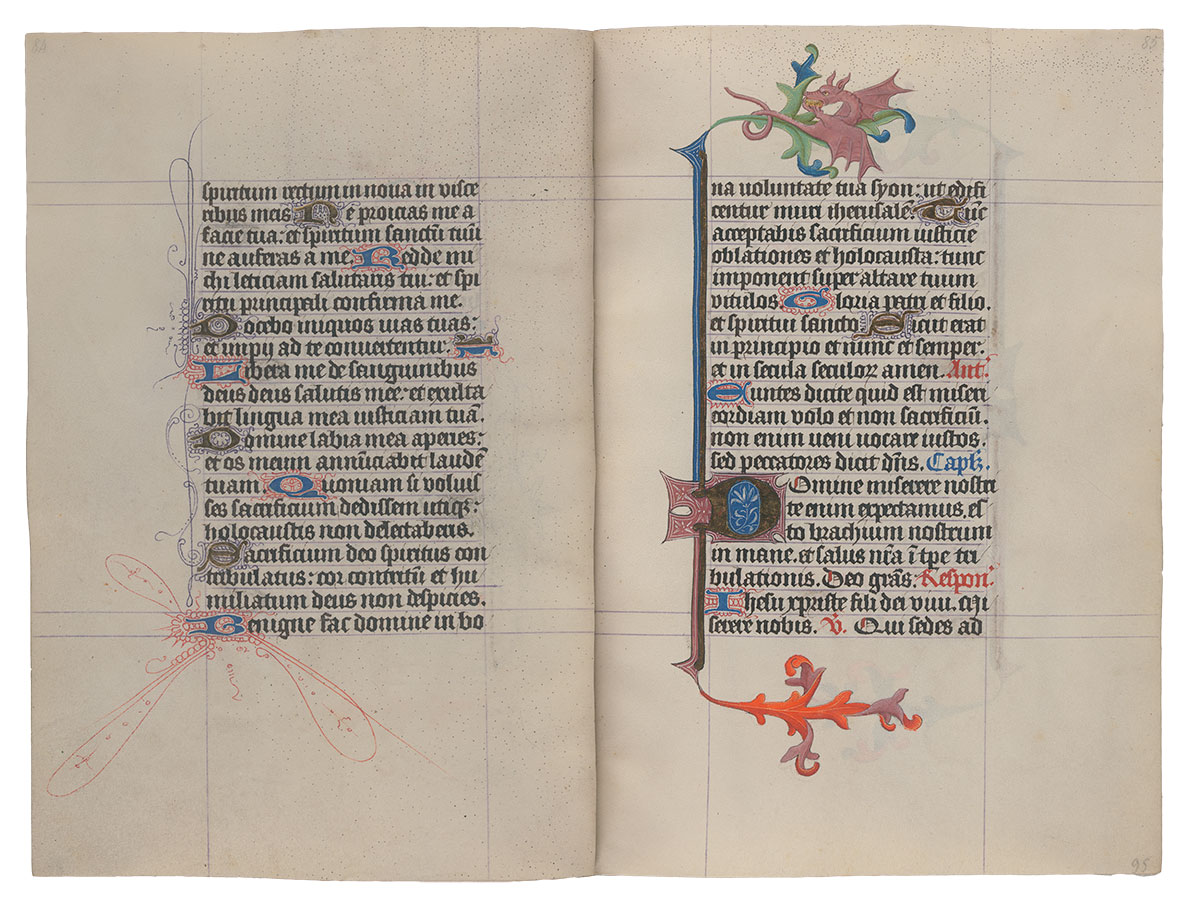
Purchased on the Belle da Costa Greene Fund with the assistance of the Fellows, 1963
Image courtesy of Faksimile Verlag Luzern
MS M.917/945, pp. 96–97
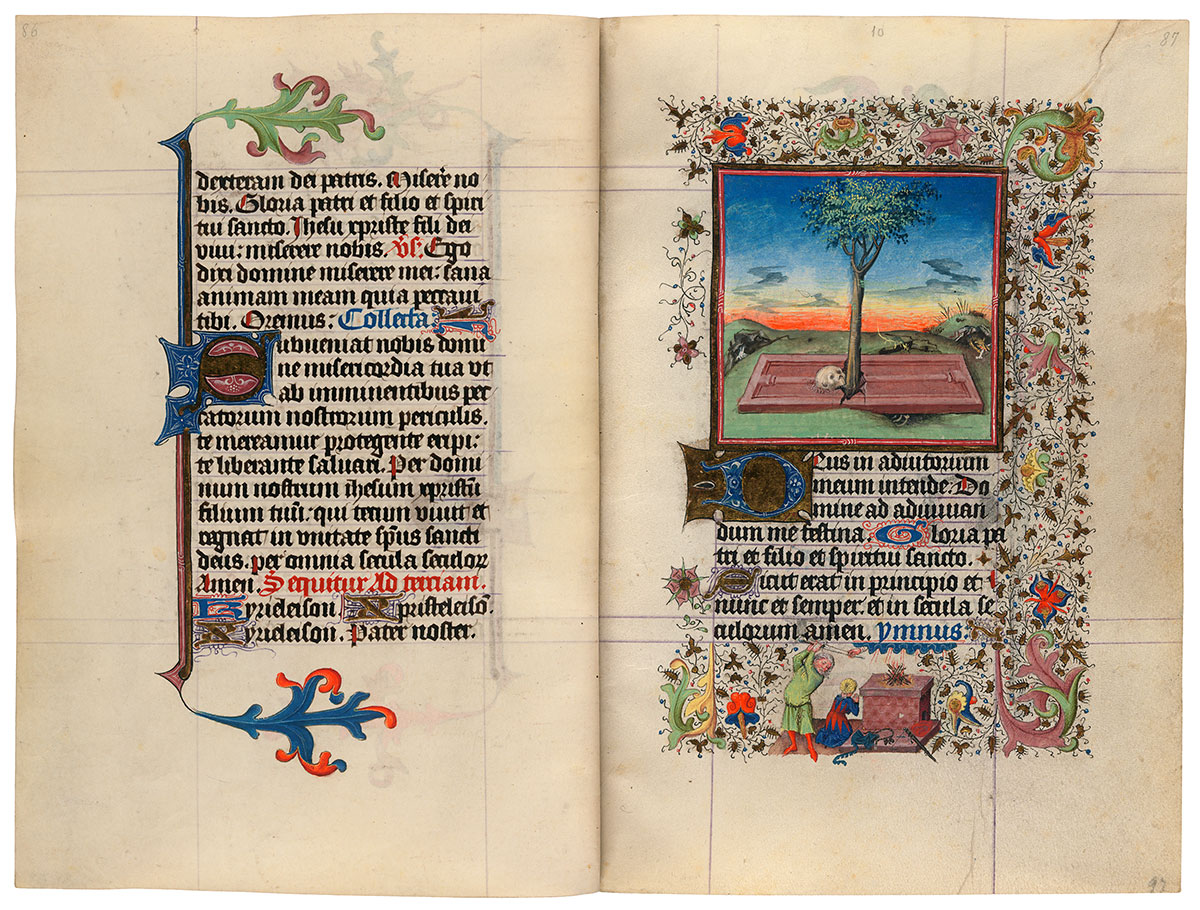
Tree Growing from Adam’s Grave
Purchased on the Belle da Costa Greene Fund with the assistance of the Fellows, 1963
Having taken root, the branch from the Tree of Mercy planted by Seth in his father's mouth grows into a healthy tree. It breaks through the slab covering Adam's grave, raising his skull in the process. The horizon glows orange: symbolically a new day has dawned. In the bottom border is depicted the sacrifice of Abraham. The patriarch's willingness to kill his son Isaac (a sacrifice stopped, as we see here, by the hand of God) symbolizes God's willingness to sacrifice his son, Christ, on the Cross. The vignette thus hints at the future of the tree painted above it in the miniature.
Hours and Masses for the Seven Days of the Week
The most unusual texts in Catherine's manuscript are the series of Hours and Masses for every day of the week. Medieval Christian tradition associated certain figures or themes with different days. Thus Sunday, the day of the Resurrection, was the Lord's Day; Thursday was connected with the Eucharist since that sacrament was instituted on Holy Thursday; and Monday was the day of the dead, since their torments were suspended on Sunday but recommenced the following day. In Catherine's prayer book, the themes for the Hours and Masses of the seven days of the week are:
| Sunday | the Trinity |
| Monday | the Dead |
| Tuesday | the Holy Spirit |
| Wednesday | All Saints |
| Thursday | the Blessed Sacrament |
| Friday | the Compassion of God |
| Saturday | the Virgin. |
Image courtesy of Faksimile Verlag Luzern
MS M.917/945, pp. 98–99
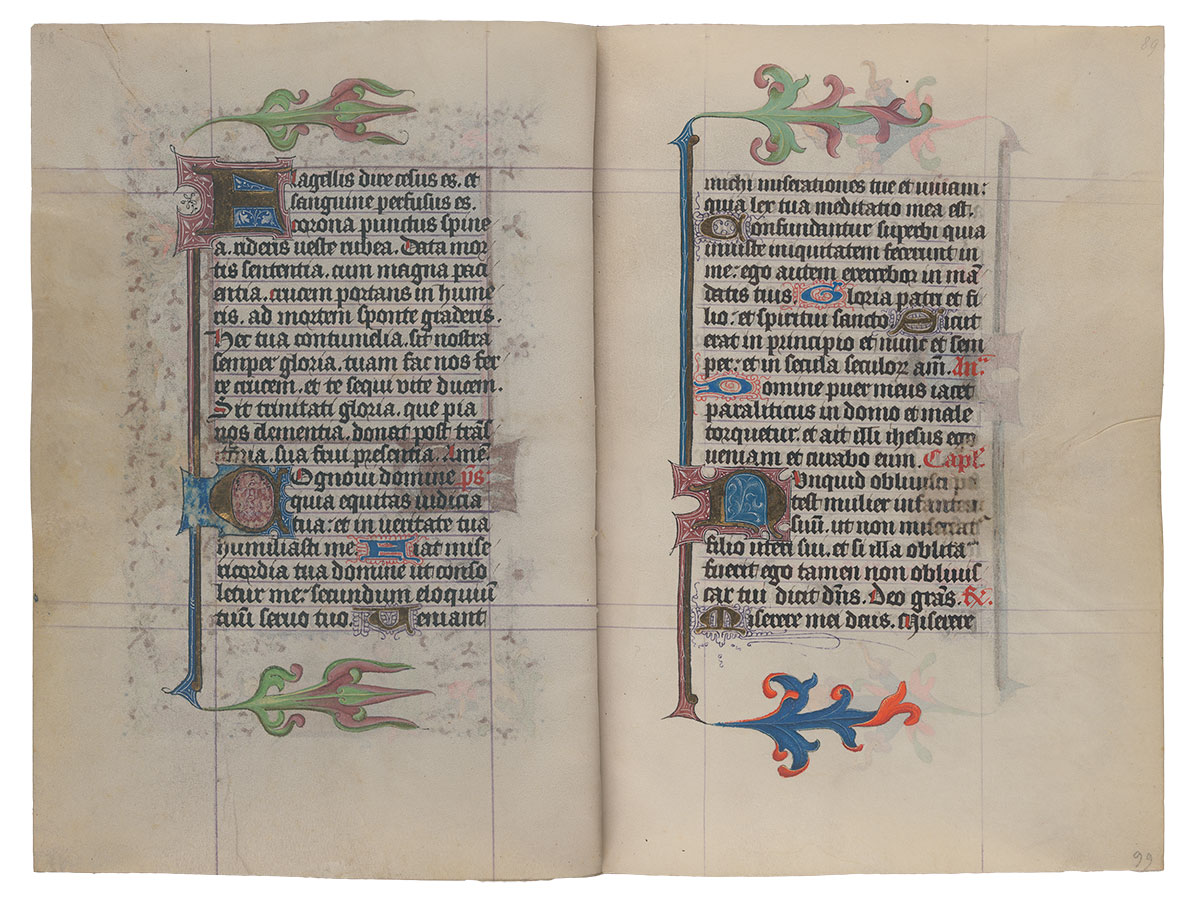
Purchased on the Belle da Costa Greene Fund with the assistance of the Fellows, 1963
Image courtesy of Faksimile Verlag Luzern
MS M.917/945, pp. 100–101
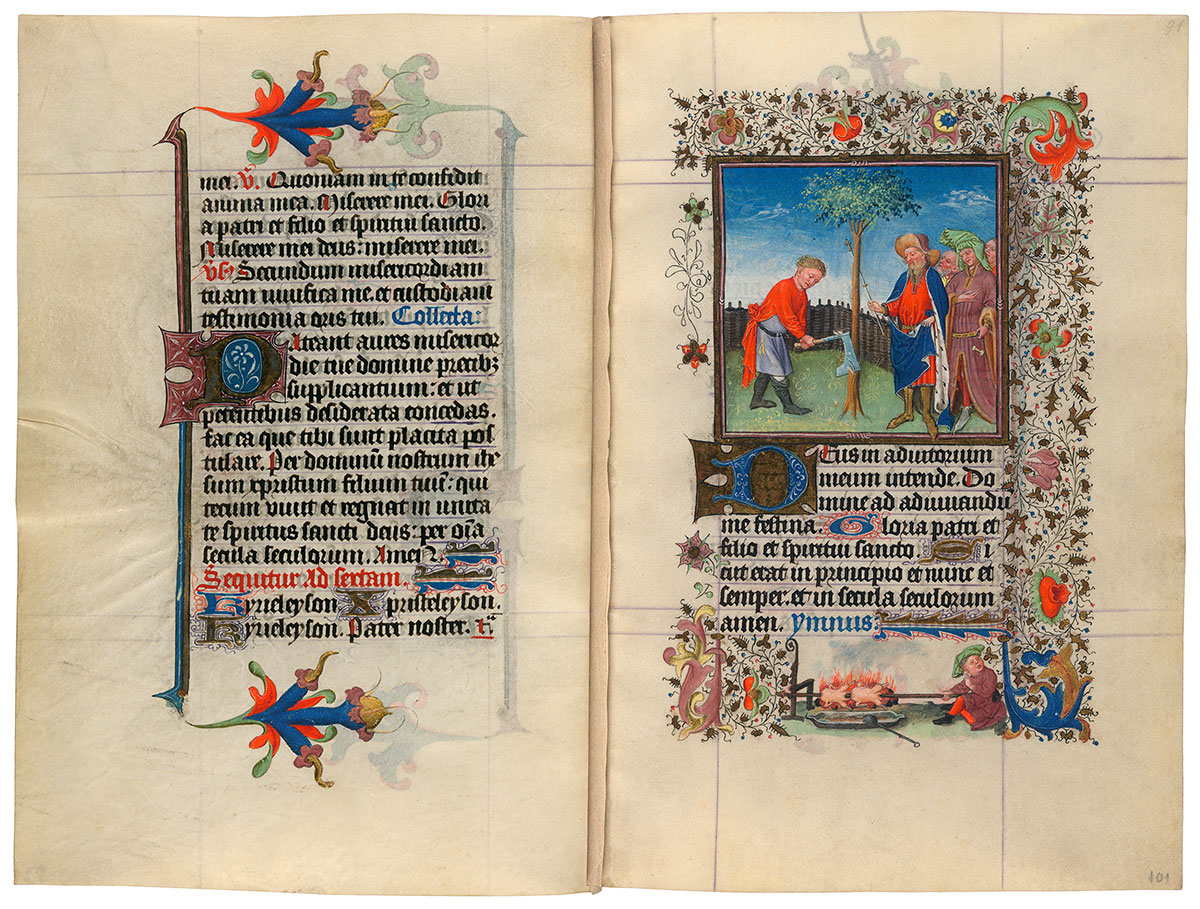
Solomon Ordering the Tree Cut Down
Purchased on the Belle da Costa Greene Fund with the assistance of the Fellows, 1963
With this miniature, the story of the True Cross flashes forward. Solomon, in preparation for building the Temple of Jerusalem, orders the tree chopped down. Dressed in an ermine-lined cloak, the king uses his scepter to supervise the action. In the bottom border, a boy roasts chickens on an open-air spit. The significance of this vignette to the theme of the miniature has eluded explanation.
Hours and Masses for the Seven Days of the Week
The most unusual texts in Catherine's manuscript are the series of Hours and Masses for every day of the week. Medieval Christian tradition associated certain figures or themes with different days. Thus Sunday, the day of the Resurrection, was the Lord's Day; Thursday was connected with the Eucharist since that sacrament was instituted on Holy Thursday; and Monday was the day of the dead, since their torments were suspended on Sunday but recommenced the following day. In Catherine's prayer book, the themes for the Hours and Masses of the seven days of the week are:
| Sunday | the Trinity |
| Monday | the Dead |
| Tuesday | the Holy Spirit |
| Wednesday | All Saints |
| Thursday | the Blessed Sacrament |
| Friday | the Compassion of God |
| Saturday | the Virgin. |
Image courtesy of Faksimile Verlag Luzern
MS M.917/945, pp. 102–103
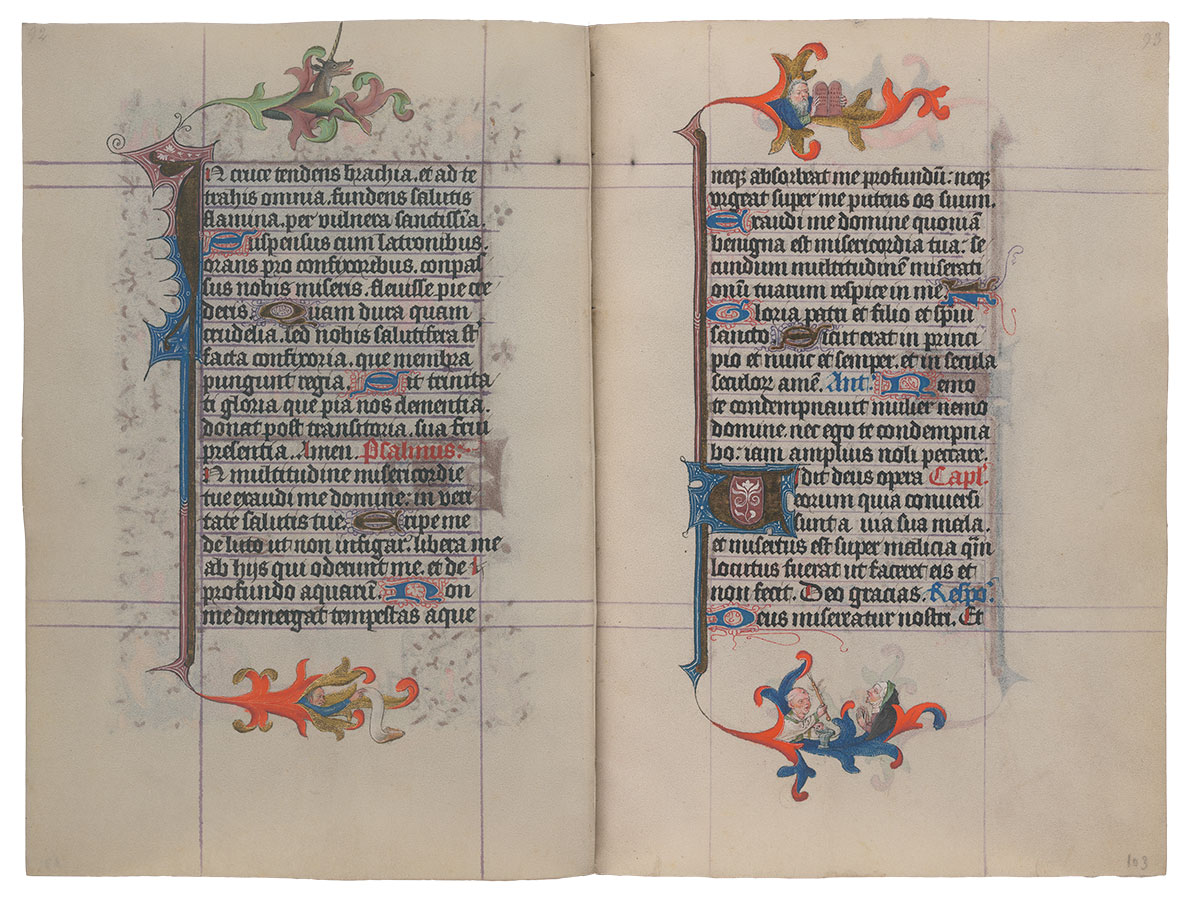
Purchased on the Belle da Costa Greene Fund with the assistance of the Fellows, 1963
Image courtesy of Faksimile Verlag Luzern
MS M.917/945, pp. 104–105
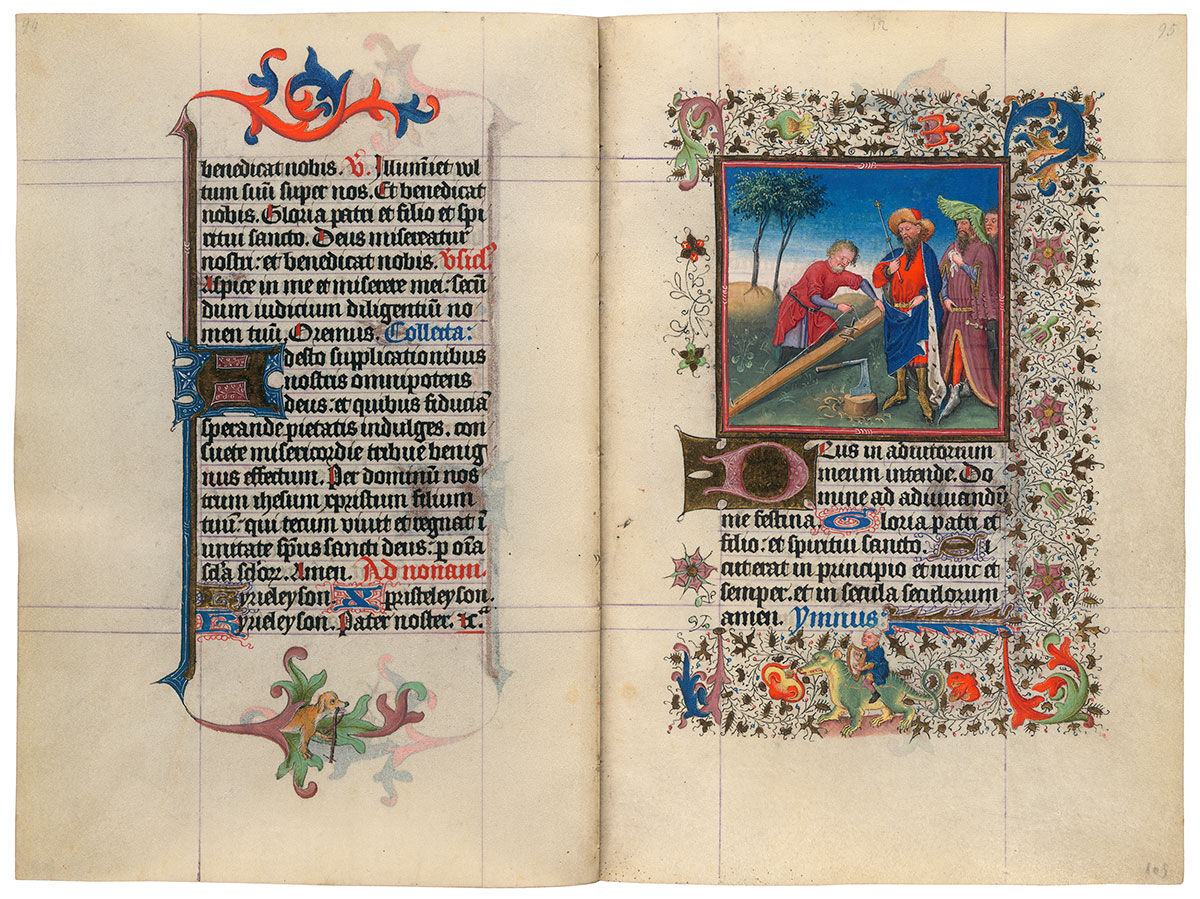
Solomon Observing the Measuring of the Timber
Purchased on the Belle da Costa Greene Fund with the assistance of the Fellows, 1963
Having cut the tree and shaped the timber, the carpenter measures it with string. Solomon, dressed as he was in the previous miniature, again oversees the activity, scepter still in hand. The wood, however, always found to be either too long or too short for use in the temple, is rejected.
Hours and Masses for the Seven Days of the Week
The most unusual texts in Catherine's manuscript are the series of Hours and Masses for every day of the week. Medieval Christian tradition associated certain figures or themes with different days. Thus Sunday, the day of the Resurrection, was the Lord's Day; Thursday was connected with the Eucharist since that sacrament was instituted on Holy Thursday; and Monday was the day of the dead, since their torments were suspended on Sunday but recommenced the following day. In Catherine's prayer book, the themes for the Hours and Masses of the seven days of the week are:
| Sunday | the Trinity |
| Monday | the Dead |
| Tuesday | the Holy Spirit |
| Wednesday | All Saints |
| Thursday | the Blessed Sacrament |
| Friday | the Compassion of God |
| Saturday | the Virgin. |
Image courtesy of Faksimile Verlag Luzern
MS M.917/945, pp. 106–107
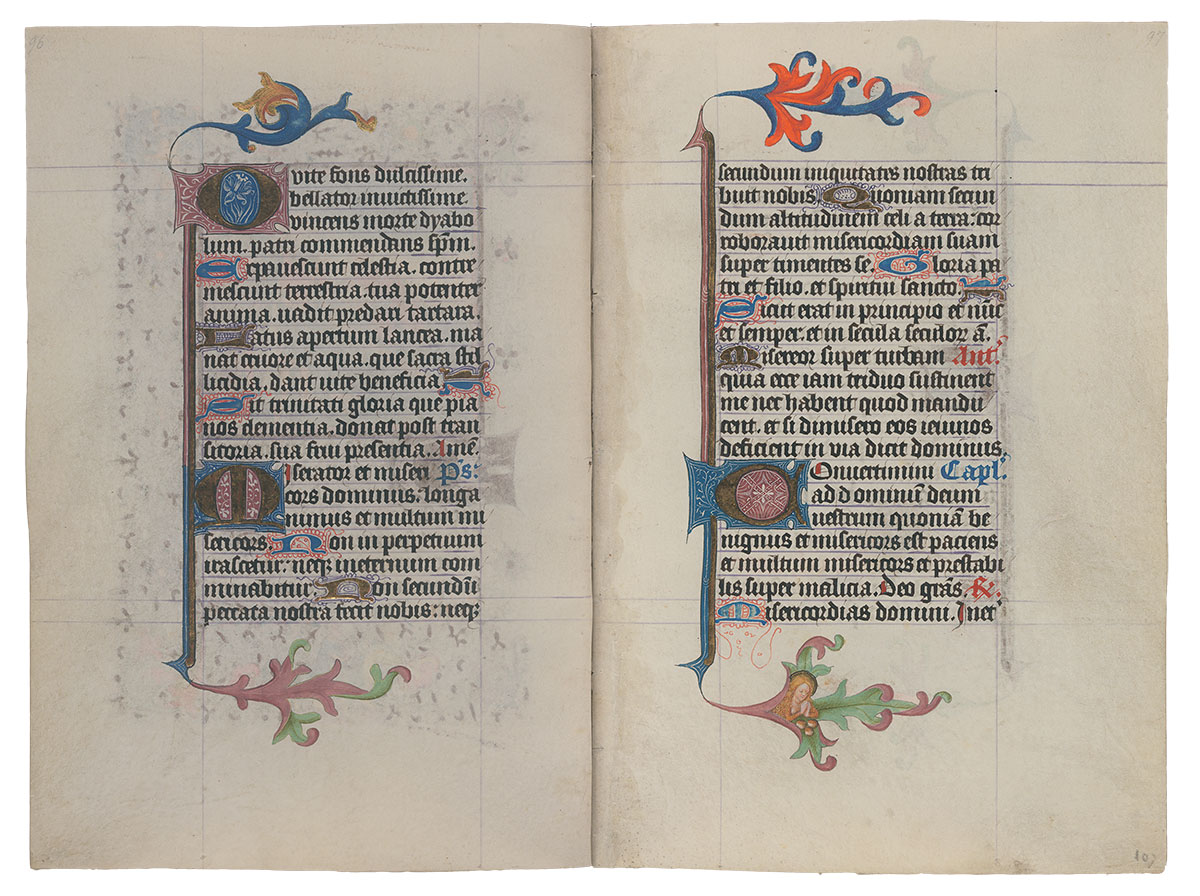
Purchased on the Belle da Costa Greene Fund with the assistance of the Fellows, 1963
Image courtesy of Faksimile Verlag Luzern
MS M.917/945, pp. 108–109
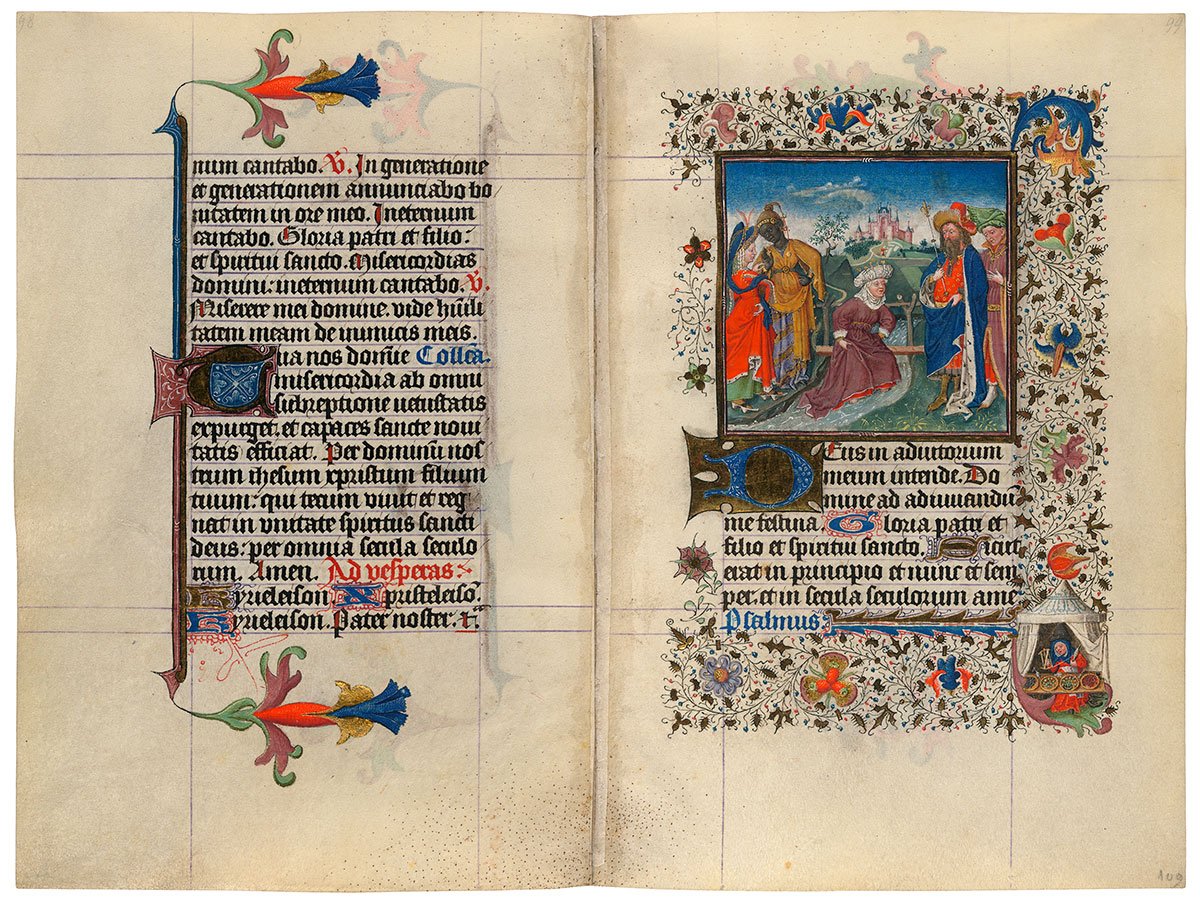
The Queen of Sheba Fording the Stream of Cedron
Purchased on the Belle da Costa Greene Fund with the assistance of the Fellows, 1963
Unsuitable for constructing the temple, the timber is employed as a lowly footbridge over the stream of Cedron. It is this footbridge that the Queen of Sheba must cross in order to pay a visit to Solomon. The queen, however, had a prophetic vision that the bridge would furnish the wood upon which Christ would be crucified. She therefore refuses to tread on the bridge and instead wades, as we see here, across the Cedron to reach the waiting king.
Hours and Masses for the Seven Days of the Week
The most unusual texts in Catherine's manuscript are the series of Hours and Masses for every day of the week. Medieval Christian tradition associated certain figures or themes with different days. Thus Sunday, the day of the Resurrection, was the Lord's Day; Thursday was connected with the Eucharist since that sacrament was instituted on Holy Thursday; and Monday was the day of the dead, since their torments were suspended on Sunday but recommenced the following day. In Catherine's prayer book, the themes for the Hours and Masses of the seven days of the week are:
| Sunday | the Trinity |
| Monday | the Dead |
| Tuesday | the Holy Spirit |
| Wednesday | All Saints |
| Thursday | the Blessed Sacrament |
| Friday | the Compassion of God |
| Saturday | the Virgin. |
Image courtesy of Faksimile Verlag Luzern
MS M.917/945, pp. 110–111
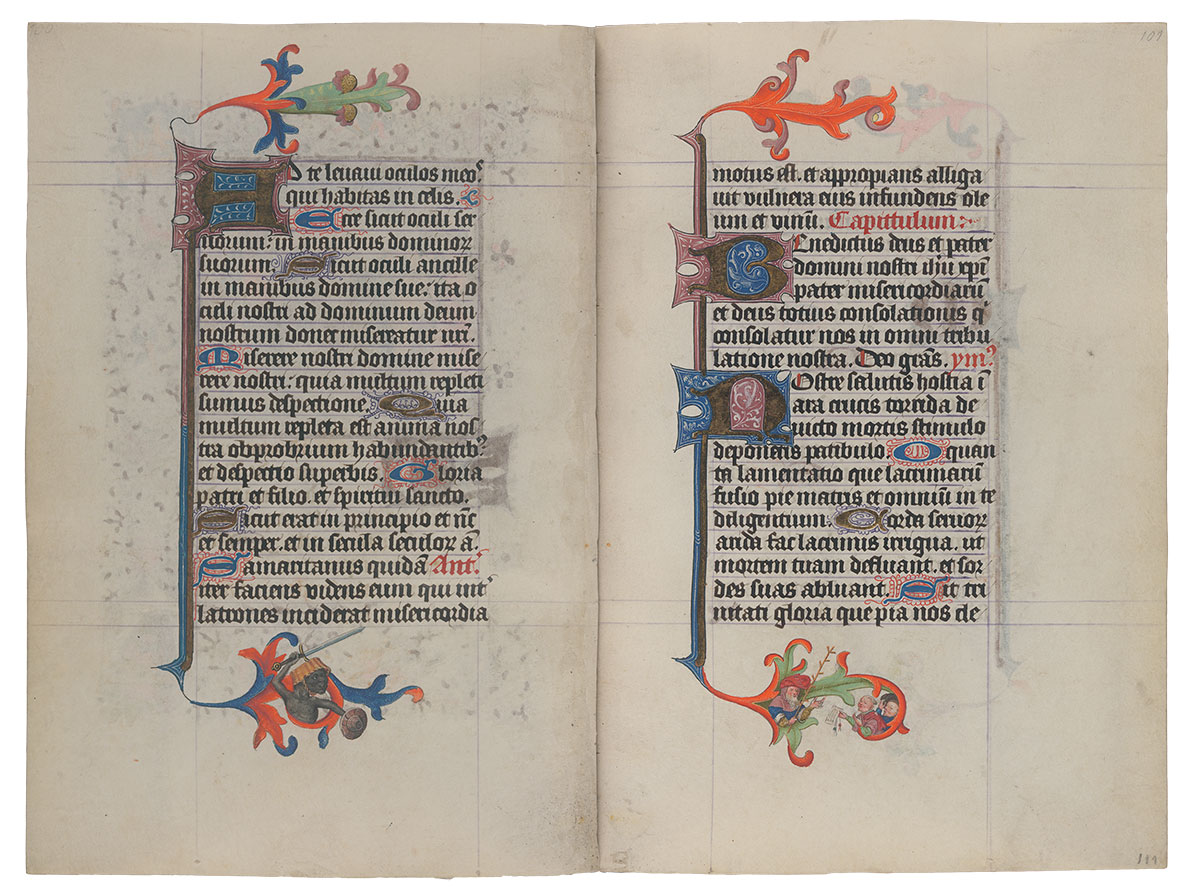
Purchased on the Belle da Costa Greene Fund with the assistance of the Fellows, 1963
Image courtesy of Faksimile Verlag Luzern
MS M.917/945, pp. 112–113
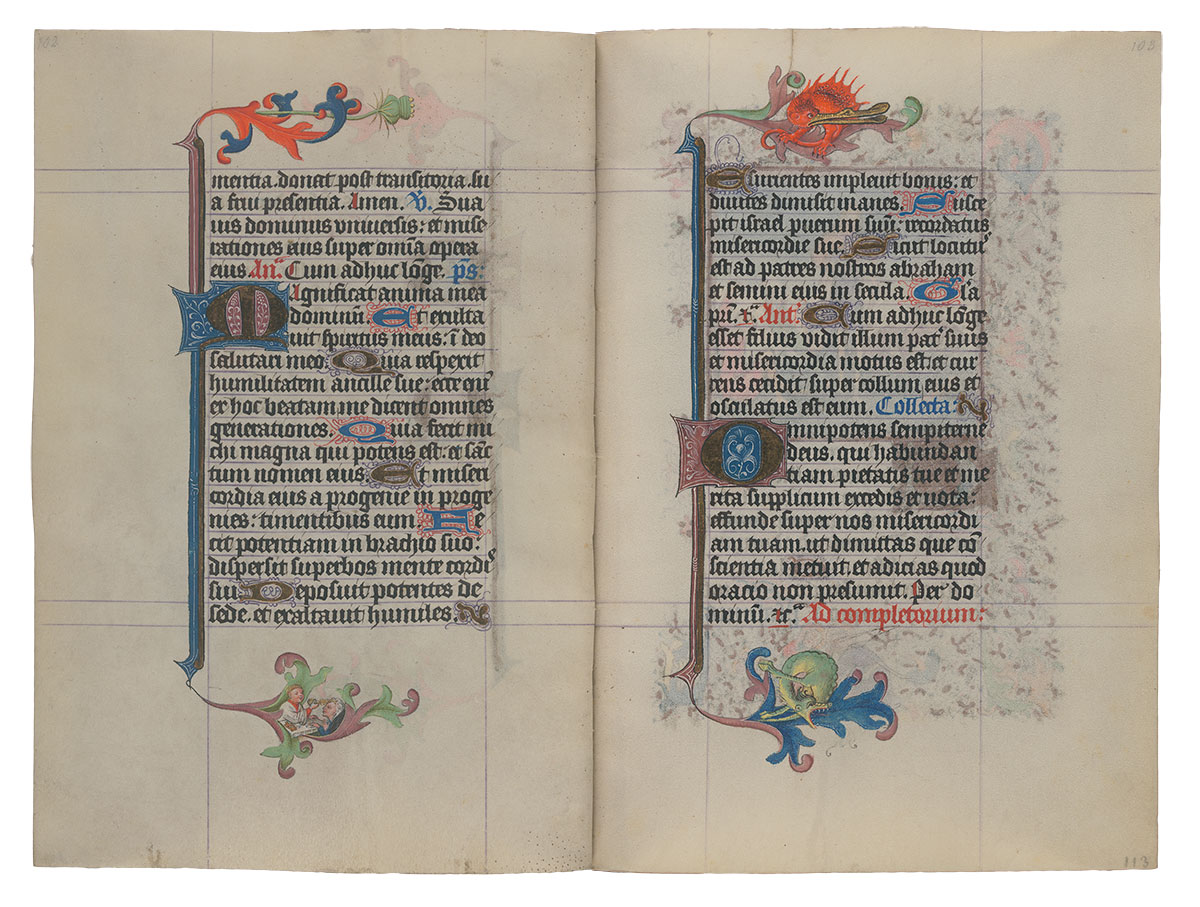
Purchased on the Belle da Costa Greene Fund with the assistance of the Fellows, 1963
Image courtesy of Faksimile Verlag Luzern
MS M.917/945, pp. 114–115
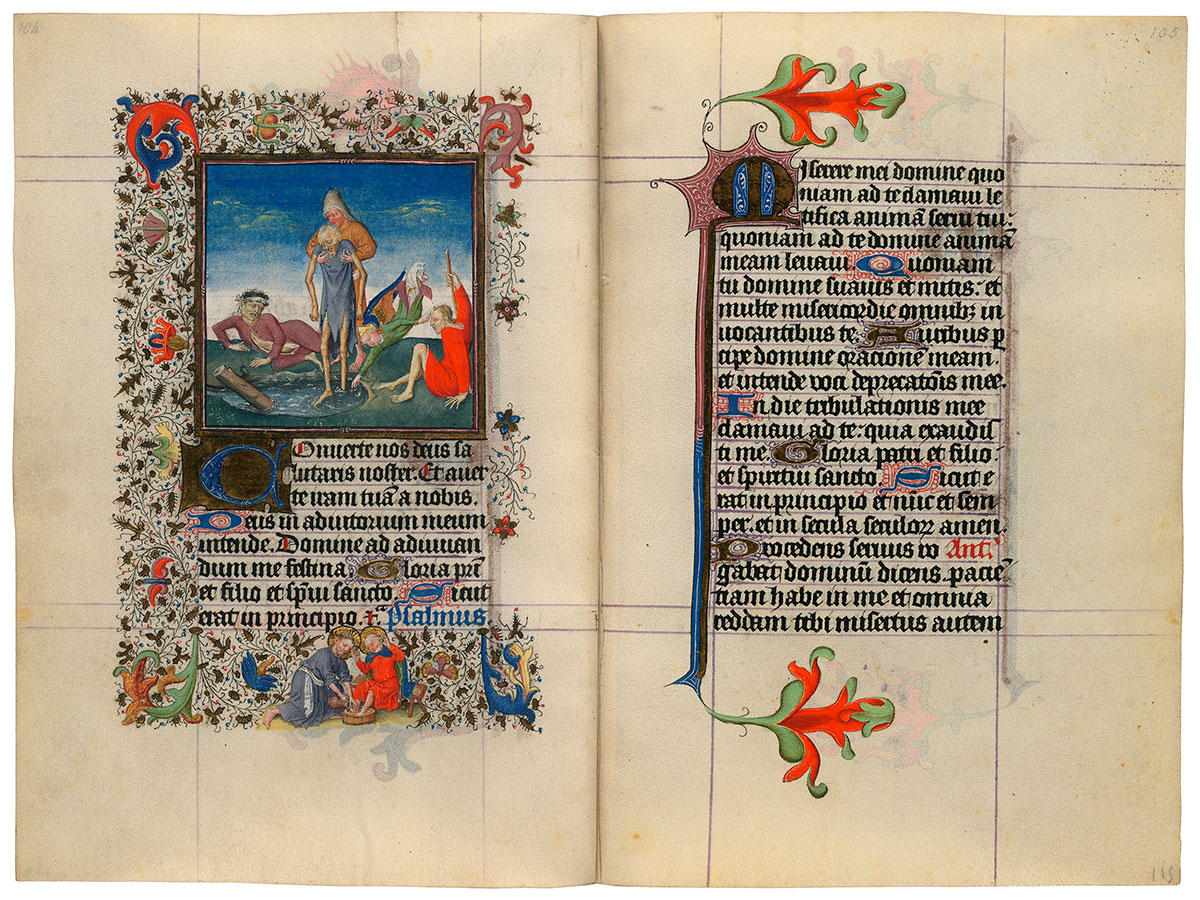
An Angel Stirs the Pool of Bethesda
Purchased on the Belle da Costa Greene Fund with the assistance of the Fellows, 1963
Solomon, aware of an ancient prophecy that the Kingdom of the Jews would come to its end through the wood from the Tree of Mercy, has it buried. Over the burial spot, a pool of miraculous water wells up (there is a floating log in the miniature). When an angel stirred the waters of the Pool of Bethesda, it acquired healing powers. The border vignette of Christ washing the feet of the apostle Peter is a New Testament gloss on the spiritual cleansing powers of water.
Hours and Masses for the Seven Days of the Week
The most unusual texts in Catherine's manuscript are the series of Hours and Masses for every day of the week. Medieval Christian tradition associated certain figures or themes with different days. Thus Sunday, the day of the Resurrection, was the Lord's Day; Thursday was connected with the Eucharist since that sacrament was instituted on Holy Thursday; and Monday was the day of the dead, since their torments were suspended on Sunday but recommenced the following day. In Catherine's prayer book, the themes for the Hours and Masses of the seven days of the week are:
| Sunday | the Trinity |
| Monday | the Dead |
| Tuesday | the Holy Spirit |
| Wednesday | All Saints |
| Thursday | the Blessed Sacrament |
| Friday | the Compassion of God |
| Saturday | the Virgin. |
Image courtesy of Faksimile Verlag Luzern
MS M.917/945, pp. 116–117
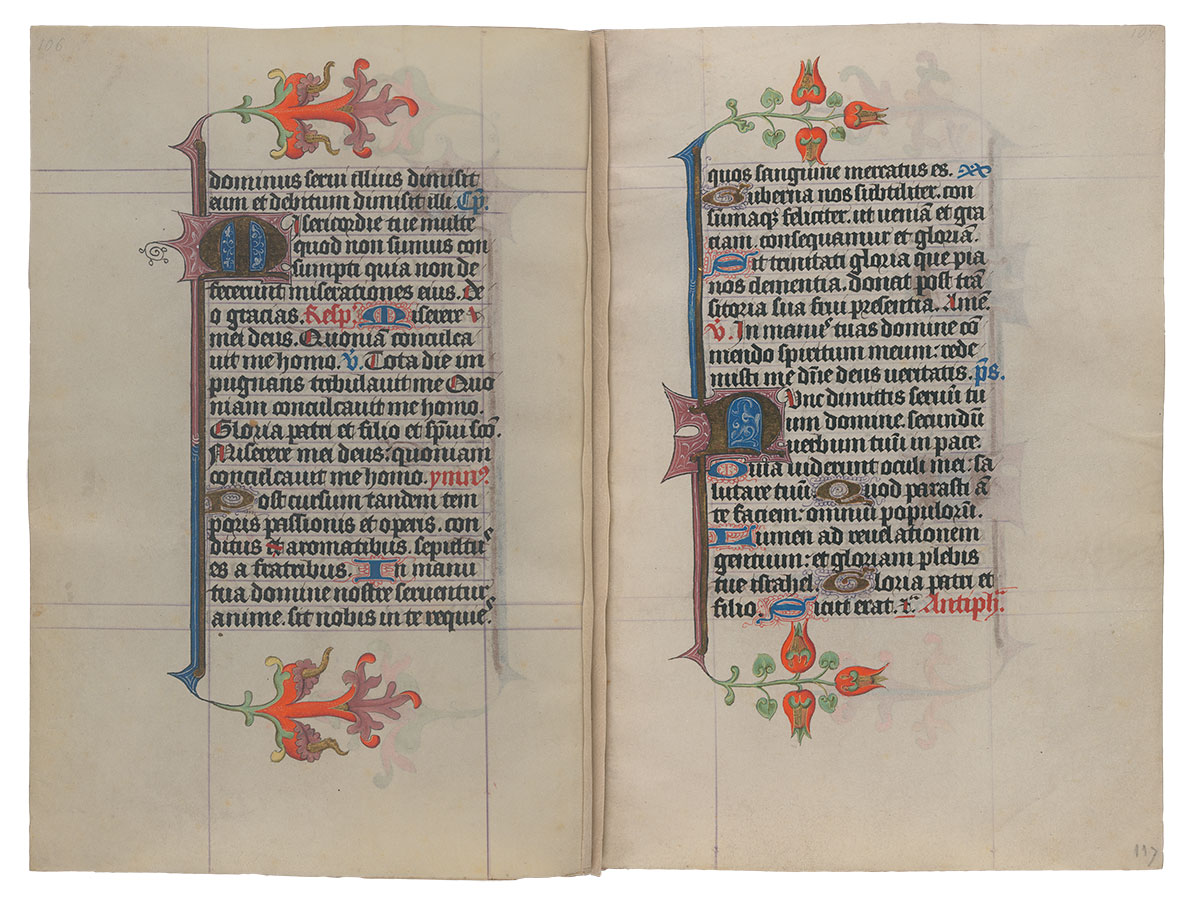
Purchased on the Belle da Costa Greene Fund with the assistance of the Fellows, 1963
Image courtesy of Faksimile Verlag Luzern
MS M.917/945, pp. 118–121
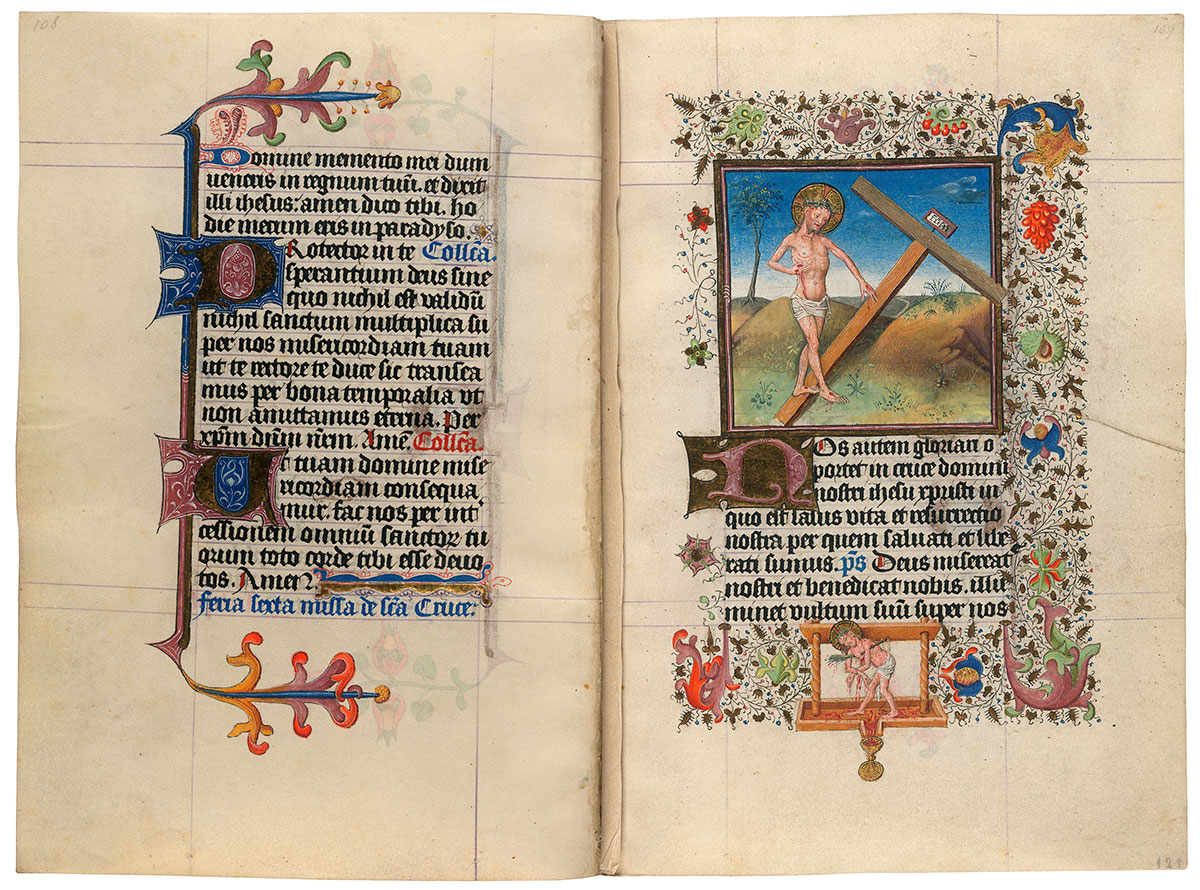
Man of Sorrows and the Cross
Purchased on the Belle da Costa Greene Fund with the assistance of the Fellows, 1963
The Mass of the Holy Cross originally had a large miniature that is now missing. It faced this smaller image showing Christ as the Man of Sorrows standing on his lowered Cross. The scene does not represent a narrative event; rather it is an allegorical image of Christ's triumph over his Cross, his victory over death. The border vignette offers another allegorical image: Christ in the Winepress. Just as grapes are squeezed, Christ is crushed by the winepress; his salvific blood flows into a Eucharistic chalice.
Hours and Masses for the Seven Days of the Week
The most unusual texts in Catherine's manuscript are the series of Hours and Masses for every day of the week. Medieval Christian tradition associated certain figures or themes with different days. Thus Sunday, the day of the Resurrection, was the Lord's Day; Thursday was connected with the Eucharist since that sacrament was instituted on Holy Thursday; and Monday was the day of the dead, since their torments were suspended on Sunday but recommenced the following day. In Catherine's prayer book, the themes for the Hours and Masses of the seven days of the week are:
| Sunday | the Trinity |
| Monday | the Dead |
| Tuesday | the Holy Spirit |
| Wednesday | All Saints |
| Thursday | the Blessed Sacrament |
| Friday | the Compassion of God |
| Saturday | the Virgin. |
Image courtesy of Faksimile Verlag Luzern
MS M.917/945, pp. 122–123
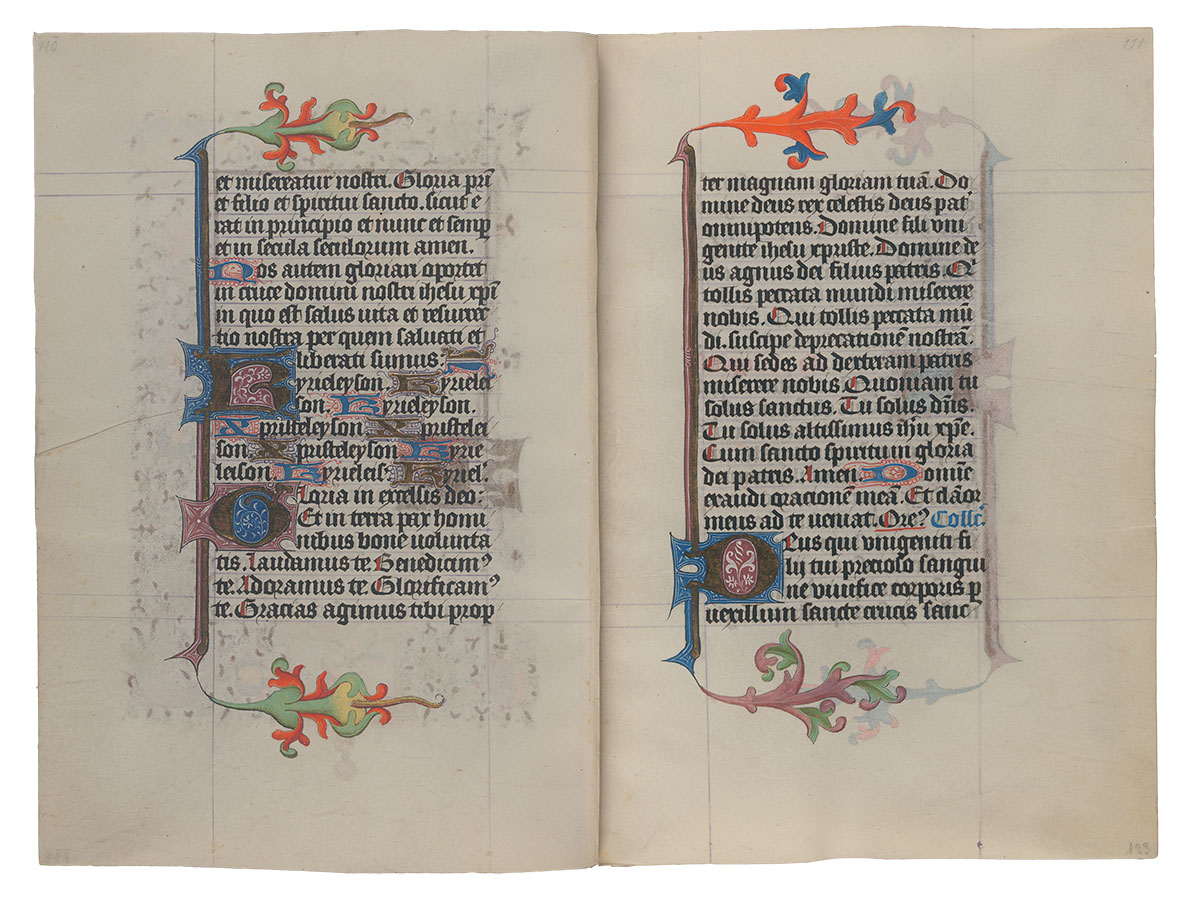
Purchased on the Belle da Costa Greene Fund with the assistance of the Fellows, 1963
Image courtesy of Faksimile Verlag Luzern
MS M.917/945, pp. 124–125
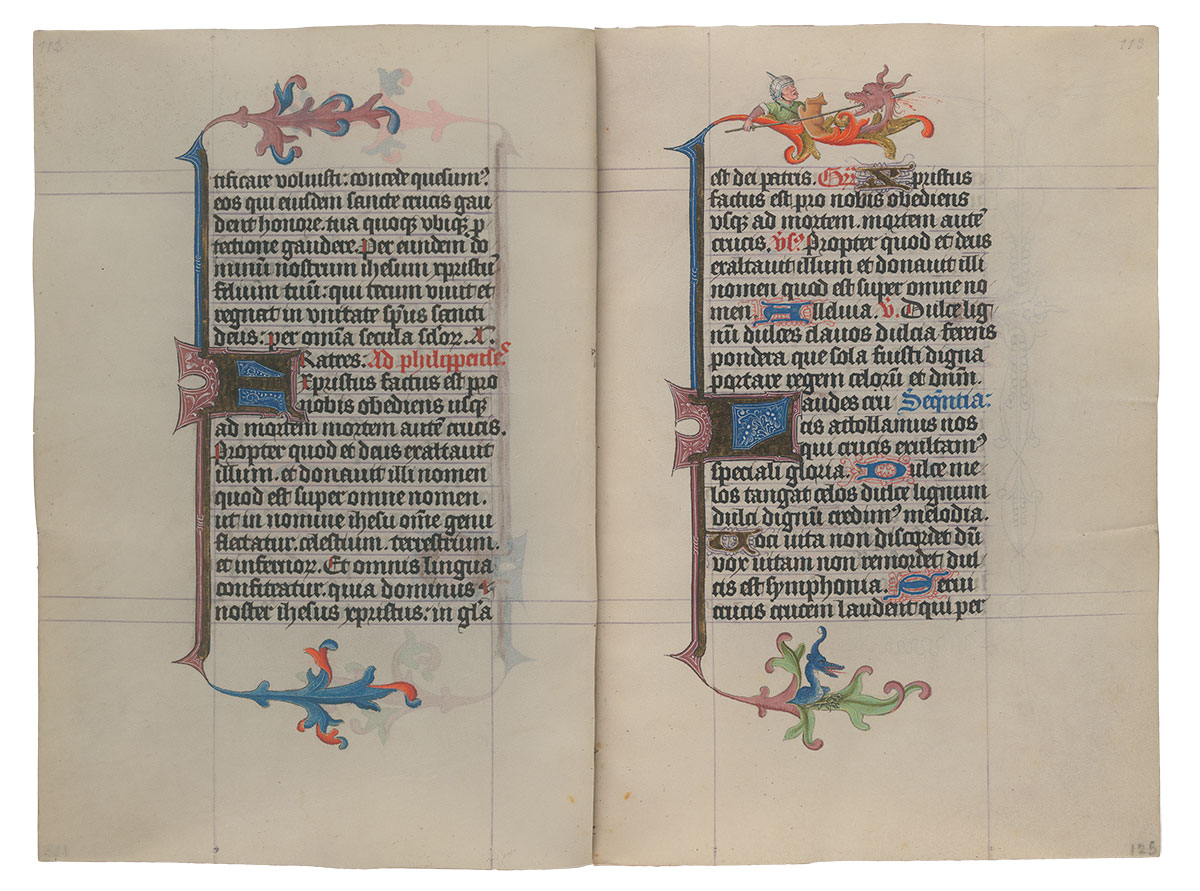
Purchased on the Belle da Costa Greene Fund with the assistance of the Fellows, 1963
Image courtesy of Faksimile Verlag Luzern
MS M.917/945, pp. 126–127
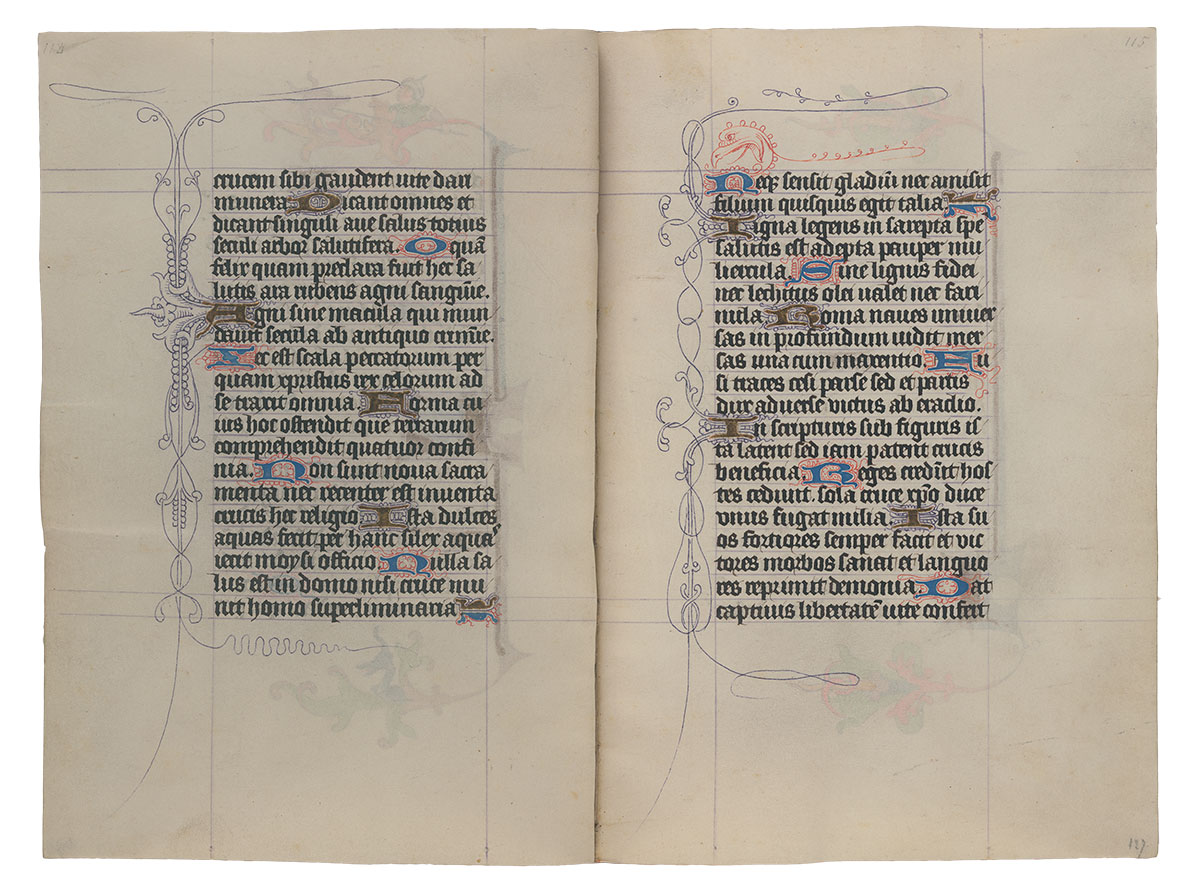
Purchased on the Belle da Costa Greene Fund with the assistance of the Fellows, 1963
Image courtesy of Faksimile Verlag Luzern
MS M.917/945, pp. 128–129
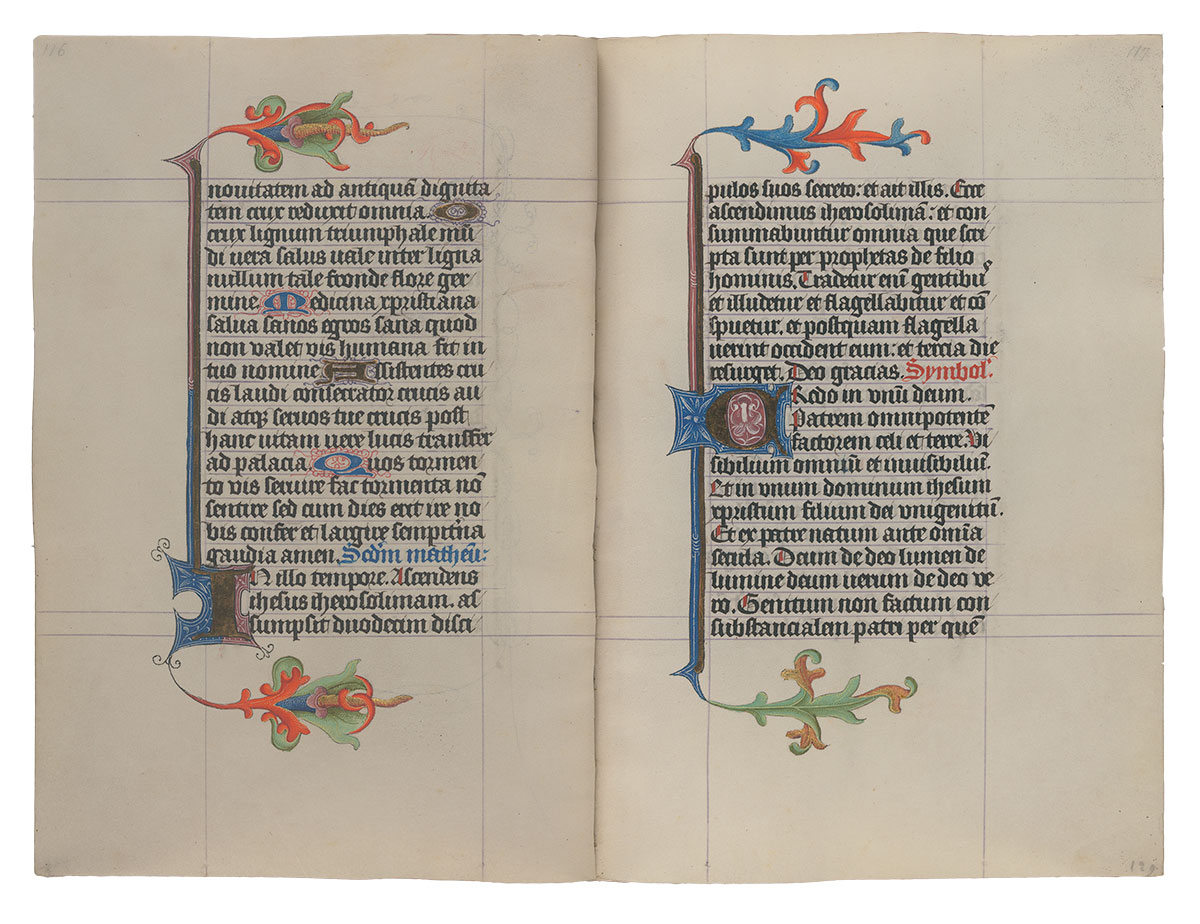
Purchased on the Belle da Costa Greene Fund with the assistance of the Fellows, 1963
Image courtesy of Faksimile Verlag Luzern
MS M.917/945, pp. 130–131
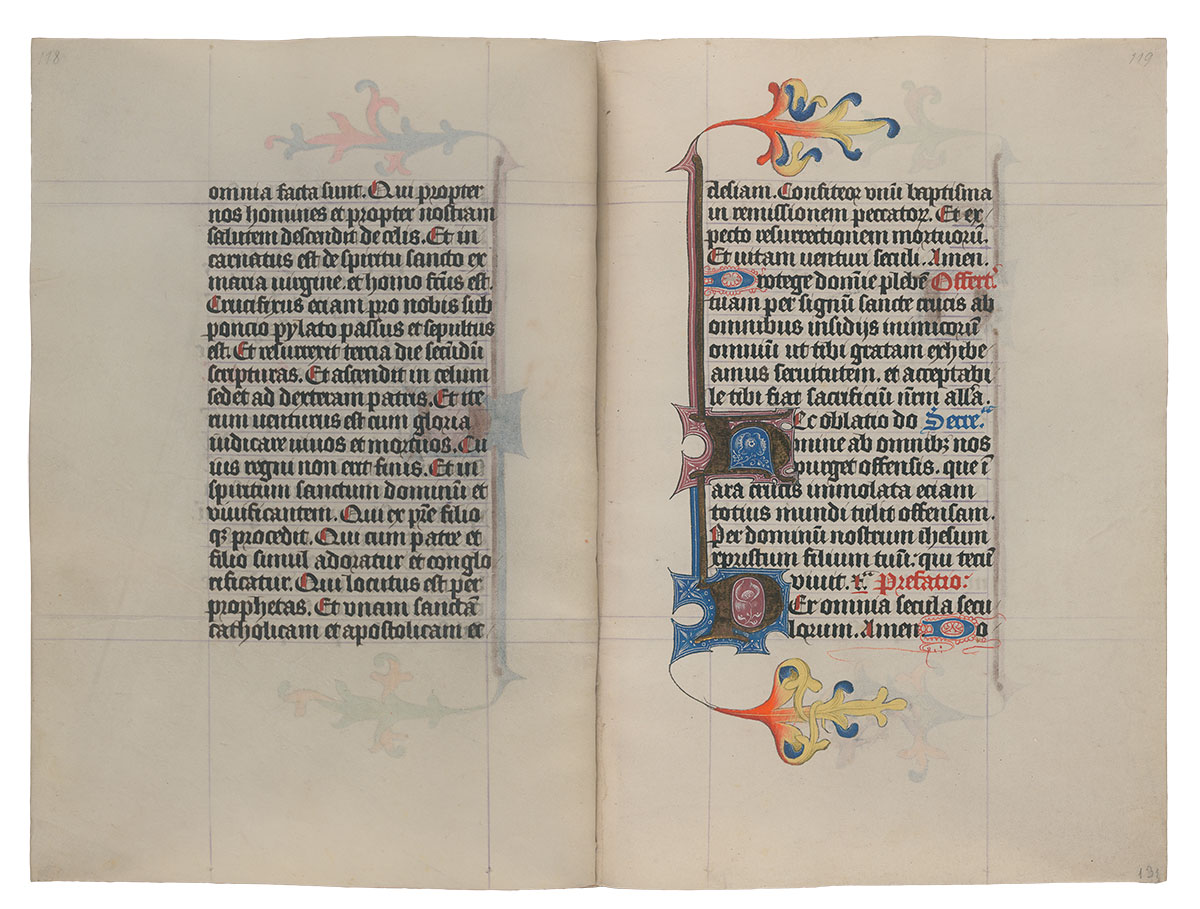
Purchased on the Belle da Costa Greene Fund with the assistance of the Fellows, 1963
Image courtesy of Faksimile Verlag Luzern
MS M.917/945, pp. 132–133
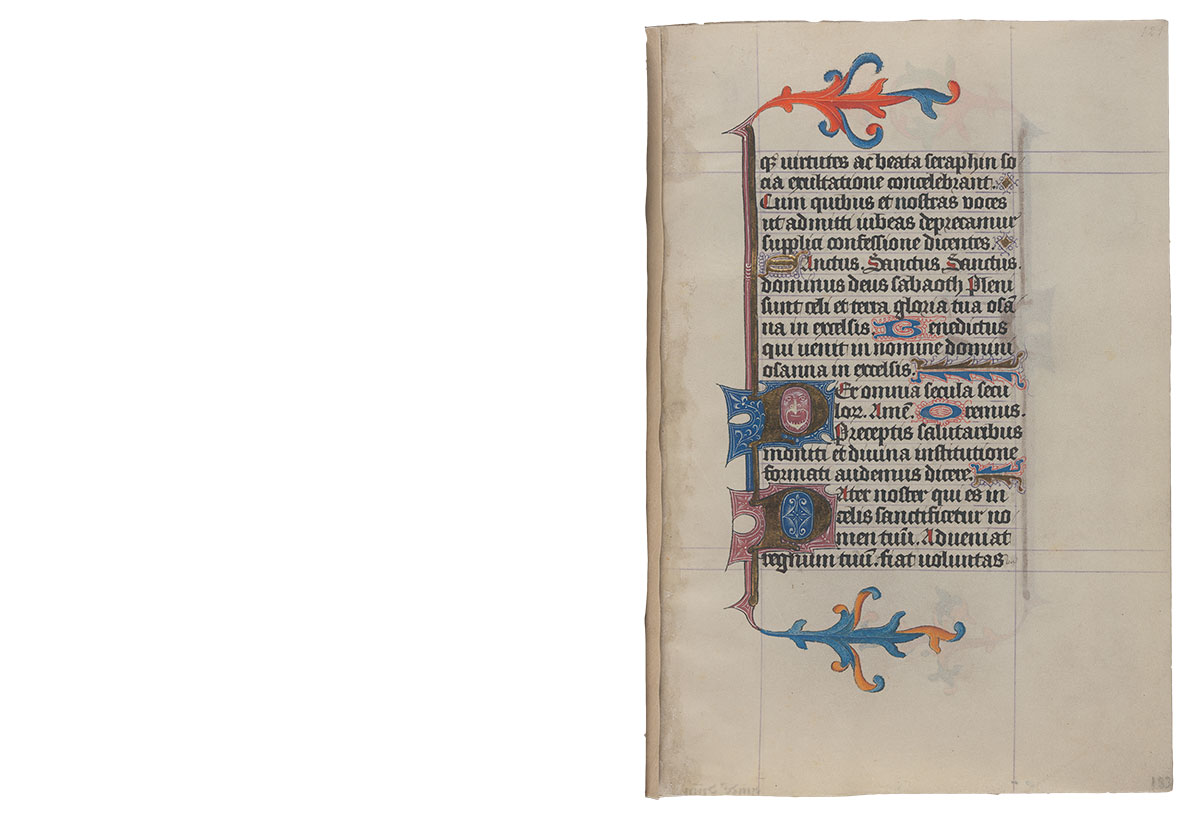
Purchased on the Belle da Costa Greene Fund with the assistance of the Fellows, 1963
Image courtesy of Faksimile Verlag Luzern
MS M.917/945, pp. 134–135
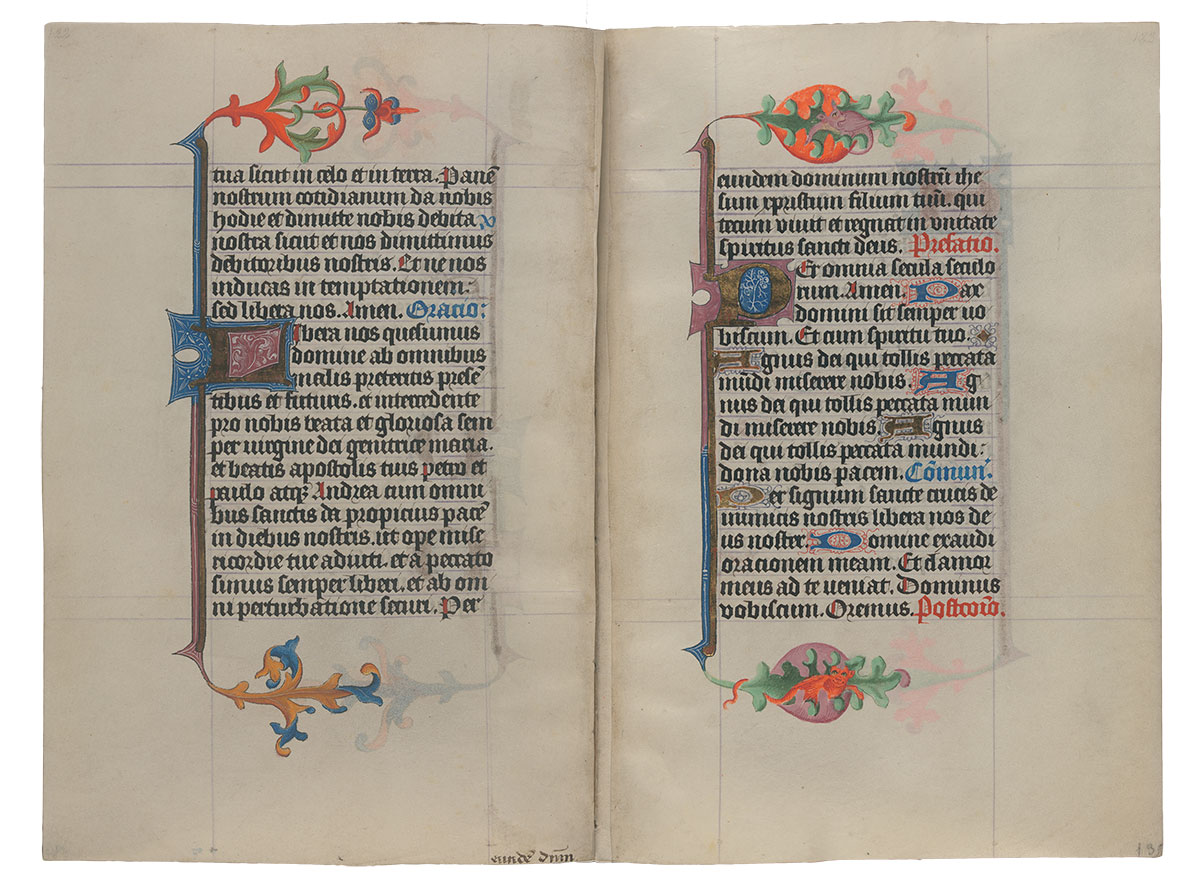
Purchased on the Belle da Costa Greene Fund with the assistance of the Fellows, 1963
Image courtesy of Faksimile Verlag Luzern
MS M.917/945, pp. 136–137
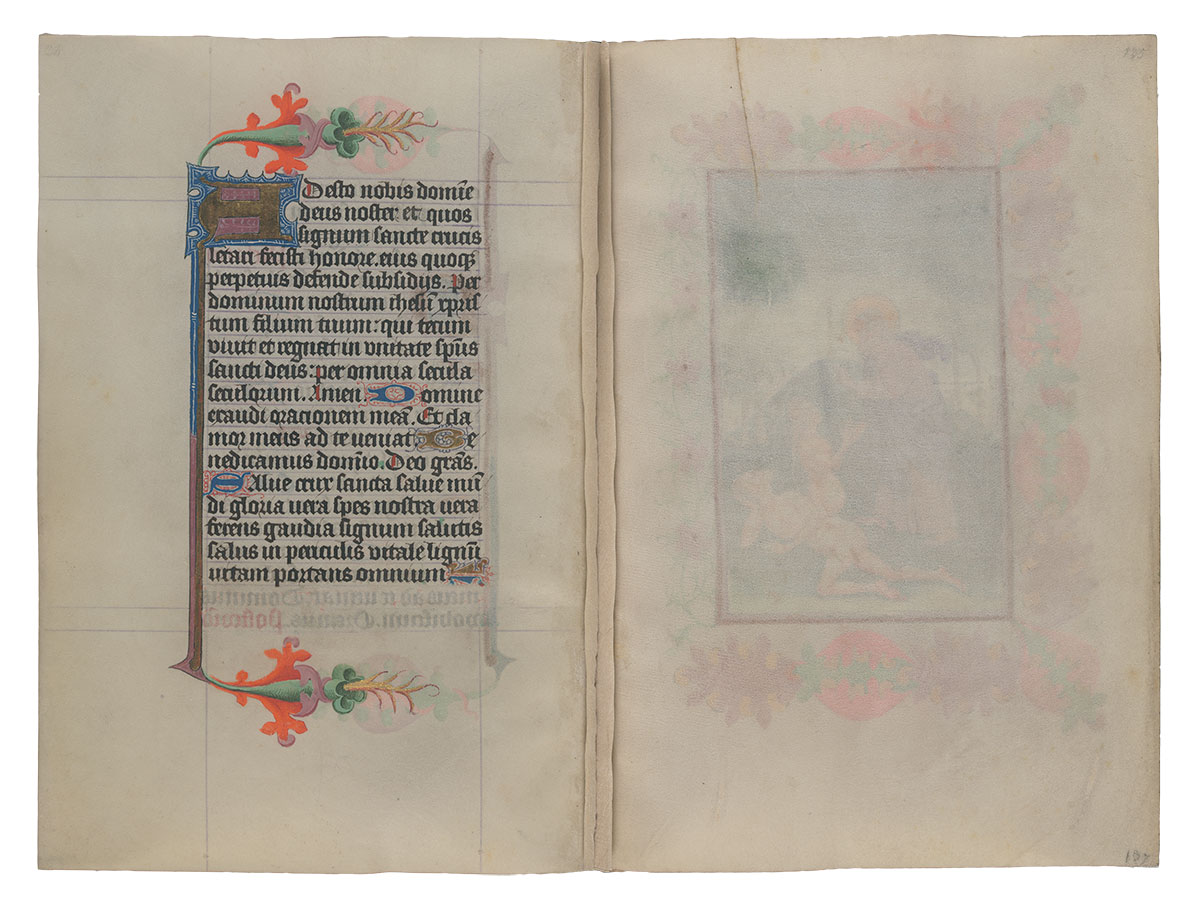
Purchased on the Belle da Costa Greene Fund with the assistance of the Fellows, 1963
Image courtesy of Faksimile Verlag Luzern
MS M.917/945, pp. 138–139
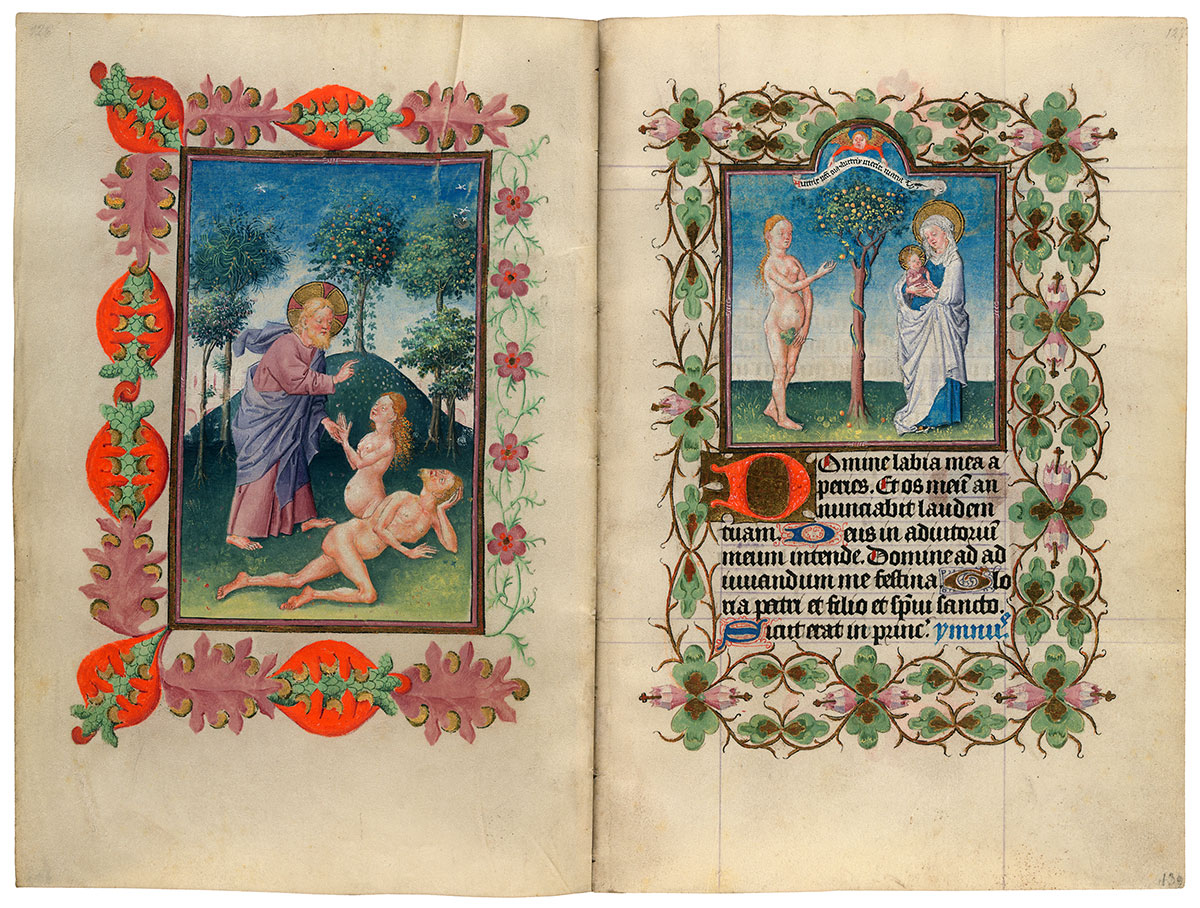
Creation of Eve
Eve and the Virgin
Purchased on the Belle da Costa Greene Fund with the assistance of the Fellows, 1963
The Saturday Hours of the Virgin begin with this full-page miniature of the Creation of Eve. In the verdant Garden of Eden, a blond God pulls an equally blonde Eve from the side of a fair Adam. All is light and bliss. Eve's creation starts the illustrative cycle for the Saturday Hours of the Virgin because she is the mother of sin, and her downfall necessitated the arrival of the "New Eve," that is, the Virgin. Mary will be the mother of Christ, the Savior through whom mankind will be cleansed of the Original Sin of our first forebears.
Hours and Masses for the Seven Days of the Week
The most unusual texts in Catherine's manuscript are the series of Hours and Masses for every day of the week. Medieval Christian tradition associated certain figures or themes with different days. Thus Sunday, the day of the Resurrection, was the Lord's Day; Thursday was connected with the Eucharist since that sacrament was instituted on Holy Thursday; and Monday was the day of the dead, since their torments were suspended on Sunday but recommenced the following day. In Catherine's prayer book, the themes for the Hours and Masses of the seven days of the week are:
| Sunday | the Trinity |
| Monday | the Dead |
| Tuesday | the Holy Spirit |
| Wednesday | All Saints |
| Thursday | the Blessed Sacrament |
| Friday | the Compassion of God |
| Saturday | the Virgin. |
Image courtesy of Faksimile Verlag Luzern
MS M.917/945, pp. 140–147
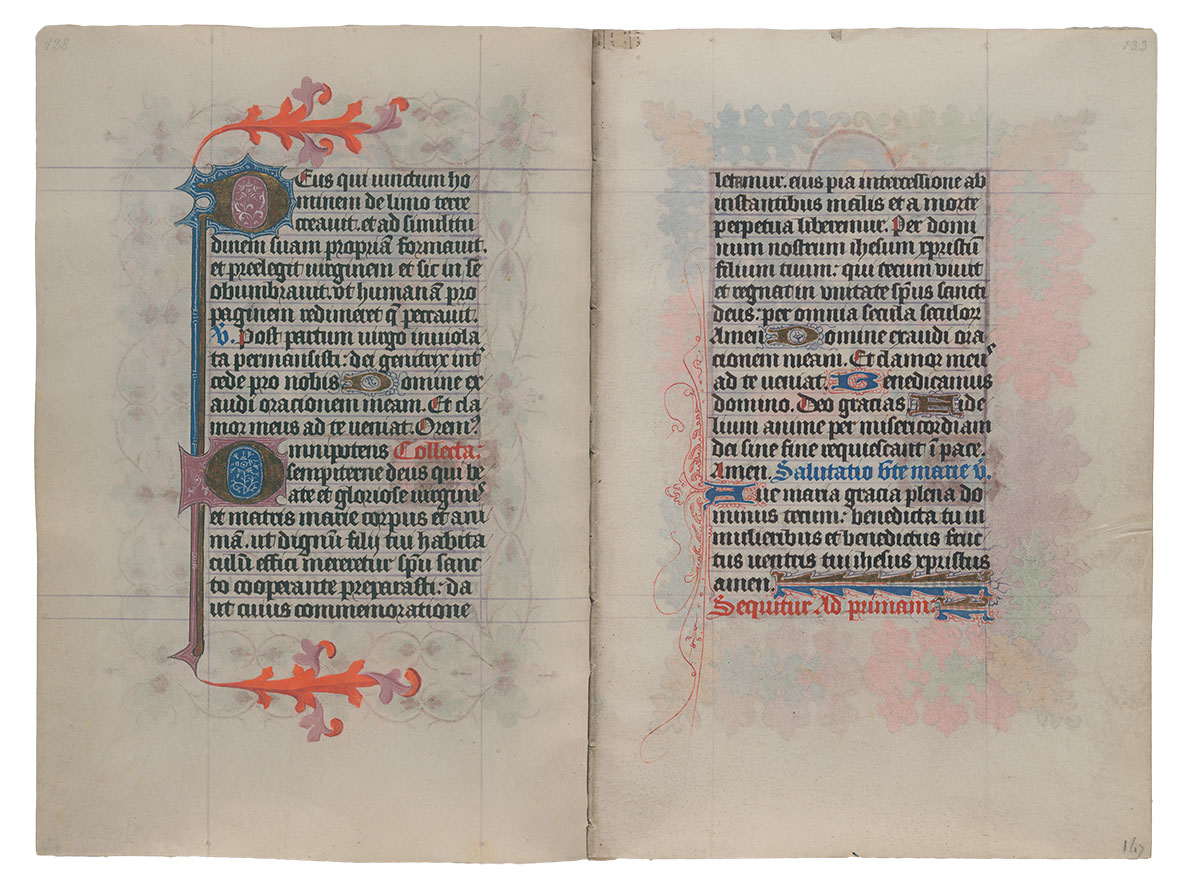
Purchased on the Belle da Costa Greene Fund with the assistance of the Fellows, 1963
Image courtesy of Faksimile Verlag Luzern
MS M.917/945, pp. 148–141
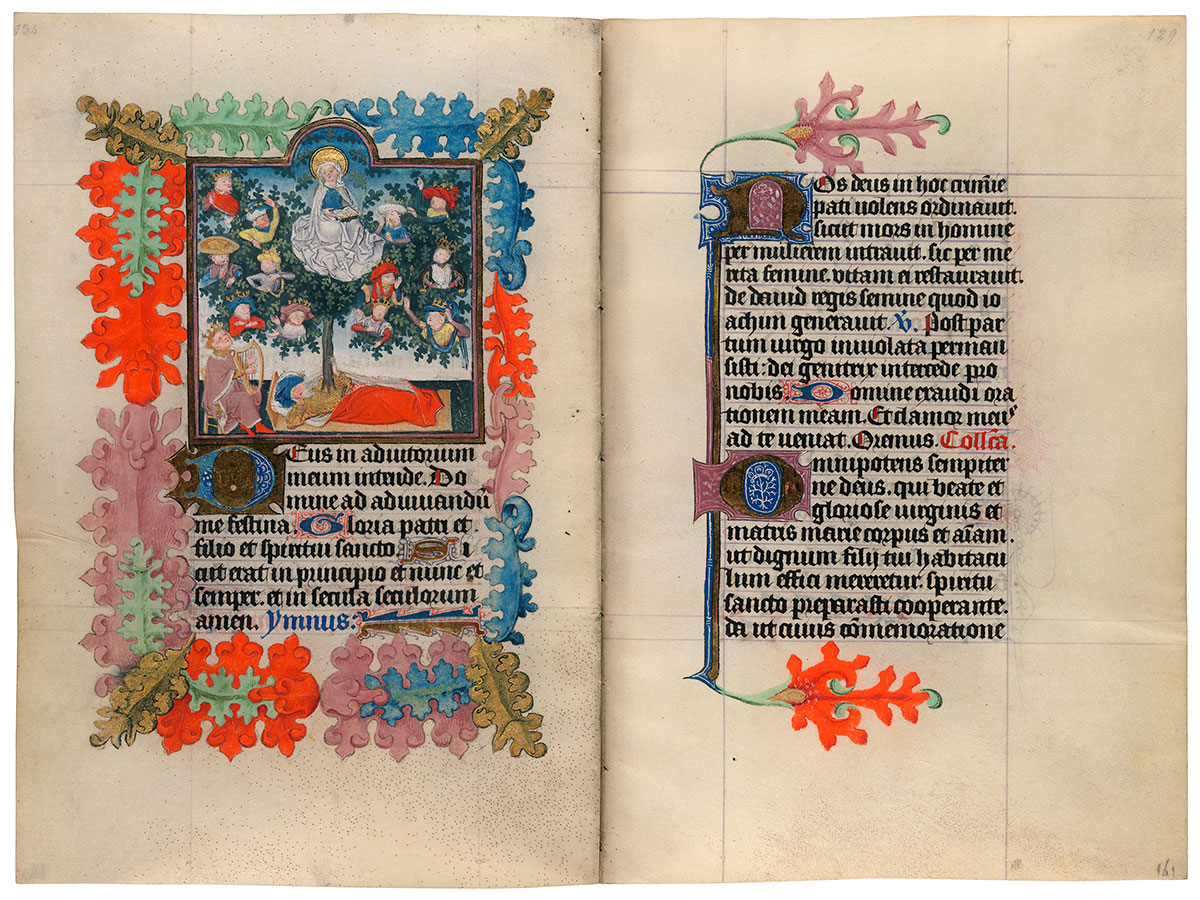
Tree of Jesse
Purchased on the Belle da Costa Greene Fund with the assistance of the Fellows, 1963
Hours and Masses for the Seven Days of the Week
The most unusual texts in Catherine's manuscript are the series of Hours and Masses for every day of the week. Medieval Christian tradition associated certain figures or themes with different days. Thus Sunday, the day of the Resurrection, was the Lord's Day; Thursday was connected with the Eucharist since that sacrament was instituted on Holy Thursday; and Monday was the day of the dead, since their torments were suspended on Sunday but recommenced the following day. In Catherine's prayer book, the themes for the Hours and Masses of the seven days of the week are:
| Sunday | the Trinity |
| Monday | the Dead |
| Tuesday | the Holy Spirit |
| Wednesday | All Saints |
| Thursday | the Blessed Sacrament |
| Friday | the Compassion of God |
| Saturday | the Virgin. |
Image courtesy of Faksimile Verlag Luzern
MS M.917/945, pp. 142–145
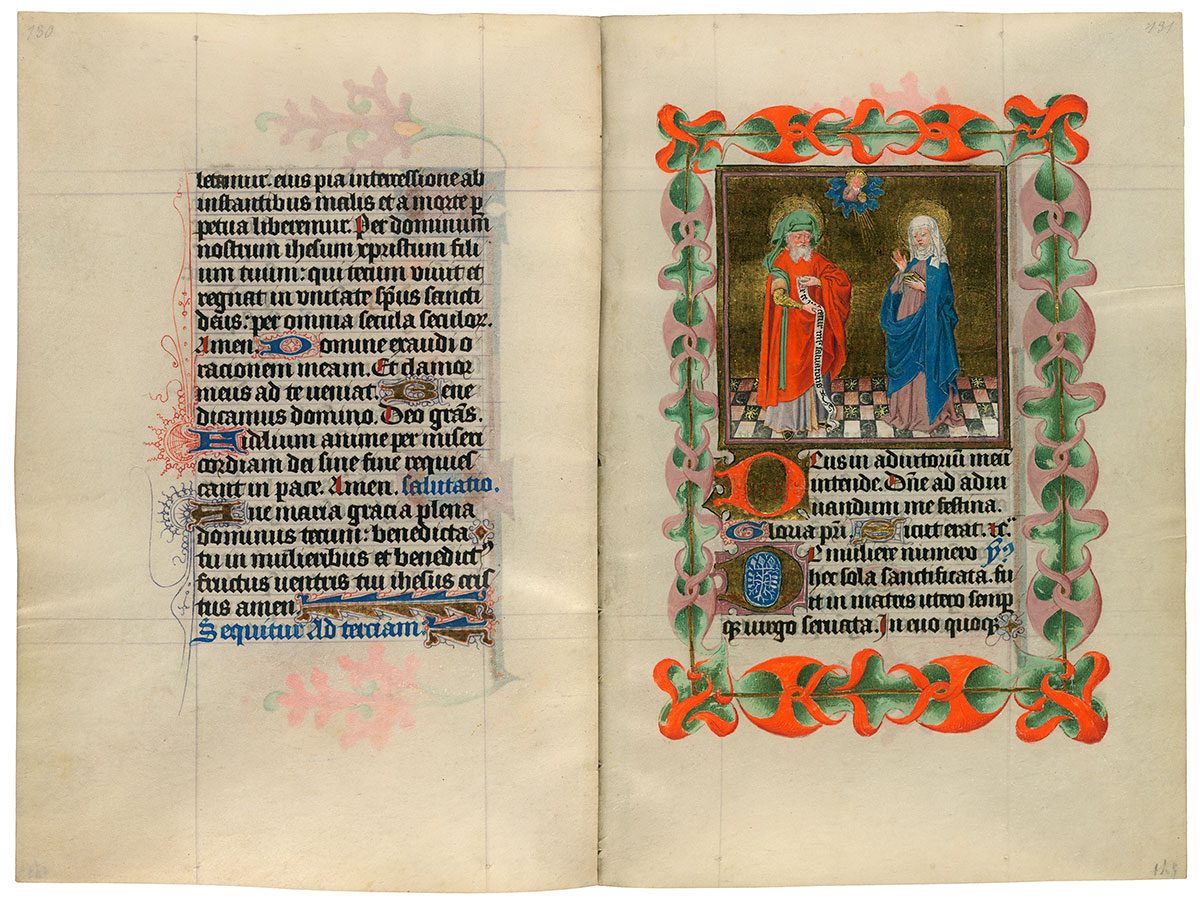
Joachim and Anne
Purchased on the Belle da Costa Greene Fund with the assistance of the Fellows, 1963
Hours and Masses for the Seven Days of the Week
The most unusual texts in Catherine's manuscript are the series of Hours and Masses for every day of the week. Medieval Christian tradition associated certain figures or themes with different days. Thus Sunday, the day of the Resurrection, was the Lord's Day; Thursday was connected with the Eucharist since that sacrament was instituted on Holy Thursday; and Monday was the day of the dead, since their torments were suspended on Sunday but recommenced the following day. In Catherine's prayer book, the themes for the Hours and Masses of the seven days of the week are:
| Sunday | the Trinity |
| Monday | the Dead |
| Tuesday | the Holy Spirit |
| Wednesday | All Saints |
| Thursday | the Blessed Sacrament |
| Friday | the Compassion of God |
| Saturday | the Virgin. |
Image courtesy of Faksimile Verlag Luzern
MS M.917/945, pp. 146–149
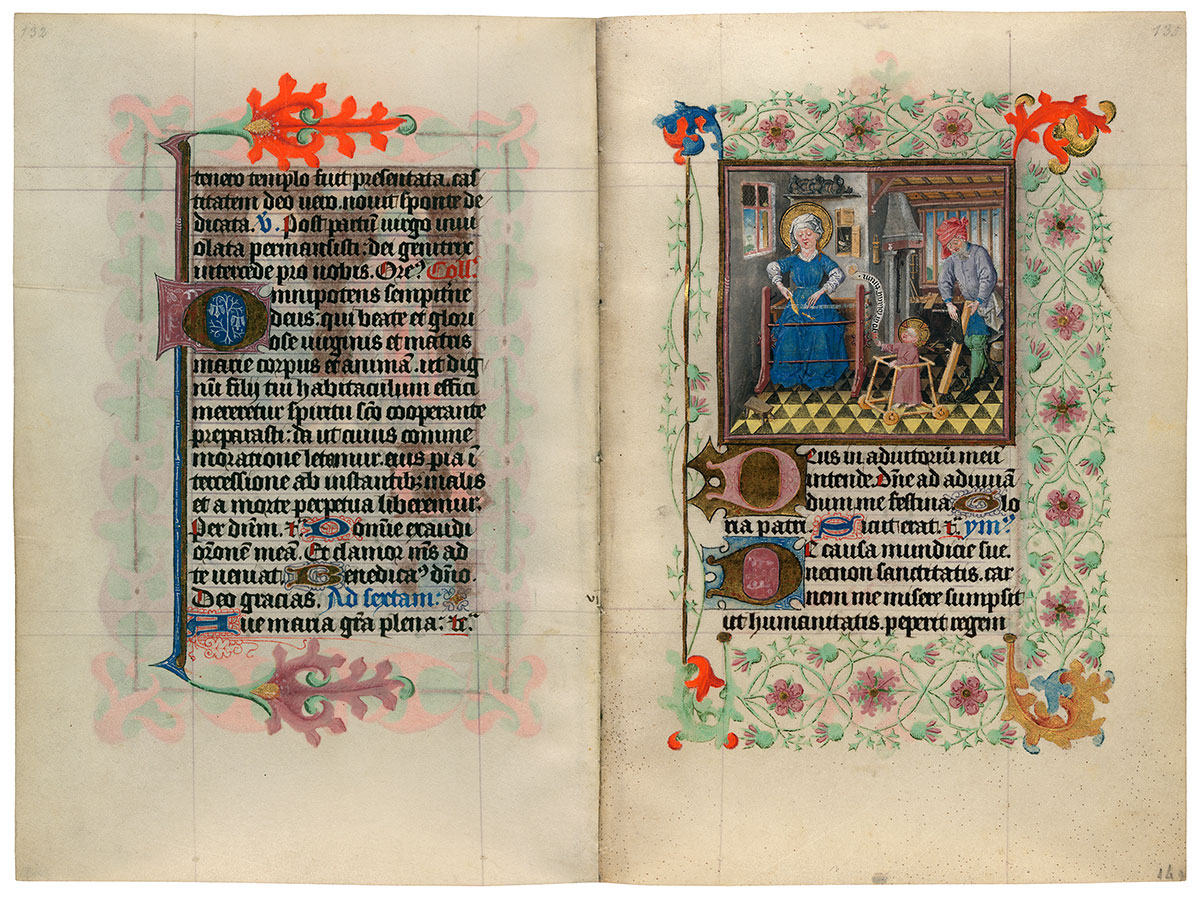
Holy Family at Work
Purchased on the Belle da Costa Greene Fund with the assistance of the Fellows, 1963
This charming scene is easily the most cherished of all the miniatures from Catherine's prayer book. Within a domestic interior scattered with tools and utensils, the Virgin weaves, baby Jesus takes his first steps in a walker, and Joseph planes a board. The wood resembles the beam of a cross and thus alludes to Christ's forthcoming death. But for now the child offers consolation: "I am your solace" is written on the scroll Christ unfurls to his mother.
Hours and Masses for the Seven Days of the Week
The most unusual texts in Catherine's manuscript are the series of Hours and Masses for every day of the week. Medieval Christian tradition associated certain figures or themes with different days. Thus Sunday, the day of the Resurrection, was the Lord's Day; Thursday was connected with the Eucharist since that sacrament was instituted on Holy Thursday; and Monday was the day of the dead, since their torments were suspended on Sunday but recommenced the following day. In Catherine's prayer book, the themes for the Hours and Masses of the seven days of the week are:
| Sunday | the Trinity |
| Monday | the Dead |
| Tuesday | the Holy Spirit |
| Wednesday | All Saints |
| Thursday | the Blessed Sacrament |
| Friday | the Compassion of God |
| Saturday | the Virgin. |
Image courtesy of Faksimile Verlag Luzern
MS M.917/945, pp. 150–151
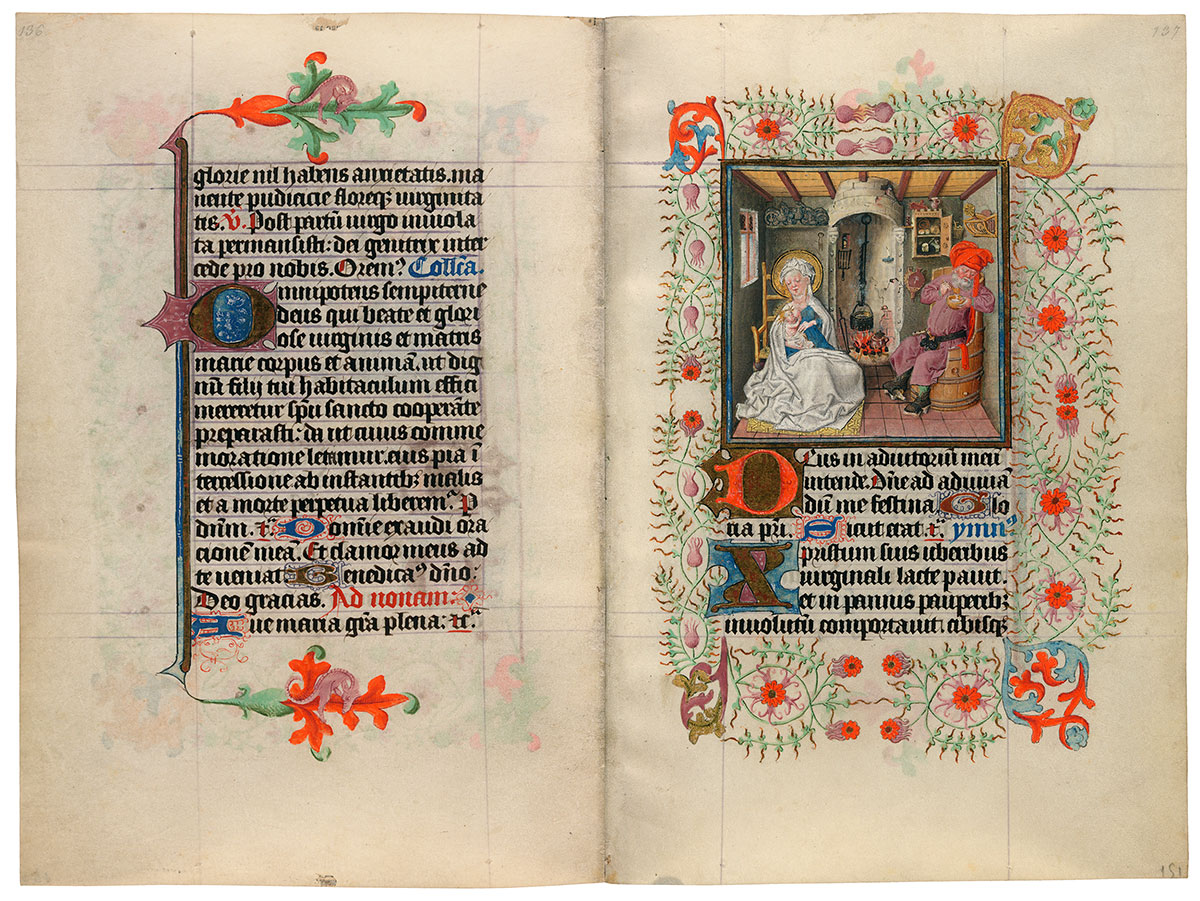
Holy Family at Supper
Purchased on the Belle da Costa Greene Fund with the assistance of the Fellows, 1963
Nearly as delightful as the previous miniature is this one showing the Holy Family taking sustenance. Humbly seated on the floor, Mary, as the Virgo lactans, gives suck to the Christ Child. Joseph spoons his supper while seated in a barrel chair. The background is filled with an abundance of home furnishings: a shelf of pewter plates, a pair of shears, a bellows, a wood cabinet with food and dishes, and a rack of utensils. The cylindrical fireplace contains steaming pots, tongs, and a grill. Note the delicacy with which the Cleves Master rendered the wisps of smoke.
Hours and Masses for the Seven Days of the Week
The most unusual texts in Catherine's manuscript are the series of Hours and Masses for every day of the week. Medieval Christian tradition associated certain figures or themes with different days. Thus Sunday, the day of the Resurrection, was the Lord's Day; Thursday was connected with the Eucharist since that sacrament was instituted on Holy Thursday; and Monday was the day of the dead, since their torments were suspended on Sunday but recommenced the following day. In Catherine's prayer book, the themes for the Hours and Masses of the seven days of the week are:
| Sunday | the Trinity |
| Monday | the Dead |
| Tuesday | the Holy Spirit |
| Wednesday | All Saints |
| Thursday | the Blessed Sacrament |
| Friday | the Compassion of God |
| Saturday | the Virgin. |
Image courtesy of Faksimile Verlag Luzern
MS M.917/945, pp. 152–153
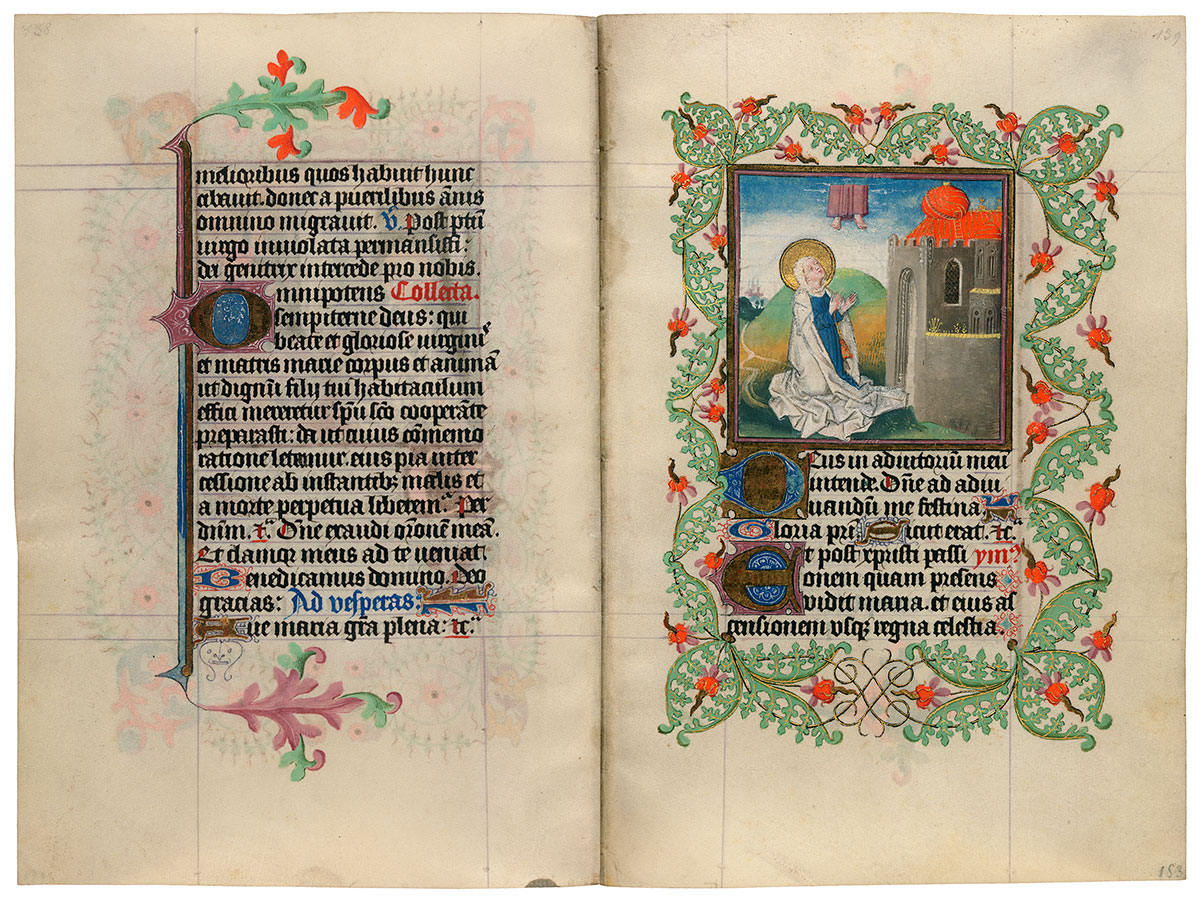
The Virgin Witnessing Christ’s Ascension
Purchased on the Belle da Costa Greene Fund with the assistance of the Fellows, 1963
In general, the Saturday Hours of the Virgin emphasize the joyful or momentous events of Mary's life. After Christ's Crucifixion, the Virgin was consoled when he reappeared to her following the Resurrection. The Ascension marks the end of Christ's time on earth. In the miniature, Mary alone (she is usually joined by the apostles) is witness to her son's disappearance into the clouds, his reentry into heaven.
Hours and Masses for the Seven Days of the Week
The most unusual texts in Catherine's manuscript are the series of Hours and Masses for every day of the week. Medieval Christian tradition associated certain figures or themes with different days. Thus Sunday, the day of the Resurrection, was the Lord's Day; Thursday was connected with the Eucharist since that sacrament was instituted on Holy Thursday; and Monday was the day of the dead, since their torments were suspended on Sunday but recommenced the following day. In Catherine's prayer book, the themes for the Hours and Masses of the seven days of the week are:
| Sunday | the Trinity |
| Monday | the Dead |
| Tuesday | the Holy Spirit |
| Wednesday | All Saints |
| Thursday | the Blessed Sacrament |
| Friday | the Compassion of God |
| Saturday | the Virgin. |
Image courtesy of Faksimile Verlag Luzern
MS M.917/945, pp. 154–157
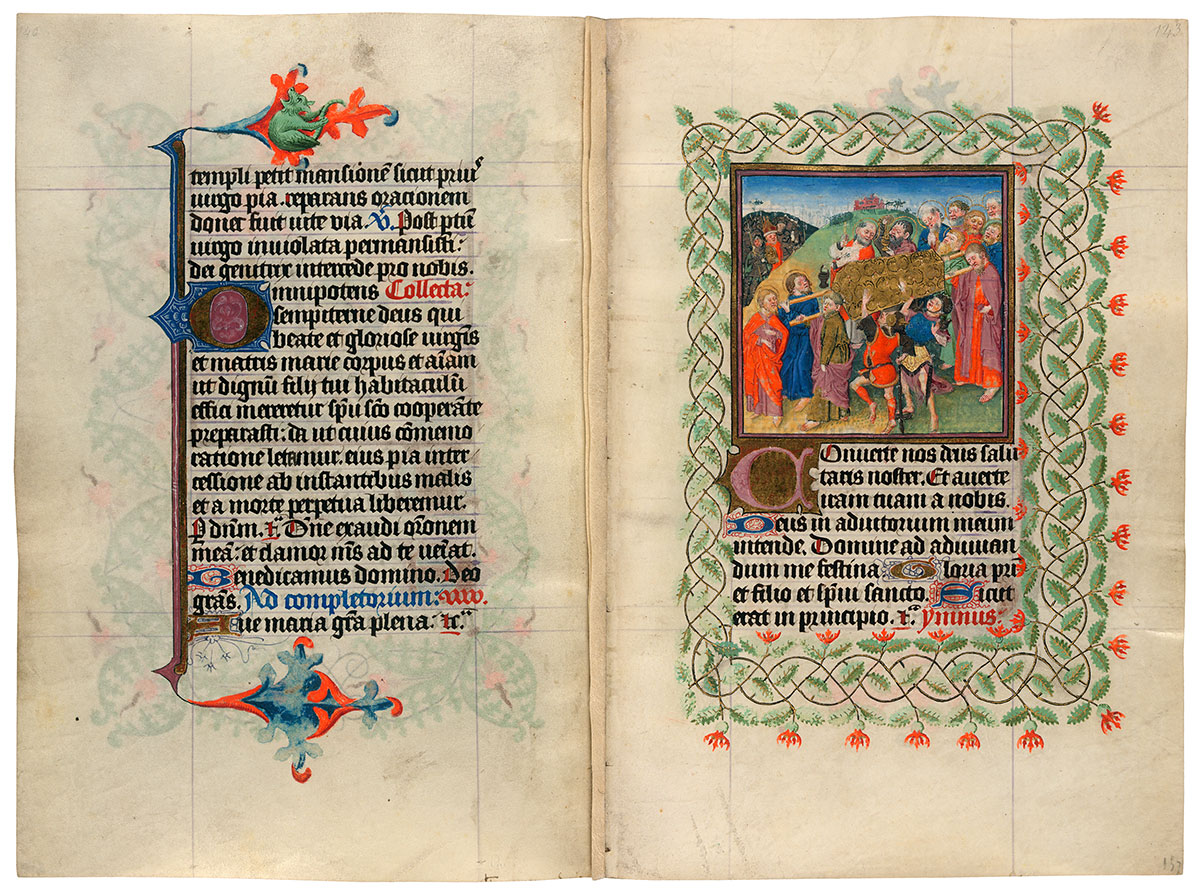
Funeral Procession of the Virgin
Purchased on the Belle da Costa Greene Fund with the assistance of the Fellows, 1963
The Virgin's funeral cortege consists of the twelve apostles. John, with a palm, leads the way; Peter sprinkles the cloth-covered coffin with holy water; and Paul censes it. At the left, the priest Jephonias hides behind a hillock with a group of soldiers. Two other soldiers have tried to stop the procession by toppling the coffin, but their hands miraculously stick to it; indeed, the hand of one soldier is severed from his wrist.
Hours and Masses for the Seven Days of the Week
The most unusual texts in Catherine's manuscript are the series of Hours and Masses for every day of the week. Medieval Christian tradition associated certain figures or themes with different days. Thus Sunday, the day of the Resurrection, was the Lord's Day; Thursday was connected with the Eucharist since that sacrament was instituted on Holy Thursday; and Monday was the day of the dead, since their torments were suspended on Sunday but recommenced the following day. In Catherine's prayer book, the themes for the Hours and Masses of the seven days of the week are:
| Sunday | the Trinity |
| Monday | the Dead |
| Tuesday | the Holy Spirit |
| Wednesday | All Saints |
| Thursday | the Blessed Sacrament |
| Friday | the Compassion of God |
| Saturday | the Virgin. |
Image courtesy of Faksimile Verlag Luzern
MS M.917/945, pp. 158–159

Purchased on the Belle da Costa Greene Fund with the assistance of the Fellows, 1963
Image courtesy of Faksimile Verlag Luzern
MS M.917/945, pp. 160–161
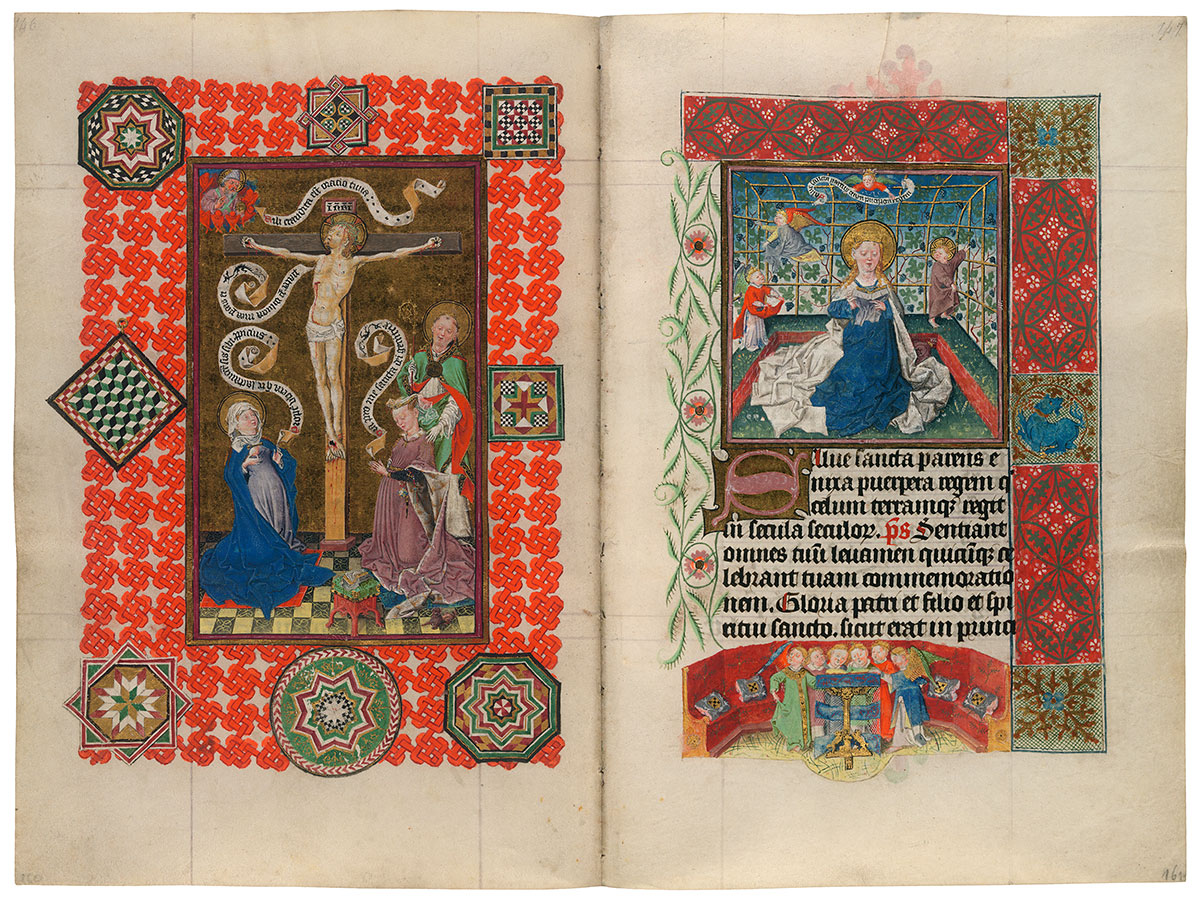
The Virgin and the Crucified Christ Intercede for Catherine of Cleves
Virgin and Child in a Grape Arbor
Purchased on the Belle da Costa Greene Fund with the assistance of the Fellows, 1963
The large miniature that opens the Saturday Mass of the Virgin contains the third portrait of Catherine, kneeling at right. A saint (Leonard?) is behind her, and her humble demeanor contrasts with the intercession she is seeking. Her scroll petitions Mary to pray for her. The Virgin, bearing a breast, entreats her crucified Son to be kind to Catherine for the sake of the mother who nursed him. Christ takes time out from his death and asks, in the name of his wounds, that his Father spare the duchess. God responds, "Your prayer has been answered." The smaller miniature shows Mary quietly reading while angels babysit the Christ Child. More angels chant in the bottom border.
Hours and Masses for the Seven Days of the Week
The most unusual texts in Catherine's manuscript are the series of Hours and Masses for every day of the week. Medieval Christian tradition associated certain figures or themes with different days. Thus Sunday, the day of the Resurrection, was the Lord's Day; Thursday was connected with the Eucharist since that sacrament was instituted on Holy Thursday; and Monday was the day of the dead, since their torments were suspended on Sunday but recommenced the following day. In Catherine's prayer book, the themes for the Hours and Masses of the seven days of the week are:
| Sunday | the Trinity |
| Monday | the Dead |
| Tuesday | the Holy Spirit |
| Wednesday | All Saints |
| Thursday | the Blessed Sacrament |
| Friday | the Compassion of God |
| Saturday | the Virgin. |
Image courtesy of Faksimile Verlag Luzern
MS M.917/945, pp. 162–163
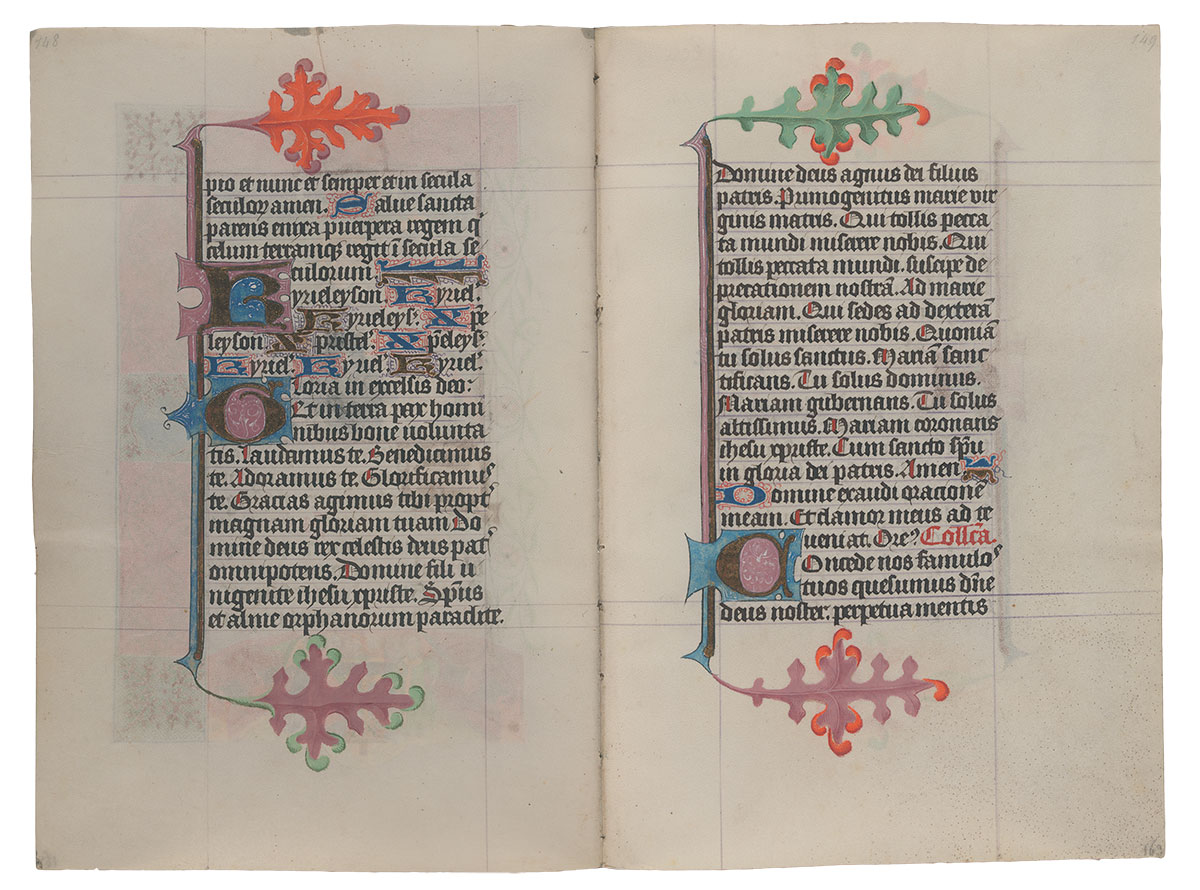
Purchased on the Belle da Costa Greene Fund with the assistance of the Fellows, 1963
Image courtesy of Faksimile Verlag Luzern
MS M.917/945, pp. 164–165
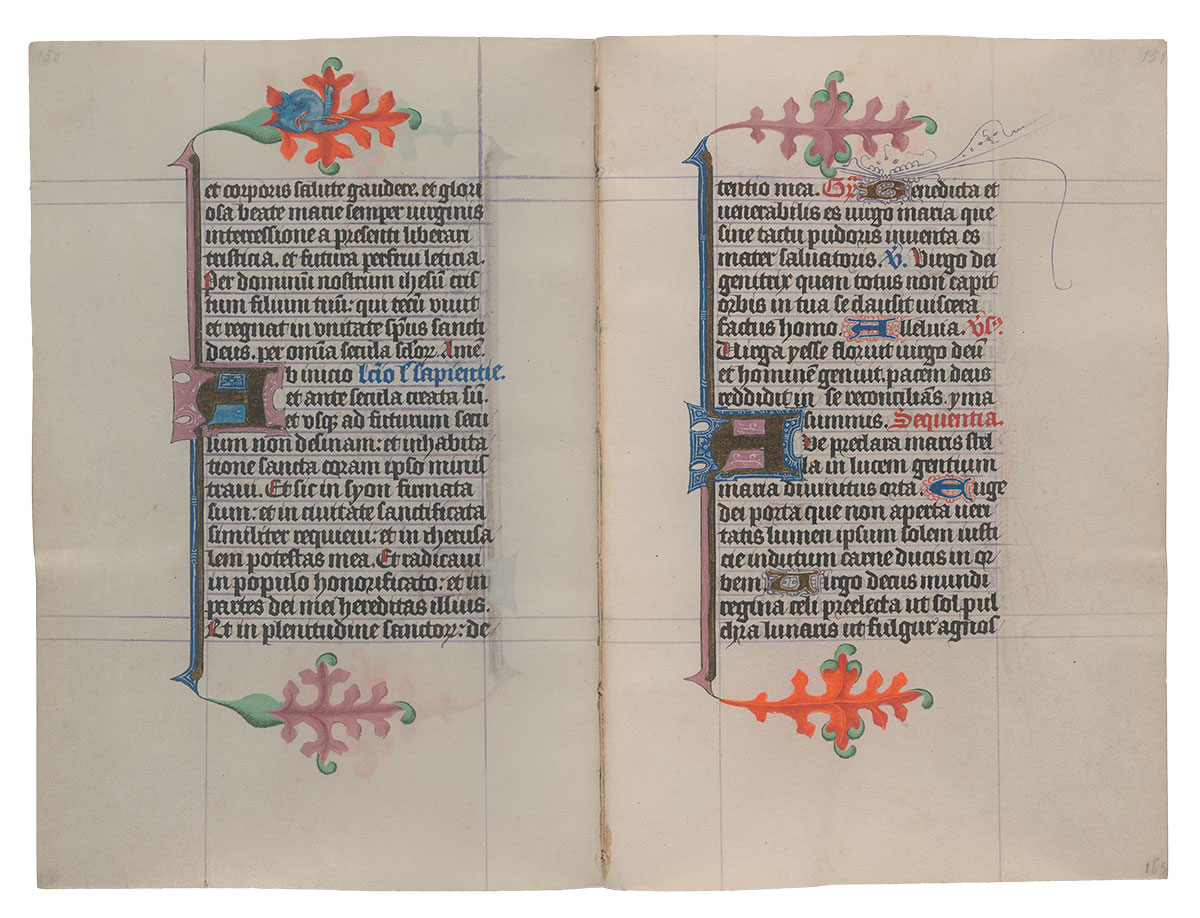
Purchased on the Belle da Costa Greene Fund with the assistance of the Fellows, 1963
Image courtesy of Faksimile Verlag Luzern
MS M.917/945, pp. 166–167
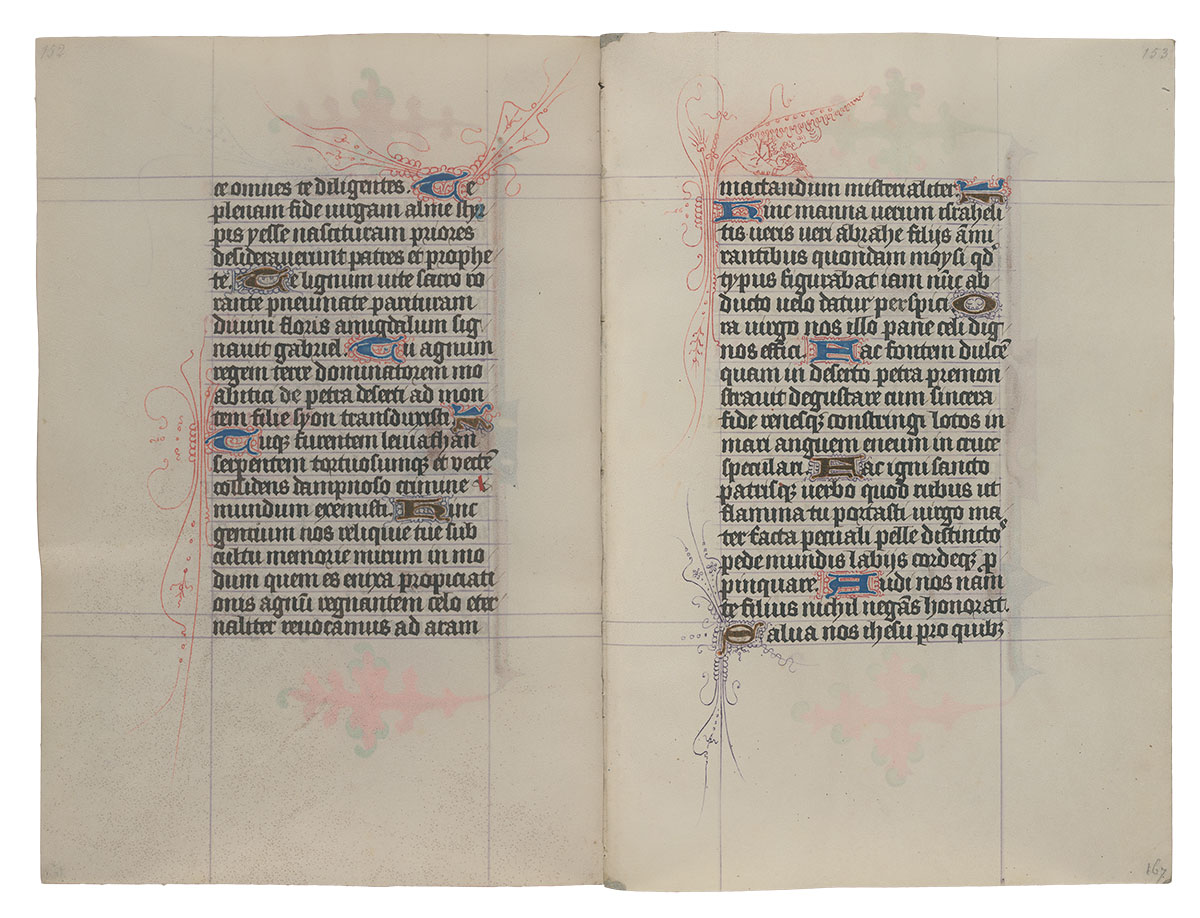
Purchased on the Belle da Costa Greene Fund with the assistance of the Fellows, 1963
Image courtesy of Faksimile Verlag Luzern
MS M.917/945, pp. 168–169

Purchased on the Belle da Costa Greene Fund with the assistance of the Fellows, 1963
Image courtesy of Faksimile Verlag Luzern
MS M.917/945, pp. 170–171
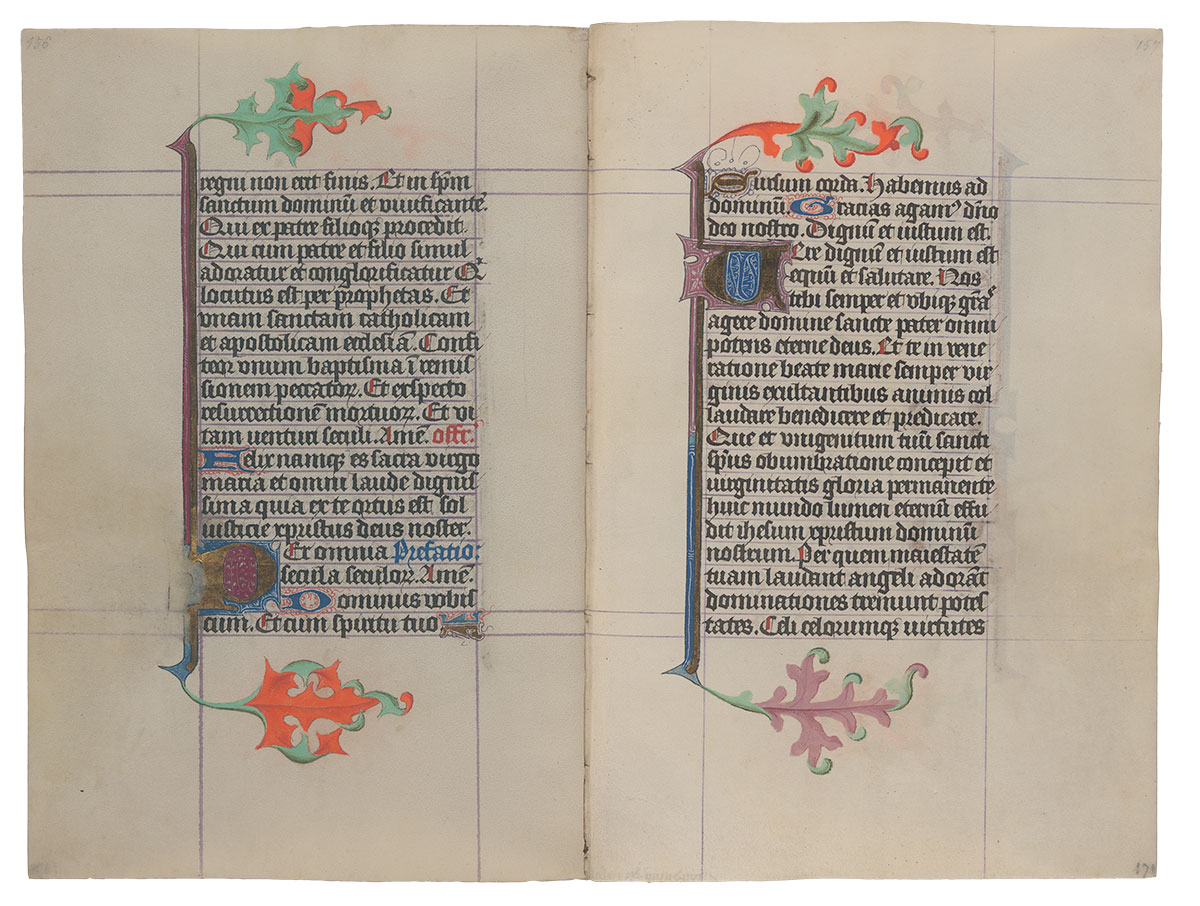
Purchased on the Belle da Costa Greene Fund with the assistance of the Fellows, 1963
Image courtesy of Faksimile Verlag Luzern
MS M.917/945, pp. 172–173
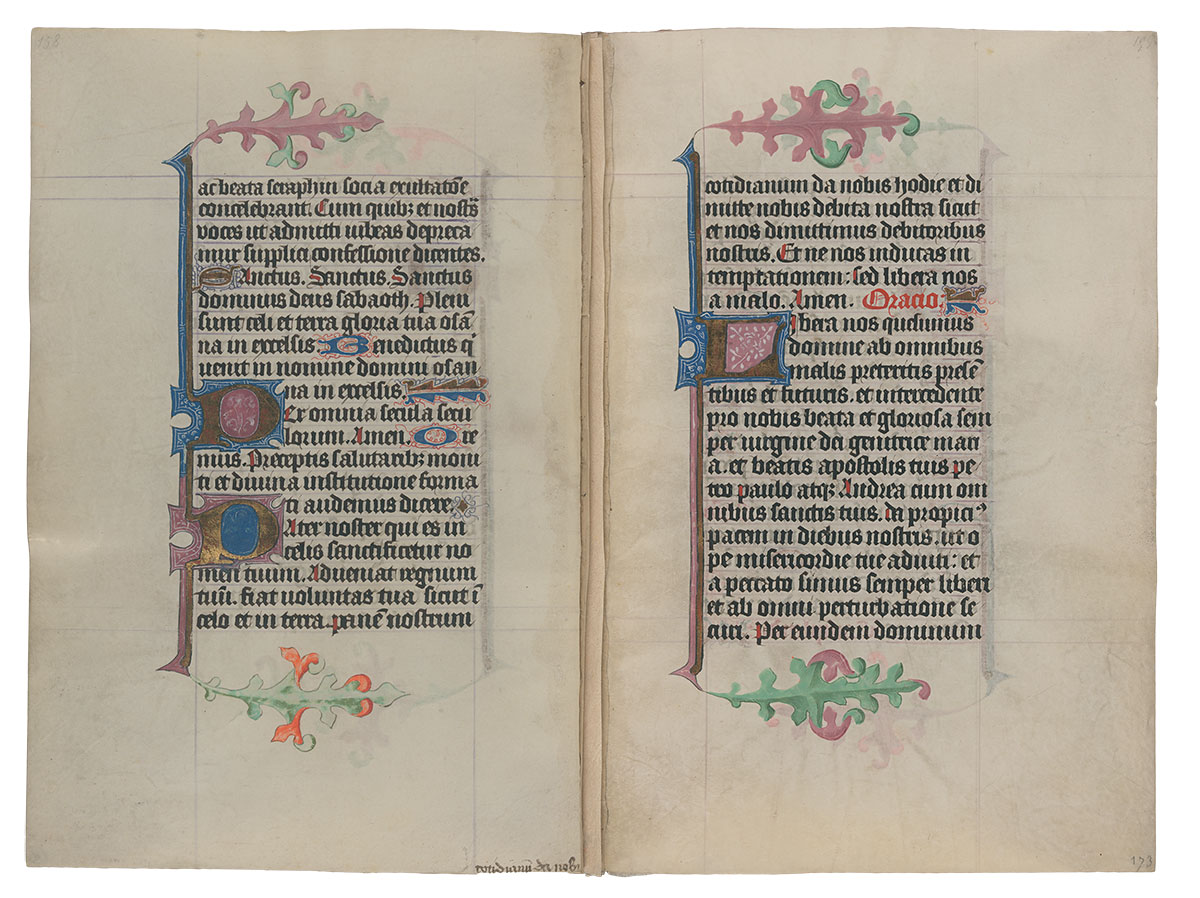
Purchased on the Belle da Costa Greene Fund with the assistance of the Fellows, 1963
Image courtesy of Faksimile Verlag Luzern
MS M.917/945, pp. 174–175
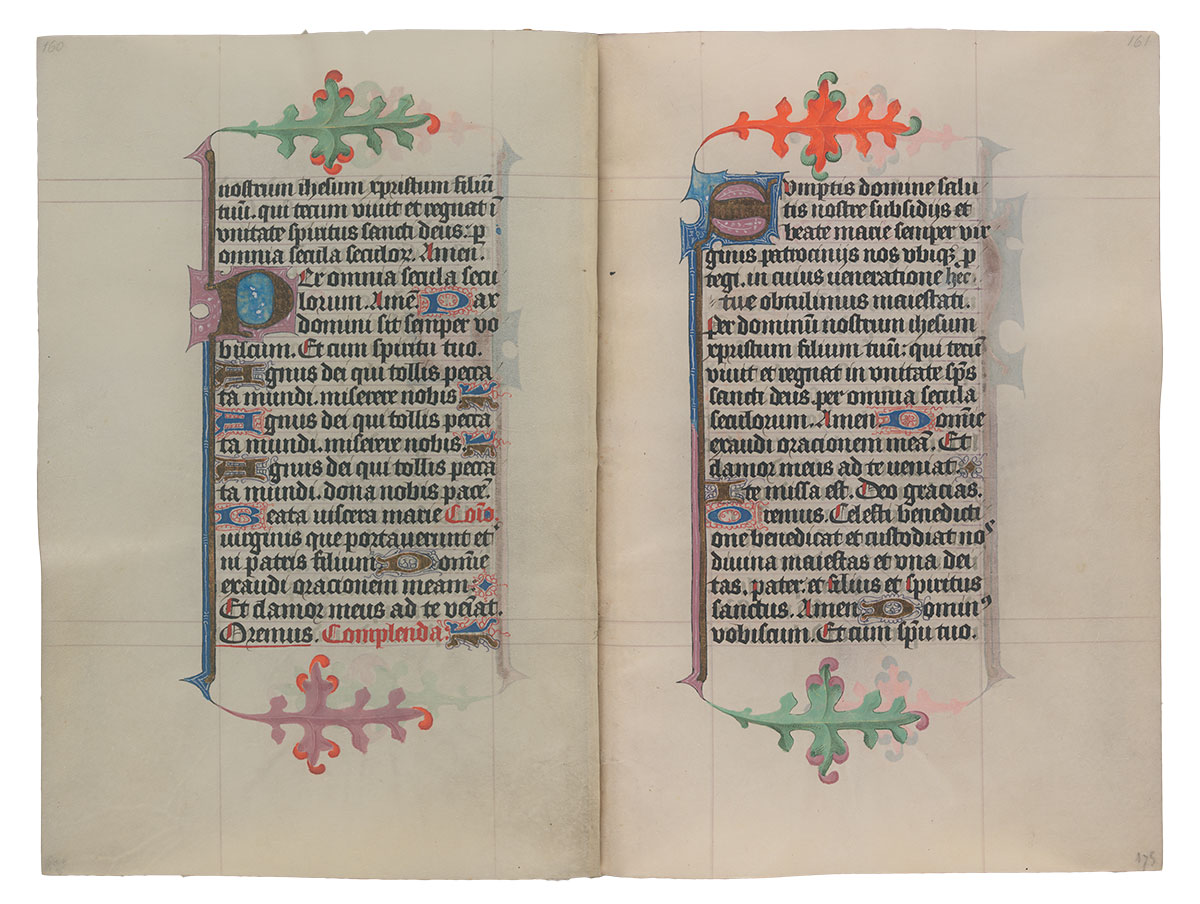
Purchased on the Belle da Costa Greene Fund with the assistance of the Fellows, 1963
Image courtesy of Faksimile Verlag Luzern
MS M.917/945, pp. 176–177
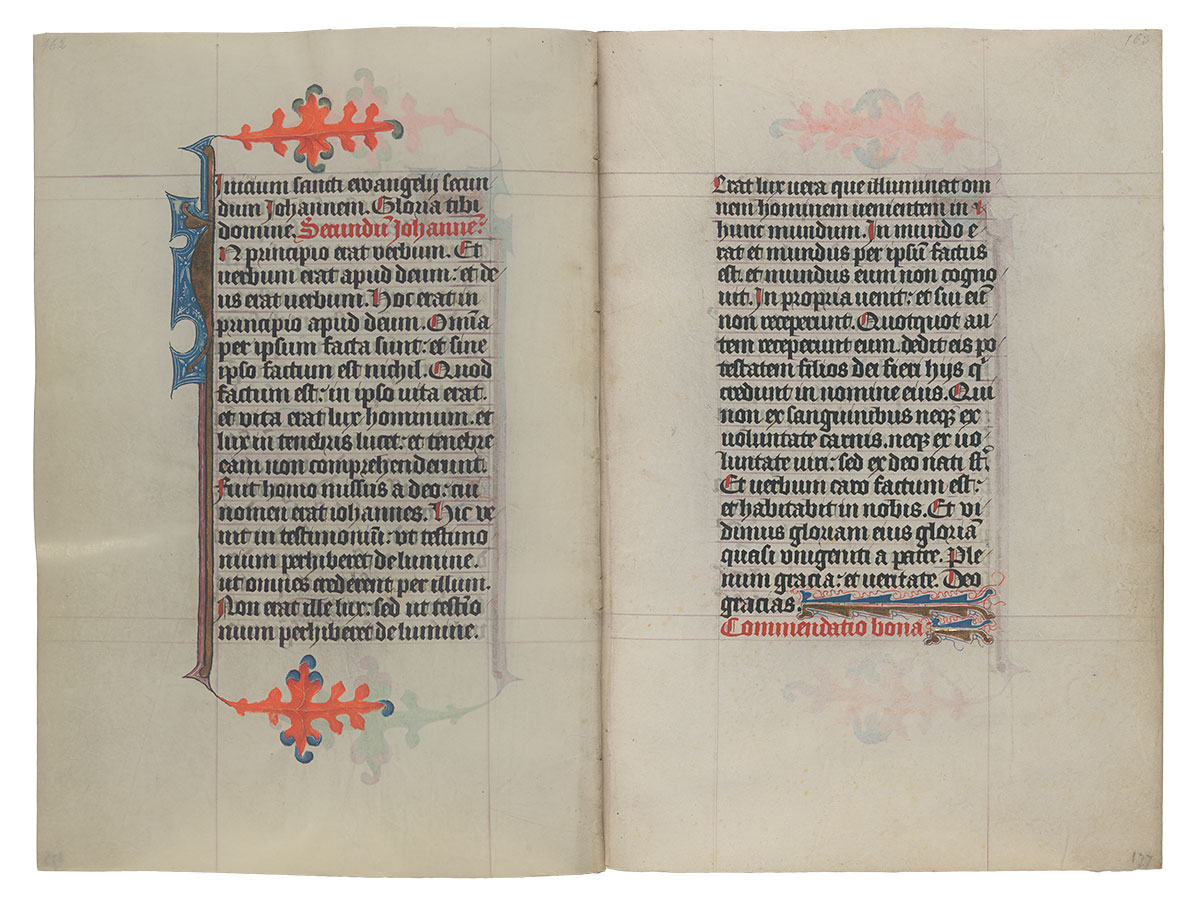
Purchased on the Belle da Costa Greene Fund with the assistance of the Fellows, 1963
Image courtesy of Faksimile Verlag Luzern
MS M.917/945, pp. 178–27
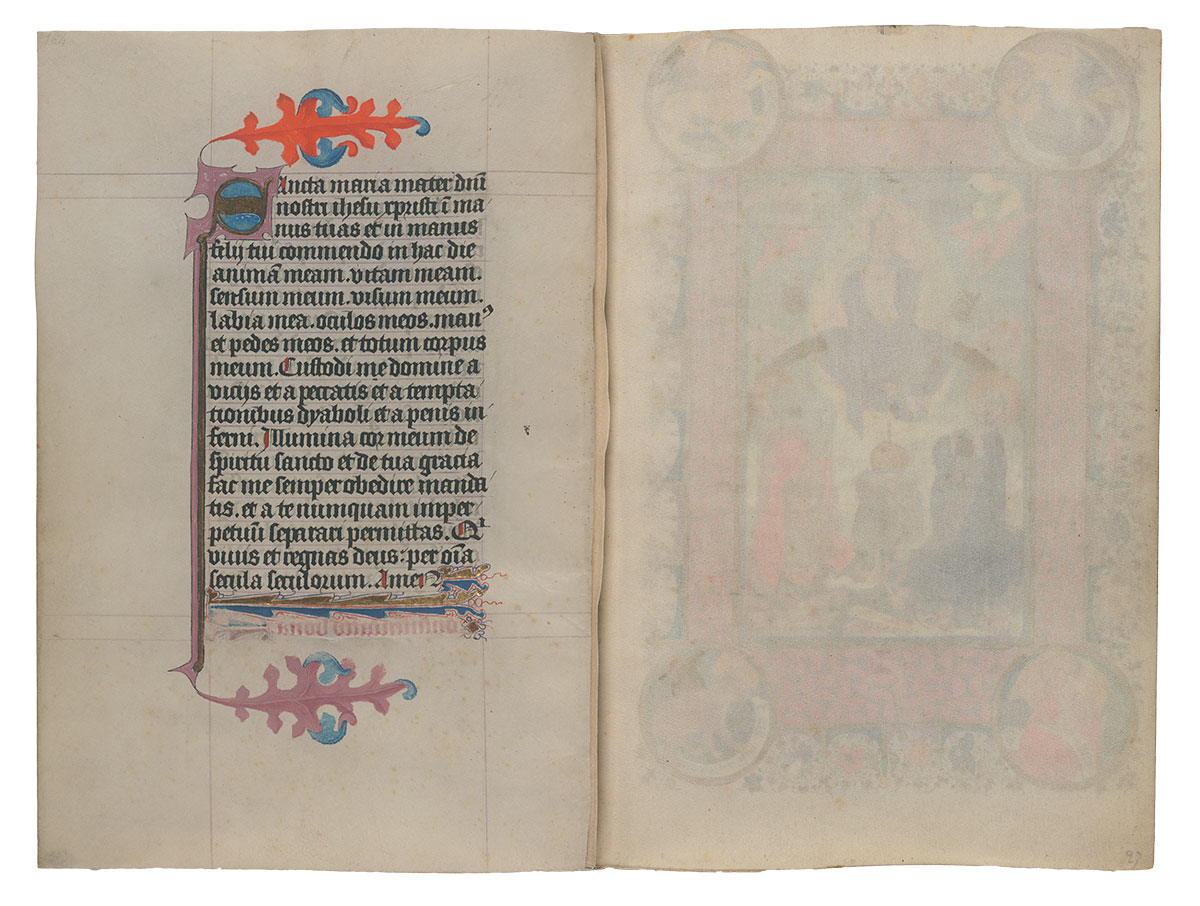
Purchased on the Belle da Costa Greene Fund with the assistance of the Fellows, 1963
Image courtesy of Faksimile Verlag Luzern